




Horacio Rodríguez Larreta Jefe de Gobierno de la Ciudad de Buenos Aires
Felipe Miguel Jefe de Gabinete de Ministros
Enrique Avogadro Ministro de Cultura
Victoria Noorthoorn Directora del Museo de Arte Moderno de Buenos Aires
Falco, Federico
Adentro no hay más que una morada / Federico Falco ; Alejandra Aguado ; dirigido por Victoria Noorthoorn ; editado por Martín Lojo ; Alejandro Palermo.1a edición bilingüe - Ciudad Autónoma de Buenos Aires : Gobierno de la Ciudad de Buenos Aires. Museo de Arte Moderno de Buenos Aires, 2022.
300 p. ; 23 x 16 cm.
Edición bilingüe : Español ; Inglés. Traducción de: Ian Barnett ; Kit Alexander Maude.
ISBN 978-987-673-615-2
1. Arte. 2. Arte Argentino. 3. Arte Contemporáneo. I. Aguado, Alejandra. II. Noorthoorn, Victoria, dir. IV. Lojo, Martín, ed. V. Palermo, Alejandro, ed. VI. Barnett, Ian, trad. VII. Maude, Kit Alexander, trad. VIII. Título.
CDD 700.982
Este libro fue publicado en ocasión de la exposición Adentro no hay más que una morada, que tuvo lugar en el Museo de Arte Moderno de Buenos Aires entre el 18 de septiembre de 2021 y el 16 de mayo de 2022.
Museo de Arte Moderno de Buenos Aires Av. San Juan 350 (1147) Buenos Aires, Argentina
Impreso en Argentina Printed in Argentina
Diseño: Pablo Alarcón Alberto Scotti Para estudio Cerúleo
Créditos fotográficos
Cortesía Erik Arazi pp. 94-95
Fabián Cañás p. 91
Cortesía Dana Ferrari p. 60
Cortesía Carolina Fusilier pp. 114-117
Viviana Gil pp. 42-49, 54-57, 61, 68-71, 81, 86-90, 98-101, 108-111, 118-119, 130-135, 146-149
Carolina Grillo pp. 140-141
Nina Kovensky pp. 52-53
Guido Limardo pp. 78-79, 92-93, 129, 142-143
Florencia Lista pp. 124-127
Gonzalo Maggi pp. 96-97, 150-153 Jorge Miño pp. 198-211
Santiago Orti pp. 58-59, 60 (árbol), 137
Florencia Palacios pp. 76-77
Federico Roldán Vukonich pp. 120-121
Catalina Romero pp. 64-67, 72-75 Florencia Sadir pp. 144-145
Por Victoria Noorthoorn —p. 9
Por Federico Falco —p. 15
Ser y habitar Por Alejandra Aguado —p. 25
Lucrecia Lionti —p. 42
Nina Kovensky —p. 46
Florencia Vallejos —p. 50
Lucía Reissig y Bernardo Zabalaga —p. 52
Blas Aparecido —p. 54
Dana Ferrari —p. 58
Santiago Villanueva —p. 64
Carlos Aguirre —p. 68
Gala Berger —p. 72
Florencia Palacios —p. 76 Nacha Canvas —p. 78
Juan Gugger —p. 84
Florencia Caiazza —p. 86
María Guerrieri —p. 90
Erik Arazi —p. 92
Francisco Vázquez Murillo —p. 96
Benjamín Felice —p. 98
Agustina Wetzel —p. 102
Daniela Rodi —p. 108
Eugenia Calvo —p. 110
Carolina Fusilier —p. 114
Gonzalo Beccar Varela —p. 118
Federico Roldán Vukonich —p. 120
Ana Won —p. 124
Matías Tomás —p. 128
Antonio Villa —p. 132
Jimena Croceri —p. 134
Denise Groesman —p. 136
Soledad Dahbar —p. 140
Florencia Sadir —p. 142
La Chola Poblete —p. 146
Alejandra Mizrahi —p. 150
Agustina Triquell —p. 156
Reseñas de trabajos y biografías de los artistas
Por Alejandra Aguado y Clarisa Appendino —p. 161
Vistas de sala [Gallery views]—p. 197
Lista de obras de la exposición [Exhibition checklist] —p. 213
English texts —p. 229
El repentino cierre de puertas del Museo de Arte Moderno de Buenos Aires el 19 de marzo del 2020, a causa de la pandemia de COVID-19, marcó el advenimiento de una nueva etapa en su historia, que se inició a partir de un veloz diagnóstico: era necesario comunicar a la sociedad que, en los últimos siete años, esta institución se había transformado en mucho más que una casa-vidriera de exposiciones. En marzo de 2020, ya era un espacio de investigación permanente, creador de contenidos de excelencia en los ámbitos de la historia del arte, la conservación, la curaduría, la producción y reconstrucción de obras de arte, la edición de libros. Era también un museo activo en la sociedad, que desplegaba una amplia red de vínculos con instituciones educativas, instituciones de salud, fundaciones y ONGs dedicadas a personas con discapacidad y a personas en el espectro autista, y con las más diversas organizaciones sociales, tanto públicas como privadas. Esta usina de investigación y creación ya estaba preparada para apoyar a las comunidades artísticas y educativas con las cuales interactúa cotidianamente con el objetivo de dar respuestas concretas desde el arte al público general y ofrecer refugio espiritual y simbólico a una sociedad en crisis. El trabajo fundacional estaba hecho, los profesionales estaban preparados y solo teníamos que articular con contundencia un abanico de ofertas concretas y accesibles. De cara al desafío, reconocimos rápidamente nuestras falencias: la institución no reflejaba toda su dimensión en sus plataformas digitales. Además, había que coordinar, motivar y proteger a un equipo de 130 profesionales sensibilizados por el aislamiento, que
trabajaban en modo remoto. También recordamos nuestras convicciones: el arte es una herramienta para sensibilizar al ser humano y transformar el mundo, y el artista es un poderoso agente de cambio capaz de concebir las transformaciones necesarias para procurar una vida económica y social mejor.
Decidimos generar una reflexión sensible en medio de la crisis y la incertidumbre, para lo cual convocamos a artistas de las más diversas disciplinas a elaborar respuestas desde el arte sobre aquello que estábamos viviendo en aquel presente inimaginable. Asimismo, buscamos activar estrategias de apoyo económico concreto para las comunidades artísticas, intelectuales y educativas a las que la crisis afectaba profundamente. El programa que lanzamos el 6 de abril de 2020, #MuseoModernoEnCasa, fue pensado como un archivo del presente, con la misión de comunicar y difundir en tiempo real contenidos, ideas y obras que las comunidades artísticas y educativas creaban respondiendo a nuestra invitación de reflexionar sobre tópicos, ideas y situaciones que pudimos identificar como urgentes. A través de este programa convocamos —y pagamos los encargos con fondos que recaudamos especialmente a tal efecto— a más de 400 artistas, escritores, actores, músicos e intelectuales, no solo para compartir sus reflexiones y concebir talleres, cursos, acciones y debates, sino también para desarrollar contenidos artísticos y crear lo que podríamos conceptualizar como un nuevo género de contenidos nativos, generadores de una comunicación más directa y una mayor participación e interacción con los diversos públicos. Buscamos responder a las vivencias y experiencias de la nueva coyuntura: el encierro, las pantallas, la alteración del tiempo, la crisis ambiental, la exacerbación de los racismos y la discriminación, la necesidad de silencio, los vínculos entre arte y salud, y entre arte y comunidad fueron algunos de los más de 25 programas de contenidos digitales que desarrollamos desde entonces.
El 2020 fue, entonces, un año signado por la confianza: confianza del Museo Moderno en los artistas argentinos y en la importancia de comunicar las ideas y propuestas de la comunidad artística ante una vivencia de crisis, y confianza de cada uno de los 400 artistas en nuestra institución, cuyos profesionales se dedicaron a sostener, producir, financiar y difundir cada idea y cada proyecto. La tarea fue titánica, el resultado inimaginable, con más de ocho millones de personas activamente involucradas en los contenidos del Museo Moderno. Fue una gran alegría notar que, gracias al universo digital, las paredes físicas de nuestro museo se volvían porosas, permeables, y que nos expandíamos cada vez más por todo el país.
Fue en este contexto de hazañas, de confianza y de agradecimiento que se gestó, entre agosto y septiembre del 2020, el germen de la exposición Adentro no hay más que una morada, que este libro retrata. Desde los equipos de Dirección y Curaduría, pensamos en una exposición que pudiese dar visibilidad a la enorme producción que sucedía puertas adentro de los talleres a lo largo y a lo ancho de nuestro país. Nos dedicamos a pensar una exposición imaginaria que pudiese decir “¡Gracias!” y otorgar a los artistas que nos habían apoyado ante el cierre del museo el espacio para poder compartir sus obras con el público en nuestras salas del barrio de San Telmo.
Con una generosidad y coraje inigualables, la curadora Alejandra Aguado tomó las riendas del proyecto y se lanzó a una investigación exhaustiva vía Zoom con cientos de artistas de todo el país. Finalmente, eligió a treinta y cuatro artistas argentinos, con quienes realizó un seguimiento de los procesos creativos y constructivos de las obras, y, más adelante, trabajó junto al equipo de Producción del museo en su producción y montaje. Adentro no hay más que una morada es una exhibición colectiva que reúne el trabajo reciente de artistas que provienen de distintas regiones de la Argentina, en cuyas obras se manifiesta la voluntad de canalizar y potenciar el vínculo personal con el entorno —sea este material, intangible o incluso espiritual. En todos los casos, se trata de artistas jóvenes y de obras mayormente producidas durante los últimos años, es decir, atravesadas por la experiencia de la pandemia y el aislamiento. Es un conjunto variado y enriquecedor que nos abre las puertas al mundo propio de cada artista, pero también nos deja entrever el contexto del que provienen, cómo ellos afectan ese entorno y cómo se dejan afectar por él. Los saberes heredados, aprendidos o intuidos y el manejo de la tecnología se entrecruzan en nuevos y personalísimos mundos plásticos; los rasgos particulares de este momento histórico dejan expuesto lo más simple y cotidiano, y el trabajo desarrollado en soledad demuestra ser parte de un enorme tejido comunitario que nos afecta a todos.
Es por esto que quiero brindar mi más especial agradecimiento, en primer lugar, a los treinta y cuatro artistas involucrados en esta exhibición. Es el deseo del Museo Moderno constituirse en una institución referente del arte argentino moderno y contemporáneo, pero sobre todo es su anhelo ser la casa de los artistas argentinos. Por eso les decimos muchísimas gracias por habitar con sus obras nuestras salas y por compartir sus miradas y sus mundos con inmensa generosidad.
Lograr llevar adelante un proyecto participativo y colectivo con artistas de tantas provincias de nuestro país siempre es una tarea difícil. Más desafiante aún fue hacerlo en el contexto de la pandemia, que durante largo tiempo impidió el traslado físico, el contacto personal y, en muchos casos, incluso el encuentro con la materialidad de las obras. Por lograr esta hazaña y liderarla con gran entusiasmo y alegría quiero agradecer especialmente a Alejandra Aguado, curadora de la exhibición. Su cálida y cuidadosa mirada sobre cada obra y su paciencia al llevar adelante innumerables visitas y conversaciones virtuales hicieron posible que el encuentro de todas estas sensibilidades formara un conjunto tan variado como coherente. También agradezco a Clarisa Appendino, asistente curatorial de la exhibición, sin cuya ayuda hubiera sido imposible reunir este inmenso caudal de obras e información, y sostener tan cuidadosa interlocución con los artistas. Mi agradecimiento especial, asimismo, al equipo de Exposiciones Temporarias del museo, que tomó a su cargo la coordinación general de esta exposición desde los más diversos puntos del país: gracias Micaela Bendersky, Paula Pellejero y Giuliana Migale Rocco.
Asimismo, dentro del equipo del museo, agradezco a Iván Rösler, Almendra Vilela, Agustina Vizcarra, Gonzalo Silva, Rocío Englender y Manuel Maquirriain, por su enorme dedicación para lograr un diseño de montaje perfecto para el conjunto y para cada obra seleccionada, y a Leo Ocello por coordinar el montaje junto a su equipo: Fernando Súcari, Germán Sandoval y Andrés Martínez. También a Guillermo Carrasco, Soledad Manrique, Claudio Bajerski y Jorge López del equipo de técnica. Sin el trabajo incansable de cada uno de ellos para superar los múltiples desafíos impuestos por la pandemia, hubiera sido imposible materializar y llevar a buen puerto esta exhibición.
Nos parece fundamental poner a disposición del público este libro en el que hemos querido no solo documentar las obras que formaron parte de la exhibición, sino también dialogar con ellas a través de un texto literario. Agradezco enormemente, en este sentido, la poética prosa de Federico Falco, que se suma a estas páginas. También a todo el equipo editorial del Museo Moderno por el comprometido trabajo para que esta publicación encuentre su forma y vea la luz. Su trabajo sensible y atento fue también fundamental en el desarrollo de la exposición al permitirnos encontrar, como en cada ocasión, las palabras justas para comunicarla a nuestro público.
Esta y todas las exposiciones que el museo presenta al público no serían posibles sin el apoyo del Gobierno de la Ciudad de Buenos Aires.
Agradecemos profundamente a Horacio Rodríguez Larreta, Jefe de Gobierno, y a Enrique Avogadro, Ministro de Cultura, por su apoyo incondicional en una etapa tan compleja y crítica como lo fue la que debimos atravesar durante los últimos dos años. Mi sincero agradecimiento, sobre todo por sostener al gran equipo de profesionales del museo, asegurando los puestos de trabajo y honrando de esta manera el saber y la experiencia de una institución que ha logrado posicionarse en un nivel de excelencia tanto a nivel nacional como internacional.
Agradezco al gran equipo del Museo Moderno por su fundamental entrega, su infinito compromiso por la excelencia y su sorprendente generosidad, todas características que nos permiten construir, juntos y todos los días, una gran institución cultural a partir de valores y a través de acciones que contribuyen a afirmar la relevancia del museo como un agente fundamental de la comunidad, capaz de impartir salud y bienestar, y de señalar a través del arte posibles caminos para una mejor vida en sociedad.
Asimismo, extiendo las gracias a nuestra Asociación Amigos y a su Comisión Directiva, que se comprometen con los proyectos que proponemos todos los días para hacer del Moderno una institución inclusiva, federal y accesible, y por sostener su compromiso y entusiasmo durante tiempos más que desafiantes.
Deseo expresar nuestro profundo reconocimiento al Banco Supervielle, al Estudio Azcuy y a la Fundación Medifé, nuestros aliados estratégicos, que colaboran generosa e incansablemente con nuestra gestión. También agradezco el apoyo de la Fundación Banco Ciudad y del Grupo Teka, y de nuestros colaboradores estratégicos, Flow, Plavicon y Fundación Andreani.
Para este proyecto contamos también con la importante colaboración de las galerías Constitución, El Gran Vidrio, Nora Fisch, Fuga, Intemperie, Isla Flotante, Moria, Piedras, Selvanegra y Alberto Sendrós, que, en su calidad de representantes de varios de los artistas, han facilitado un sinnúmero de gestiones e información, y de una gran cantidad de coleccionistas privados; a todos ellos, muchísimas gracias.
Finalmente, agradezco muy especialmente al público que se acerca al museo de distintas maneras y desde distintos lugares, ya que son el motor de nuestra tarea diaria. Los invito a recorrer estas páginas y nuestras salas a través de todas sus plataformas. Es nuestro deseo que los proyectos del Museo Moderno lleguen a cada uno de ustedes, que se involucren con ellos y los adopten como propios.
Traslasierra: la pared de sierras como murallón y como protección y como cárcel, la gente que viene a quedarla, todos dejamos atrás algo, todos huimos de algo, todos buscamos algo, los atardeceres naranjas y la sutil diferencia con los atardeceres dorados, tener que ver ciento cincuenta y tres atardeceres para poder describir un atardecer paso a paso, la diferencia entre lo que pueden ver los que viven una vida nómade y lo que pueden ver los que viven siempre, toda la vida, en el mismo lugar, el mismo pueblo, en la misma casa. La diferencia entre una visión más general y amplia y una visión muy específica y particularizada.
Apropiarse de cada lugar al que se llega, desembalar, acomodar la ropa en los estantes, juntar algunas flores y ponerlas en un vaso, hacer de cuenta que todo tiene historia y ya ha sido usado antes. Armar una casa. Cuando vivía en Brasil, cuando vivía en Tailandia, nunca sabía dónde iba a dormir al día siguiente, a la siguiente semana, yo vivía en la playa, me cuenta una mujer alta, de sonrisa suave, que apenas está empezando a envejecer. Dice: me alcanzaba solo con un par de trapos por acá, otros trapos por allá, unas velas, poner musiquita y ya hacía mío cualquier espacio. Ahora vive en las afueras del pueblo, un largo camino de piedra, no demasiado bien mantenido, lleva a su casa. Es una casa de adobe, que mira al norte, y adentro es amplia y muy despejada, pocos muebles, unos almohadones para sentarse en el piso, una estufa rocket: durante un buen rato trata de explicarme cómo funciona y cuáles son sus ventajas pero aunque el tema me interesa, enseguida me
pierdo, me distraigo. Miro las paredes. La casa me recuerda a unas fotos que alguna vez vi de la casa de Georgia O’Keefe en el desierto de Nuevo México, palos secos y retorcidos, quietos bajo el sol y el viento que los han ido lentamente decolorando hasta llenarlos de largas grietas y ponerlos blancos, como si los hubiera llevado y traído la marea durante años y años y los hubiera decolorado el agua del mar salada. La mujer sigue hablando. Combustión eficiente, ahorro de leña, retención del calor. Sobre una de las paredes de adobe colorado de la casa hay un gran dibujo de líneas blancas. Son líneas que forman como una red desplegada, una trama. Ahora la mujer dice que ella está muy bien sola, que no volvería a estar en pareja, que ni siquiera puede pensarlo, que a ella le gusta así, le gusta vivir sola en su casa, que para qué, otro hombre en su vida, todo eso ya quedó atrás, no hace falta. Junto al zócalo, debajo de la red pintada, hay una botella de plástico cortada al medio con un pincel y llena de pintura blanca. Cuando se da cuenta de que no la escucho, la mujer se acerca a la pared y me explica: la casa tuvo un problema, se cuarteó el revoque, no estaba del todo bien hecha la mezcla de arcilla, baba de tuna y mierda de caballo, a veces pasa. Por eso en las largas noches de invierno, ella se entretiene dibujando líneas sobre la pared agrietada, para disimular las rajaduras. En algunas zonas, la pintura sigue las grietas, arma una trama cubriendo el craquelado; en otras, son solo puro trazo que imita las tensiones del adobe al quebrarse.
Lo más terrible del invierno en las sierras es llegar una noche tarde a casa y darte cuenta de que ya no quedan fósforos en la caja y que te olvidaste el encendedor en algún lado y que hay leña fina, papeles, leña gruesa, querosene, cartones, ramitas y paja para encender un fuego en la salamandra pero nada con qué empezarlo.
Una vez conocí a un chico que se separó y vivió casi cuatro años sin casa: llevó todas sus cosas a lo de sus padres, durmió un tiempo en lo de un amigo, después en lo de otro amigo, como era actor algunos días en que los ensayos terminaban tarde podía dormir en la sala de teatro, viajó, durmió en hostels, en casas de fin de semana, en invierno se quedó en vacías casas de verano y en verano se quedó en departamentos para regar plantas y darles de comer a gatos que nunca se acordaba bien cómo se llamaban. Le dije que yo no hubiera podido sostener esa vida ni siquiera un par de semanas: a mí me lleva tres o cuatro días instalarme, necesito cierta rutina, las primeras noches duermo mal, estoy alerta, necesito despertar varias mañanas en la misma habitación, frente a la misma ventana, para recién entonces empezar a sentir que esa casa se volvió refugio, lugar seguro, resguardo. ¿Cómo hacías
para no volverte loco, yendo así de un lado a otro, así tanto tiempo, así cuatro años?, le pregunté. El chico se encogió de hombros, dijo que era piscis con ascendente en piscis y luna en acuario, que se había ido dando. Cuando me preguntó de qué signo era yo tuve que responderle que del ascendente no me acordaba, pero que era virgo con luna en capri y él dijo claro vos nunca podrías hacerlo, tenés demasiada tierra en tu carta.
Durante un tiempo tuve una vida más o menos nómade, hogares provisorios, por seis meses, por un año, escritorios inventados con una puerta de placard y dos caballetes de Easy, como no había cajones tenía que guardar las medias en una caja de zapatos, lavar los platos en la bacha del baño, aprender a tener roommates, aprender que los miércoles sí o sí te toca limpiar: una semana los espacios comunes, una semana la cocina, una semana el baño, saber que nunca hay que vaciar de sobras ajenas la heladera, que de la alacena se pueden tomar fideos y arroz prestado, pero hay que avisar o devolverlo, código de honor, nunca robarlo. Cada cierto tiempo cambiaba de departamento, de país, de ciudad. Todo era “por un tiempo”, por un par de meses, por un par de años. No tenía sentido acumular nada. La vida era portátil. La vida se redujo a lo más simple e indispensable. Después conocí a alguien y juntos armamos una casa, después nos separamos, después ya no supe qué quería para mí, o dónde, o cómo pero igual no importó porque siempre hay que vivir en algún lado.
Cuando llegué al valle, empecé a fantasear con quedarme. Acá todos venimos escapando de algo, me dijo una chica una tarde, a los poquitos días de haber llegado. Para eso es que cruzamos las montañas, por eso es que estamos del otro lado. Las montañas son un muro que divide, que separa, amanecer todos los días con ese paredón de piedra, ahí, cayendo en picada, da una sensación de amparo. Después le dio una seca al porro, lo pasó de manos. Hasta que te das cuenta de que acá está lleno de huidos, y que los huidos no somos la gente más fácil del mundo para relacionarse, dijo la chica. Porque de protección a encierro, respecto al mismo muro, hay solo un ligero cambio de mirada.
Dejate llevar, me dijo un hombre que vive acá hace muchos años. Dejate llevar y fijate qué te pasa. Cada uno es cada uno y a las decisiones sos vos el que las tiene que ir tomando. Dejate llevar y prestá atención a cómo te actúa en el cuerpo el valle, cómo te asienta el aire, cómo se te acomoda la respiración, el resuello, el tranco. Y no trates de imponer nada. Permití que sea el valle el que haga. Es como tratar de frenar el agua, mejor que entre y se lleve lo que se tenga que llevar y que lo que tenga que traer lo traiga. Es al
vicio intentar frenar el agua, implica mucha fuerza, mucha energía y es batalla perdida de antemano.
Me sorprendió la comparación acuática, justo acá, donde todo es tan árido, donde los cursos de agua son apenas arroyitos que ni siquiera califican de ríos y que se pasan secos más de medio año.
¡Ah!, suspiró una chica después de bailar un buen rato sola, girando bajo el sol, entre los arbolitos raleados del monte en invierno. Estábamos en un festejo de cumpleaños, un sábado seco, frío y de perfecto cielo celeste, soleado. Apenas más allá, sobre un aguayo tirado en el pasto, había budín y galletas y una torta crudivegana. ¡Ah!, suspiró la chica y se sentó a mi lado, cerró los ojos y sonrió casi con nostalgia. Qué lindo el momento en que estás, qué lindo estar recién llegado. ¡Nada mejor que una buena cura geográfica!, dijo. ¿Vos sabías que all forms of landscape are autobiographical? No, no sabía.
La chica sonrió: es una frase de un poeta, me explicó. Ahora no me acuerdo cómo se llama.
Alquilo una cabañita mínima, pequeña pero cómoda, rodeada de monte, con una gran vista abierta hacia el valle y las montañas cuidándome las espaldas y en las noches de invierno, después de que el sol cae sobre el valle, empiezo a fantasear con el deseo de una casa para siempre, para ir y venir, para viajar, para pasar tiempo en otros lugares, otras ciudades, pero una casa mía, un lugar donde tener mis cosas, un lugar adonde volver y donde asentarse. Se lo cuento a Ana, que vive sola monte arriba, en una casa pequeña, con un gran algarrobo al frente, una higuera y dos manzanos de manzanitas pequeñas, carasucias, de una variedad antigua, adaptada al valle. Es normal, me dice Ana, a determinada edad querer tener un lugar propio donde armar, querer tener una casa. Y entonces en el quiosco me compro un cuaderno escolar en blanco y en la primera hoja escribo, centrado y con letras bien grandes: el cuaderno de la casa. Después, frente a los renglones perfectamente alineados de la hoja, cierro los ojos y repaso una por una todas las casas donde alguna vez viví, donde dormí una noche, donde pasé vacaciones, donde me instalé un par de semanas. De cada casa anoto las cosas que más me gustaron y con esos retazos armo un Frankenstein imaginario de la que quisiera que fuera mi casa. Una cocina a leña en el extremo de la mesada, para en invierno hacer guisos y sopas y taparla con un hule floreado en verano; un baño de azulejos blancos, de los comunes, quince por quince, con la junta tomada con pastina negra, como en el baño de la casa de mis abuelos en el campo; una despensa sin absolutamente ninguna ventana, con muchos estantes y oscuridad y
frescura para guardar frascos de dulces y conservas, y para colgar del techo una ristra de ajo y apilar en el suelo, contra la pared, una cosecha entera de zapallos; cemento alisado en la cocina, tablones de pinos para el dormitorio; una salamandra en el centro del living; un sillón muy cómodo para leer junto al fuego; cocina comedor y living integrado, un solo dormitorio aparte; una casa pequeña para calefaccionar bien en invierno; vidrios dobles, orientación norte, buena exposición solar, aberturas de cierre hermético, nada de chifletes, preferible pasar calor en verano que frío en invierno; una galería ancha y la distancia exacta entre columnas para colgar una hamaca paraguaya, muchos placares donde guardar un montón de cosas y olvidarse para siempre dónde estaban; una biblioteca de piso a techo y con estantes de exactamente 17 centímetros de profundidad porque casi no existen libros con tapas de más de 17 centímetros de ancho, y no quiero que sobre espacio adelante: basta de apoyar adornitos sobre los estantes, basta de alebrijes mexicanos, basta de caracoles traídos de ninguna playa, basta de lobos marinos traslúcidos recuerdo de Mar del Plata y condenados para siempre a predecir si viene lluvia tiñéndose de rosado, de violeta si va a estar inestable, de azul si toca día de sol radiante, basta de fotos apoyadas sobre el lomo de los libros, ni tarjetas, ni postales enviadas desde otro país: ya hace años, ya hace siglos que nadie manda postales. Ahora solo quiero libros, uno junto a otro, de piso a techo; y otra biblioteca, bajita y más profunda, para los libros de arte, o los de formato apaisado, o para todos aquellos cuyas tapas midan más de 17 centímetros de ancho.
De cada casa a la que entro, de cada casa a la que me invitan, de cada casa frente a la que paso, estudio la orientación con sumo cuidado. Las generales de la ley dicen que la casa tiene que estar orientada al norte para que sea fresca en verano y que en invierno sea cálida. Que lo ideal es que la cocina mire al este, para que la ilumine el primer sol de la mañana y a la hora del desayuno relumbre sobre las hornallas y en el contraluz deje ver el vapor que escapa de las tazas. Que es mejor que árboles de sombra protejan el lado oeste de los grandes soles del verano y que esos árboles sean de hoja caduca así en invierno se puede aprovechar sin problemas todo el calor de la tarde. Que el flanco sur no recibe nunca luz directa, que esas son las paredes que se enmohecen y que es el lado que más golpean los vientos helados, así que al sur mejor ubicar pocas aberturas y todos aquellos ambientes que no necesariamente tienen que estar calefaccionados: el lavadero, la despensa, el baño.
Y sin embargo, todo es al revés en la casa de Oscar. La casa de Oscar mira al este, al norte está el baño y no tiene ninguna ventana. La pared que
da al oeste tiene una ventanita mínima, apenas para asegurar la circulación. La única ventana más grande está mirando el sur. Si la diseñaste vos, si la construiste vos con tus propias manos, Oscar, ¿por qué tomaste estas decisiones tan particulares? Porque no me gusta el verano, porque hay demasiada luz, porque hace mucho calor acá en verano. A Oscar no le gusta tener toda esa luminosidad y ese sol adentro y armó su casa mirando el este: una casa al este siempre es más fresca y tiene menos luz.
A mí me gusta estar afuera, me gusta estar en el monte, para ver el sol, salgo afuera, dice Oscar, pero cuando estoy adentro necesito que la casa me calme, que me traiga hacia mí, me contenga. Por eso hice las ventanas chiquitas. Me gusta la casa a oscuras, medio en penumbras. Es ahí donde puedo encontrarme, dice Oscar y yo en mi cuaderno anoto: una casa que me calme, una casa donde pueda encontrarme.
Una casa cómoda y sombreada para recibir amigos que vengan el fin de semana y duerman en un montón de colchones tirados en el piso, en cualquier lado. Una casa sombreada en verano para pasar adentro las horas de la siesta y salir afuera a ver la puesta de sol, al final de la tarde. Reposeras y hamacas y mucho lugar donde echarse. Vajilla linda y toda diferente y toda un poco cachada. Que no haya ningún problema si un vaso se cae, ningún problema si se rompe un plato. Muchos floreros de muchas formas y tamaños: grandes, chiquitos, medianos, de vidrio transparente, de vidrio coloreado, de opalina, de cerámica, de gres, de porcelana, de bronce, de lata, de chapa, de plástico. Mucho lugar para guardarlos. Un río o un arroyo cerca. Limoneros y manzanos. Una planta de durazno, dos de ciruelas, tres higueras, cuatro nogales. Mandarinos y naranjos. Un jardín con crisantemos en otoño y dalias en verano. Un membrillero japonés que en julio florezca a rama desnuda y llene el jardín de rosado. Lirios, salvias guaraníticas, amistad, greggii y leucantas. Un par de coronas de novia, muchos rosales.
Amanece lloviznando, dejo el cuaderno a un costado, le agrego leña a la salamandra, pongo las noticias en la radio, lavo los platos, tiendo la cama, ordeno un poco las cosas sobre la mesada. Afuera por momentos se nubla por completo, cielo plomizo, de a ratos las nubes cubren la cabaña y estoy entre nubes y no se ve nada más allá de la cerca de palos, incluso puedo ver las nubes, retazos de nubes, coletazos vaporosos pasar por el patio, después vuelve a abrirse, vuelve a aparecer el valle abajo. Una gran mancha de sol, lejos en el valle, donde el sol logra colarse entre las nubes y está despejado.
En Sobre cosas que me han pasado, del chileno Marcelo Matthey Correa, hay una cita que me gusta mucho, aparentemente tomada de un libro de Pío Baroja. “¿Ves por la mañana, cuando la luz comienza a alumbrar, en lo alto del monte, una casa chiquita, con la fachada blanca, en medio de cuatro robles, con un perro blanco en la puerta y una fuentecilla al lado? Allí vivo yo en paz”. Mi ejemplar me lo regaló Diego Zúñiga una vez que estuve en Chile y supongo que Diego lo debe haber comprado en una librería de usados, porque el libro no tiene ningún rasguño, pero esa frase —la única en sus 138 páginas— vino subrayada con un lápiz grueso y apenas tembloroso y con una estrellita dibujada al lado. Evidentemente, con ese lector desconocido compartimos el deseo de tener el mismo perro, descansar bajo la sombra de los mismos árboles, mirar desde arriba el mismo valle, vivir los dos en la misma casa. Podríamos ser roommates, si no fuéramos los dos tan complicados para convivir, tan llenos de mañas.
Ruth es muy joven, se construyó su casa antes de cumplir treinta años. La casa de Ruth es pequeña, con cimientos de piedra, paredes de adobe, piso de tablones de pino y un techo de madera que es como un bote boca abajo. Los ladrillos de adobe son muy antiguos, eran de una tapera a la que los yuyos y las enredaderas estaban demoliendo en cámara lenta, brote a brote, primavera tras primavera, año tras año. Ruth se los compró al dueño del terreno por poquísima plata y se pasó una semana entera desmontando ladrillos con cariño y con cuidado y eligiendo y separando todos los que no estaban partidos y podían servir para su nueva casa. Después contrató un camión y una tarde fueron a cargarlos.
Al principio, me dice Ruth, esta casa eran solo cuatro estacas clavadas en la tierra. Cuatro estacas unidas con hilo que delimitaban un perímetro y yo iba de un lado para otro pensando: acá va la puerta, acá va una ventana, acá va a estar la cama, por acá se entra al baño y caminaba entre esos piolines y ensayaba los movimientos, los recorridos más usuales: de la mesa a la bacha, del escritorio a la biblioteca, de la cama al baño, me imaginaba cuáles serían mis rituales y mis rutinas, qué cosas haría a la mañana, qué cosas haría a la tarde.
Ella me cuenta cómo se imaginaba la casa y yo mientras tanto me imagino a Ruth caminando con cuidado entre las estacas y los piolines, con los brazos abiertos, como haciendo equilibrio, sus dedos apenas rozando las paredes fantaseadas, una y otra vez repitiéndose a sí misma, todavía sin terminar de creerlo: acá va a estar la puerta, acá va a estar la cama, esta va a ser mi casa, esta va a ser mi casa.
Mi poema favorito de James Schuyler se llama “30 de junio, 1974”. Es una especie de carta, o de mensaje de agradecimiento para unos amigos
que lo invitaron a pasar un fin de semana con ellos en su casa en el campo. Una mañana de domingo, a principios del verano, Schuyler se despierta temprano mientras sus amigos todavía duermen o se quedan haciendo fiaca en la cama. Todo está muy silencioso y Schuyler se prepara unos huevos para el desayuno, coffee, milk, no sugar. Describe la casa con unas pocas imágenes muy rápidas: la vista de un lago y unas dunas del otro lado de la ventana, una casa acogedora “llena de pinturas y plantas”. Al leer ese verso yo siempre me imagino que quiero una casa así: cómoda, luminosa, con pisos de madera que crujen y plantas y pinturas y amigos que se despiertan temprano y bajan a desayunar y saben en qué estante de la alacena están las cosas y solos se preparan un café, se hacen una tostada, después dejan la taza sucia en la bacha y salen a caminar un rato, bajan al arroyo, van hasta el pueblo y vuelven con facturas y un pan caliente bajo el brazo.
En una parte, el poema dice: “Home! How lucky to / have one, how arduous / to make this scene / of beauty for / your family and / friends”. La primera vez que lo leí subrayé la palabra “arduous”. La segunda vez que lo leí, con otro color subrayé: “scene of beauty”.
A la tierra arcillosa hay que ir a juntarla a la orilla del arroyo, en una barranca donde hay mucha y todos van y sacan y después hay que ir al campo, a cortar la paja brava y cosechar mazos enteros, que se van acumulando en bolsas y más tarde se trituran a golpe de pala hasta que cada brizna de paja queda de no más de cinco centímetros de largo. La paja se mezcla con la arcilla, con arena, con tierra cascotuda, y con baldes se trae agua del arroyo y se le agrega y se pisa hasta que se trenza bien todo y se hace un barro pegajoso entre las manos: a eso se le llama pastón y sirve para unir entre sí los ladrillos de adobe que se acomodan uno junto a otro sobre la piedra de los cimientos y así, de a poco, empiezan a subir las hiladas, una a una, hasta la altura de la rodilla, hasta la altura de de la cintura, hasta el pecho, los hombros, la cabeza, hasta que se termina y llega el momento de empezar a juntar la plata para comprar las chapas y poder poner el techo y terminar la casa.
Hay una diferencia entre estar trasplantado al valle y estar asimilado al valle. Un trasplantado intenta que acá las cosas funcionen igual que en la ciudad; un asimilado sabe que el valle tiene otro ritmo, otros tiempos, otras maneras de hacer las cosas.
A vos todavía te falta pasar tiempo acá, me dice Ana. Yo asiento y le pregunto si nunca se aburre, si no le da miedo estar ahí, sola, en medio del monte.
¿A vos te da miedo?, contraataca ella. Claro que me da miedo, sí, claro, ¿qué voy a hacer solo acá todo el tiempo? Me da miedo convertirme en un solitario amargado, en el ermitaño que nunca ve a nadie, en el viejo loco al que los chicos le vienen a robar limones a la hora de la siesta y le gritan cosas cuando pasa por la calle.
Ana se encoge de hombros. Yo nunca estoy sola, dice. Yo estoy conmigo, me dice. Yo soy mi mejor amiga, mi mejor compañía. A veces me tengo que tener un poco de paciencia, pero como a todos. Después salgo a caminar por el monte y le voy contando al monte mis cosas y se las voy entregando y, si uno sabe escuchar, el monte te responde: ves una ramita, una flor, algo que te llama la atención, que te distrae. El monte te devuelve, te saca adelante, dice Ana y después sonríe, me mira con un poco de lástima, como si yo no terminara de entender algo que para ella es casi una tontería, algo demasiado evidente, fácil.
Me dice: a vos todavía te falta pasar tiempo acá. Todavía te falta asimilarte.
¿Por qué te viniste al valle? ¿Vos también te estabas escapando de algo?, le pregunto a Ruth una tarde de invierno, muy fría. Tomamos té de manzanillas y lavanda que recogió ella misma, sobre la mesa quedaron las migas de una torta de coco y dulce de leche que compré en la panadería del pueblo y le llevé de regalo.
Ruth tarda un rato en contestarme. Después dice: a mí me gusta el monte, me gusta acá, me gustan las montañas. Yo elegí quedarme.
Asiento y no digo nada. Alrededor se va haciendo de noche y las brasas crujen en la salamandra. Es linda la casa de Ruth, se siente bien estar ahí, los dos sentados, calentitos, el monte afuera tan cerca que cuando las mueve el viento las ramas de los manzanillos y los falsos talas rozan el techo de chapa y suena como rasguños de uñitas de gatos.
Es lindo estar acá, digo después de un rato que pasamos los dos callados. Por ahora me gusta, por ahora siento que podría ser acá, pero vaya uno a saber. ¿Qué pasa si después deja de gustarme?
Si después deja de gustarte, después verás, dice Ruth.
Ojalá dure un poco este tiempo. Es lindo estar acá, digo otra vez en voz baja.
Ruth se larga a reír.
El tiempo cambia todo el tiempo, amigo.
Sí, digo yo, ese es el problema.
O esa es la gracia, dice Ruth. O esa es la gracia.
Lejos, de corazón en corazón, más allá de la copa de niebla que me aspira desde el fondo del vértigo, siento el redoble con que me convocan a la tierra de nadie. (¿Quién se levanta en mí? ¿Quién se alza del sitial de su agonía, de su estera de zarzas, y camina con la memoria de mi pie?)
Olga Orozco, “Desdoblamiento en máscara de todos”, 1962
Una tras otra, las obras que integraron el proyecto Adentro no hay más que una morada fueron apareciendo como señales capaces de demostrar que incluso en tiempos de profunda aceleración y exigencia, de desorientación y vértigo, somos capaces de provocar un momento de reunión sincera con aquello que nos rodea. Podemos salir al encuentro de algo que parece estar escrito “en el revés del alma” de todo y de todos, como escribe Olga Orozco algunos versos más adelante en su poema. A flor de piel, este encuentro tiene mucho de verdad: es el descubrimiento de una especie de esencia compartida, de un instinto relativo al modo en que podemos avanzar sobre las cosas del mundo, ya se trate de la Tierra, de nuestros objetos o de
quienes están próximos. Tal vez, a partir de ese encuentro podamos poner en jaque los modos automatizados en los que el orden social y económico nos impone desarrollar nuestra existencia.
En esos momentos, a veces breves, el mundo no se siente como algo ajeno. Las formas del mundo, su materialidad y su escala, no nos resultan extrañas, aun cuando nos encontramos con ellas por primera vez. El tiempo no amenaza con apresurarnos ni con demorarnos, sino que, de algún modo, su ritmo y el nuestro parecen estar acompasados. Esa sensación de continuidad entre lo que somos y lo que nos rodea –o ese modo de reunión con lo que hay alrededor– es evocada con fuerza por las obras que forman parte de Adentro no hay más que una morada, una exhibición que reunió el trabajo de treinta y cuatro artistas que habitan en distintas regiones de la Argentina. Sus obras, de producción reciente, o realizadas especialmente para la exposición, restauran la mirada sobre el vínculo que existe entre nosotros y todo aquello que está o sentimos cerca. Nos recuerdan que somos y habitamos al mismo tiempo, que nos desarrollamos a partir de ese modo de reunión y en sintonía con lo que puede haber alrededor –sea material o simbólico, esté más allá de nuestra piel o bien adentro– y que nuestra identidad es indiscernible del modo en que atravesamos los días y dejamos huella, así como del modo en que el exterior deja huella en nosotros.
Esa experiencia de conexión que comunican las obras, resulta, por un lado, de un acto de repliegue –de concentración en el mundo cercano y propio– y, por otro, de un acto de trascendencia que acontece cuando el valor puesto en el acto anterior proyecta, incluso de manera inconsciente, la experiencia individual más allá de sí. En su andar y en su hacer, a veces mecánico e intuitivo, pero siempre como resultado de una entrega incondicional a la labor, al contacto con sus materiales y a la investigación, estos artistas conectan cuerpos, territorios y tiempos. Sus obras pueden surgir del encuentro de su hacer con una geometría universal, de abrazar métodos de construcción que están al borde del olvido, de trabajar con materiales naturales para descubrir en ellos nuestras huellas y memoria, de restaurar el significado de objetos y palabras que guardan testimonio de su paso por el mundo, de labrar formas con ritmo casi ritual, de disponer un lugar donde pueda posarse lo invisible, o de mirar con atención y penetrar el territorio que habitan. Sus producciones son parte de su experiencia vital, los imaginarios que terminan por crear y que nos comparten recuperan el valor del arte como gesto de expresión simbólica y de la producción artística como posibilidad de abrirse a lo desconocido. Ellos evidencian que no hay distancia entre lo corpóreo y lo inmaterial, entre el
mundo físico y el emocional; por el contrario, en una época de cuestionamiento a la cultura de las conceptualizaciones dicotómicas, estos trabajos ponen de manifiesto que son vías de comunicación y de descubrimiento entre ambos extremos. Como imágenes que buscan acercarnos a algo que está, al mismo tiempo, muy cerca y más allá, sus obras recuperan la conciencia de que el sujeto es capaz de proyectarse fuera de sí y de que el más allá o lo exterior se proyectan en el sujeto: en lo propio cabe el mundo.
Producidos en su mayoría entre 2019 y 2021, los trabajos de la exhibición –y nuestra mirada sobre ellos– están atravesados por la experiencia de aislamiento en la que nos sumergió la pandemia causada por el virus del Covid-19 y que nos fijó de manera prolongada en un único lugar. Ante esta condición ineludible, que provocó distancia, encierro, quietud, pero también un arraigo que nos llevó a echar raíces profundas en las experiencias más cercanas de nuestra cotidianeidad, las obras que participan en Adentro no hay más que una morada funcionan como declaraciones de existencia. Son maneras de indicar que estamos vivos mediante la producción de signos, señales y acciones sobre las cosas y los espacios circundantes. El entorno material aparece en ellas como un campo de significación, como una zona en la que puede manifestarse un sujeto que hace patente su energía, su peso, su naturaleza emocional, su voluntad y su necesidad de identificar y componer su entorno, de reconocerse en él, de encontrar en relación con él un código o un orden común, o de leer en él un dilema o una preocupación. Abocados, entonces, a la producción de signos más que de significados, a comunicar existencia más que la narrativa de una existencia, los artistas manifiestan en sus obras una voluntad de evocar y convocar cierta fuerza vital.
El título de la exposición parafrasea un verso de la poeta argentina Olga Orozco que forma parte del poema citado al comienzo de este texto, que dice: “Desde adentro de todos no hay más que una morada”. A modo de diagnóstico sensible y contundente, este verso expresa la imposibilidad de distinguir la noción de existir de la de habitar, una reflexión que los trabajos de la exhibición traen a la conciencia y refuerzan con el valor que le otorgan a aquello que conforma la identidad y el sentido de pertenencia. Incluso en las obras que se nos presentan en forma de geometrías u otro tipo de abstracciones de apariencia universal, queda en evidencia que surgen de una localidad e intimidad particulares.
Portadoras de experiencias, de energía, de ejercicios, de labores y de mensajes, las obras de Adentro no hay más que una morada expresan el deseo
y el poder de contención inscrito en nuestro hacer y en el modo en que decidimos plantarnos en el mundo, un lugar al cual pertenecemos y que se nos ofrece como posibilidad para el descubrimiento. El título se refiere a la relación de reciprocidad que existe entre el adentro y el afuera; una relación en la que las obras indagan al revelar el mundo, ese espacio exterior, amplio y abierto, como una gran intimidad, e incluso como una intimidad que compartimos y que tiene la capacidad de ser abarcada por la experiencia individual del artista y de reflejarse en ella. En lugar de mostrar el mundo como imponente, las obras nos dan la oportunidad de pensar modos de habitarlo propios de esa escala íntima, que no fuercen ni apresuren la llegada al lugar habitado. Asimismo, cuando las obras proponen un encuentro con lo más hondo y particular, con los detalles, también se dirigen a un adentro abierto y expansivo, infinito, al que accedemos con la mirada atenta, el tacto, la escucha o la búsqueda de imágenes y de experiencias que nos atraviesan como un canal que vincula energías y materias. En ese puente que las obras son capaces de trazar entre interior y exterior se expande la morada. Ella puede estar siempre adentro o puede ser aquello que está ahí afuera, porque su acción es capaz de convertir todo en morada. Las obras, como mensajeras de ese poder, revelan así que es desde ese lugar íntimo que podemos manifestar nuestra capacidad de transformar la realidad e invitan a pensar el arraigo como forma de resistencia.
Desde el interior de los espacios habitados y haciendo uso de todo aquello que los compone, varios artistas dejan sobre sus obras inscripciones y señales que funcionan como testimonio de su existencia y de su intimidad. Labores domésticas y objetos que forman parte de su cotidianeidad reaparecen en sus trabajos y crean paisajes emocionales a partir de aquello que constituye su día a día. Este panorama de lo elemental –hecho de rutinas y necesidades básicas, de objetos comunes, de procedimientos aprendidos comunitariamente, de actos naturales de cuidado hacia las cosas del hogar– pone en evidencia el modo en que nuestra identidad se define como una forma de ser y de estar, una negociación entre cuerpo y espacio que es, en parte, propia y, en parte, impuesta por las condiciones materiales del entorno. Estas obras, hechas de retazos, escrituras simples y capturas sensibles de aquello a lo que
usualmente no se le presta atención porque es volátil o minúsculo, muestran que cada acción, imagen o voz contiene la posibilidad de abrir un canal para sumergirse en otro estado u otro mundo.
De esta particular combinación entre labor automática, entrega al tiempo y hasta búsqueda de embellecimiento de los objetos de los que nos rodeamos, creció el Calendario abstracto de Lucrecia Lionti: una tela negra de gran formato sobre la que una cantidad infinita de puntadas dibujó hasta siete grillas típicamente identificables como almanaques. Dentro de ellas, se sujetan otras líneas verticales y diagonales de lana que no tachan ningún tipo de actividad realizada. Apenas se acumulan como marcas y buscan interrumpir la monotonía del dibujo geométrico con algún hilo brillante y una variedad de colores que transforma el panorama de otro modo vacío, vistiendo de amarillos, dorados o fucsias su rigor minimalista. Las líneas rectas y los zigzags que dibujan hilos y lanas dan dimensión visual al tiempo transcurrido, lo miden, transformándose en una especie de “cronografía”, un diagrama blando, construido a partir de un ejercicio ritual en el que la costura, el medio que más claramente evidencia el tiempo, se construye como tema, es esqueleto y forma.
Esta desnudez que sufren procesos y lenguajes, y que lleva a los medios de expresión a un estado elemental, reaparece en los mensajes enigmáticos y sugerentes de las obras de Florencia Vallejos y Daniela Rodi que, en su despojo, son incluso emitidos por voces anónimas. Su ambigüedad y abstracción permiten a su vez llenar esas palabras con sentidos y deseos propios, y desplegar la interpretación o una conversación al infinito. En Mis documentos, de Vallejos, los mensajes se abren dentro de carpetas de archivos de computadora que podrían desplegarse de manera inagotable, mientras que los de las telas con formato de pequeño pasacalle de Rodi –una de las cuales propone hacernos una imagen mental de la frase “En la coincidencia de lo bello”– se multiplican por la apropiación que cada lector puede hacer del texto. De tono poético y afectivo, incluso hipnótico, esta proyección de voces más allá del espacio físico que habitan o del tiempo en que fueron emitidas, acorta la distancia que nos separa de otros, subrayando la capacidad de las palabras para mantenernos conectados.
Esta inclinación al contacto es compartida por las fotografías de la serie “Selfins”, de Nina Kovensky, que continúa agrandándose en su proceso de acumular cada vez más imágenes tomadas por celulares –“selfies”– de rostros de amigos confinados en espejos diminutos, con los que ella parece comunicarse desde lejos gracias a que son proyectados tanto por los
espejos como por los teléfonos. En su Pulmón de manzana, otra multitud de espejos se despliega como pantallas interconectadas y recrea desde lejos la vista de un paisaje de ventanas en la ciudad, aperturas hacia mundos privados. Un juego de luces que se emite por detrás de ellos marca, por un lado, los tiempos de la vigilia y del sueño –la hora en que todo despierta, los momentos de actividad y el descanso, destellos de un ciclo vital– y, por otro, permite descubrir dibujos grabados sobre sus superficies que componen un imaginario de lo cotidiano, ahora brillante e iluminado.
A pesar de que en Vallejos y Kovensky el uso y la representación de la tecnología no se desprenden del todo de la visión distópica que trae aparejado su uso individual y solitario o la amenaza de la invasión de nuestros datos, ambas artistas hacen foco en su dimensión sensible. La utilizan como un medio capaz de dar cabida a formas de expresión poética; la tecnología es emisora de luz, espacio de guarda de lo íntimo y canal para hacer posible un encuentro.
Creadas en muchos casos a partir de la acumulación y la repetición de una misma forma, un mismo objeto o una misma situación, estas obras ponen en evidencia la dimensión social de las experiencias individuales. El uso de módulos formales sobre los que se despliegan leves variaciones se hace eco del ritmo y el ciclo compartido en los que cada una de esas experiencias se desarrolla. El detenimiento en el detalle y el tono de las obras también traen a primer plano la sensibilidad y delicadeza implícitas en la domesticidad, cuya necesidad de cuidado y protección queda representada de manera singular por el trabajo de Lucía Reissig y Bernardo Zabalaga, quienes trabajaron en la exhibición antes de que esta abriera al público en un encuentro celebratorio y ceremonial con los artistas. En él, y a partir de sus múltiples experiencias en la limpieza energética y de espacios, se buscó acercar a cada uno de los presentes –así como el proyecto que compartimos– a un estado de bienestar capaz de extenderse en el tiempo. El talismán presente en la sala de exhibición no solo se exhibe como memoria de esa reunión ritual, sino también con el fin de potenciar el cuidado de las obras y la exhibición.
Muchas producciones surgen de la necesidad de reconocer y proteger la identidad, y ponen el foco en aquello que, aun cuando es frágil e inestable, define el mundo propio. Estas creaciones no resultan, sin embargo, de la representación de ese mundo, sino de la utilización de lo que los artistas
acumulan –pequeños objetos, pero también palabras, historias, experiencias, ideas, imágenes– y de su reorganización en formas diferentes, lo que multiplica el valor de esos elementos y los vuelve la esencia de imaginarios nuevos. De esta manera, resignifican el universo personal y lo proyectan en el tiempo, dándose la posibilidad de dejar un “mensaje a la nada y al todo”,1 tal como describe su motivación el rosarino Carlos Aguirre.
De esa acción resultan, por ejemplo, los deslumbrantes “Altares portables” con los que propone abrigarnos Blas Aparecido. En ellos traslada la territorialidad de los altares populares y la tradición del carnaval a prendas que su amoroso trabajo de bordado termina por transformar en exvotos magníficos y personalísimos. Estos reúnen fragmentos de oraciones, promesas o poemas, aplicaciones de figuras religiosas y devocionales, además de objetos personales que guardan valor afectivo.
La serie de pequeñas pinturas titulada “Collages y mesas revueltas” del artista e investigador Santiago Villanueva, por su parte, combina sin preocupación inciensos, repelentes espiralados de insectos, una variedad de textos impresos acerca de la práctica artística, entradas a discotecas, mates, blísteres vacíos o pedazos de corteza sobre superficies pintadas con formas orgánicas y planas. El azar con el que los objetos parecen haber sido derramados termina por conformar paisajes fantásticos, hechos de restos que pudieron haber estado guardados en cajones o bolsillos y que combinan episodios de su vida personal con sucesos de la historia del arte local. Crean, así, un nuevo tipo de archivo visual que vincula teoría estética y afectividad.
Este rescate de aquello de lo que resulta imposible desprenderse, pero se demora en encontrar su lugar, guía también la producción de pinturas y esculturas de Carlos Aguirre. En su trabajo, los desechos abandonan su condición de resto o de “fin” para convertirse en los principios de una aventura plástica que retoma el espíritu formal de la modernidad y otorga sentido a los elementos incorporados –sean un trozo de telgopor o una hebilla de su hija–, además de fijar el valor personal que tienen. En cada una de estas prácticas, el acto creativo tiene sentido vital: hay un afán de finalidad, una voluntad de reunir los ingredientes de esos mundos personales con un destino mayor a través de las construcciones, imágenes, paisajes, naturalezas muertas o abstracciones en los que la labor artística puede alojarlos con naturalidad.
1— Correspondencia con el artista, 12 de septiembre de 2021.
Por otro lado, el clan de figuras blandas de compañía creado por Dana Ferrari también surge de la reutilización de materiales que ella guardaba en su taller para sus trabajos como realizadora y que, en un acto de reinvención, pasan a formar los cuerpos desarticulados de “Los mareados”. Con ellos, que pasean entre su taller y la casa de amigos o “tutores” a quienes los da en adopción (un acto de generosidad y humor durante la pandemia a través del cual la artista pudo también hacerse presente en los hogares de sus afectos), Ferrari busca activar vínculos afectivos, “convocar, por imitación, al descanso de la verticalidad”2 y volver la vista sobre nuestro espacio cotidiano, un espacio que ellos observan con sus rostros payasescos, caricaturas de cierto sentimiento de horror ante el tiempo presente.
Este tipo de cuerpo híbrido, hecho de fragmentos, por momentos cálido y por otro lleno de crudeza, aparece también en la obra de Gala Berger. Mediante la combinación de telas para la confección de prendas y accesorios domésticos con otras que llevan impresas imágenes que provienen de animaciones digitales, sus textiles exploran la creación de nuevas estructuras organizativas y de un nuevo modelo humano. Este modelo, lejos de presentarse frío y maquinal, flota sobre la calidez que le otorga la técnica del quilting o collage textil usual en los hogares de Costa Rica, donde estaba viviendo cuando produjo estas piezas. De este modo, la artista carga con una nueva sensibilidad las instituciones del orden político, a las que se refiere en los títulos de cada tela.
Estos artistas promueven una modalidad afectiva del collage y del assemblage con la que recuperan formas tradicionales del arte, a veces a partir de producciones casi artesanales. Sin caer en una contradicción –muy por el contrario, reuniendo en sus obras medios de producción que durante mucho tiempo se mantuvieron ajenos–, la raíz material y técnica de sus trabajos sugiere que gran parte de la autenticidad y originalidad de la obra de arte y de su capacidad transformadora surge de la experiencia íntima y local, así como del aprovechamiento de los recursos, herramientas y métodos de producción que tienen a su alcance, en ocasiones, de gran sencillez y propios de la realidad económica de la que participan. A partir de estas nuevas asociaciones, los elementos reunidos en su tránsito por el mundo redescubren su potencial de belleza y protección, junto con su valor artístico, histórico y social.
2— Correspondencia con la artista, 19 de agosto de 2021.
El encuentro con la materia permite explorar cómo la afectan las fuerzas de los cuerpos que la rodean o de qué manera lleva inscrito el rastro del tiempo. Al trabajar con arcilla, yeso, parafina, escombros o imágenes del territorio, o al observar la calma y el movimiento en la materia circundante, algunos de los artistas ensayan formas primarias de registro y de expresión que encauzan su capacidad de comprender y construir símbolos y, al mismo tiempo, de abrirse a lo desconocido.
Nacha Canvas descubre rasgos de continuidad entre tiempos y organismos. En sus formas de arcilla –desplegadas sobre una superficie de polvo que las traslada a un estado primigenio de pura potencia creativa–se manifiesta la capacidad de mutación infinita de los cuerpos y, al mismo tiempo, se redescubre la sensualidad de las figuras puras y orgánicas trabajadas sin alterar lo que el material tiene de esencial. Incluso sin ser testigo del acto de producción de sus formas, el espectador reconstruye la sensación táctil que evoca la instalación, a través de la cual es posible reconectarse con modos de trabajo artesanal, que manifiestan su riqueza en la sorpresa y exquisitez formal a la que ella llega con cada una de sus pequeñas piezas. Esta inteligencia y energía latente en lo inorgánico vuelve a estar presente en muchas otras obras: la materia, activada por la mirada o por el tacto, se presenta como algo vivo, capaz de proyectar la memoria de otras entidades o de otro tiempo y volverse residual o fantasmal, así como monstruosa y totémica.
A partir de un ejercicio gestual, Benjamín Felice talla sobre una superficie de parafina dibujos que solo logra ver con claridad cuando echa sobre ellos tierra seca, que se impregna en las líneas. Produce, así, gráficos como conjuros: en ellos se combinan gesto y geometría, códigos abstractos y símbolos personalísimos que vinculan el acceso al mundo psíquico con la producción de conocimiento. Enigmáticas pero sugerentes, sus imágenes guardan episodios de la historia personal, como lo hacen las cicatrices o los tatuajes, y develan una búsqueda de conocimiento solamente posible en ese encuentro entre cuerpo y materiales.
En su serie “La lengua de las piedras”, Florencia Palacios también ensaya formas de perpetuar señales efímeras. Sobre piedras recogidas en la costa de una laguna en Santa Fe, talló pacientemente emojis que retratan estados de ánimo o historias ligadas al tiempo de la pandemia. Al hacerlo, otorga permanencia y continuidad a un modo de comunicación propio del desarrollo
de los dispositivos tecnológicos y definido por su carácter inmaterial. Con esta acción, la artista pretende eliminar el carácter pasajero de sus mensajes, volviendo a un material que, como ella misma expresa, “siempre estuvo ahí”.
El deseo de dejar huella sobre el paisaje y la arquitectura, de hacer contacto con superficies estables y nobles, se hace también presente en el trabajo de Florencia Caiazza. En él, las marcas de sus dedos se despliegan sobre docenas de piezas de yeso que recubren la pared como cerámicos. El motivo ornamental y repetitivo característico de estos revestimientos es reemplazado aquí por gestos irrepetibles que quedan guardados en el yeso. Además, la acción exploratoria que se manifiesta en el encuentro entre dos fuerzas –la propia de la artista, a través de su mano, y la del material sobre el que presionan los dedos– evoca la función primaria del tacto como método de aprendizaje.
Por su parte, Francisco Vázquez Murillo concentra en sus pequeñas esculturas –realizadas mediante el encastre de varillas de hierro descartadas de sitios de construcción sobre escombros erosionados hallados en las costas de Buenos Aires– una reflexión sensible sobre nuestros modos de escritura: aquella que realizamos sobre el paisaje como resultado de nuestro acto de habitar, firme y vertical, y otra hecha de signos, de cuya producción pareciera que no podemos escapar. En este caso, es lo que resulta de un juego de encastre casi intuitivo, con voluntad de orden. Alineadas sobre un estante que funciona como horizonte, las figuras –que son pequeñas edificaciones– se despliegan como antenas que conectan cielo y tierra, pero también como un alfabeto de formas moldeadas por el ser humano, el tiempo y la naturaleza. Estas tres esferas convergen también en la obra de Juan Gugger, cuya compilación de videos 2020-2021 abre la posibilidad de explorar la quietud y un presente absoluto mediante la observación de inmensas piedras, que incluso ensayó construir con sus propias manos para lograr comprender de dónde provienen su singularidad y expresividad. Estas formas imponentes, imágenes de la inmovilidad que experimentamos durante ese par de años, permiten que el artista represente y explore maneras de habitar alejadas de la permanente necesidad de movimiento, información, producción y consumo que domina la vida actual. Si bien la imposibilidad de movimiento puede también entenderse como un obstáculo para nuestro desarrollo, la visión de estos volúmenes rocosos que se imponen con la autoridad de un tótem permite penetrar en un tiempo no humano de transformación y participar del modo en que estas formas entablan, gracias a su quietud, un diálogo pleno con el
entorno. Aire, luz, vegetación y agua se proyectan y viven sobre esas piedras hasta volverse parte indisoluble de su naturaleza.
Si bien la desnudez casi completa con que la mayoría de los artistas presenta sus materiales proporciona una sensación de universalidad y permanencia, también les confiere a las obras cierta cualidad de ruinas. Estas resurgen, amenazantes, en el video de Agustina Wetzel, mediante la compilación de múltiples escenas de demolición recogidas de internet que ella reproduce en reversa. Lo que vemos, entonces, es un espectáculo monstruoso en el que edificios que han perdido su carácter de vivienda se levantan, monumentales, desde el polvo. De este modo, Wetzel pone en crisis el afán de construcción y destrucción que resulta de nuestro apetito de perpetuidad, y lanza una señal de alerta respecto de la violencia y de los desajustes que pueden resultar de las políticas de gentrificación, en tanto emprendimientos políticos o comerciales.
La quietud impuesta por la pandemia trajo una nueva conciencia sobre el propio cuerpo y su capacidad de autopercepción. Acotado por los límites de circulación en el espacio público, el cuerpo viajó dentro de sí mismo, orientó sus sentidos hacia su interior infinito o proyectó sus funciones y cualidades fuera de sí.
En las pinturas de Gonzalo Beccar Varela –planos casi completamente abstractos, excepto por unas referencias muy sintéticas a las formas de los ojos o los oídos–, los sentidos se duplicaron para ofrecer, tanto al artista como al espectador, la oportunidad de ser mirados, tocados o escuchados por otro. La pintura dejó de funcionar como ventana para transformarse en una superficie que nos mira, interpela y acaricia, creada a partir de un calco del cuerpo o de las proporciones del cuerpo del artista, que oficia, en sentido amplio, como creador.
Al igual que en la obra de Eugenia Calvo, estos trabajos invitan a pensar en la importancia del encuentro de otro y con otro, en el reconocimiento de uno mismo en otra figura afín, como forma de contención capaz de apaciguar la ansiedad o la sensación de soledad y desamparo. La instalación de Calvo, en la que muebles fragmentados y electrodomésticos típicos del hogar componen sobre el piso de la sala un cuerpo adulto y uno infantil en reposo, manifiesta, además, la obsesión
por descubrir rostros en todos lados, la necesidad de vernos a nosotros mismos y a nuestra experiencia multiplicados, y también de caricaturizar esa experiencia. En este sentido, Calvo comparte el humor de las figuras de Dana Ferrari, tiernas, ridículas y agudas. Sus cuerpos desganados y agotados solo dan aviso de estar activos en los rostros figurados con bananas y manzanas, griferías o accesorios infantiles que ella filmó como encuentros casuales en su casa.
Otros trabajos se propusieron representar con imágenes lo que el cuerpo tiene de informe o inmaterial: su energía, su memoria, su vibración única, su naturaleza de organismo vivo, su capacidad vinculante. Las acuarelas de Carolina Fusilier parten de su interés por las figuras y los objetos arqueológicos para reimaginar –dentro de sus siluetas– paisajes y arquitecturas que funcionan como ventanas a otros mundos. Las piezas arqueológicas recuperan en su obra la cualidad de dispositivo: entidades capaces de disparar, desde su materialidad, usos e imaginarios impredecibles. Algo similar sucede con los pequeños ladrillos que pinta con obsesión María Guerrieri: un elemento simple que le permite dar rienda suelta a su imaginación. Con ellos construye una infinidad de formas libres, orgánicas, que humanizan el elemento fundamental de una casa, alivianan su peso y lo transforman en un módulo capaz de edificar hogares móviles, que cambian su forma con facilidad, que se adaptan a los contornos de la hoja como contexto, o que se sueltan del muro para flotar.
El deseo de dar lugar al devenir de los pensamientos y la emotividad atraviesa como un hilo conductor todos estos trabajos, complementado con cierto preciosismo formal, el cuidado en los detalles y el uso de materiales nobles, cálidos y, en muchos casos, brillantes, que dan a las obras una cualidad casi sagrada y dejan a la vista, una vez más, la necesidad de atesorar la experiencia personal. En el centro de las pinturas de Federico Roldán Vukonich, sólidas y tornasoladas, se ocultan símbolos en apariencia abstractos que evocan sus afectos: sus formas responden a la síntesis de un elemento o situación con que los identifica y parecen haber sido producidas en un material lo suficientemente duradero como para poder volver a ellos sin riesgos de que el tiempo o la memoria los desvanezca. El artista busca, como lo hace Palacios en sus tallas de emojis sobre roca, materiales estables que permitan que sus marcas y signos lo sobrevivan como cápsulas de tiempo.
La emisión de un mensaje que nos permita ser reconocidos y active nuevas vías de comunicación es también una característica fundamental del trabajo de Jimena Croceri. Sus Trapo sonajero son el resultado de extender
cascabeles diminutos sobre telas como las que se usan corrientemente para la limpieza. Dispuestos como notas musicales sobre líneas que recrean inmensos pentagramas, los cascabeles tiene la potencia de llamar la atención sobre una acción por lo general invisible (el trabajo doméstico), a la que Croceri adorna y otorga musicalidad. Ennoblecer los materiales para ofrecer a través de ellos la posibilidad de conexión con lo intangible es también un propósito fundamental en la obra de Denise Groesman. Su cabina de chapa dorada fue construida con latas de tomate vacías que recogió de los restaurantes de su barrio y limpió, martilló, zurció y adornó hasta lograr convertirlas en un “cohete/ árbol/ ducha sonora/ sonajero loco/ chaperío/ hornito/ sahumador”. Detrás de su superficie brillante, un interior perfumado por ramas de laurel invita a volar con la imaginación y vincularse con los sentidos.
Un viaje interior similar promueve también la obra de Erik Arazi. La colección de dibujos geométricos en tamaño A4 que compone su instalación Sistema nervioso central busca representar la energía que él siente que se mueve por las partes de su cuerpo, únicamente quieto a la vista del otro. Sus dibujos, dispuestos para construir juntos las figuras esquemáticas de dos cuerpos vistos de frente, al estilo de un pictograma, se despliegan así como un gráfico de su interior. Las pinturas de Ana Won también comparten esta ejecución de tipo cartográfica. Si bien su lenguaje plástico es más gestual, abarrotado e intenso, sus formas y geometrías surgen de los trazos insistentes con que su cuerpo busca canalizar y dar imagen a su energía vital, entre otras dimensiones invisibles.
El universo individual multiplica sus formas de expresarse en la relación que establece con el territorio, las comunidades que viven en él y los saberes que ellas desarrollan y han heredado: patrimonios culturales y naturales con cualidades únicas utilizados por los artistas para generar medios de expresión personales y poéticos que dan cuenta de la medida en que ese entorno material y simbólico los ha configurado. Estos saberes –los modos de trabajar la tierra, como sucede en la obra de Florencia Sadir, por ejemplo, o de bordar, en la de Alejandra Mizrahi– son plenamente adoptados como vías para hallar nuevas formas, materialidades e imágenes. Y, si bien puede considerarse que sus prácticas rescatan tradiciones o
cosmovisiones que han sido relegadas por los sistemas industriales de producción y sus modos de vida, estas no son presentadas exclusivamente para alentar su estudio o activar una alerta respecto de la posibilidad de que desaparezcan, sino que, en las obras de estas artistas, están vivas.
Recurrir a esas tradiciones supone un retorno a modos de hacer que promueven la conexión directa con la tierra, sus ciclos y las comunidades que la habitan. Su incorporación como técnica acompaña las necesidades cotidianas de estos artistas, su desarrollo humano y el cuidado del ambiente. Como sugiere la artista salteña Soledad Dahbar al decir que entiende “la obra de arte como el efecto residual de una experiencia”,3 la práctica artística y la vida personal se vuelven cada vez más difíciles de disociar. Estas herramientas operan como parte de un ecosistema que liga entre sí las prácticas de aprender, construir, abastecerse, consumir, compartir y relacionarse, para acceder desde ahí a formas que den cauce a su capacidad expresiva y vinculen ese mundo funcional y doméstico con visiones más universales y abstractas. Por otro lado, la adopción de técnicas de elaboración artesanales, que dan como resultado piezas únicas cargadas de personalidad, recuerda el valor que tiene para la preservación del mundo propio rescatar la actividad diaria de la automatización y de la producción en serie.
En el caso de Lucrecia Lionti, cuyo trabajo ya hemos mencionado, recurrir al tejido y la costura pone en valor procedimientos distintos de aquellos que promueve la academia del arte para hacer aparecer imágenes. Sus obras le permiten traer nueva sensibilidad a la práctica de la pintura, deshacer sus principios y dar sentido a un saber incorporado tempranamente en el ámbito familiar. Alejandra Mizrahi, en una senda similar, incorpora en su producción los aprendizajes adquiridos a partir de su contacto con las randeras y, alejándolos de su funcionalidad, los aprovecha para convertir su labor en un tipo de escritura que abre ventanas en sus telas. Esta práctica le permite experimentar el acto de creación que provee un espacio y un soporte, y dejar pequeñas marcas que son testimonio de sus días y de su localidad. Ella tiñe sus telas con las frutas y verduras que consume, producidas localmente. Por su parte, las tintas, los alimentos y los objetos que Florencia Sadir dispone sobre el plano de tierra que recrea el de su propio terreno en San Carlos, Salta, son registro del
3— Correspondencia con la artista, 19 de agosto de 2021.
trabajo en su propia huerta, de cuyos cultivos se nutre. Los objetos parecen disponerse como una ofrenda y como un gesto de agradecimiento a lo que la tierra da y también a quienes enseñan a labrarla (la gran olla de cerámica fue producida por su maestra).
La gran escultura móvil de Antonio Villa, hecha fundamentalmente de sahumerios pero que combina otros saberes aprendidos en su comunidad de artesanos, tiene el potencial de limpiar y cuidar el espacio habitado e incorporar ese acto como rutina cotidiana a través de la quema. También trae a la sala del museo información sobre el paisaje en el que creció con el acto de recuperación de las ramas secas encontradas en paisajes de Esquel, lo que aporta un rasgo dramático asociado a un paisaje natural vasto y vigoroso, al que los sahumerios interrumpen con sus colores festivos, casi psicodélicos.
El mundo íntimo, doméstico y personal reaparece también con fuerza en el trabajo de La Chola Poblete, para quien el proceso de aprender a hacer pan –que implica descubrir cómo se transforma la materia para producir alimento– funciona como una vía de autoconocimiento, de renovación y de reconexión con la producción simbólica de los pueblos originarios, con la que, por su ascendencia, la artista se siente vinculada. En sus máscaras y accesorios de pan, dispuestos como piezas arqueológicas, Poblete desdobla una y otra vez su identidad, ensaya el tránsito entre géneros y crea signos con los que busca vincular el pasado y el presente.
El trabajo de Soledad Dahbar también constituye un señalamiento del territorio habitado o de procedencia. Sus pancartas de formas geométricas con los colores del cobre, la plata y el oro –que, superpuestas, dibujan un paisaje montañoso sobre el muro de la sala– buscan llamar la atención sobre aquello que constituye materialmente el territorio y que es objeto de prácticas productivas y mercantiles irresueltas. En su caso, un análisis de la situación del noroeste argentino, que oscila con gran desequilibrio entre la extracción y el abandono, la producción y el desabastecimiento. La síntesis geométrica que despliegan las pancartas –triángulos equiláteros, círculos y cuadrados– propone una mirada sobre lo esencial y sobre nuestra capacidad de reconocimiento de esas proporciones básicas, a las que alude como un verdadero cable a tierra.
El paisaje está presente de manera más explícita en las obras de Agustina Triquell y de Matías Tomás, que registran la experiencia de introducirse en él. El trabajo de Triquell se sumerge de modo directo en las implicancias que trae el proceso de habitar en su estado más primordial:
recorrer el espacio, identificarlo, alambrar, construir, trazar caminos, estar. Su combinatoria de imágenes, de textos, de elementos de la naturaleza y de fotografías estenopeicas que impulsan la reflexión sobre actos fundantes de aparición y transformación, surge como una trama sobre la problemática tejida a lo largo de la historia entre la necesidad tan elemental de habitar y la restricción del acceso a la tierra, un derecho atravesado por complejidades, obstáculos y una distribución desigual de poder. Las imágenes de Triquell proponen una reflexión sobre la experiencia de alojar y desalojar y, en ese arco, se evoca tanto la utopía del idealismo comunitario como la distopía que surge de los límites que imponen el capital y la ley.
Por su parte, el mural de Matías Tomás deja registro de su paso por el paisaje: una selva en la que se sumerge por horas y que su dibujo, desaforado y gestual, logra representar como un espacio que lo envuelve, más que como un territorio que mira, como una trama que lo sensibiliza y a través de la cual se amplía y se ramifica su propia vitalidad. Su obra resulta, tal vez, una de las expresiones más claras de la comunión con el territorio a la que muchos artistas proponen entregarse. **
La necesidad de encontrar sentido en lo propio y cercano, de redescubrir con imaginación lo conocido, de recurrir a la producción gestual y artesanal para experimentar el acto creativo o de hacer participar lo tecnológico en las escalas y poéticas del universo personal son preocupaciones que atraviesan las prácticas de cada uno de los artistas que participan en Adentro no hay más que una morada. El hecho de que sean capaces de lograrlo y de que, a partir de sus procesos, construyan universos de sentido que nos sorprendan por su empatía y cercanía, o respondan a preguntas que incluso no habíamos llegado a articular abre una puerta amplia y generosa para imaginar cuántos caminos puede trazar una creación –o una manera de transcurrir y de habitar– atenta a las particularidades, a lo local e individual, pero que a la vez, justamente por mirar hacia adentro de manera profunda, logra reconocer algo compartido y universal. Un mundo de posibilidades para descubrirse y desarrollarse, cuyas medidas estén dictadas por el tiempo y el espacio del que somos
parte y que nuestra acción pueda transformar sin deformar. En esto reside gran parte de la fuerza de estos trabajos: en recordarnos que, aun frente a grandes desafíos, tenemos cerca una respuesta para romper con lo impuesto, la automatización y la inmovilidad.
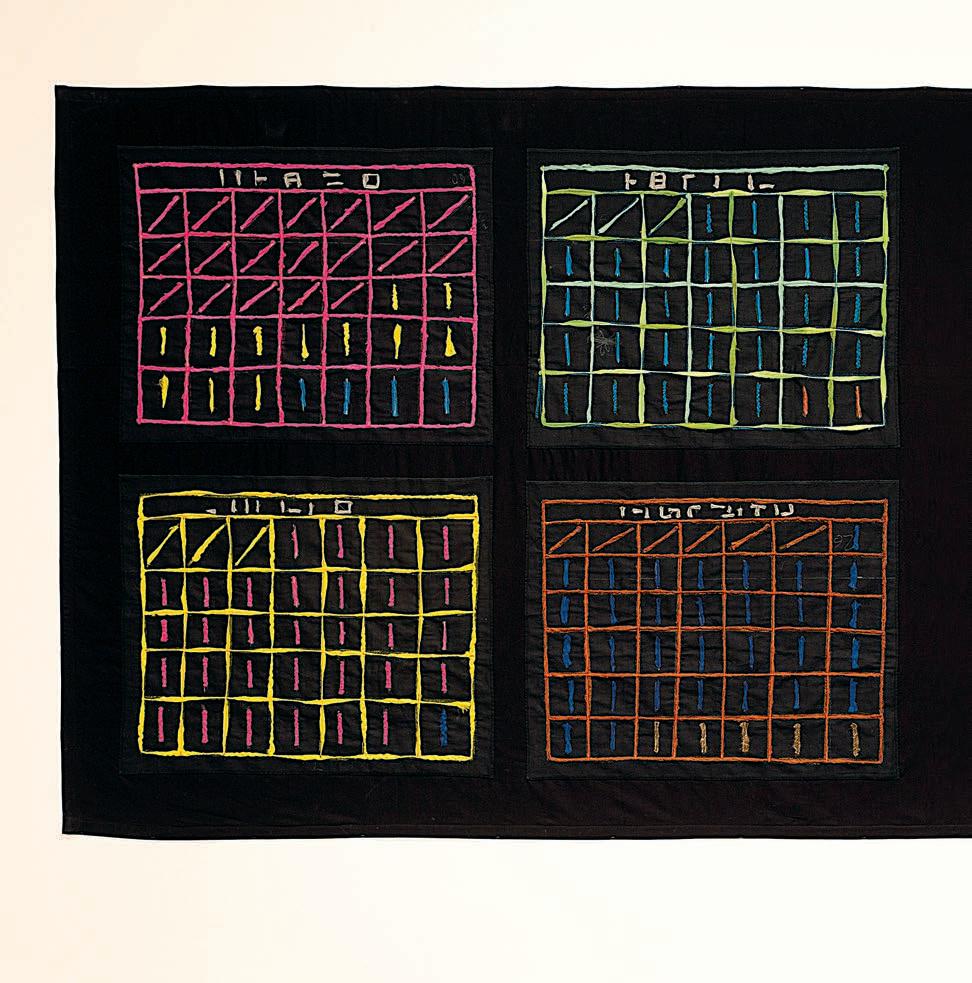
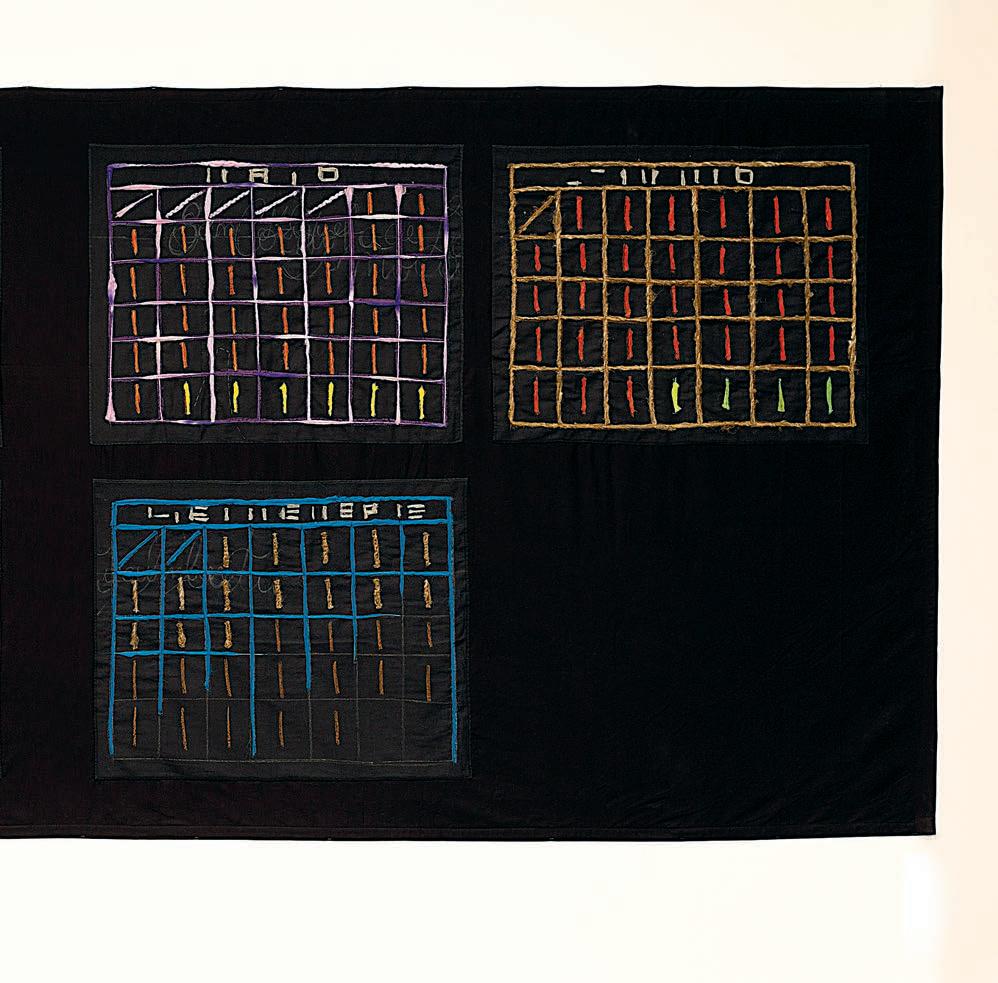
Fucsia, dorado y marrón [Fuchsia, Gold and Brown], 2021
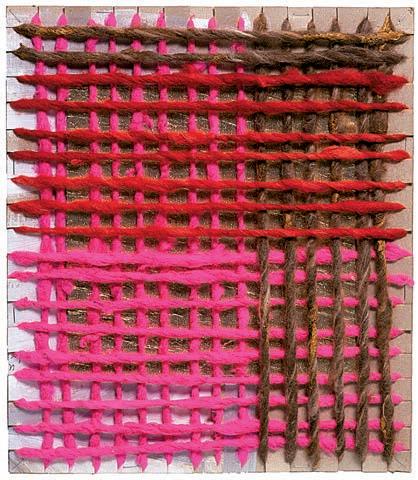
Taglis por adición [Tagli by Addition], 2021
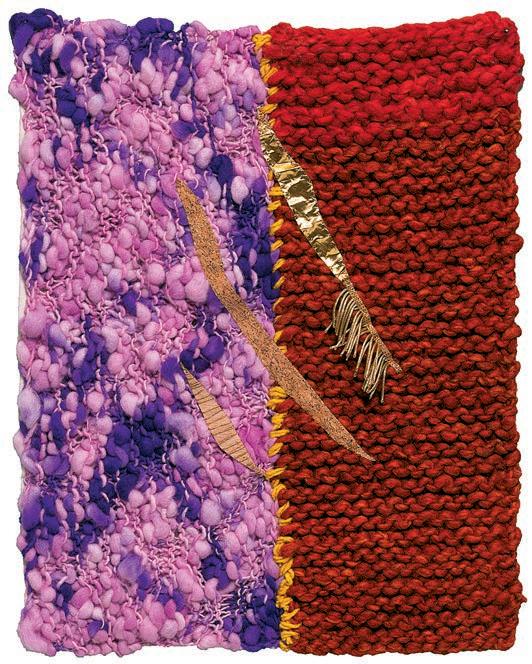
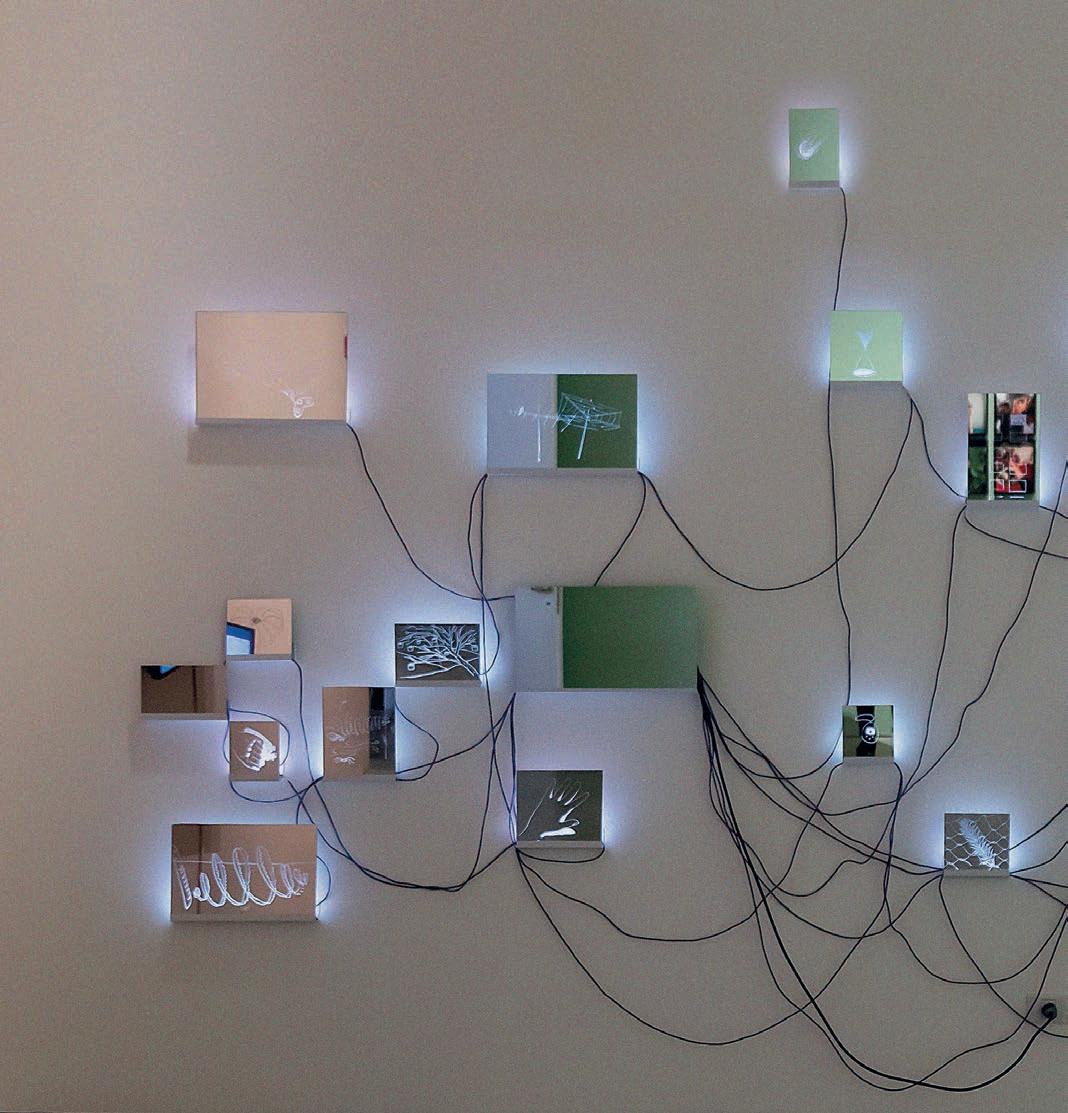
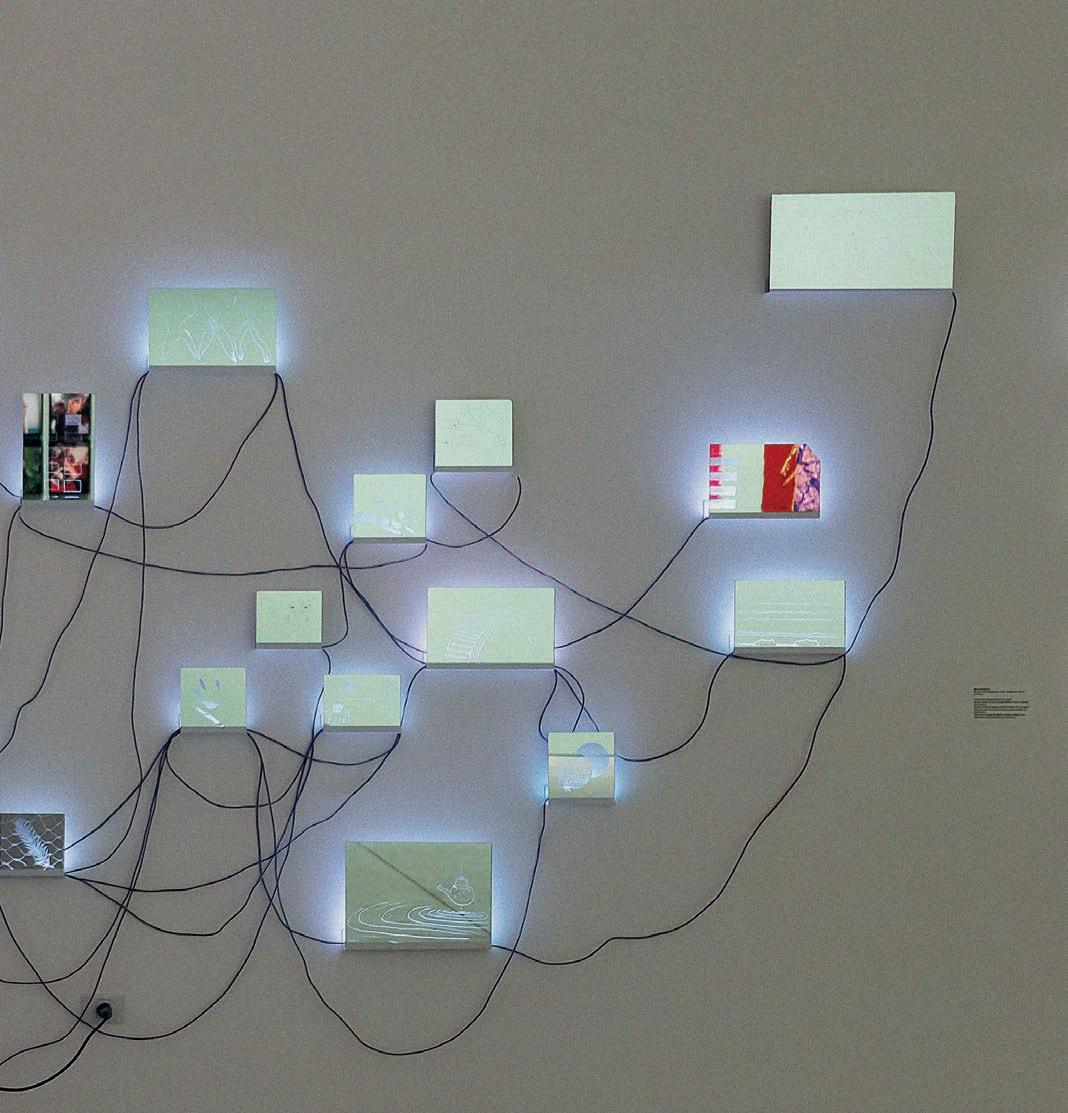
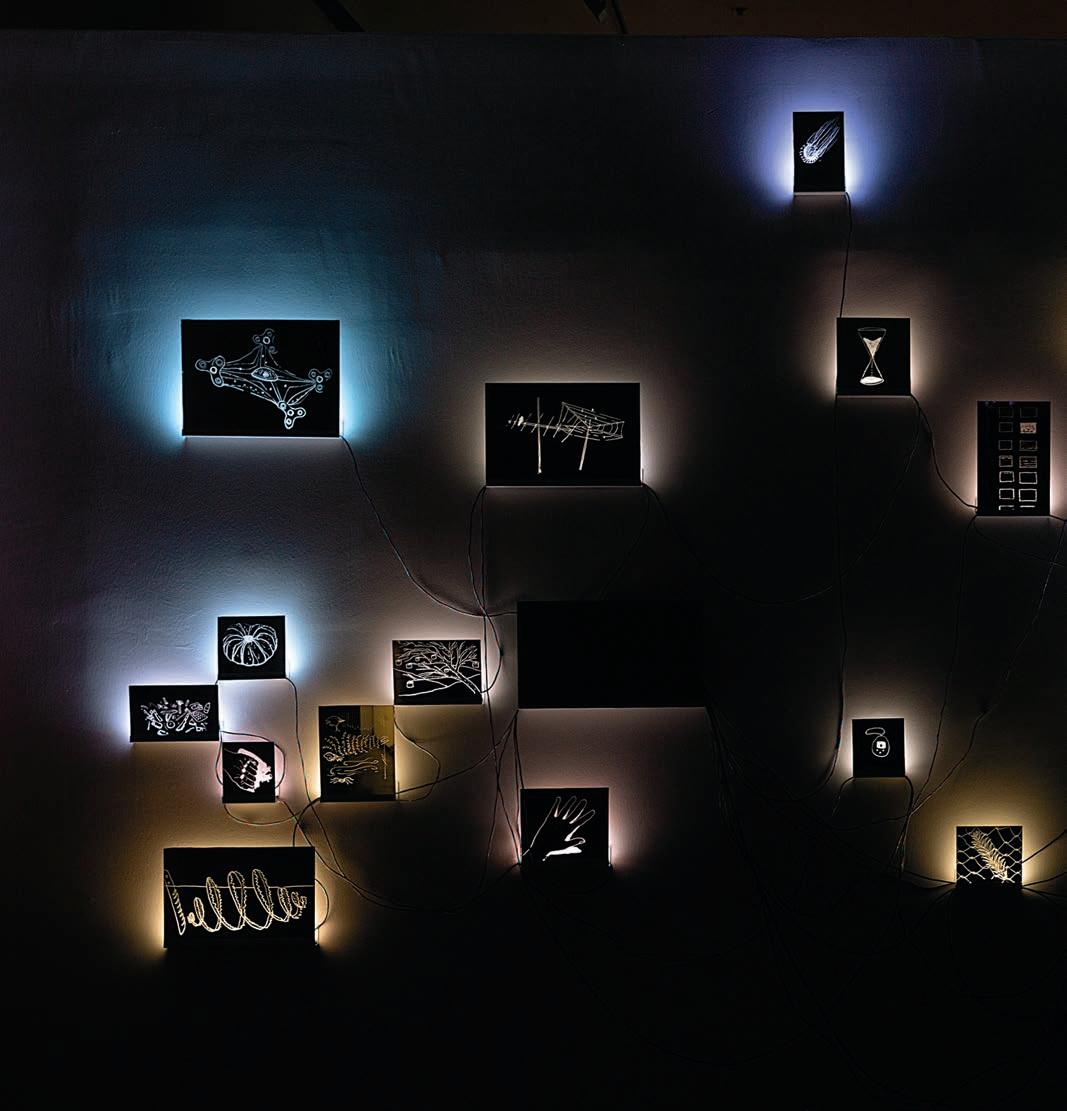
Otra vista de la obra [Another view of the artwork]
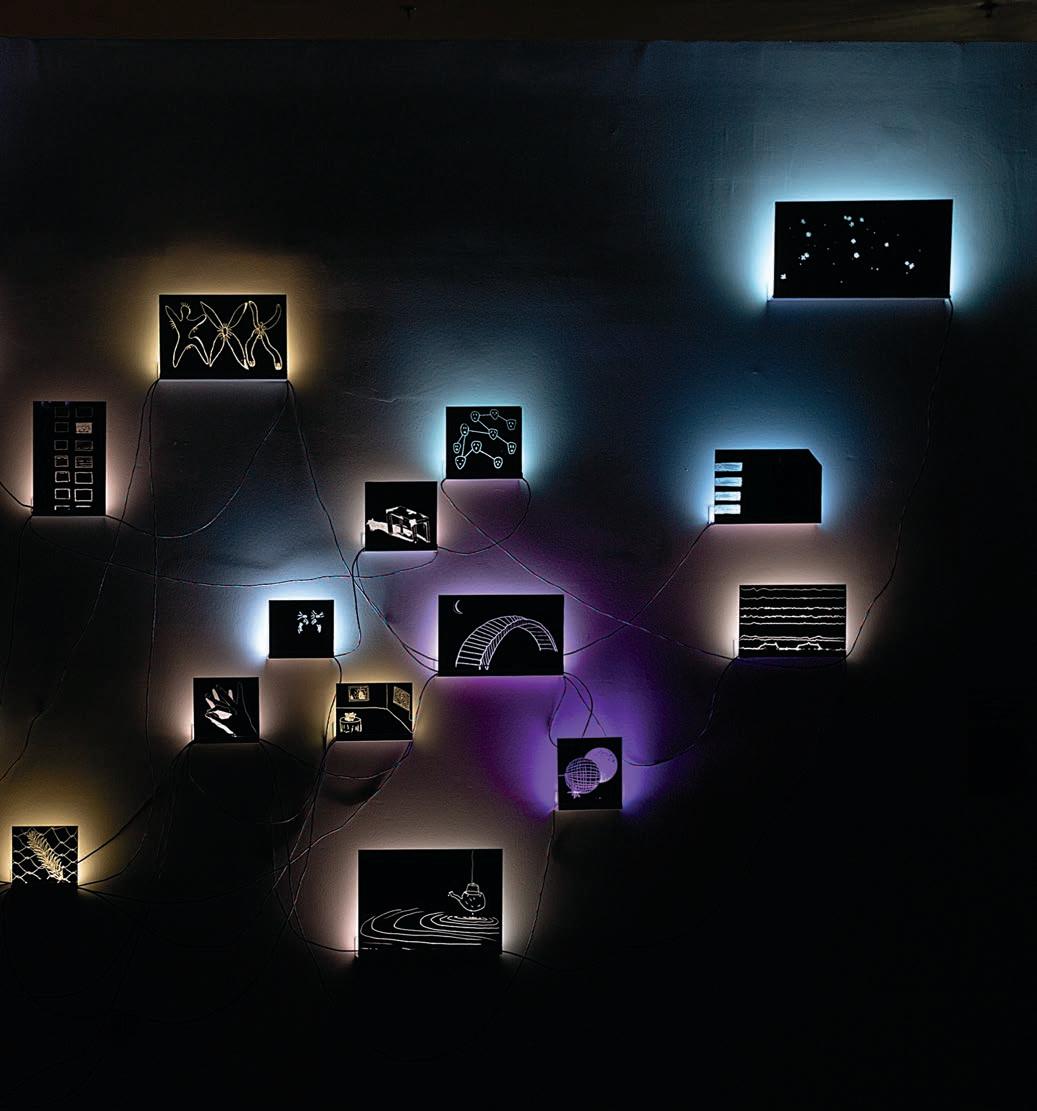
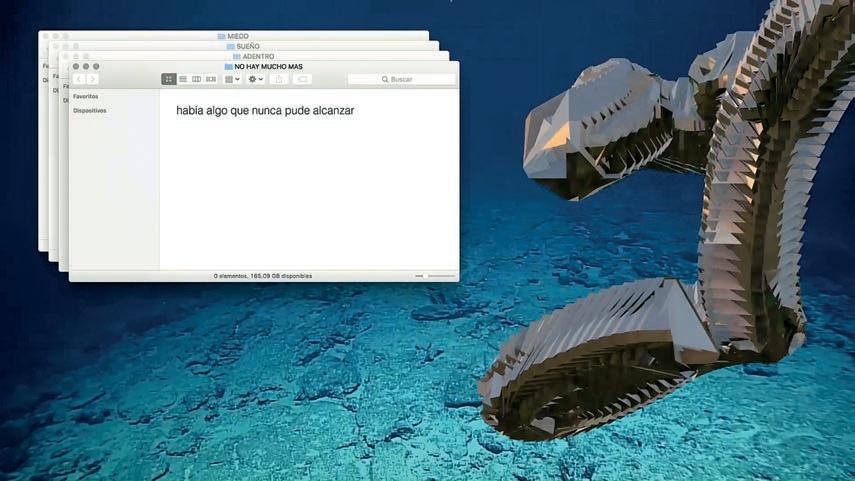
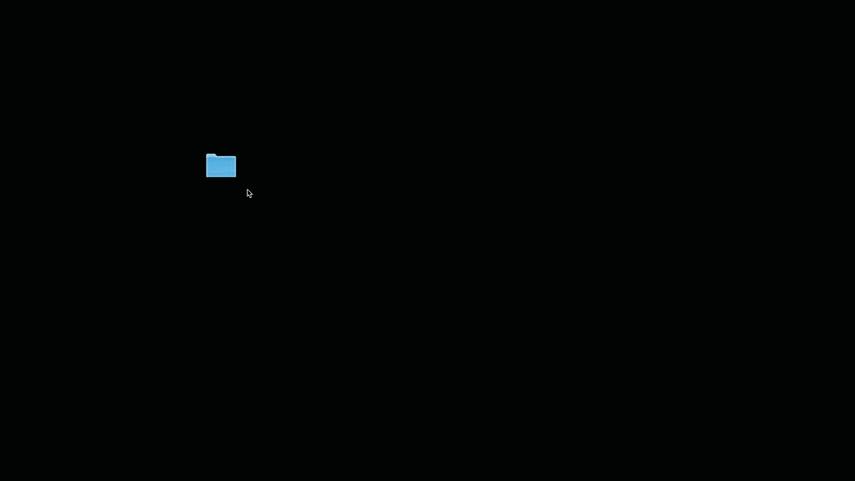
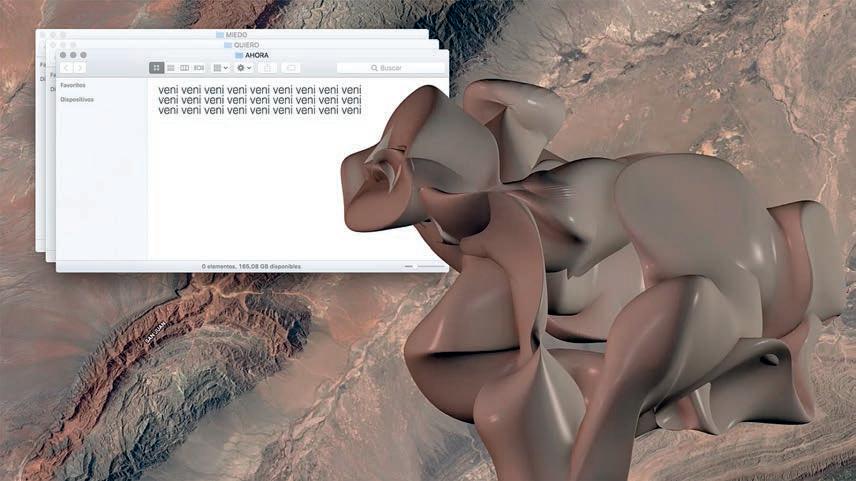
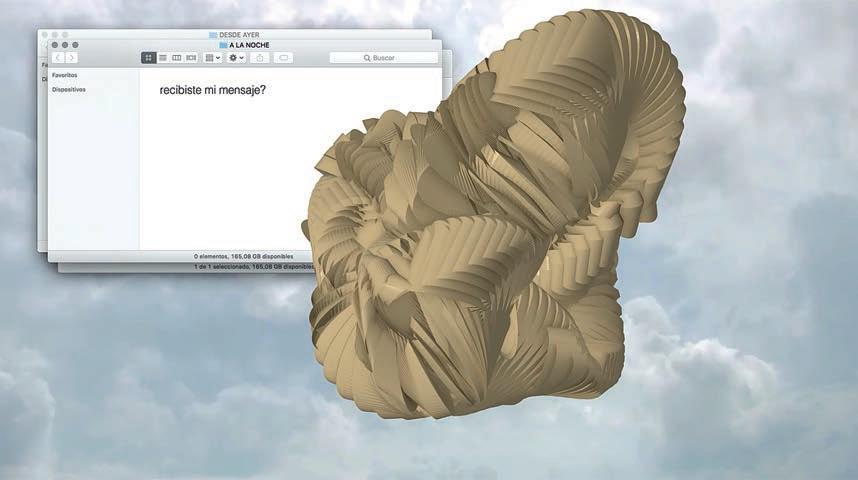
Chilkeadas las lenguas que vuelven del humo [Chilked the Tongues that Return from the Smoke], 2021
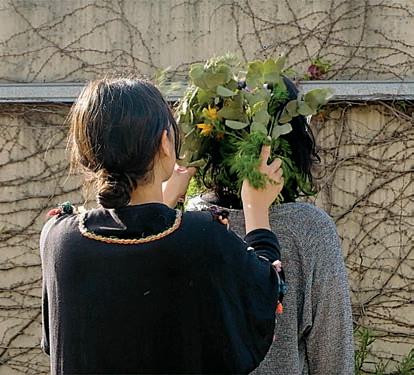
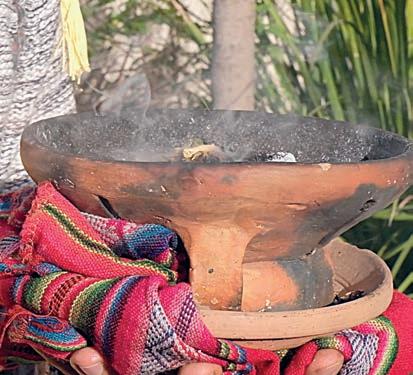
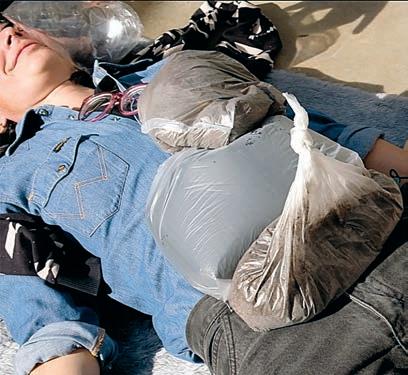
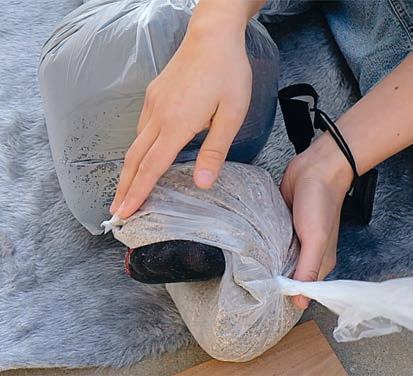
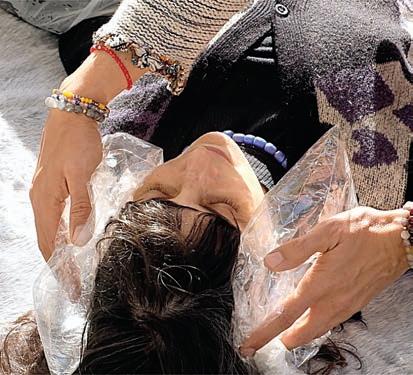
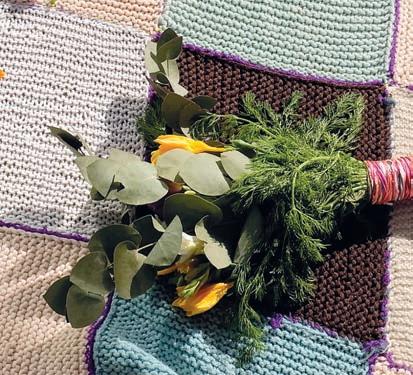
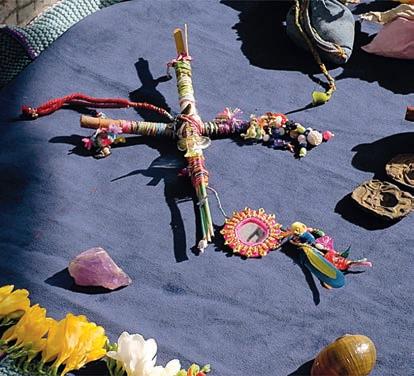
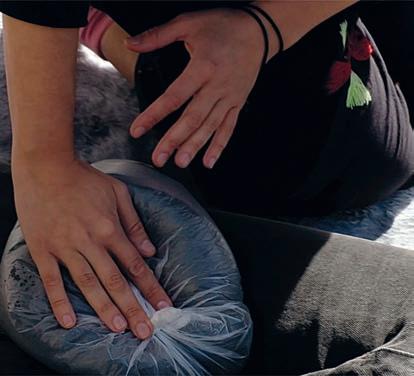
“pancóatl
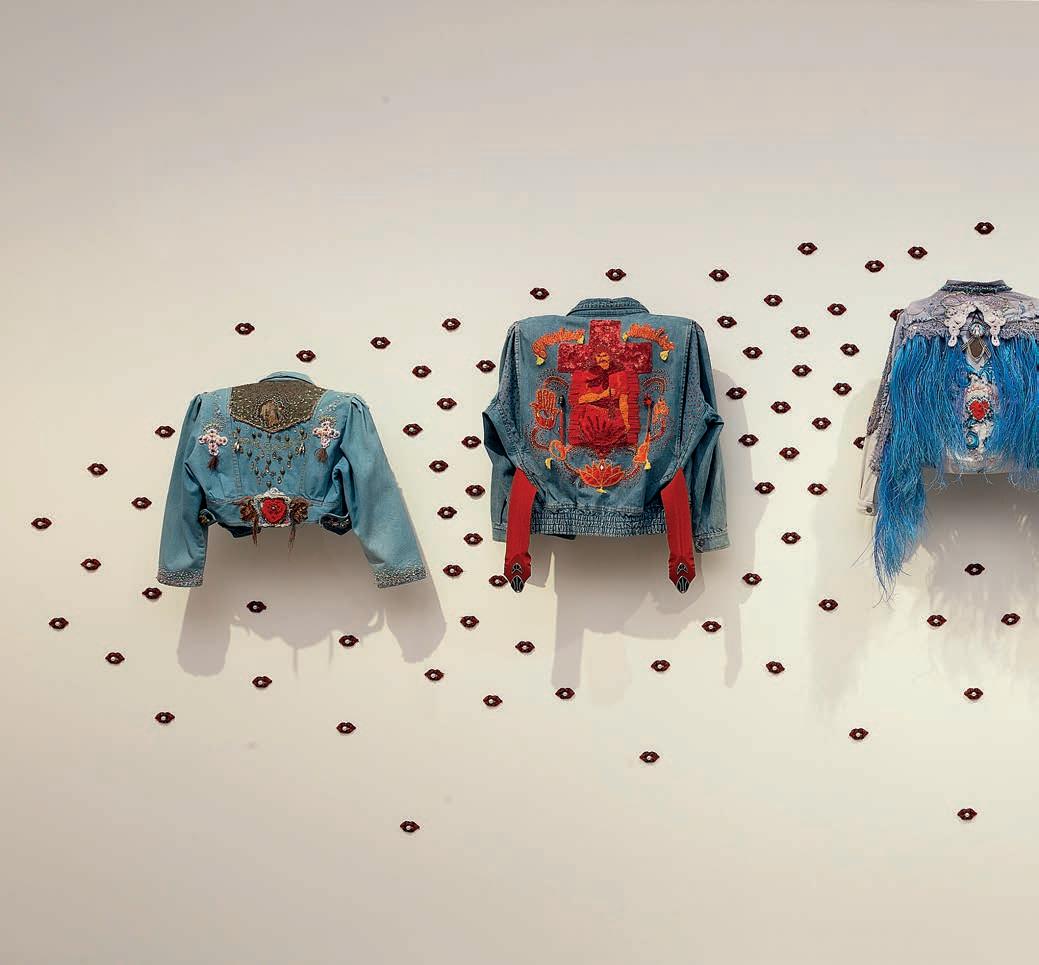
Gilda, 2016
Budagaucho [Buddhagaucho], 2019
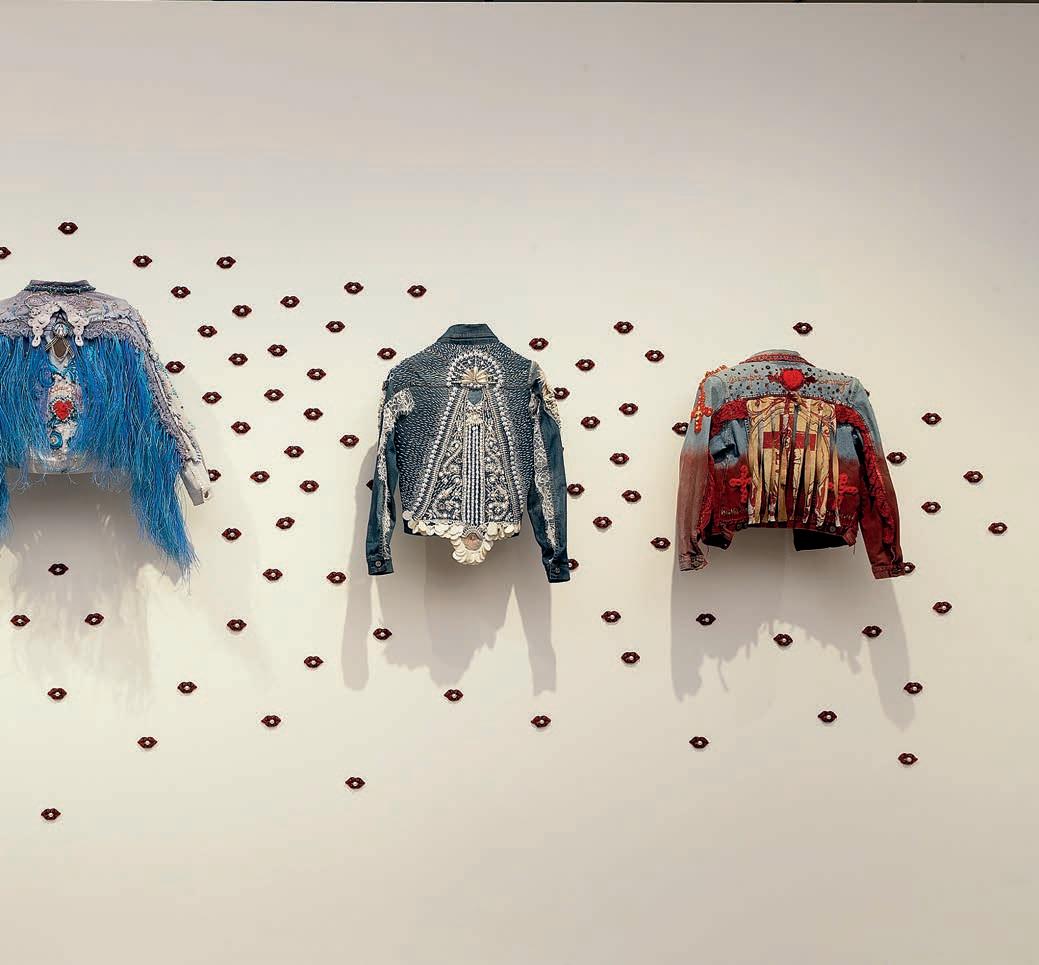
Pido un amor verdadero [I Ask For True Love], 2016
Baile del 16 de julio [16th of July Dance], 2019
Siempre conmigo [Always with Me], 2016
De la serie “Altares portables” [from the ‘Portable Altars’ series]
Baile del 16 de julio [16th of July Dance], 2019
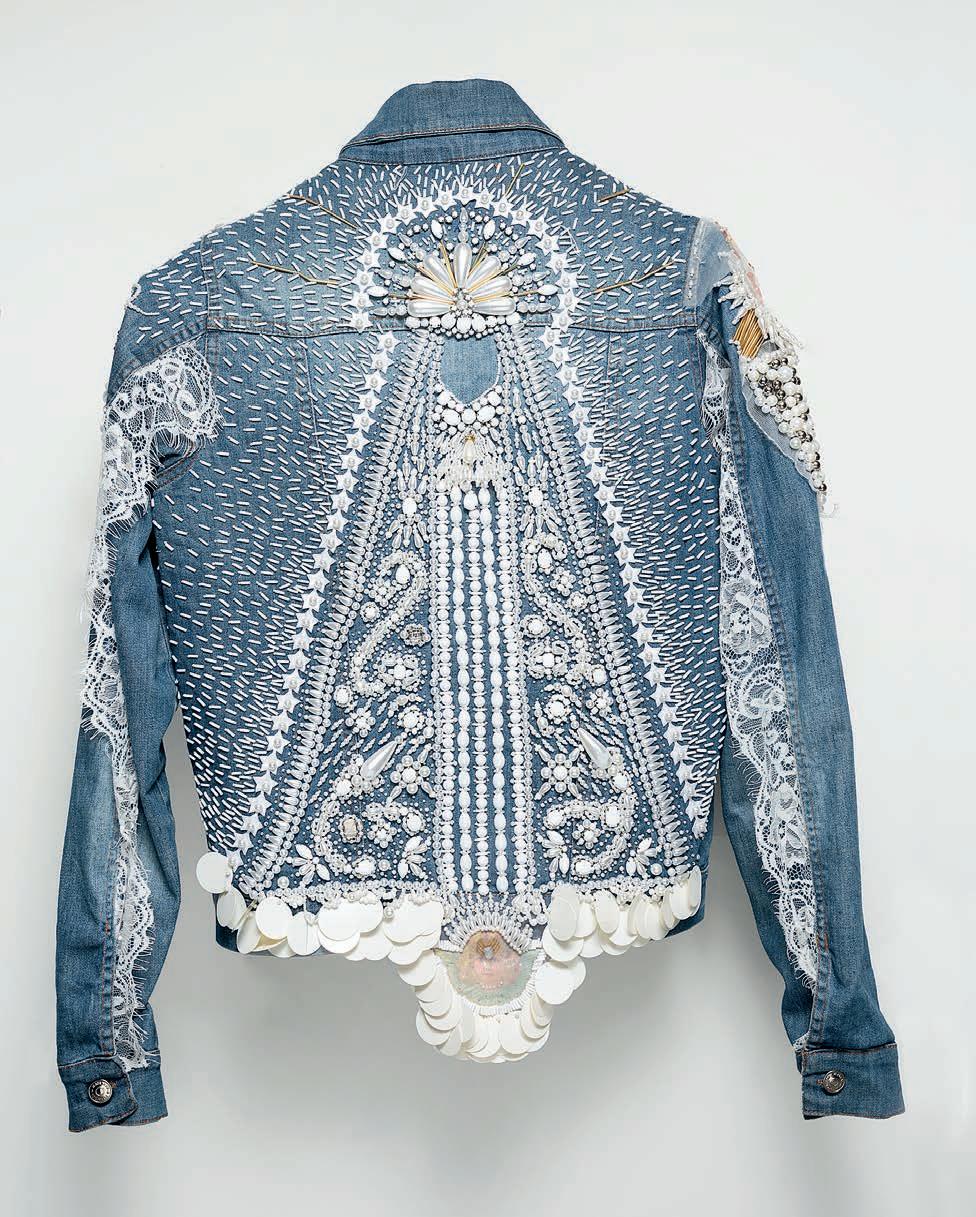
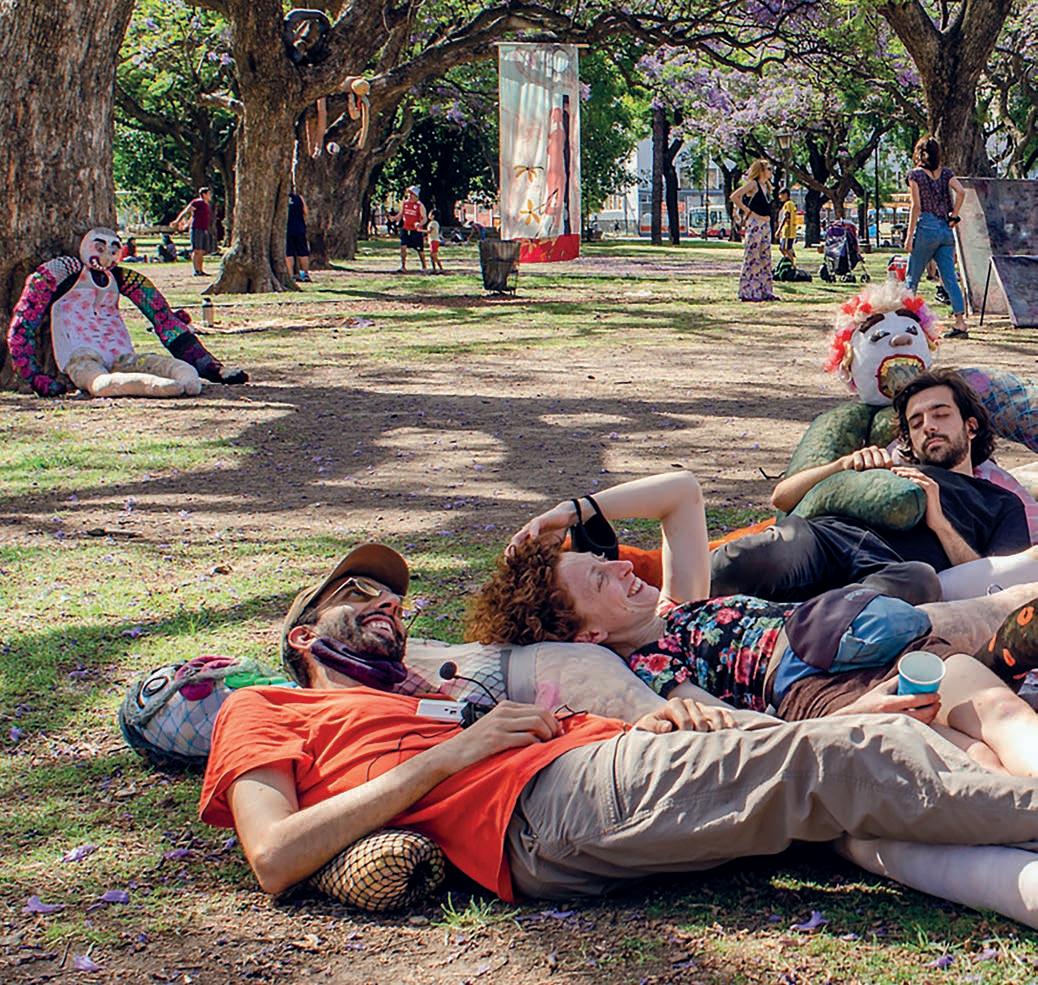
Serie “Los mareados” [‘The Dizzy’ series], 2020-2021 p. 60: Fotografías de “Los mareados” con sus tutores temporarios durante 2020 [Photographs of “The Dizzy” with their temporary guardians during 2020]
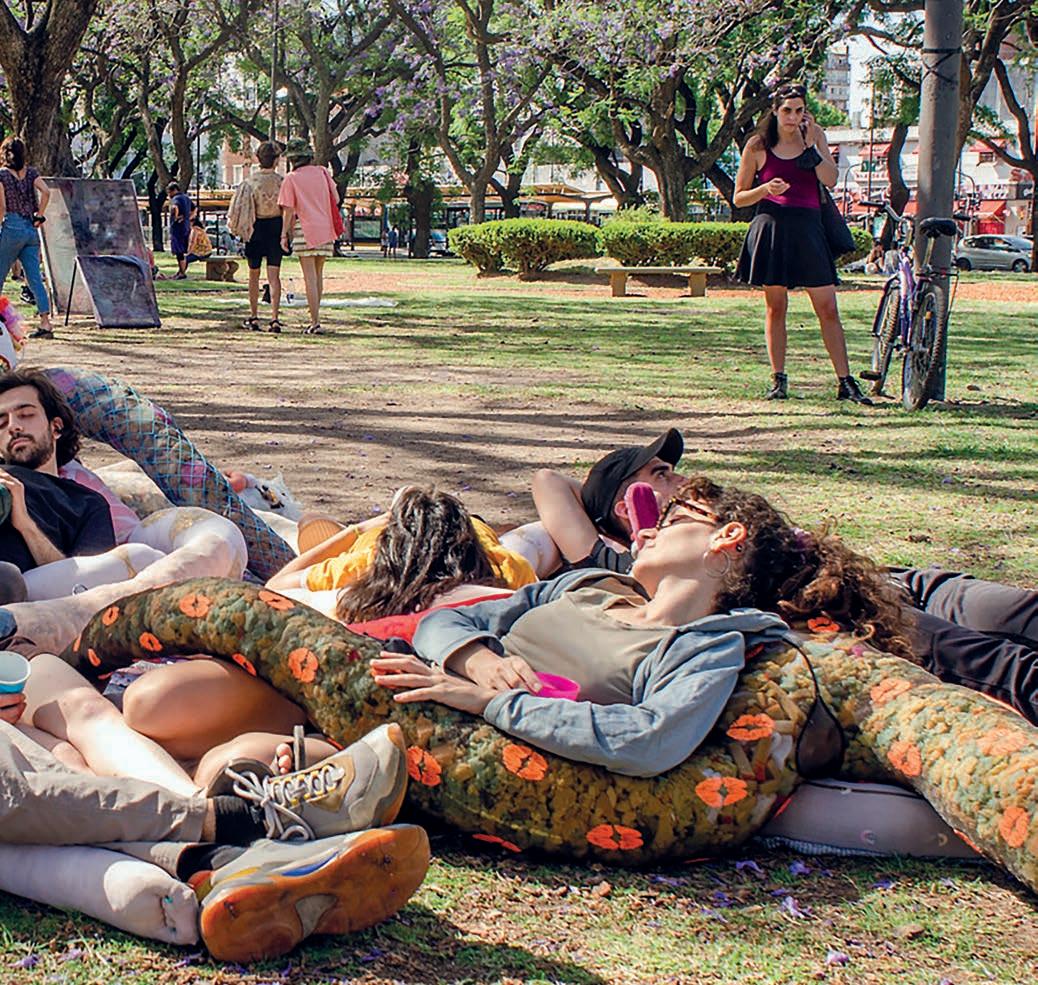
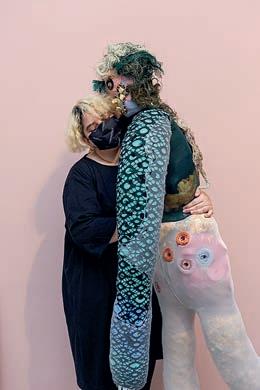
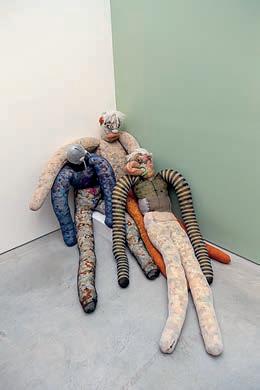
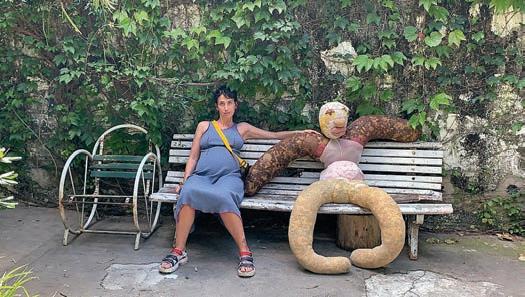
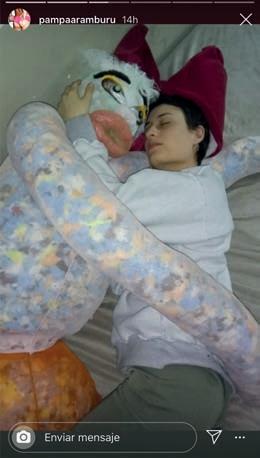
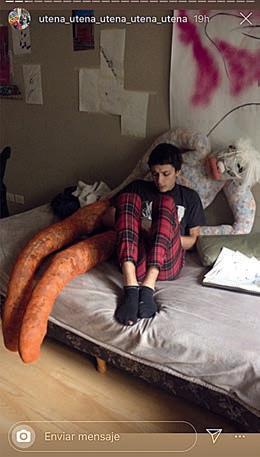

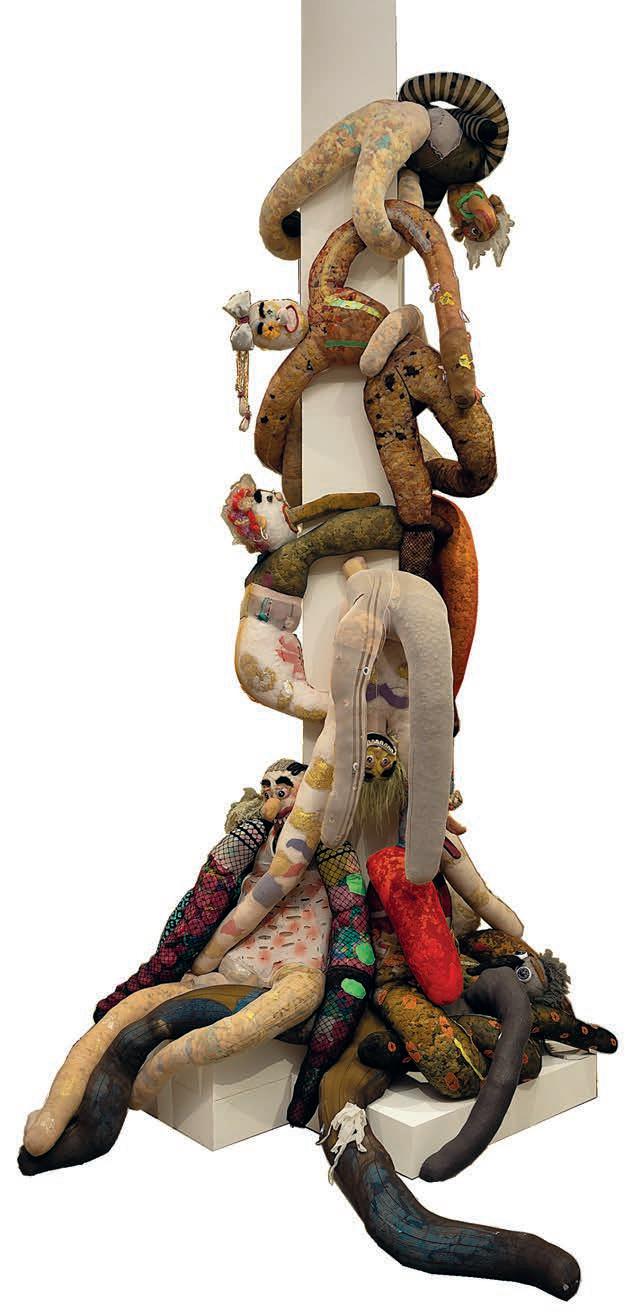
Muchas veces, mis imágenes bidimensionales son aperturas del espacio físico en el que habito. Las pienso como una extensión de la arquitectura misma. Ventanas, puertas, columnas, horizontes lejanos, paisajes microscópicos son apariciones recurrentes en la construcción de mis pinturas e instalaciones. El recorte del papel o la tela es una mirilla por donde espiar una otredad espacio-temporal. Esta posibilidad expandida de la pintura y el dibujo son lugares de contención, de anhelo y de proyección.
CAROLINA FUSILIER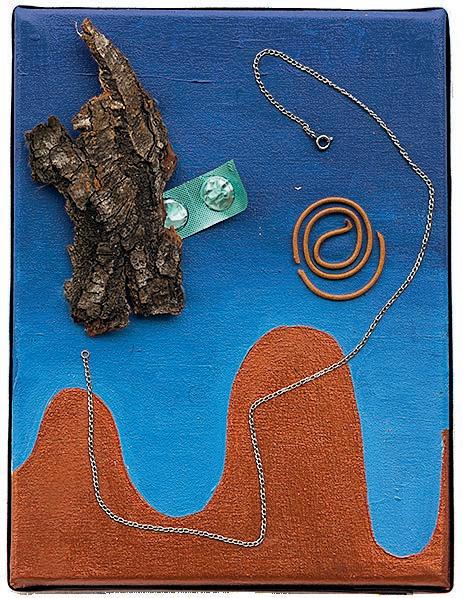
Cuatro obras Sin título, de la serie “Mesas revueltas y collages” [Four Untitled works, from the ‘Messy Tables and Collages’ series], 2020
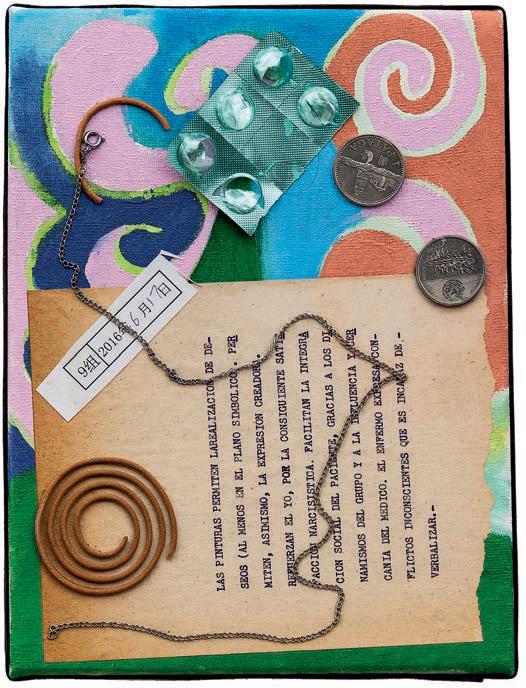
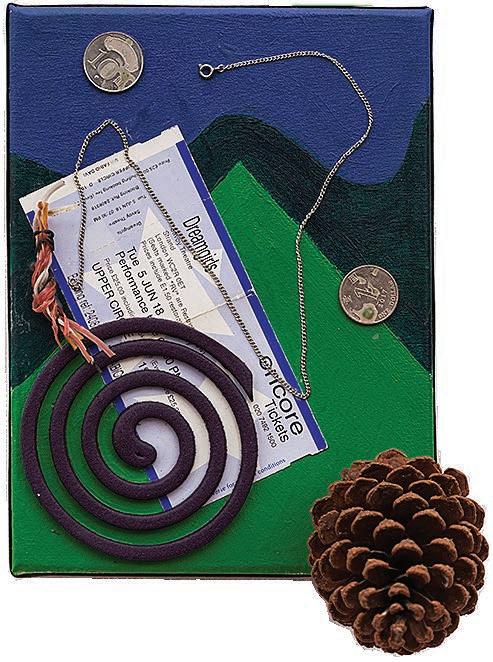
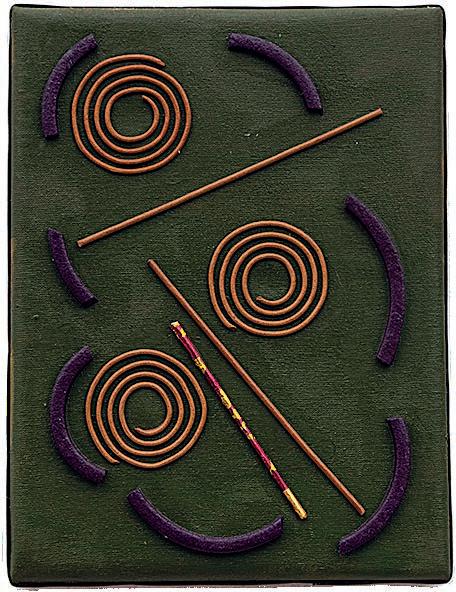
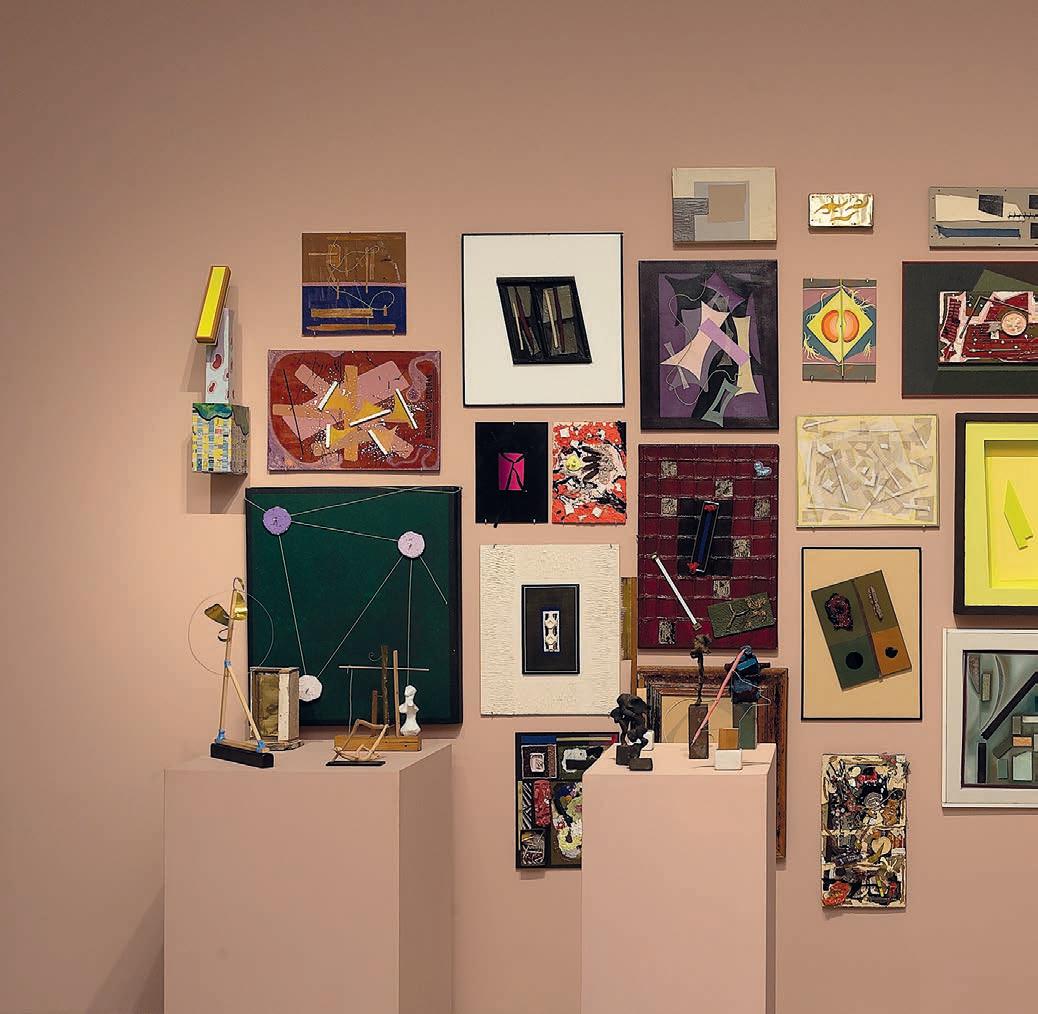
Templar la cuerda universal [Tuning the Universal String], 2021 pp. 70-71: Dos obras Sin título, 2021, de la instalación [Two Untitled works, 2021, from the installation]

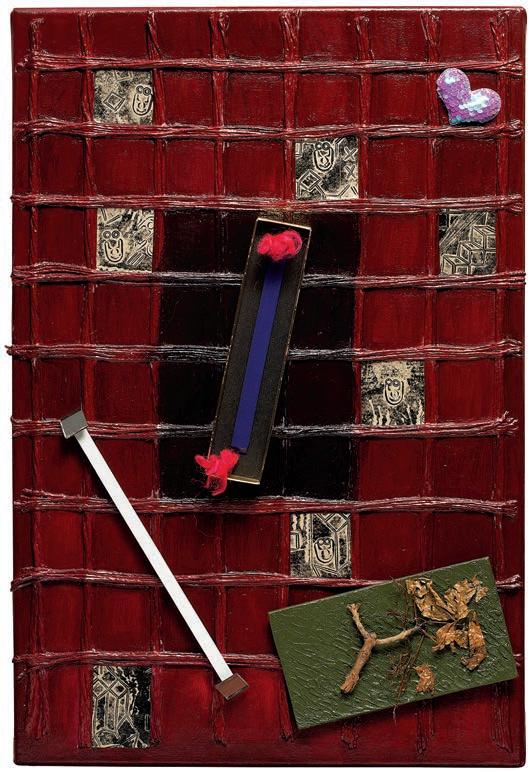
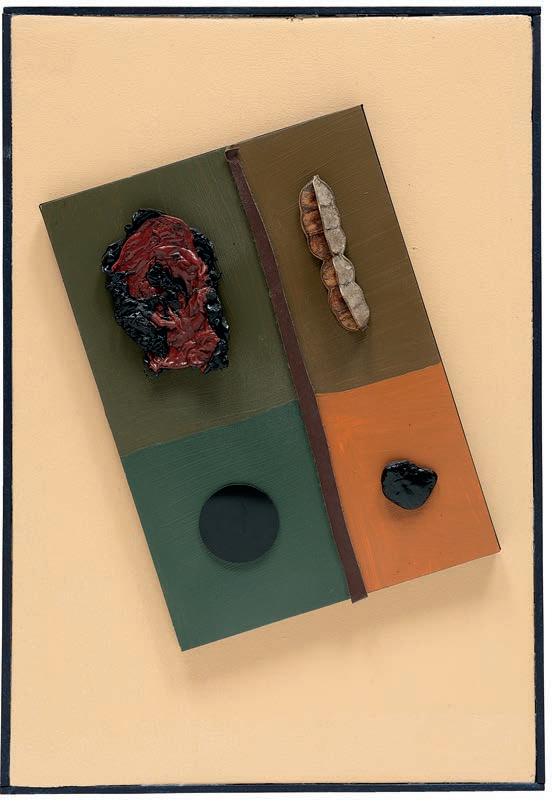

Ministrx de Agricultura y Ganadería [Minister for Agriculture and Livestock], 2017 Ministrx de la Condición de la Mujer [Minister for the Status of Women], 2018
De la serie “No tengo fuerzas para rendirme” [from the ‘I Don’t Have the Strength to Surrender’ series]


Ministrx de Ambiente y Energía [Minister for the Environment and Energy], 2017-2018
De la serie “No tengo fuerzas para rendirme” [from the ‘I Don’t Have the Strength to Surrender’ series]

Triste y melancólica [Sad and Melancholic], 2020
Calaveras [Skulls], 2021
Virus, 2021
Zzz, 2021
Pobres corazones [Poor Hearts], 2021
Invocación [Invocation], 2021
Selfies, 2021
De la serie “La lengua de las piedras” [From the series ‘The Language of Stones’]







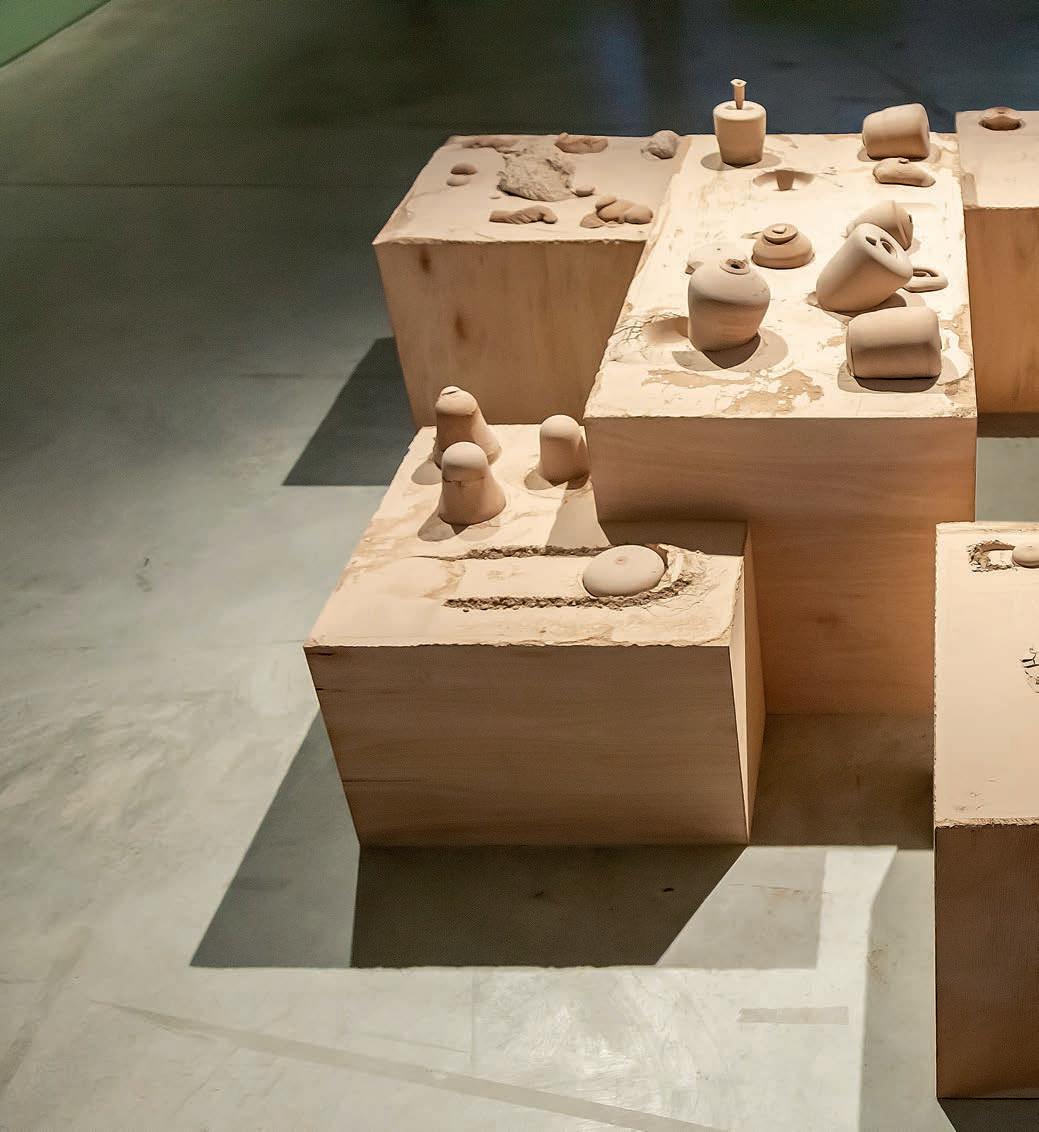

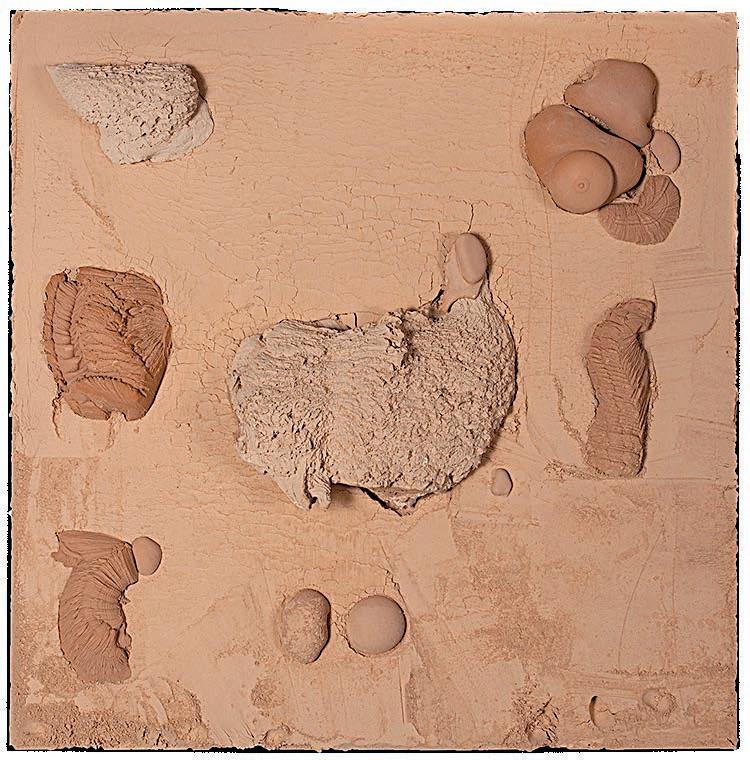
Cuando me mudé a Santa Fe, me flechó la costa de la laguna Setúbal, un lugar de la ciudad al que podés llegar fácilmente caminando o en bicicleta. Siempre que puedo voy. Lo que más me atrae es que descubro algo diferente cada vez. El año pasado, con la bajante, empecé a encontrarme con piedras que me gustaron por sus formas y tonalidades. Siempre estuvieron ahí, pero al bajar tanto el río se avistaban más. De manera instantánea imaginé emojis tallados en ellas. Pensé que, si de repente desapareciésemos, quedarían esas piedras y quien las encontrara en un futuro descifraría una suerte de mensaje.
La principal motivación de estos trabajos fue las ganas y el placer que me da construir, la acción que me lleva a darles orden y sentido a los materiales, la sensación de principio sin fin, continuidad, movimiento, un ejercicio de resistencia a la inclemencia, trinchera de días muchas veces difíciles. Dejar un mensaje a la nada y al todo, a una persona y a todas. Sensación de templanza en mi universo personal. Destreza y heroísmo. Muchas veces pienso que mi motivación es una herencia, pertenencia a un linaje de artistas y artesanos que me antecedieron. Entonces, la práctica artística me conmueve y me llena de goce: es la sensación de estar cumpliendo con un designio del universo.
CARLOS AGUIRRE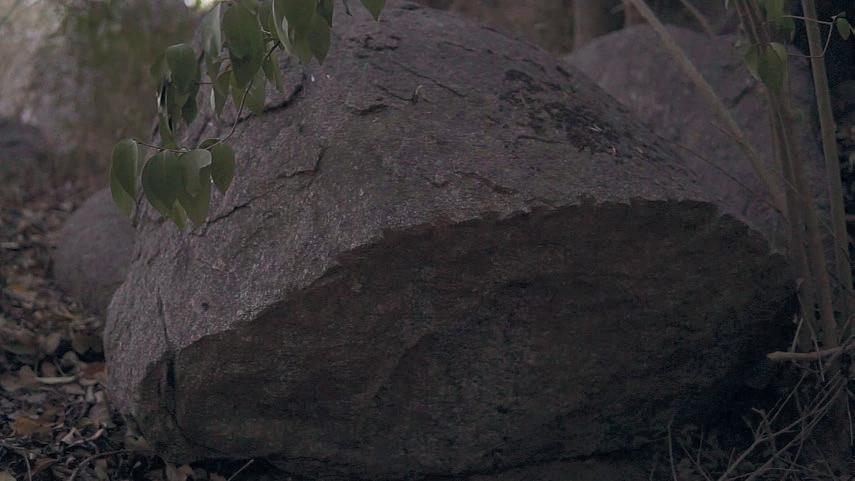

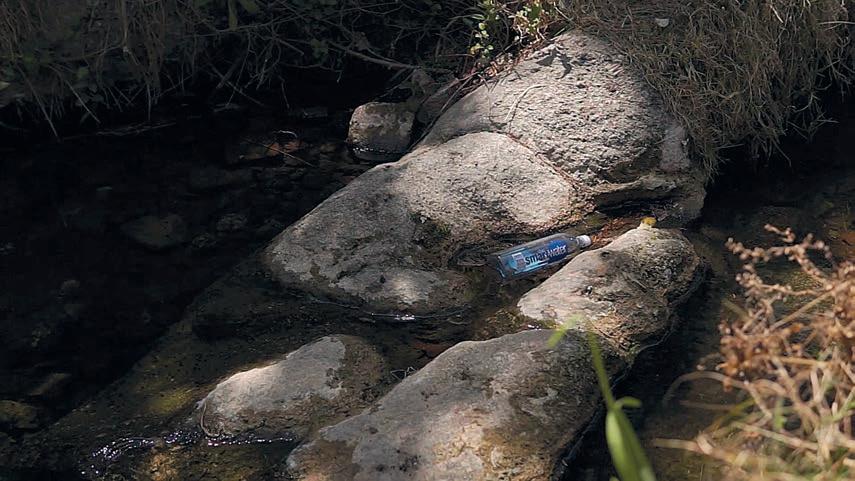
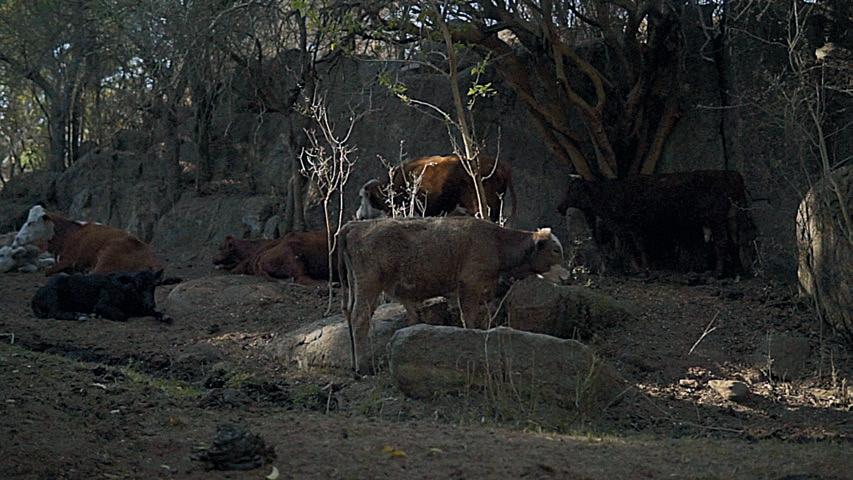
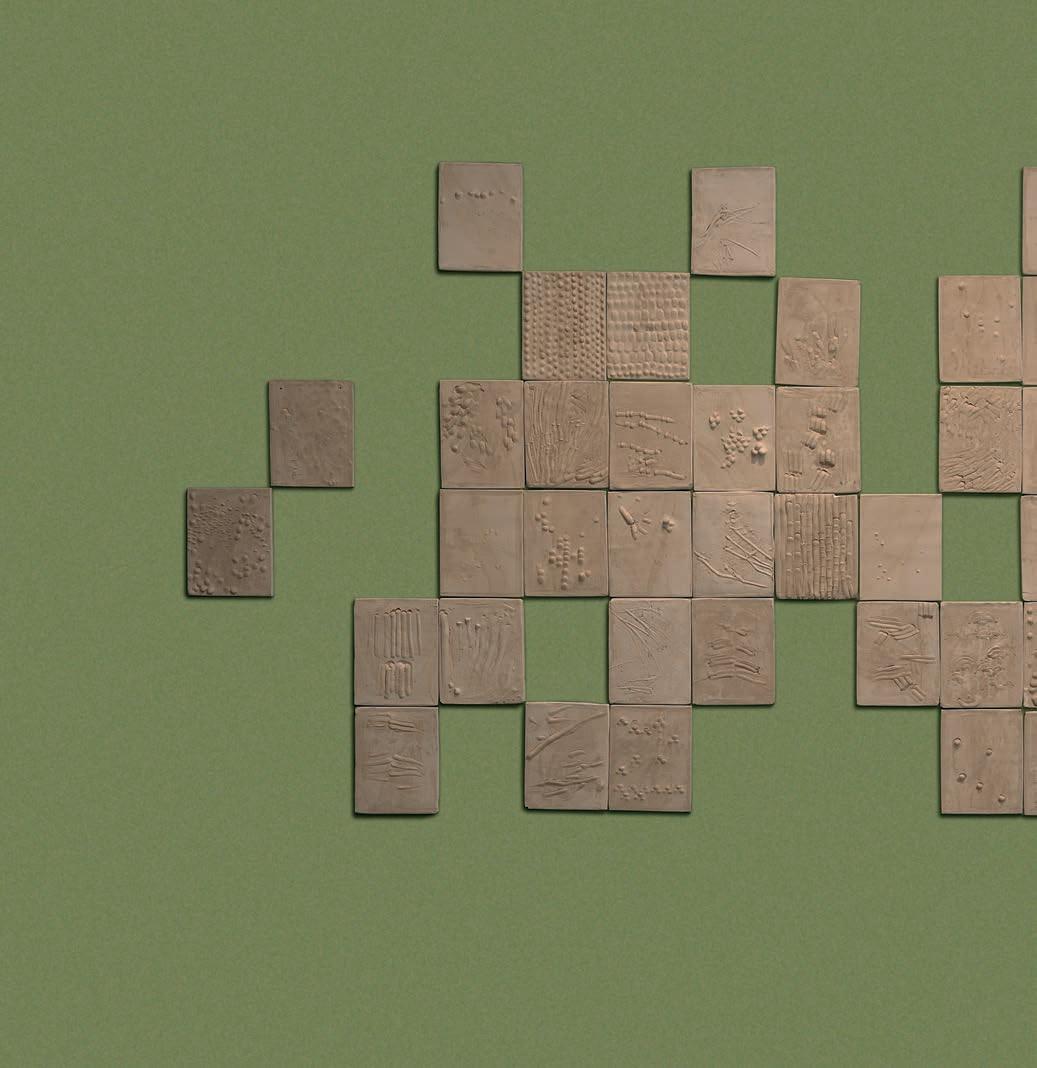
Sin título [Untitled], 2021
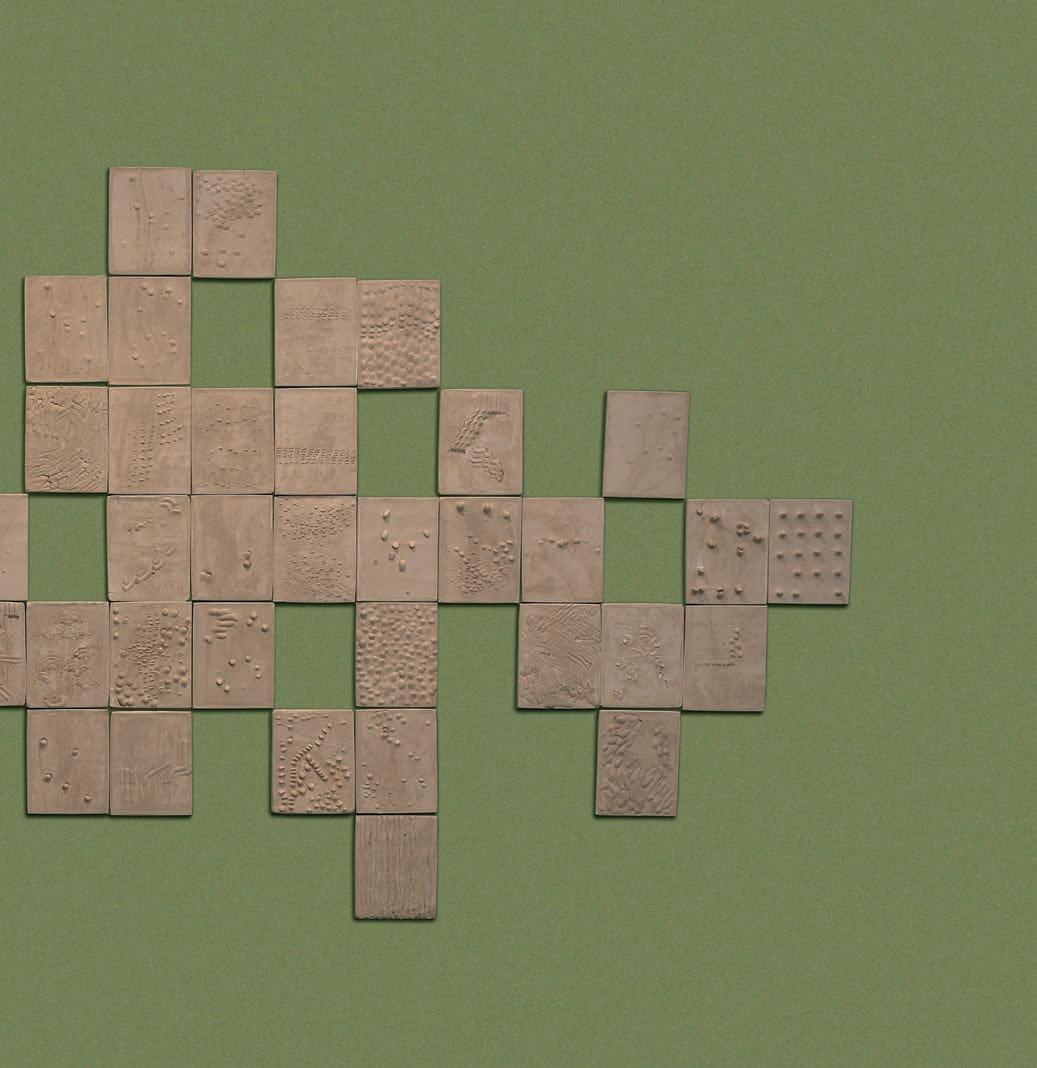
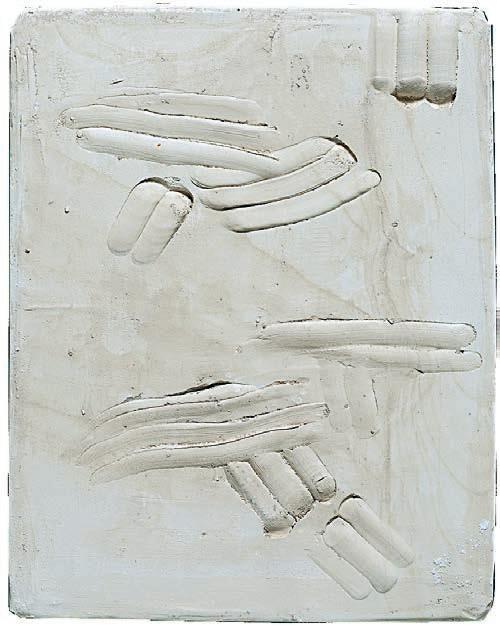

Seis obras Sin título, de la serie “Ladrillos danzarines” [Six Untitled works, from the ‘Dancing Bricks’ series], 2020 Ladrillos camino [Road Bricks], 2020


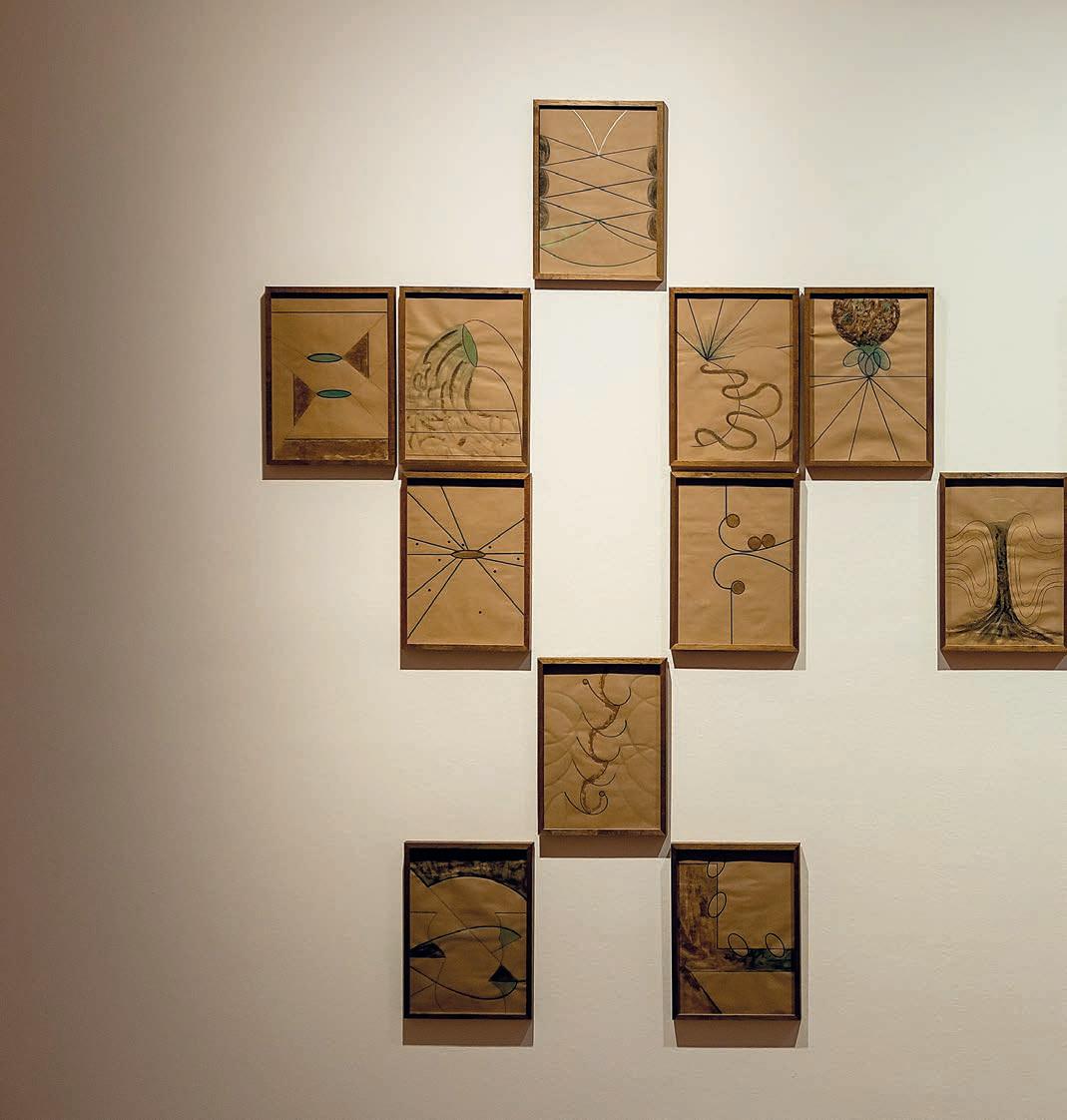
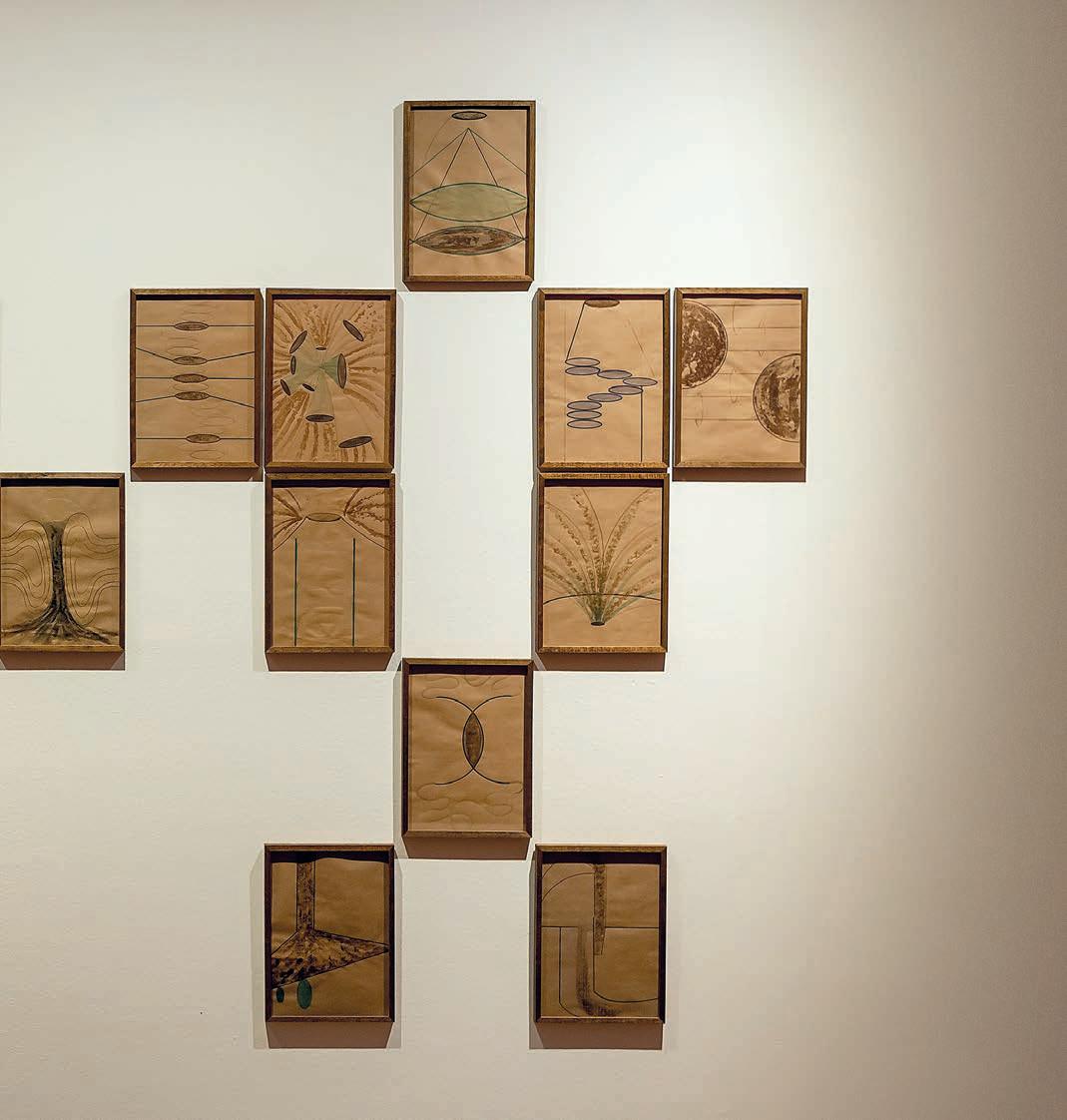
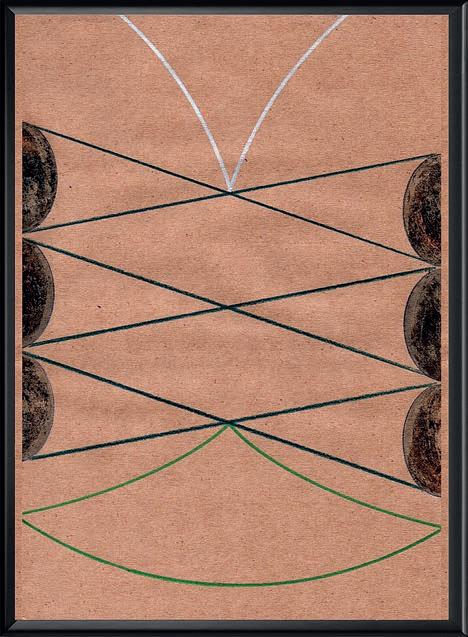
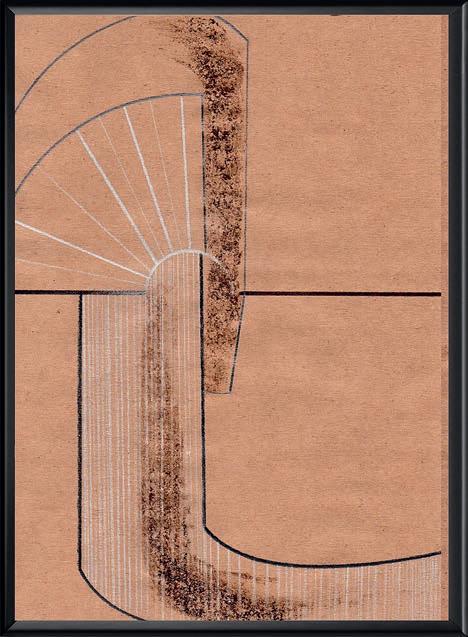
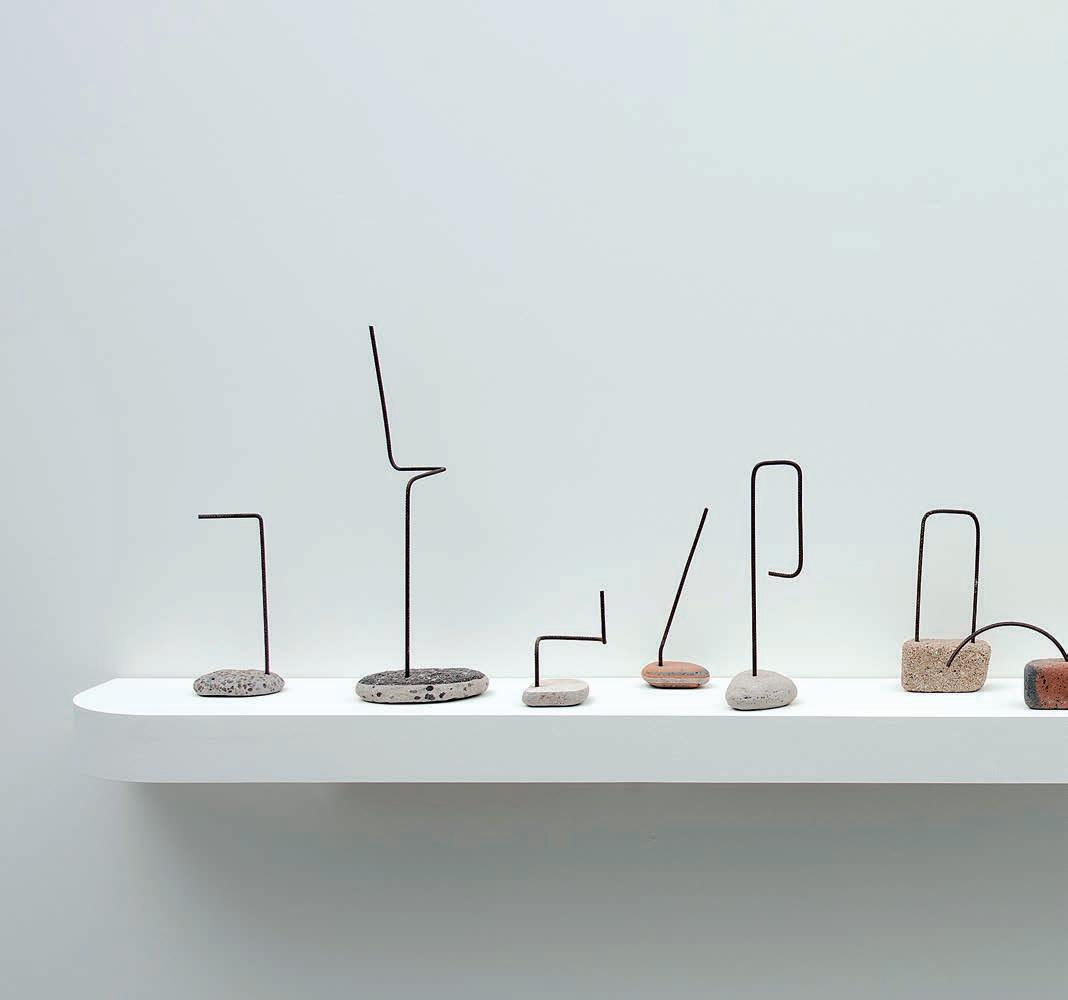
Erosión [Erosion], 2020
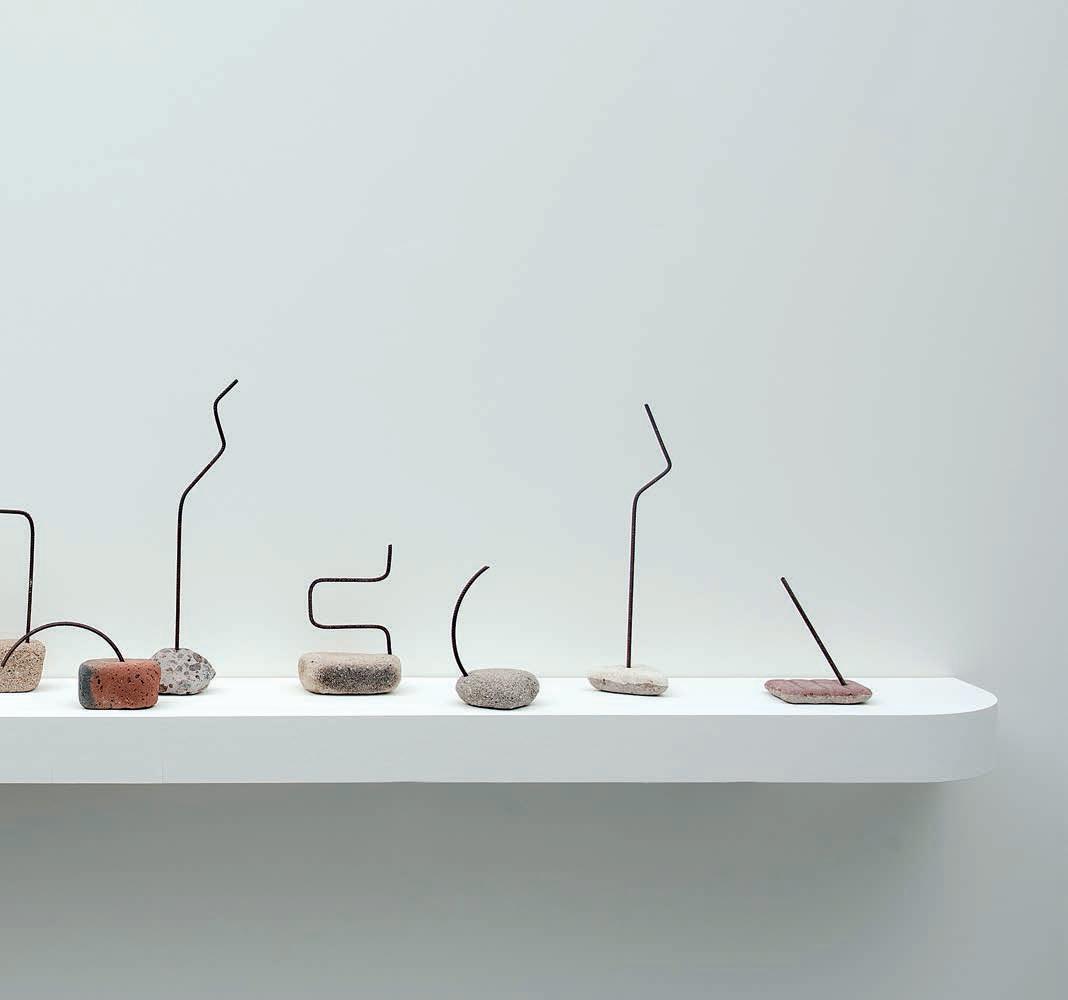
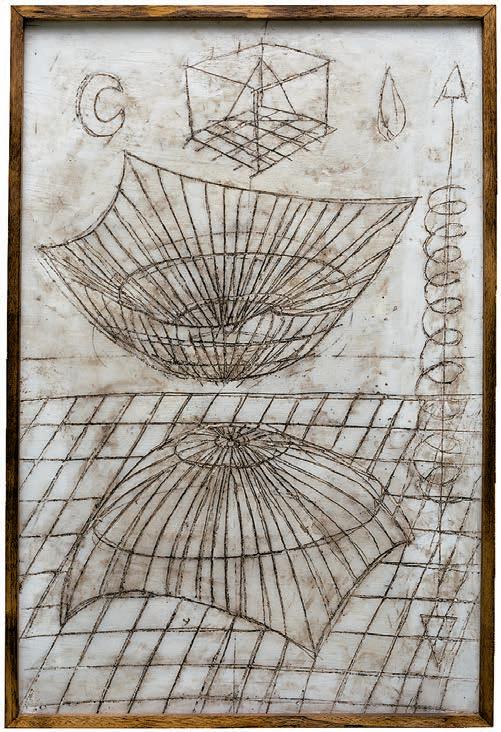
Conjuros hiperboloides [Hyperboloid Spells], 2020 El colapso del brujo [The Sorcerer’s Collapse], 2020
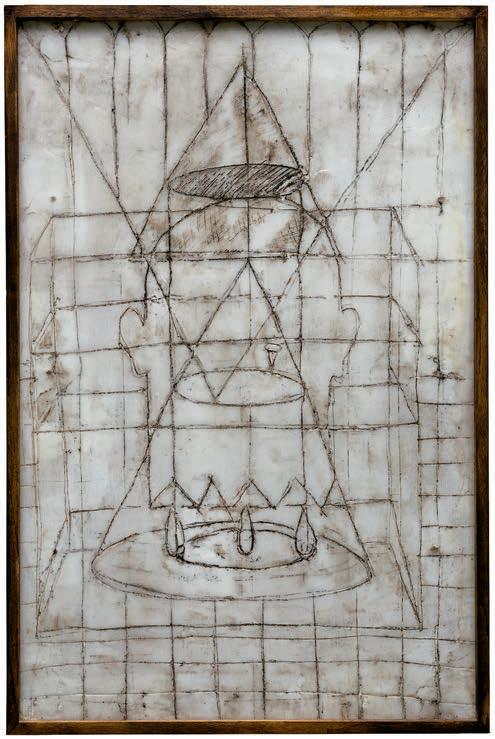
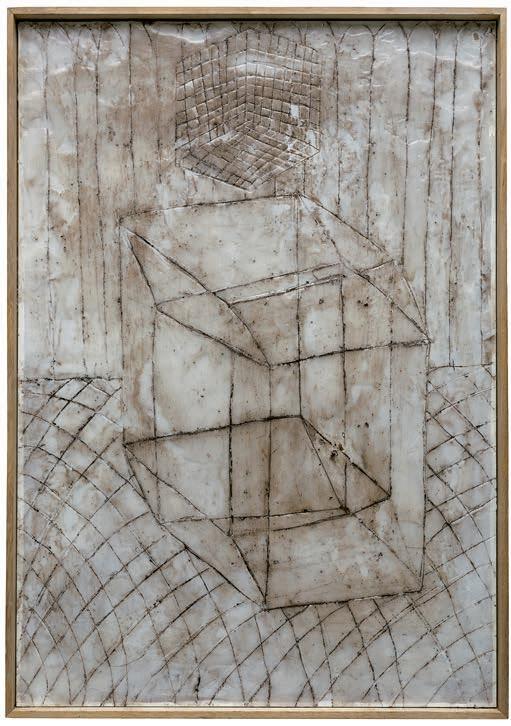
La métrica protectora [Protective Metrics], 2020
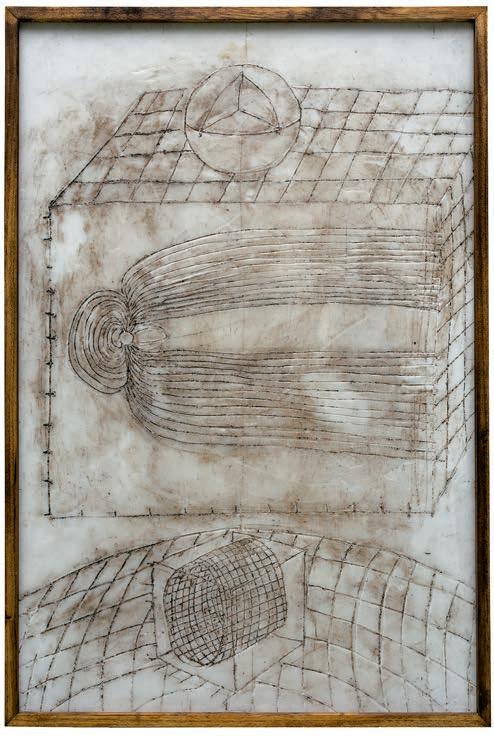
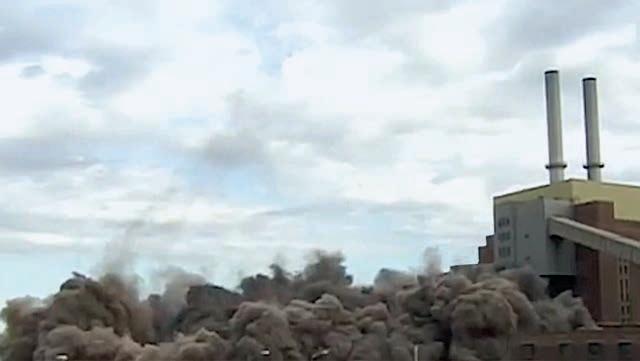
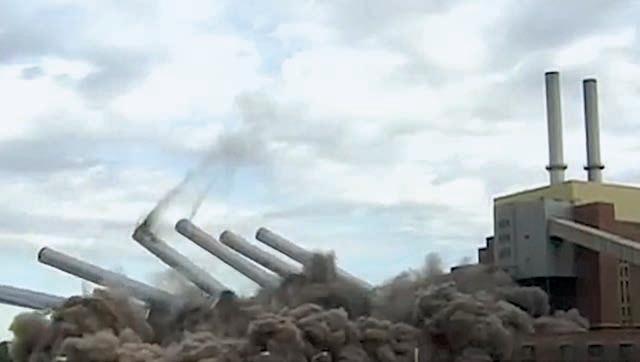
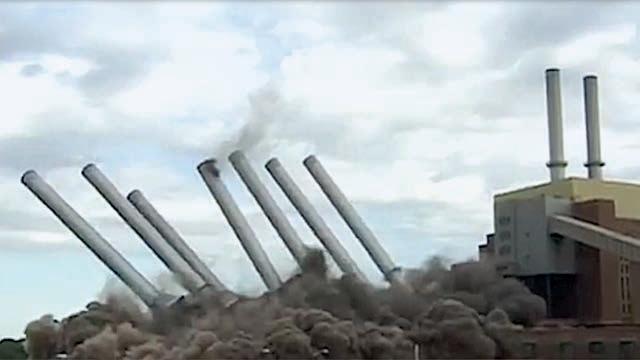



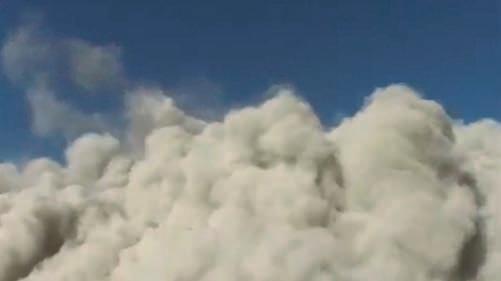
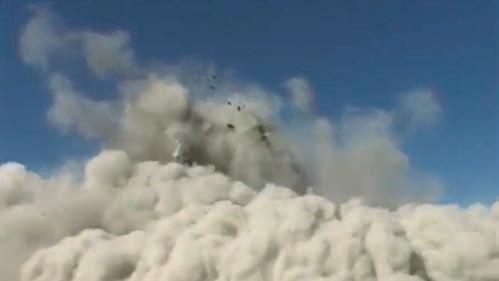
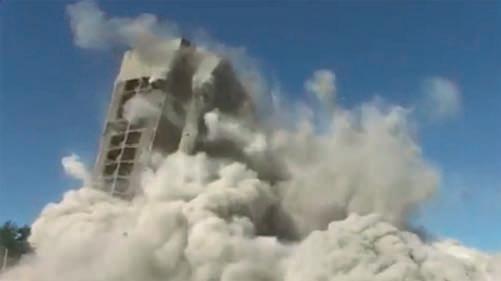
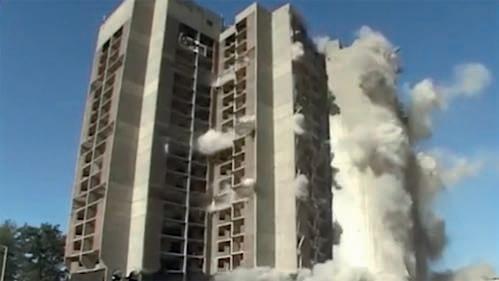

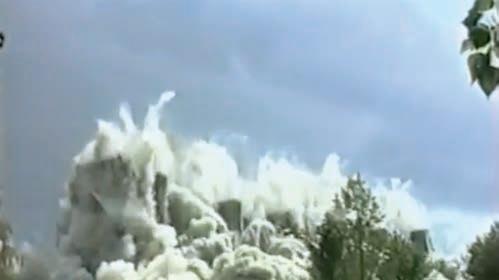
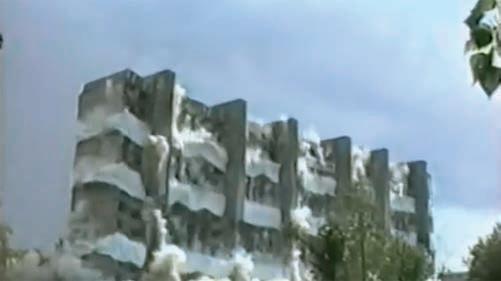
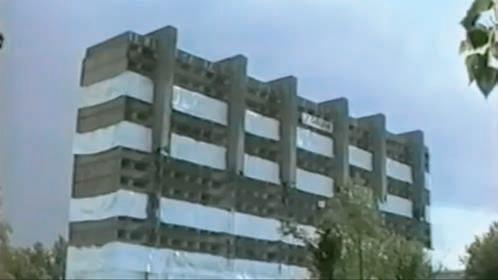
Caminar, recolectar, mover, superponer, reunir, contemplar, venerar son gestos importantes en mi práctica, establecen una relación con la superficie terrestre y con los elementos y transformaciones del paisaje. Me interesan las historias de algunos gestos, como clavar una piedra, mover un objeto, superponerlo, hacer una herramienta, mirar el sol, tratar de comprender qué es lo que se mueve. Me interesan las formas que creamos para acercarnos a lo gigantesco.
FRANCISCO VÁZQUEZ MURILLO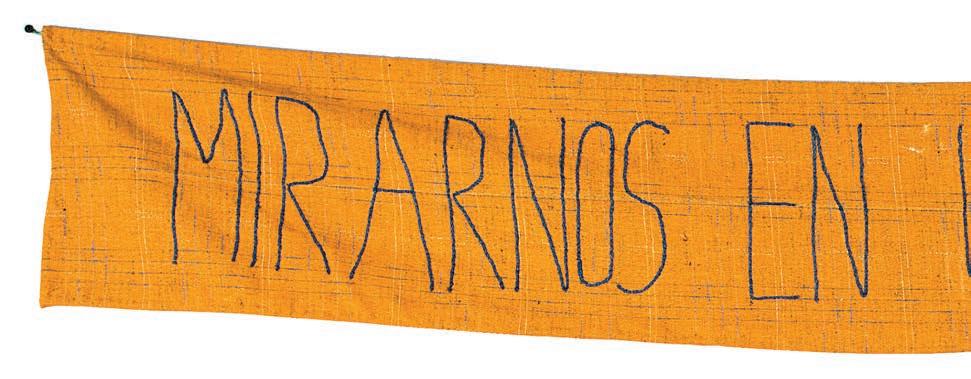
Artefacto de escucha Nº 6 [Listening Device No. 6], 2021
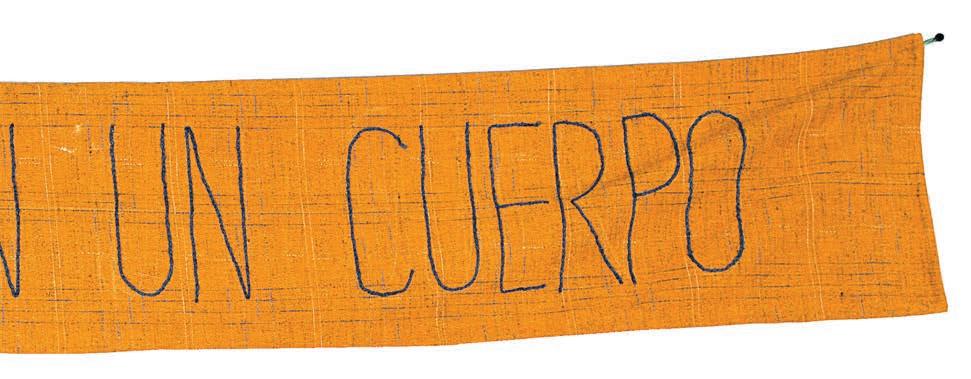
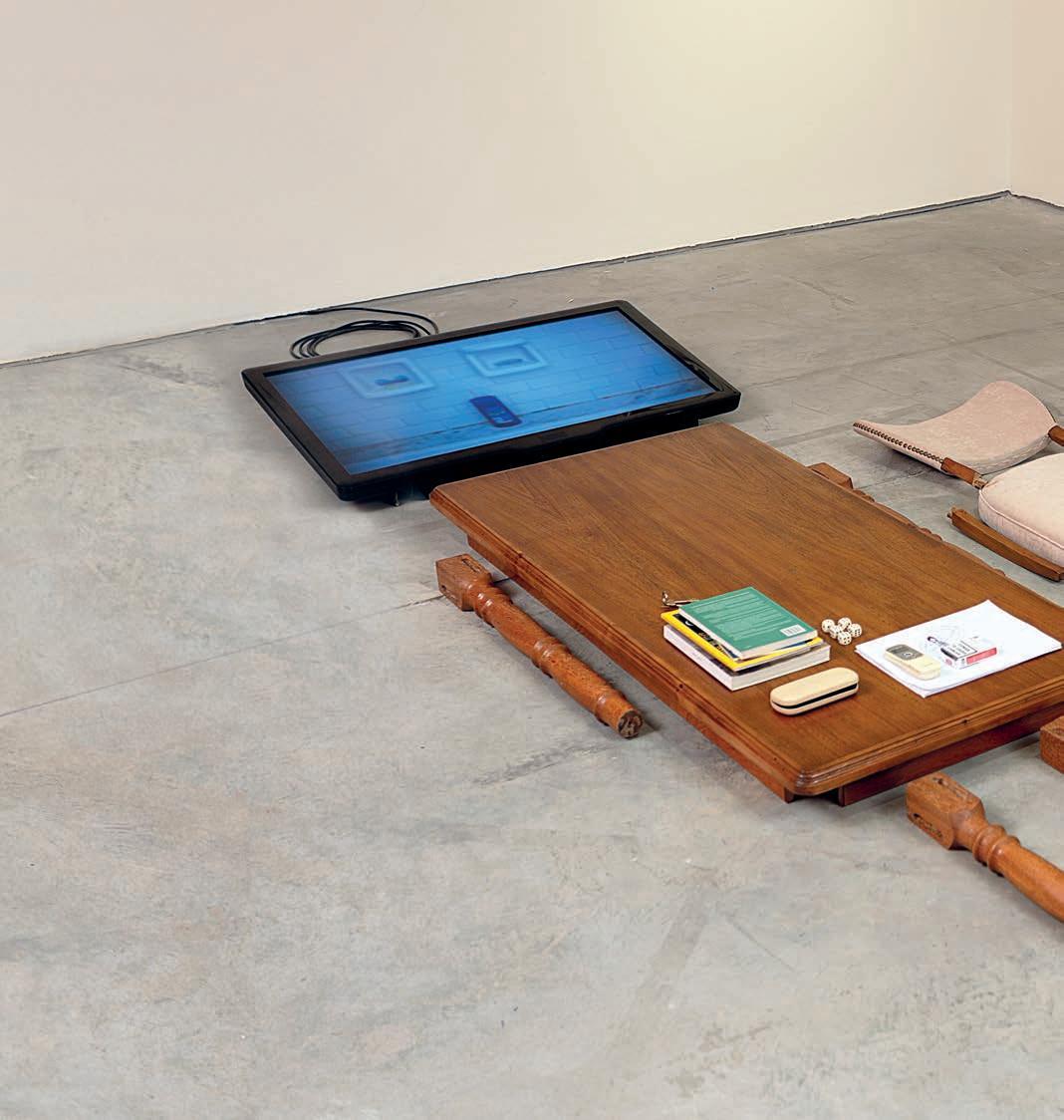
Hecha para siempre [Made For Ever], 2021
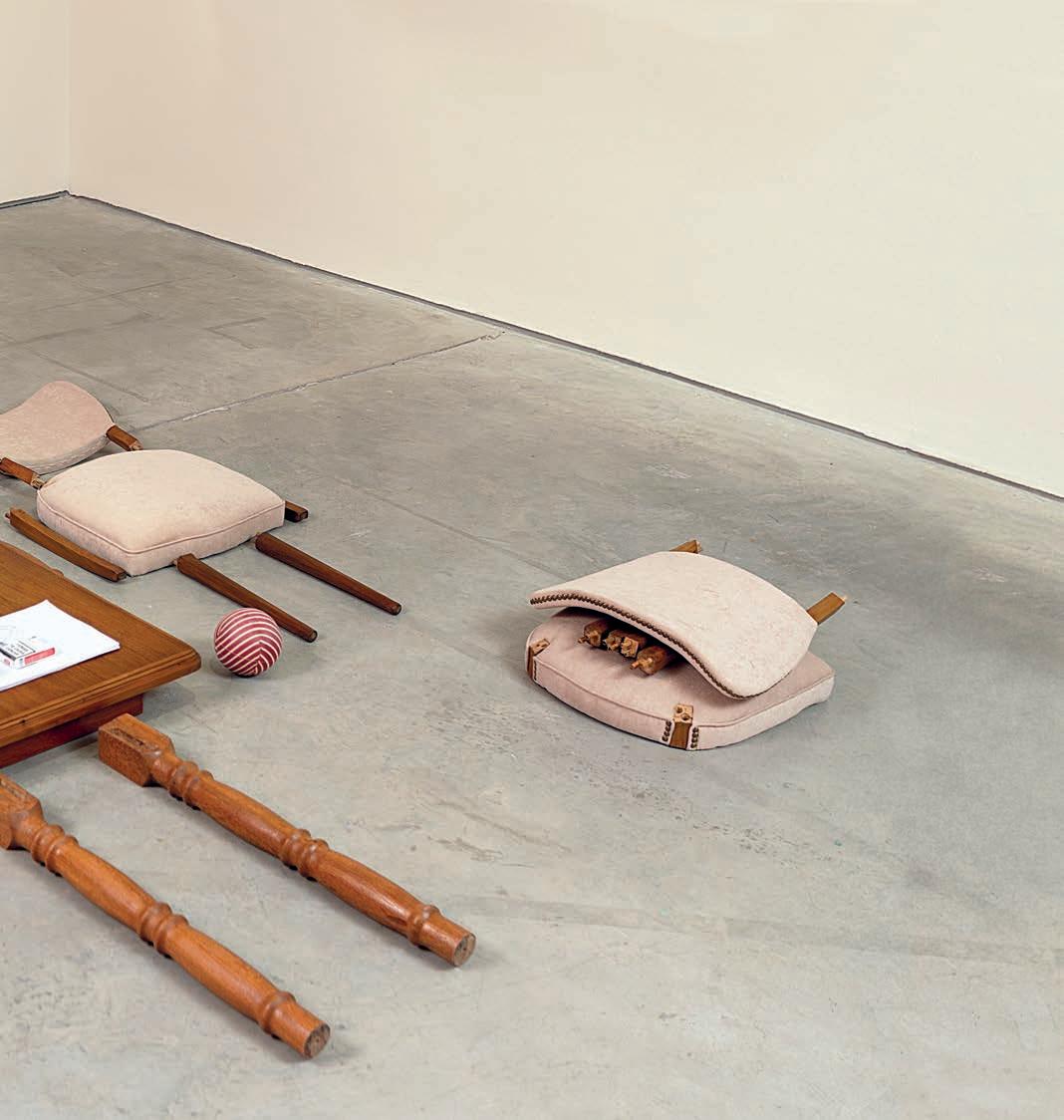
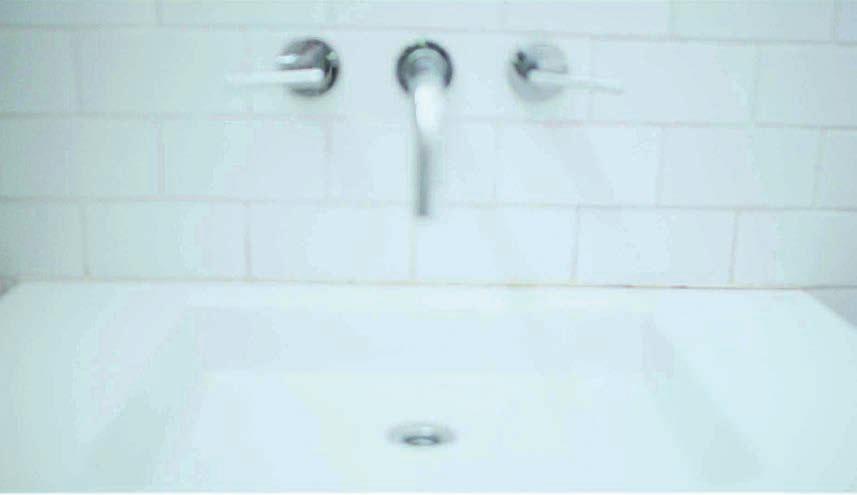
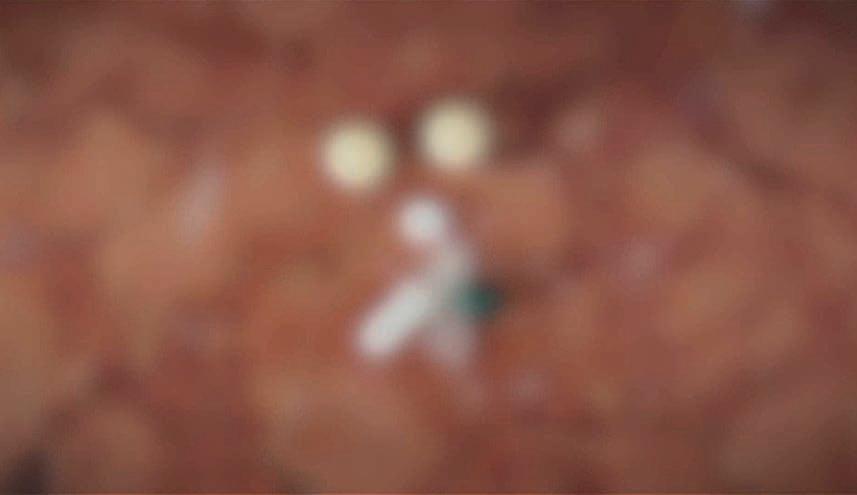
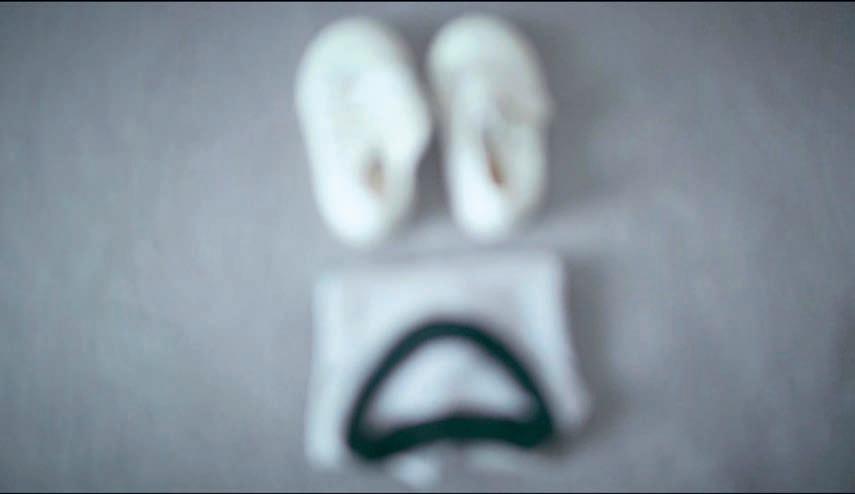
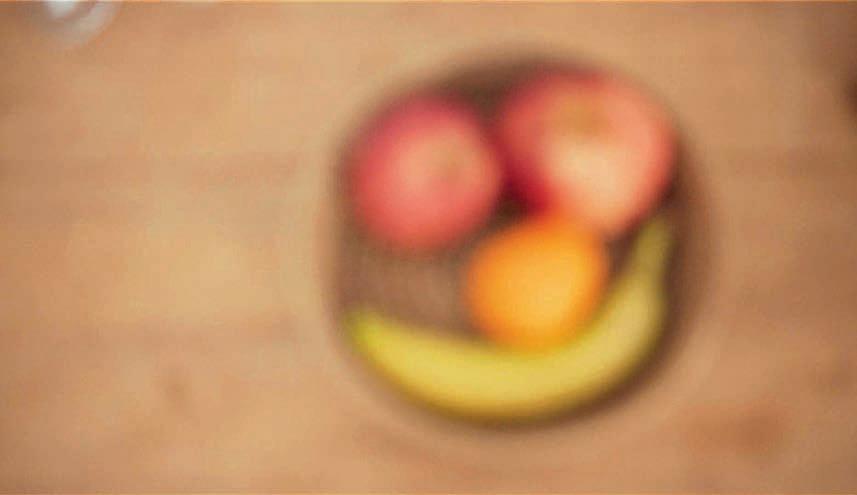
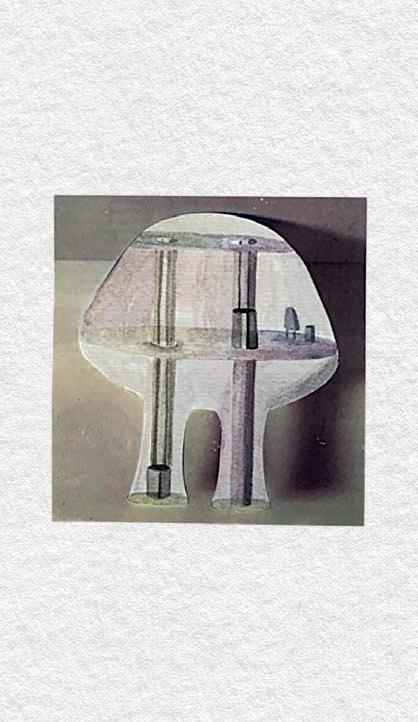
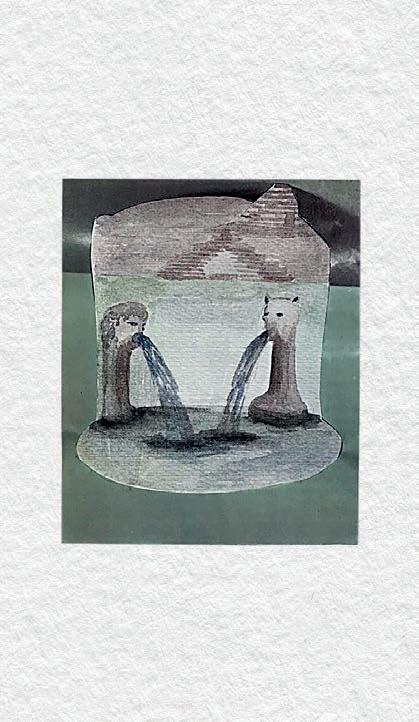
Cuatro obras Sin título, de la serie “Ucronías de habitaciones totémicas” [four Untitled works, from the ‘Uchronias of Totemic Rooms’ series], 2019
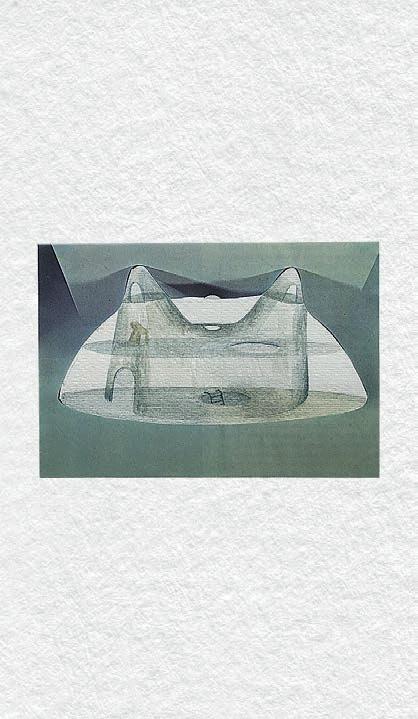
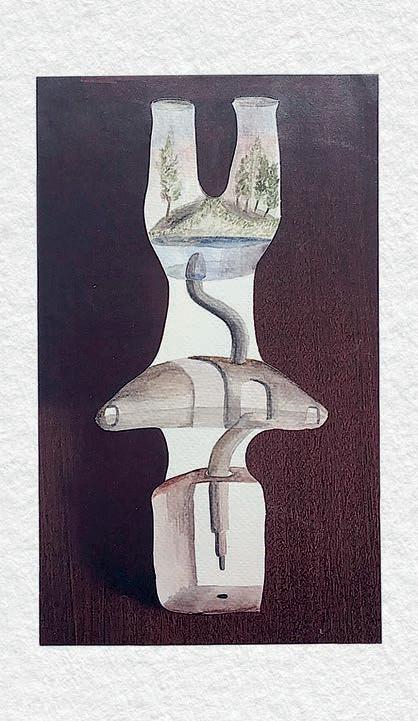
Una obra Sin título de la serie
[One Untitled work from the ‘Uchronias of Totemic Rooms’ series]
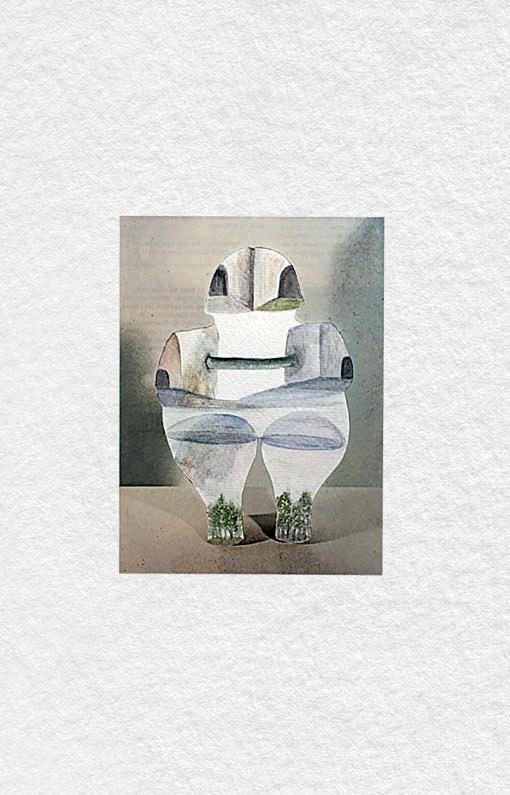

Izquierda [Left]:
Una quescucha para escuchar [A Listeningear to Listen], 2020 Pintura para ojos cerrados [A Painting for Closed Eyes], 2021
Una pinturasanta (para toda plegaria) [A Holypainting (for Every Prayer)], 2020
Derecha [Right]: Mirar directo al sol con los ojos cerrados [Looking Straight at the Sun with Eyes Closed], 2020 Las personas no somos símbolos. Una pintura alianza [We People Aren’t Symbols: An Engagement Painting], 2020

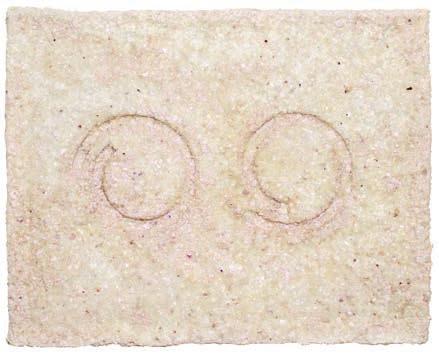
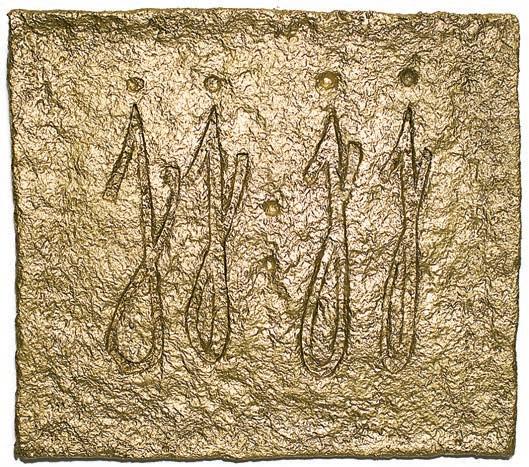
Izquierda [Left]: Virtuoso, 2020 Casio, 2020
Derecha [Right]: Sin título [Untitled], 2019 Asleep, 2020
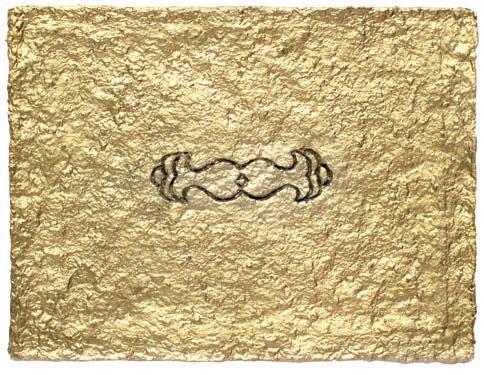

Practicar arte es una forma de interrumpir la vida de manera cabal. Cortar ese ritmo y sacralizar un momento. Nos permite destinarnos a la inutilidad, a procesos absurdos de pura fe. Nos conecta con un pulso personal y nos empodera en tanto materializamos algo que ronronea en la cabeza. Es, para mí, una manera de sostenernos en la imaginación y de hacer de ello una forma de vida, sin tampoco llevarlo a un lugar idealizado o romántico: no deja de ser un oficio como el de un plomero o un carpintero. La ventaja es que nadie espera lo que hacemos, nadie lo necesita, y tiene esa contundencia de aparecer de la nada.
ANTONIO VILLA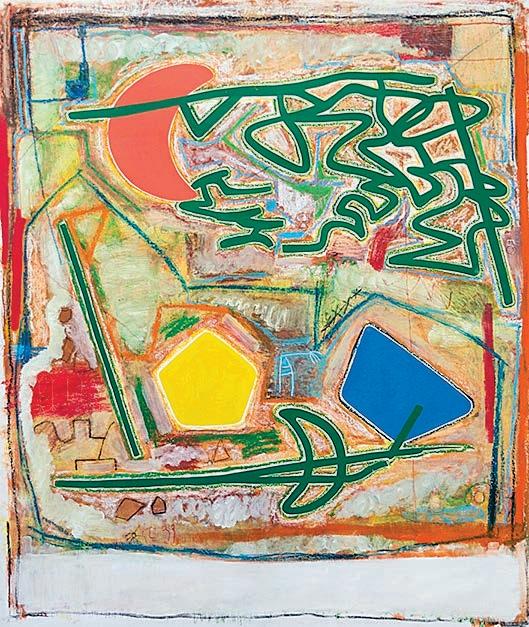
Cuadrado [Square], 2019
Sin título [Untitled], 2019
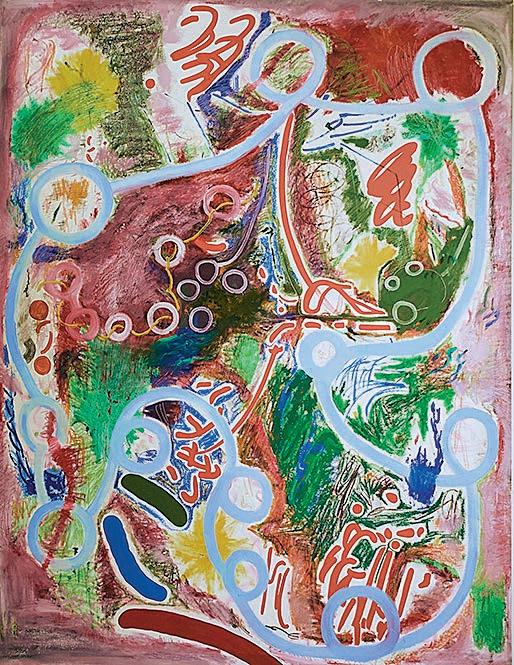
El baile [The Dance], 2019
Sin título [Untitled], 2021
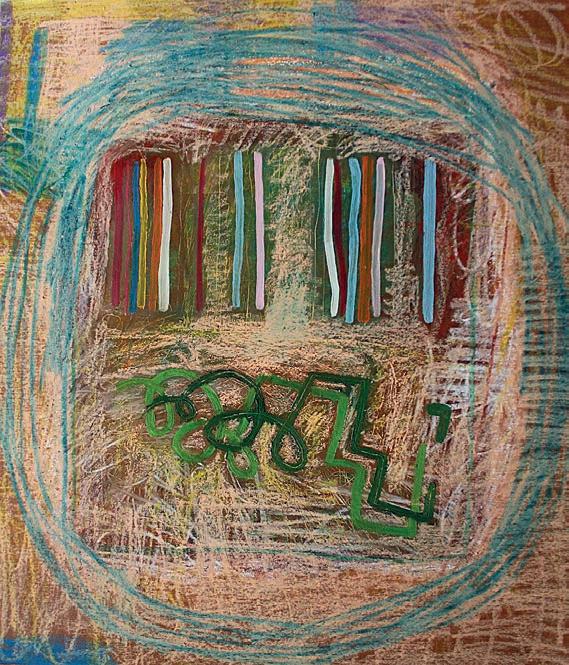
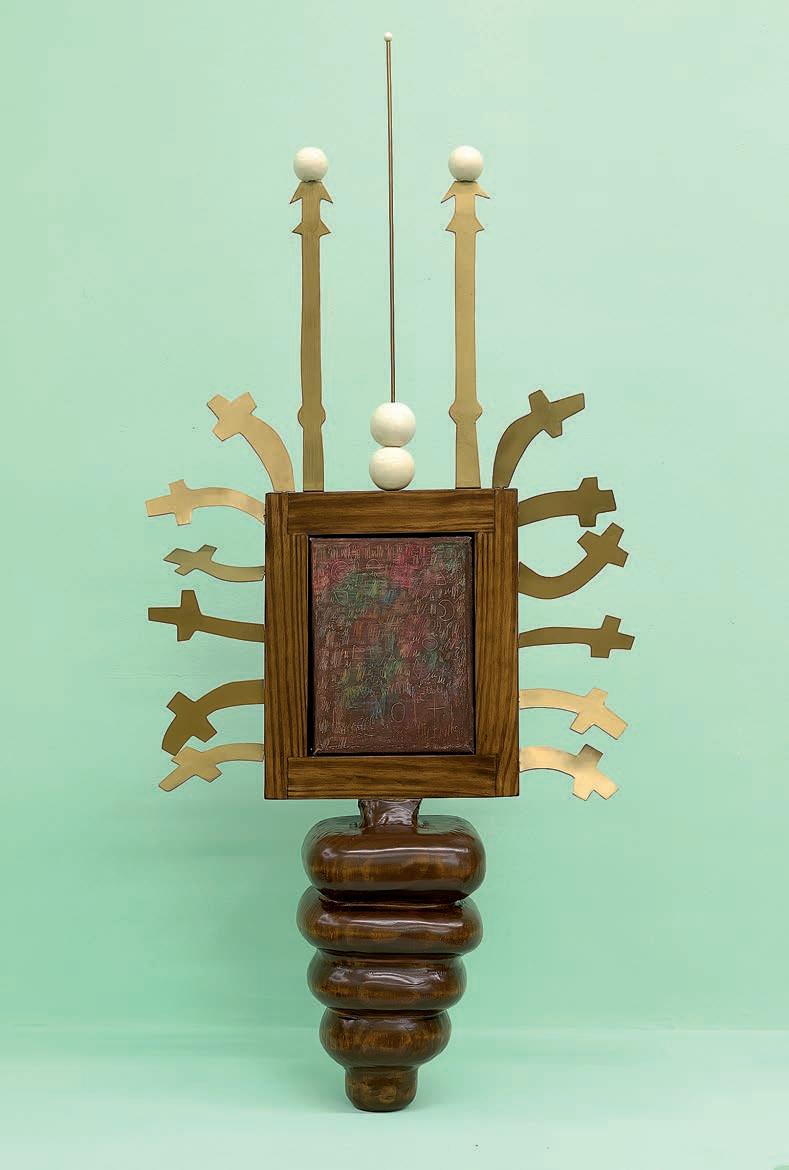
Sin título [Untitled], 2021
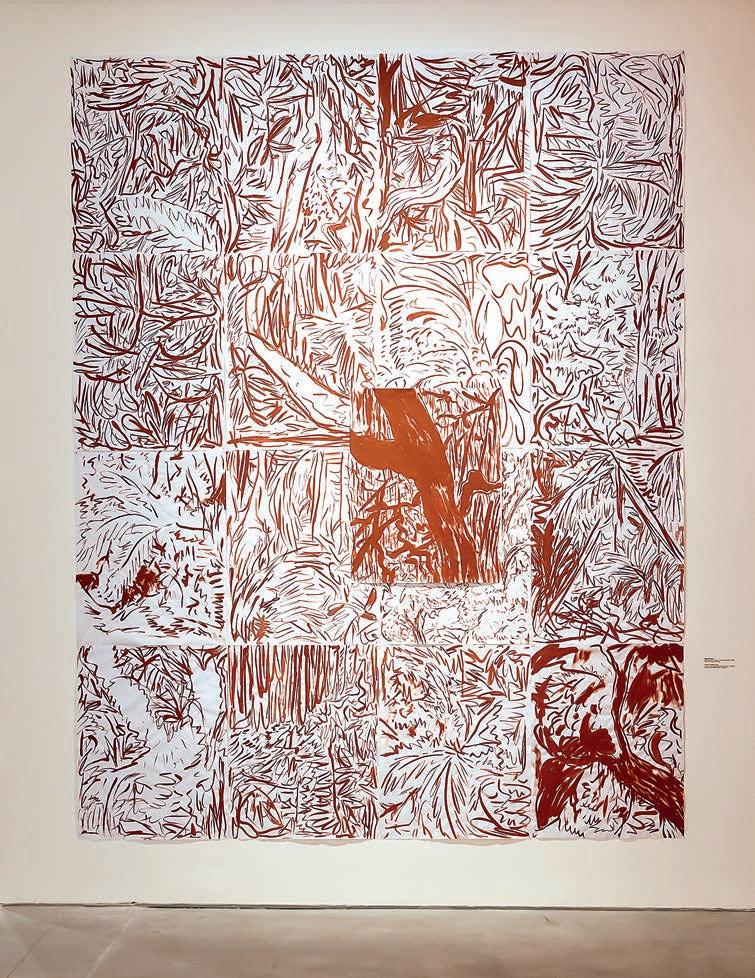
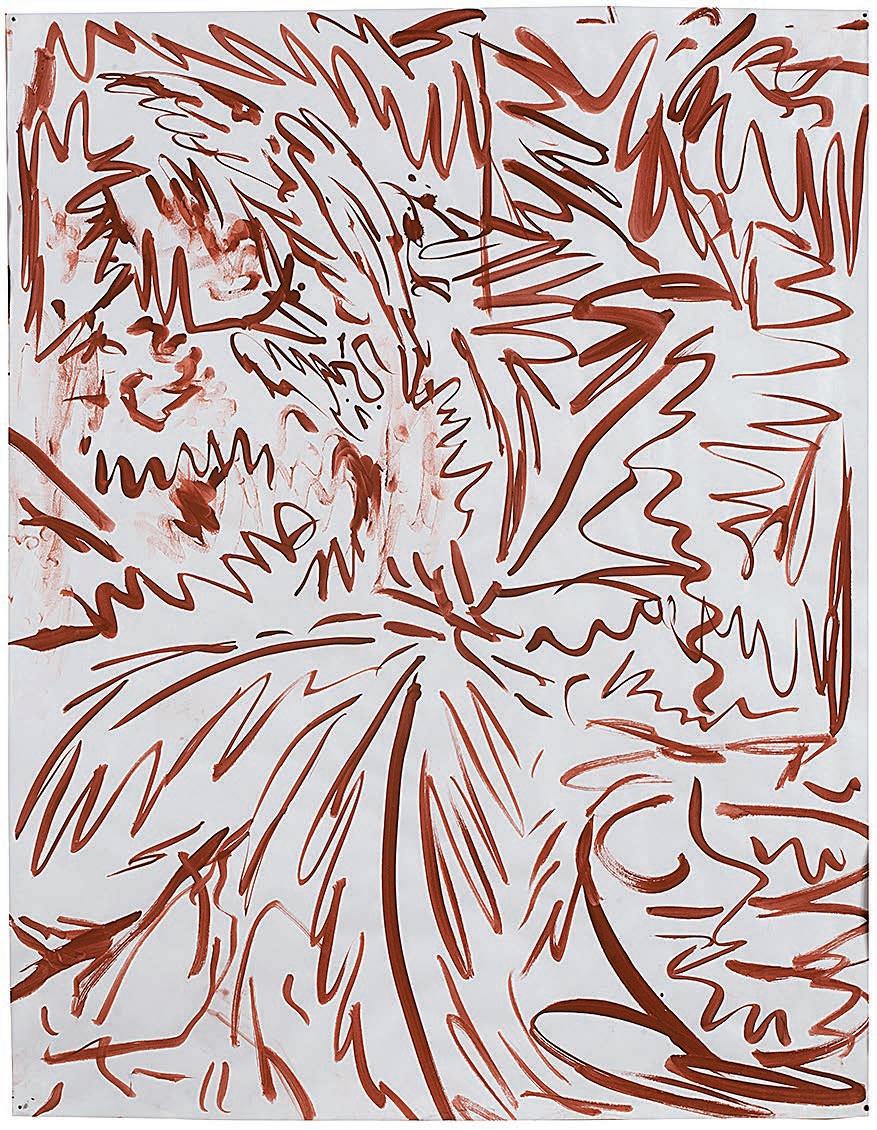

Fiesta de la luna [Feast of the Moon], 2021
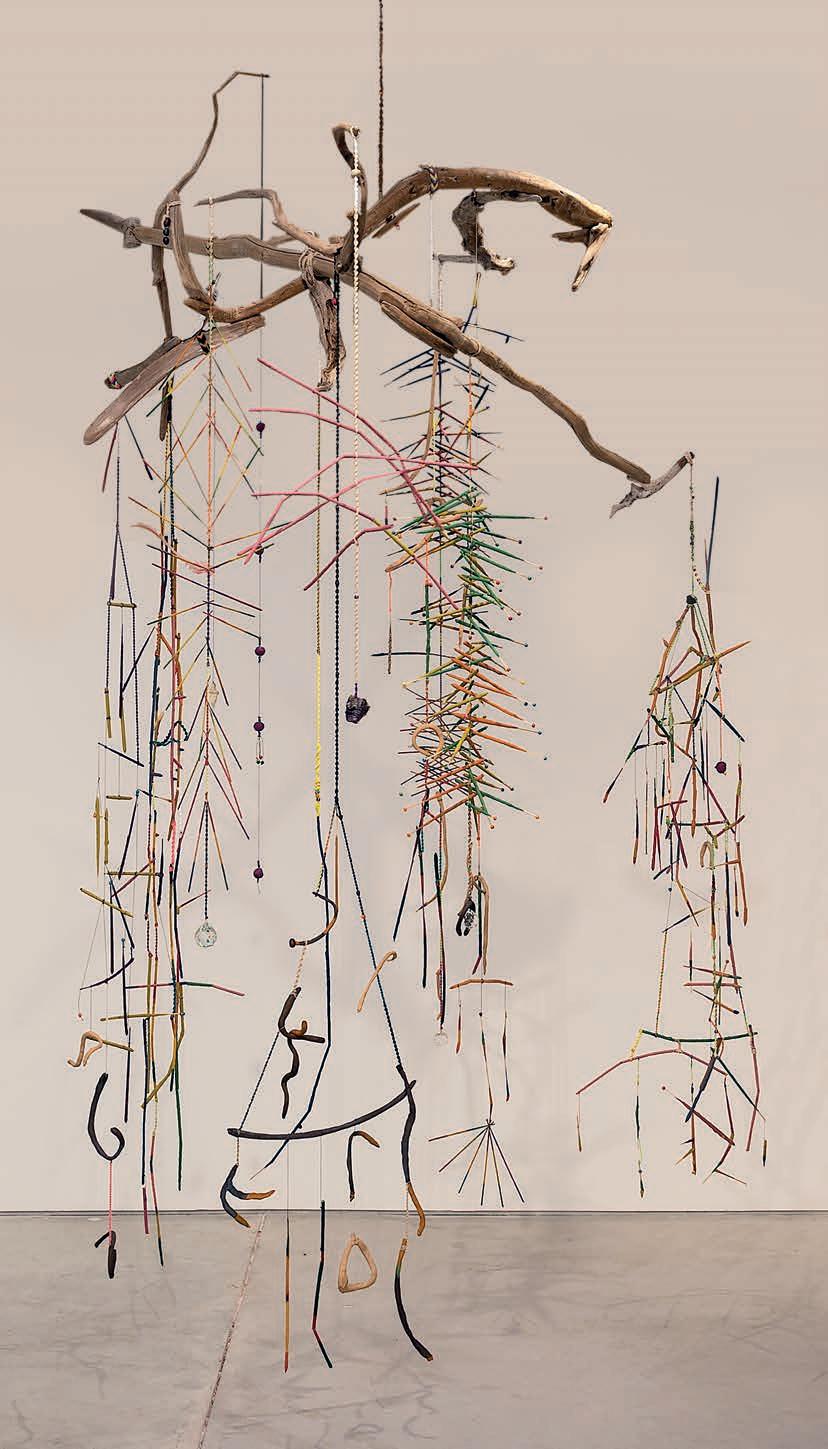
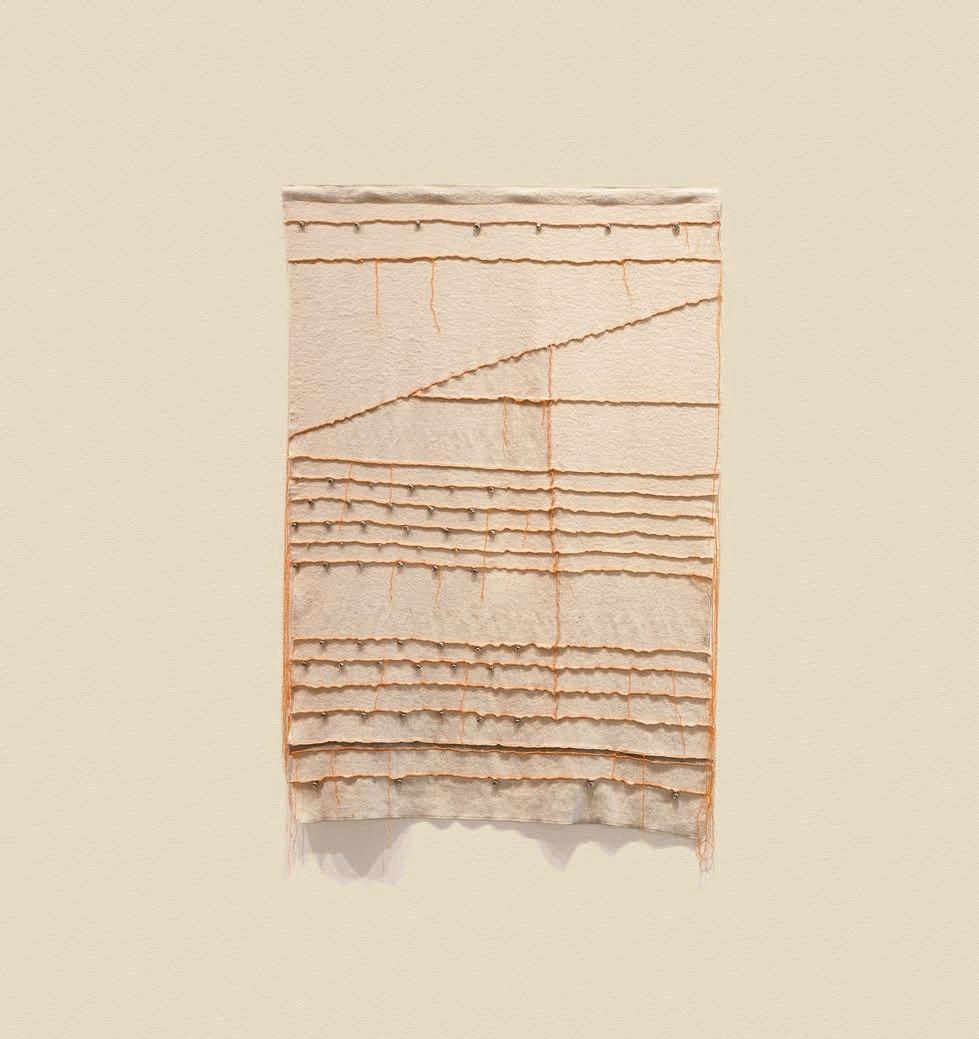
Trapo sonajero (escuchá, escuchá) [Rattle Rag (Listen, Listen)], 2021
Trapo sonajero (caudal lento) [Rattle Rag (Slow Flow)], 2021
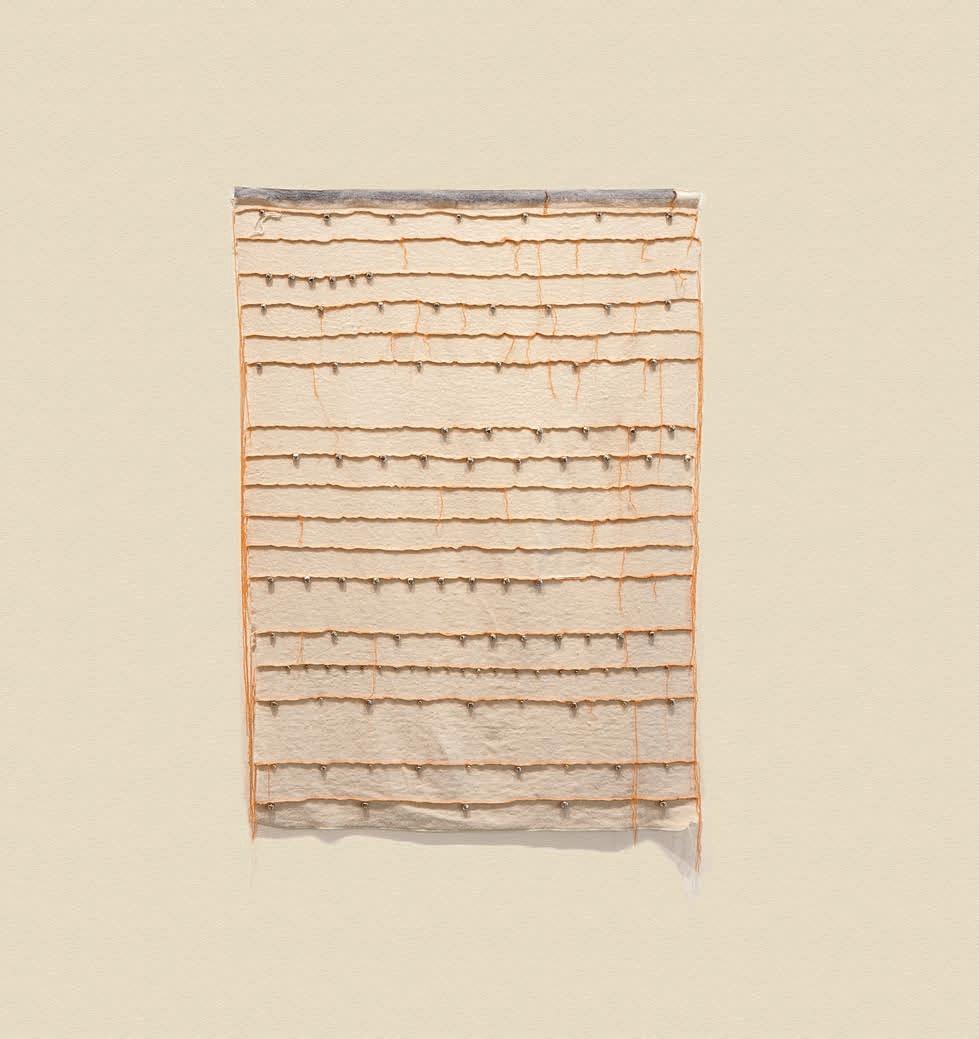
El beneno de la belleza [The Benom of Beauty], 2019
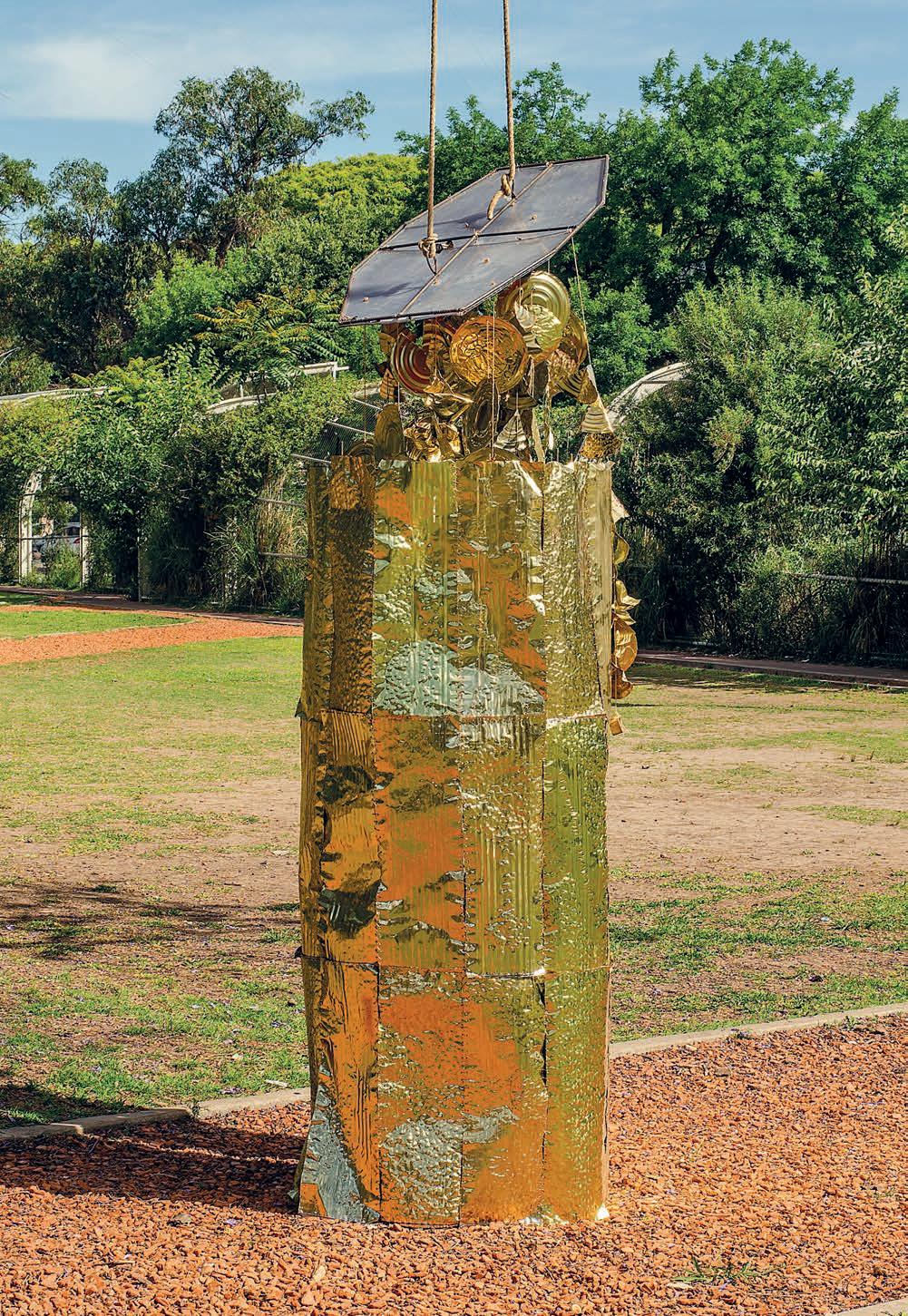
Aunque lo intente y no lo logre, más que en ‘hacer obra’ estoy interesada en inventar prácticas sensibles que funcionen como experimentación y estén orientadas a desarmar mis propias convenciones, en pensar desde el territorio y con el cuerpo las relaciones con lo existente y con lxs otrxs. Entiendo la obra de arte como el efecto residual de una experiencia. A la vez, todo lo hago como artista, en disolución, en fuga.
SOLEDAD DAHBAR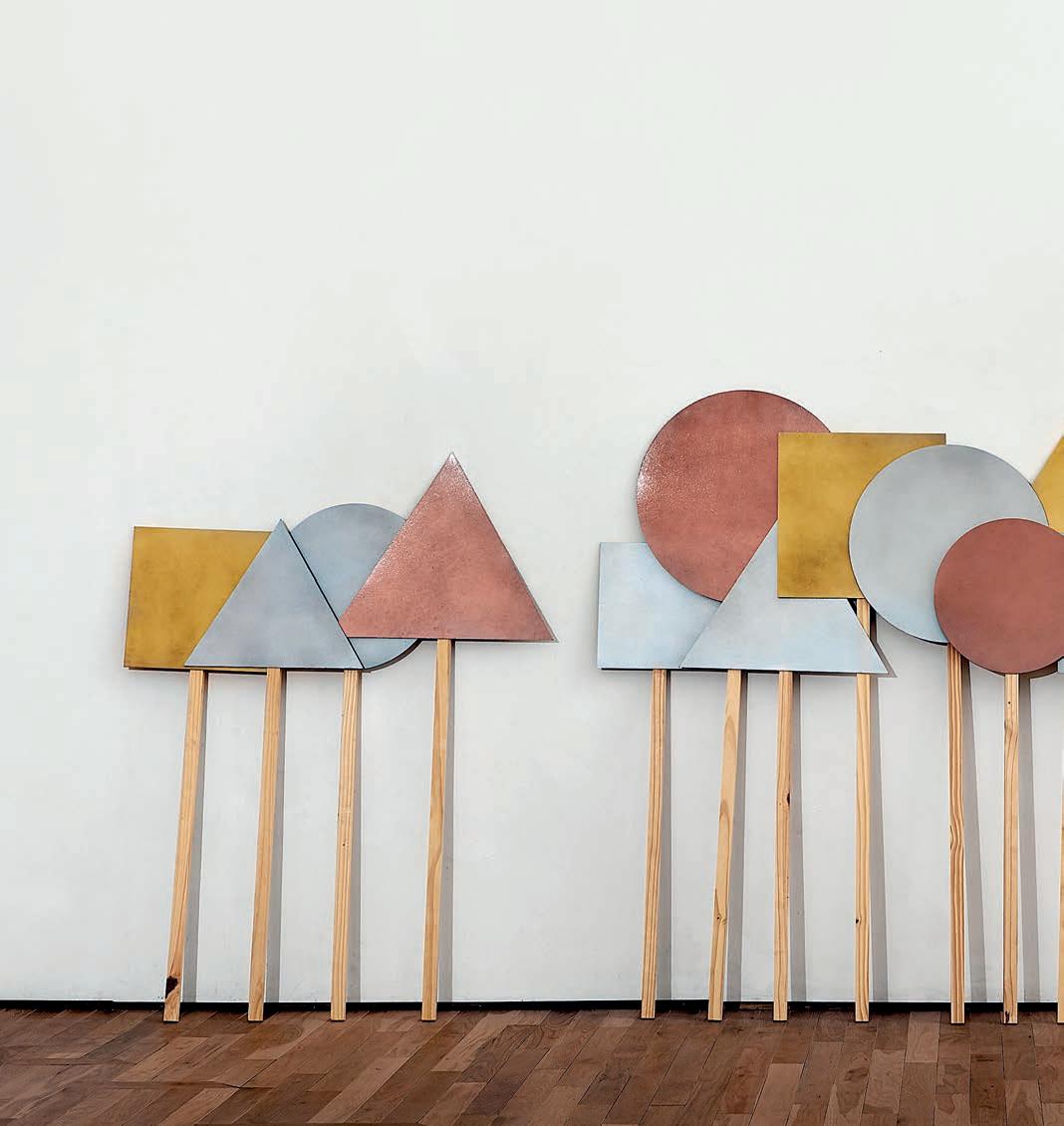
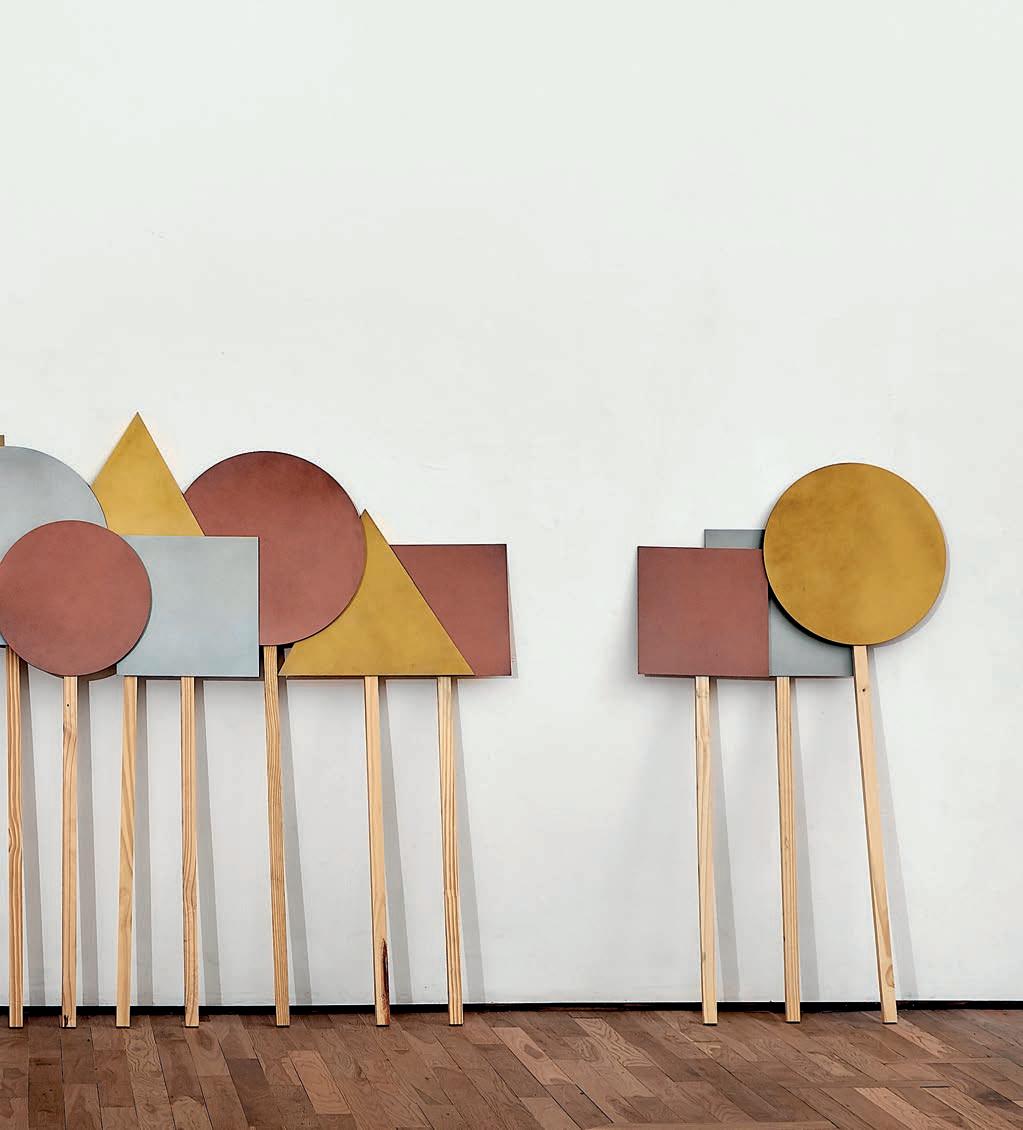


La misma obra realizada en Cafayate, Salta [The same artwork assembled in Cafayate, Salta], 2020 Derecha [Right]:

Sin título [Untitled], 2020–2021
Quema en Corralito [Burning in Corralito], 2020–2021


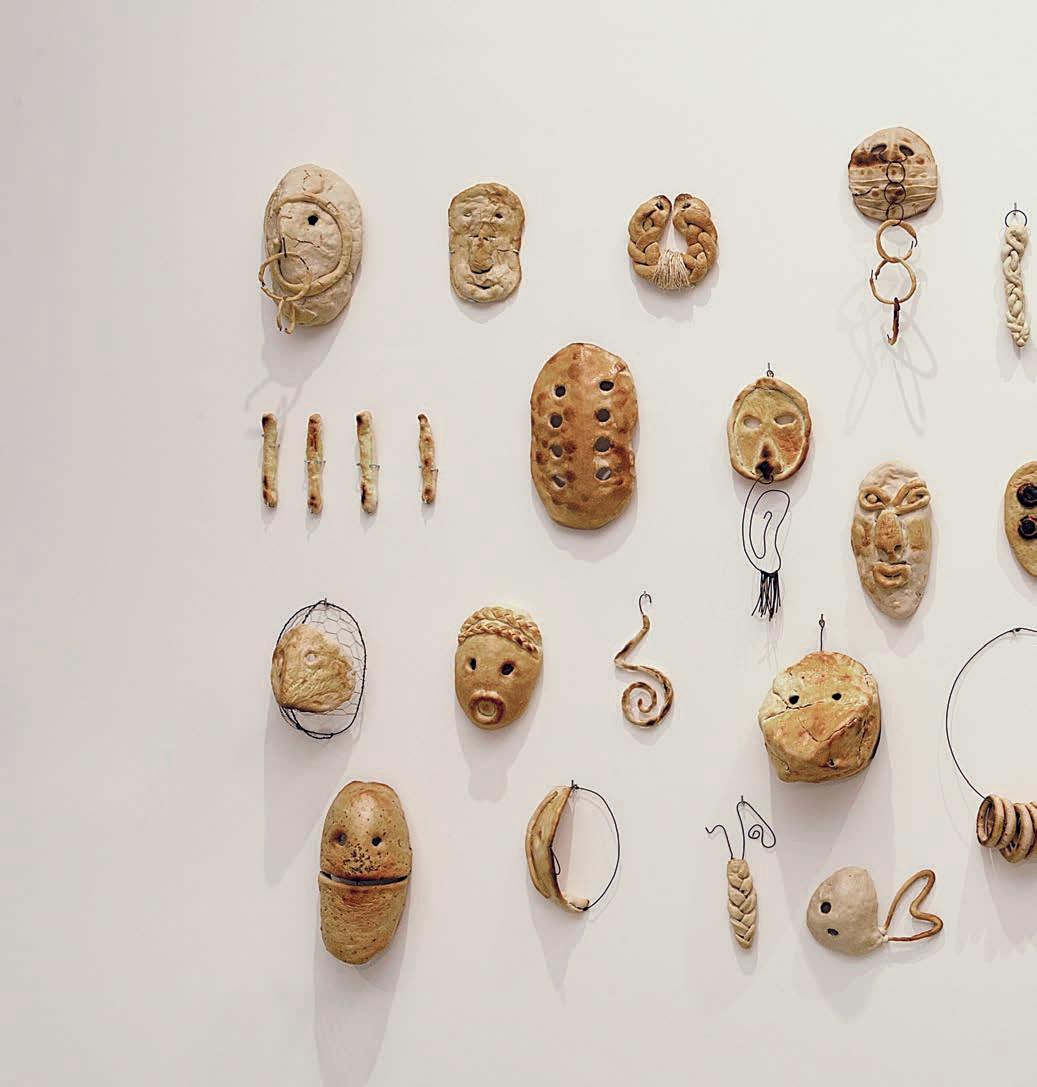
Sin título [Untitled], 2021 p. 148-149: Detalles [Details]

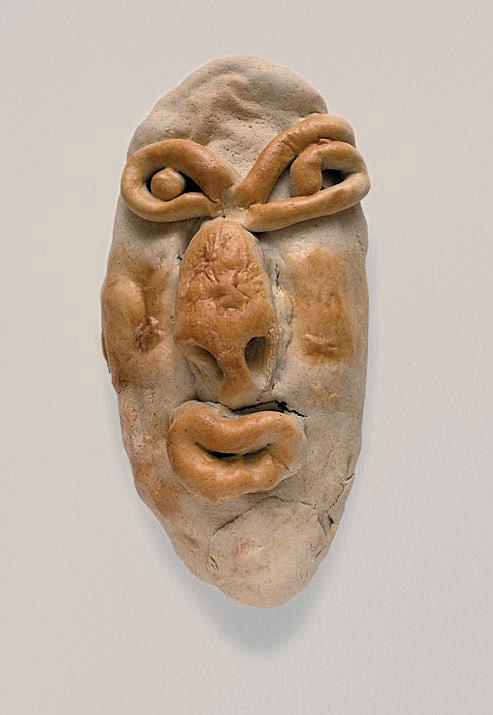
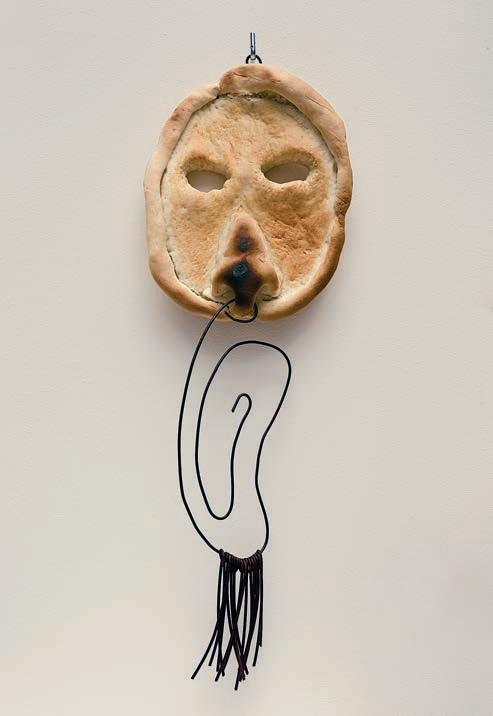
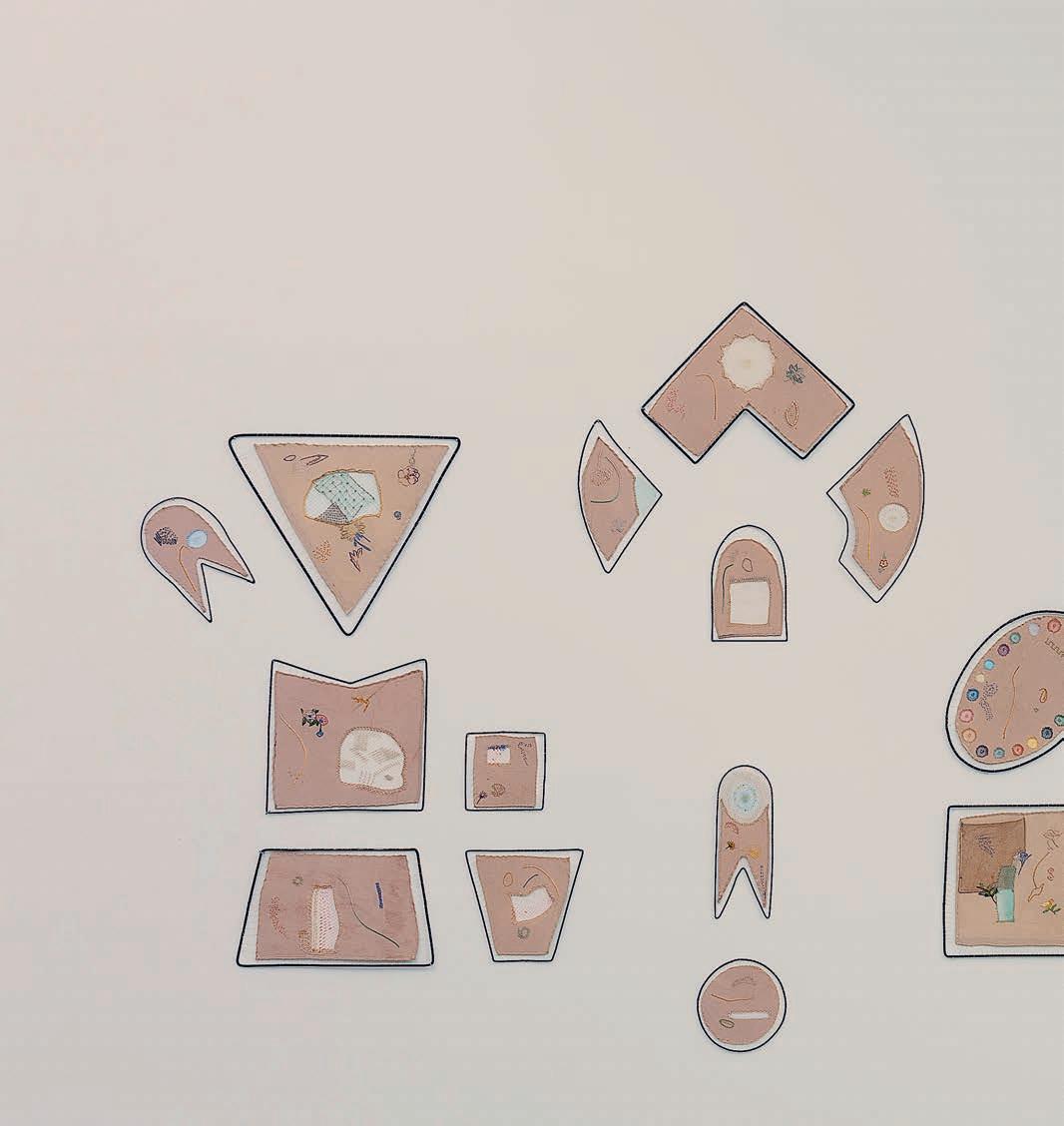
Fantasía aplicada [Applied Fantasy], 2021
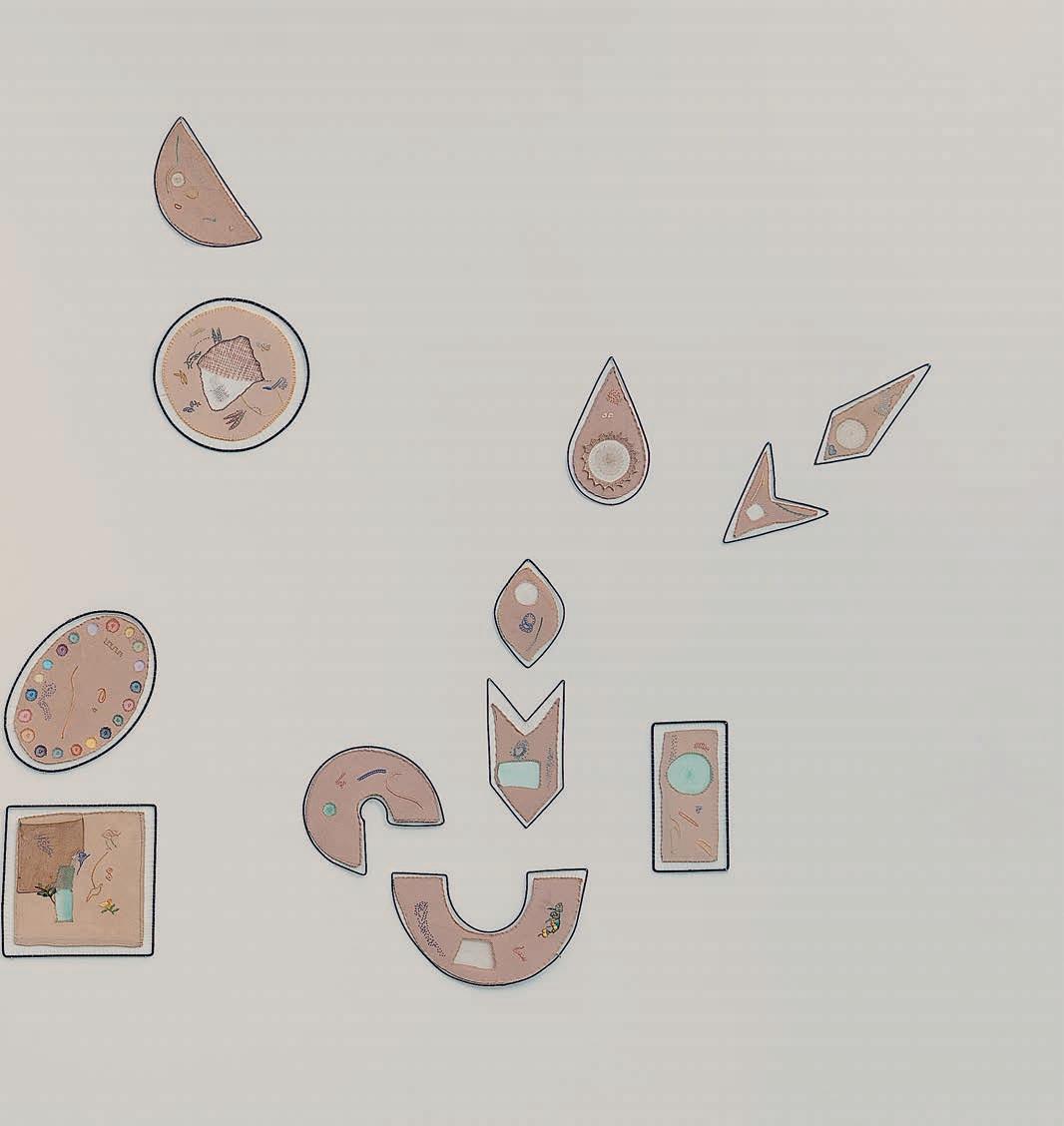
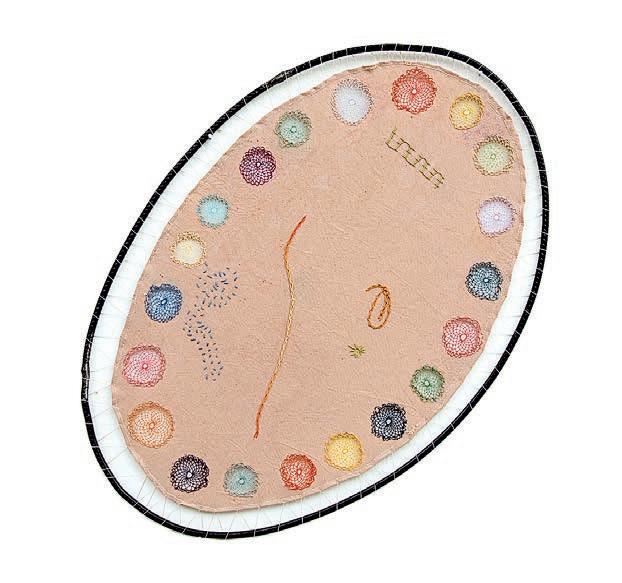
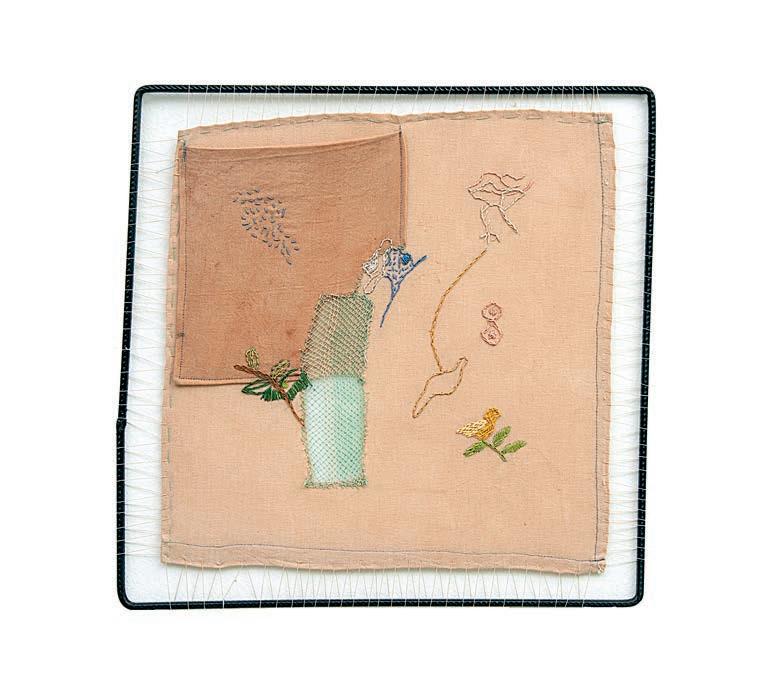
La función de producir obra es la manera que encontré de poder interactuar con el mundo concreto, palpable, perceptible. Lograr que el pensamiento mental —el lenguaje verbal— se atenúe por un rato mientras algo inmaterial de mí se comunica con lo tangible. Es un vínculo que me permite conectar lo tangible con lo intangible.
MARÍA GUERRIERIHabitar es, entre otras cosas, aprehender el lenguaje de la arquitectura. Incorporar su taxonomía. Asimilar los protocolos de un espacio y comportarse conforme a sus preceptos. Es una negociación entre el cuerpo y el espacio prediseñado. Un diálogo entre el organismo y las convenciones. Entre el cuerpo presente y la historia. Una buena parte de mi trabajo en estos últimos años tuvo que ver con “contra-habitar”. Leer los protocolos de las infraestructuras, que son los cimientos de la performance de vivir, y usarlos como material.
JUAN GUGGERSelección de obras Sin título, de la serie “Todo lugar es el centro del mundo” [Untitled, selected artworks from the series ‘Every Place is the Centre of the World’], 2021

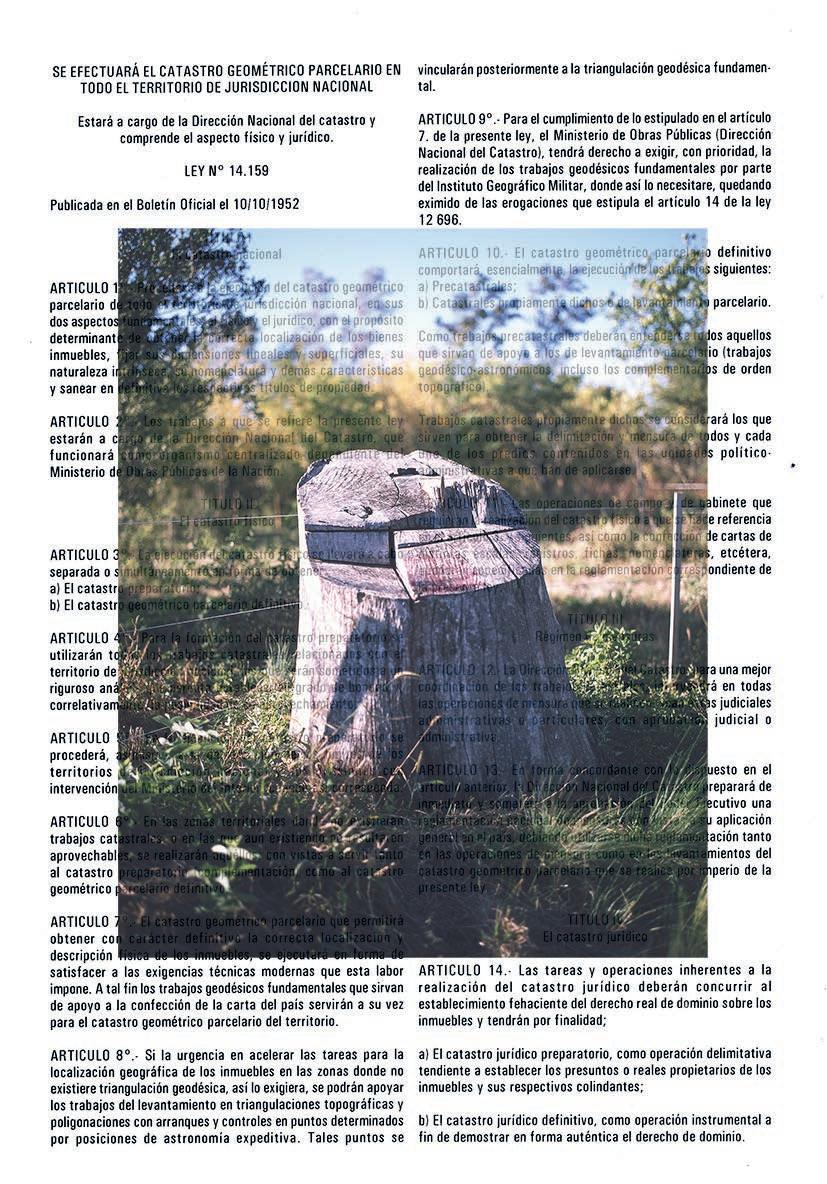
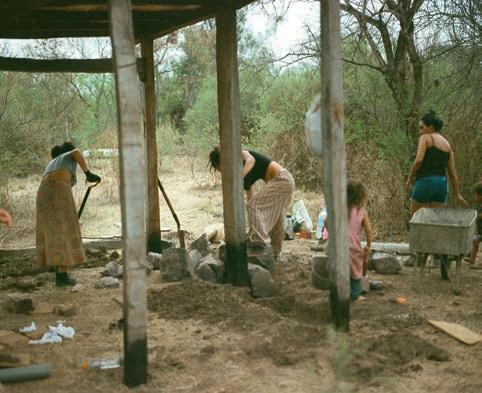
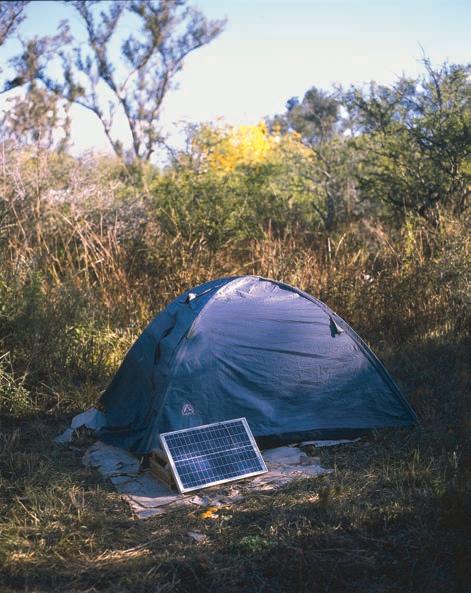
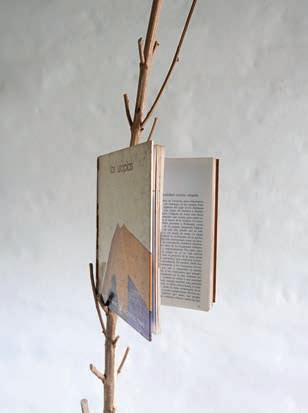
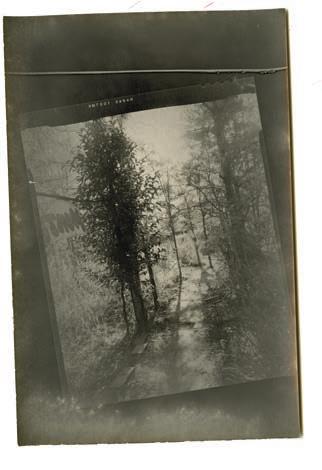
San Miguel de Tucumán, Tucumán, 1985 - vive en la Ciudad de Buenos Aires
Licenciada en Artes Plásticas por la Universidad Nacional del Tucumán, continuó sus estudios en el Programa de Artistas, a través de la Beca YPF (2010) y en el Laboratorio de Cine de la Universidad Torcuato Di Tella (2012). Obtuvo las becas Residencia cheLA (2019), BEC.AR Residencia en EAC, de Uruguay (2019), FNA Creación (2018), Residencia El Ranchito/ Matadero, de Madrid (2017), Centro Cultural de la Memoria Haroldo Conti (2016) y Alec Oxenford, en París (2014). Fue distinguida con el Premio Estímulo Salón de Mayo, Museo Rosa Galisteo (Santa Fe, 2019) y el Primer premio MUNT (Tucumán, 2018). Ha expuesto en diferentes ciudades de la Argentina, además de en Montevideo, San Pablo, París y Madrid, entre otras. Su obra forma parte de colecciones públicas y privadas, como la del Museo Nacional Centro de Arte Reina Sofía, en Madrid, y la de Le 19, CRACCentre Régional d’Art Contemporain de Montbéliard.
En su obra Calendario abstracto, Lucrecia Lionti se apropia del ritmo del tiempo prolongado de la pandemia mediante un sistema personal de marcas. Olvidada la referencia convencional de los meses y los días vacíos de actividad, en las grillas del calendario se suceden líneas verticales y diagonales sin variación que la artista cosió con dedicación amorosa. Con un pie en la tradición del arte minimalista y conceptual, el orden y la repetición de datos así como las formas puras y modulares cobran una dimensión fenomenológica y existencial. Lionti sensibiliza esa producción con la incorporación de la costura, un lenguaje constructivo aprendido en el ámbito familiar femenino, que depende de la fuerza y del ejercicio paciente del cuerpo. Así, incorpora el ritmo vital como medida natural del trabajo. Con la misma estrategia construye otra serie de obras en las que toma formas reconocibles del arte abstracto moderno. Se trata de homenajes a artistas como Joseph Albers o Lucio Fontana, que combinan el amor de Lionti por la tradición pictórica con su necesidad de que el proceso de construcción de las piezas siga los tiempos de confección y las técnicas para hacer aparecer imágenes aprendidas fuera de las instituciones artísticas, pero que le resultan propias.
pp. 42 — 43
pp. 46 — 49
Ciudad de Buenos Aires, 1993 - donde vive
Realizó sus estudios en la Beca Proyectarte, dirigida por Eva Grinstein (2011) en el Programa de Artistas de la Universidad Torcuato Di Tella (2017) y en la clínica de obra con Aníbal Buede (2016). Presentó su primera muestra individual, Mi primer trabajo, mi primera muestra, en la galería Isla Flotante, Buenos Aires (2011), donde también realizó la muestra Klapaucius:;::;:; (2014), curada por 141 personas. En 2016 llevó a cabo la exposición Equilibrio inestable junto a su padre, el artista Martín Kovensky; en 2018, Realidad disminuida y, en 2020, Ojo de cabra, ambas en la galería El Gran Vidrio (Córdoba). En 2017 obtuvo una beca del Fondo Nacional de las Artes para filmar el documental Que aparezca Maresca, con la ayuda de Mic Ritacco.
Pulmón de manzana, 2020
En el trabajo de Nina Kovensky, la tecnología opera como un dispositivo mágico capaz de proyectar nuestra sensibilidad y humanidad, y de promover un vínculo libre de filtros e imposturas con los otros. Lo logra a través de la creación de funcionalidades nuevas para los dispositivos de comunicación. La apariencia abstracta de Pulmón de manzana, compuesta por una colección de espejos rectangulares, reelabora la vista nocturna desde la ventana de cualquier edificio de una ciudad. Espacios íntimos, cercanos y lejanos al mismo tiempo, reunidos en un mapa de señales mediante una “coordinación de luces” que, según la artista, la “hace pensar en una sincronía en común entre cada ventana/pantalla del presente”. Cada espejo, como una cápsula de intimidad, contiene una serie de dibujos tallados de imágenes nimias y sintéticas que van desde un organismo celular a una fruta o una constelación de estrellas. Estos dibujos configuran un imaginario sobre las realidades paralelas de la intimidad, donde confluyen múltiples tiempos y espacios. Junto a estos dibujos, las fotografías agrupadas bajo el título “Selfins”, forman parte de una serie en constante crecimiento, que reúne retratos del círculo afectivo de la artista. Los rostros se proyectan y se transforman como una señal de luz al ser reflejados en pequeños espejos redondos que cada persona sostiene con sus propias manos, como si intentase resguardar su identidad.
Bahía Blanca, Buenos Aires, 1993 - vive en la Ciudad de Buenos Aires
Licenciada en Artes Audiovisuales en la Universidad Nacional de las Artes, es cofundadora del colectivo CORAL y la galería La Baranda. En 2018 fue seleccionada en el programa de artistas del Centro de Investigaciones Artísticas, a cargo de Roberto Jacoby. Ha expuesto sus piezas de video en diferentes festivales de la Argentina, España, México, el Uruguay, los Estados Unidos y Canadá. En 2019 recibió el Primer Premio en el Festival Patio de Salvataje, en el Centro Cultural Recoleta, y, en 2021, la segunda mención de honor en la convocatoria Nuevas Normalidades, de Bunge y Born. En sus proyectos colectivos recibió el premio Mejor Corto Documental en Fiver Dance, España, y Segundo Premio en el LAB Festival Internacional de Videodanza con el cortometraje Territorios
En la obra de Florencia Vallejos, la tecnología de uso personal —que se ha convertido en un espacio de archivo íntimo— cobra vida propia y manifiesta su dimensión sensible. Mis documentos muestra el escritorio de una computadora en la que se abren carpetas de archivos de manera automática, descubriendo sutilmente la presencia de una subjetividad. Realizado por la artista durante las noches como una forma de calmar la ansiedad del día, el video combina palabras que proponen un diálogo sobre la imagen cenital de un desierto que cubre el fondo. A estos elementos se suma el movimiento hipnótico de una forma orgánica, a la vez blanda y mecánica, que se combina con una melodía adormecedora. La obra exhibe así la tensión entre un paisaje que ofrece una pausa a los estímulos desenfrenados de las pantallas y la aparición automática de una secuencia de signos y formas que, a su vez, deja la duda inquietante sobre si es la acción humana o la de la máquina la que controla las imágenes y los archivos digitales.
pp. 50 — 51
Cochabamba (Bolivia), 1978 - vive en la Ciudad de Buenos Aires
Ciudad de Buenos Aires, 1994 - donde vive
La colaboración entre los artistas Lucía Reissig y Bernardo Zabalaga comenzó en 2018, cuando ambos desarrollaron un servicio integral que combinaba la limpieza doméstica con la energética a partir de sus prácticas individuales (Lucía limpiaba casas y Bernardo las sahumaba), basadas en métodos desarrollados a lo largo de sus trayectorias como artistas y de una investigación sobre prácticas ceremoniales típicas de diversas culturas.
Lucía Reissig estudió Arte en la Universidad de las Artes y, en 2017, formó parte del Programa de Artistas de la Universidad Torcuato Di Tella (UTDT). En 2018 ganó el Premio Beca Joven del Premio Artes Visuales Kenneth Kemble. Participó en exposiciones individuales, como Fight or Fly, Ray Gallery, Brooklyn (2016), y El trabajo invisible, en Selvanegra Galería (2018), y colectivas, como en Extraña posesión, lugar a dudas, Colombia (2018), Negra, en Munar Arte (2019) y Bombastik, en Nora Fisch Galería (2021). Bernardo Zabalaga es Licenciado en Comunicación Social de la UCB/Bolivia y en Actuación de la Escuela Superior de Teatro e Cinema, Lisboa. Realizó el Master en Práctica de Teatro Avanzada, Central School of Speech and Drama, Londres. En 2017 realizó el Programa de Artistas de la UTDT. Participó de la residencia URRA en 2014, en Buenos Aires, y de Kiosko, en Santa Cruz de la Sierra, Bolivia. Su primera exposición individual fue en la galería Manzana Uno, en 2016.
Interesados en comprender cómo cuidar lo invisible —aquello que genera territorios afectivos específicos y afecta nuestra forma de habitar el espacio—, Lucía Reissig y Bernardo Zabalaga realizaron una intervención para colaborar con el bienestar de las obras, en comunión con la sala y los artistas. La obra consistió en la práctica de una serie de rituales realizados antes de la apertura de la exposición que, según Reissig y Zabalaga, “interpelan el cuerpo colectivo y nos conectan con la territorialidad de la sala que habitamos con nuestro trabajo”. Uno de los elementos utilizados fue un talismán que permaneció en el interior de la sala para protegerla.
Sauce, Corrientes, 1976 – donde vive
Licenciado en Publicidad y Comunicaciones Estratégicas, Diseñador Gráfico y Publicitario. En 2013 comenzó a hacer intervenciones artísticas en escenarios no convencionales, tanto en espacios públicos como privados. En ellas abordó la espiritualidad, la religiosidad, la diversidad de la fe, la acción ritual del sincretismo religioso y sus manifestaciones en la práctica artística. Trabajó como asistente de Santiago Bengolea para el proyecto Red Galería, entre otras actividades. Ha participado en muestras individuales y colectivas en el ámbito regional y nacional. Actualmente trabaja en gestión cultural como coordinador del espacio El Quiosquito, en la ciudad de Resistencia, Chaco.
Los “Altares portables” de Blas Aparecido son prendas que llevan bordadas imágenes devocionales que provienen de lo que el artista llama un “frenesí de credos”. Figuras sagradas y paganas que convocan la presencia de la Virgen de Itatí, el Gauchito Gil o Gilda conviven con un sinnúmero de otros símbolos y adornos creando una suerte de escudos con los que protegerse de las miserias y expresar la fe. Lentejuelas, bordados, perlas de fantasía, canutillos o dijes se combinan con objetos personales o encontrados y se exhiben junto a fragmentos de oraciones, poemas o pensamientos. Estos materiales y referencias, en su diversidad, son cosidos a mano por Aparecido, para quien el proceso de bordado constituye también un tiempo de entrega. En la reunión de esos elementos inscribe deseos y promesas que transforman las prendas y accesorios que llevamos en “torres de energía cósmica”, construidas a partir de un credo auténtico y personal.
pp. 54 — 57
Ciudad de Buenos Aires, 1988 - donde vive
Estudió Escenografía en la Universidad Nacional de las Artes y Caracterización en el Instituto Superior de Arte del Teatro Colón, mientras asistió a talleres de realización escenográfica. Desde el 2012 participó en clínicas de análisis de obra, y en los programas Beca Fondo Nacional de las Artes – Centro Cultural de la Memoria Haroldo Conti, el Laboratorio de Cine y el Programa de Artistas de la Universidad Torcuato Di Tella. Desde 2016 asiste al taller de la artista Diana Aisenberg. Sus principales exposiciones fueron: Diana, en la galería Isla Flotante (2013), y El divismo y lo divino (Naranja Verde, 2014; Munar Arte, 2018) –ambas con formato de performance-instalación–, y la muestra La época de los perros flacos, en galería Quimera (2018). Actualmente forma parte del grupo La Baranda y, desde 2014, desarrolla RICAS Estudio, proyecto comercial y colectivo artístico junto a Clara Campagnola, dedicado a ambientaciones artísticas y realizaciones escenográficas.
pp. 58 — 61
Serie “Los mareados”, 2020-2021
Los personajes que conforman el grupo de “Los mareados” son cuerpos desarticulados, rellenos de una variedad de materiales de descarte, fundamentalmente blandos, que pueden usarse como apoyos sobre los cuales recostarse. Si bien sus rostros desesperados y sus cuerpos agotados parecen ofrecer un espejo grotesco del temor y la incertidumbre que nos causa el presente, su función es estimular un vínculo de cuidado. Así se los usó durante un largo período de 2020, durante el cual Ferrari los ofreció en adopción a distintos tutores. Como objetos de compañía, sus formas convocan “al descanso de la verticalidad y a la quietud”, según la artista. A la vez, la dinámica de adopciones a partir de la cual circulan estas obras y la construcción de un catálogo de experiencias personales que los tutores tejen en su relación con ellas las alejan de la lógica de compra y venta de objetos artísticos.
Azul, Buenos Aires, 1990 - vive en la Ciudad de Buenos Aires
Artista y curador. Tuvo a su cargo el área de influencia ampliada del Nuevo Museo Energía de Arte Contemporáneo en Buenos Aires (La Ene, 2011-2018) y fue curador del ciclo Bellos Jueves, en el Museo Nacional de Bellas Artes de Buenos Aires (2014-2015). Entre 2016 y 2017 fue curador pedagógico del Museo de Arte Moderno de Buenos Aires. Durante 2012 fue curador de Programas Públicos y Educación del Museo de Arte Latinoamericano de Buenos Aires (Malba). Junto a Fernanda Laguna y Rosario Zorraquín coordinó “2019 Spazio de arte”. Entre sus libros se encuentran: El surrealismo rosa de hoy (Iván Rosado), Las relaciones mentales. Eduardo Costa (Museo Tamayo), Juan Del Prete. Pintura Montada Primicia. (Roldan Moderno), Mariette Lydis (Iván Rosado). Fue co-curador de la exposición Traidores los días que huyeron, del artista Roberto Jacoby, en el Museo de Arte Contemporáneo de Rosario. Formó parte del grupo editor de la revista Mancilla y actualmente es editor de la revista Segunda época. Es docente de la materia Estudios Curatoriales, en la Universidad Nacional de las Artes.
Las obras de la serie “Mesas revueltas y collages”, de Santiago Villanueva, fueron realizadas entre los meses de mayo y agosto de 2020 a partir del contenido “de una serie de cajas donde tenía objetos y papeles que no sabía exactamente dónde guardar, como el limbo del archivo”. Al distribuir estos objetos sobre pequeñas pinturas de formas orgánicas, en algunos casos parecidas a paisajes, Villanueva construye collages que celebran los cruces entre la historia personal y la historia del arte, cuyos modos de construcción quedan en evidencia a través de lazos definidos por la curiosidad, la sensibilidad, el tiempo compartido con otros y la afectividad. Los elementos dispuestos sobre la tela incluyen desde volantes, textos recogidos y blisters de pastillas, hasta cadenitas, mates e inciensos que traen un tono más ceremonial a esta colección de recuerdos vueltos reliquias. Dispuestos de forma tal que parecen haber sido arrojados sobre la superficie, ofrecen una instantánea delicada de las sincronías que guían las derivas afectivas, formativas y profesionales que construyen el día a día del artista.
pp. 64 — 67
Arroyo Seco, Santa Fe, 1981 - vive en Rosario, Santa Fe
Diseñador Gráfico por la Escuela Superior de Diseño de Rosario. Transitó la carrera de Bellas Artes de la Universidad Nacional de Rosario. Se formó con artistas como Claudia del Río, Marcia Schvartz y Carlos Herrera, entre otros.
Fue becado en varias ocasiones por el Fondo Nacional de las Artes y por el Ministerio de Cultura de la Nación para instancias de formación y desarrollo de proyectos, y fue seleccionado para diferentes salones y certámenes del país y del extranjero. En 2017 realizó una residencia artística en la ciudad de Treviso, Italia. Expuso su obra en espacios y galerías de Rosario, Buenos Aires, Santa Fe y diferentes ciudades de Italia.
pp. 68 — 71
La obra de Carlos Aguirre está compuesta por un universo material de las más diversas procedencias. Los papeles, cajas, metales, ramas o alambres que integran sus pinturas y esculturas, junto con otros elementos tradicionalmente más legitimados por la esfera artística, responden a un particular modo de coleccionismo, estimulado por la belleza de lo simple. Esta práctica incesante se despliega entre el hallazgo, el atesoramiento y el reordenamiento, una acción que da cierre a un ciclo vital de los materiales y transforma su destino al otorgarles un orden compositivo de cualidad moderna a las piezas. Dominados por una energía creativa y lúdica, los materiales del mundo de la utilidad cotidiana, que formaron parte de la biografía del artista, abandonan su función inicial y se constituyen en formas y colores de un nuevo orden plástico que realza el carácter único de cada objeto y su historia, y dejan al descubierto su belleza atemporal.
Villa Gesell, Buenos Aires, 1983 - vive en Lima (Perú)
Licenciada en Artes Visuales por la Universidad Nacional de las Artes. En 2011 fue becaria del Centro de Investigaciones Artísticas (CIA). Fue becaria del Programa de Artistas de la Universidad Torcuato Di Tella y del Laboratorio de Investigaciones Artísticas (LiPac-UBA). En 2020 fue seleccionada residente de Viborg Kunsthal, en Dinamarca, y participante de los Workshops de ParaSite 2020, en Hong Kong. En 2019 fue integrante de la RAW Academy #6 con la mentoría de Koyo Kouoh, en Dakar, Senegal, co-fundadora del Nuevo Museo Energía de Arte Contemporáneo (La Ene, 2010-2020) y de los espacios Inmigrante (2012-2014) y Urgente (2014). Su trabajo ha sido expuesto individual y colectivamente en República Dominicana, Guatemala, Costa Rica, Argentina, Suecia, Perú, México, Canadá, Brasil, Colombia, Corea del Sur, Alemania, Chile, Ecuador, Estados Unidos, Puerto Rico, Emiratos Árabes Unidos, entre otros. Ha curado y co-curado exhibiciones en la Argentina, Suecia, México, Corea del Sur y Costa Rica. Serie “No tengo fuerzas para rendirme”, 2017
Realizadas durante una larga estadía de la artista en Costa Rica e inspiradas en la técnica del quilting –el armado de mantas u otros accesorios domésticos a partir de la superposición de capas y de recortes de distintas telas–, las obras de la serie “No tengo fuerzas para rendirme” exploran la construcción de nuevas estructuras organizativas a partir de imágenes que representan fetiches, deseos y un nuevo modelo humano cuya figura surge de la manipulación de animaciones digitales y renders 3D, y de su hibridación con animales y microorganismos. Tituladas con los nombres de distintas áreas de gobierno, cada obra trae a la imaginación de los asuntos políticos un nuevo conjunto de asociaciones y sensibilidades: desde la calidez y el carácter decorativo de técnicas tradicionales de costura con telas de uso popular hasta la proyección de formas de vida a las que la artista se refiere como “cyborgianas, espectrales, transcorpóreas, transmateriales y, sobre todo, fragmentarias”. A través de ellas, se busca criticar la normativa del orden social heteropatriarcal y activar procesos de reimaginación de nuestra cultura y nuestras instituciones.
pp. 72 — 75
Sunchales, Santa Fe, 1994 - vive en Santa Fe, Santa Fe
Egresada de la Tecnicatura Superior en Artes Audiovisuales en el Instituto Superior de Cine y Artes Audiovisuales “Fernando Birri”, Santa Fe. Continuó su formación en clínicas y talleres como el “Taller de análisis, producción y acompañamiento de proyectos artísticos”, coordinado por Cintia Clara Romero y Maximiliano Peralta, y “PALA”, Programa de formación para artistas de galería LAVA, coordinado por Nancy Rojas. En 2016 participó de la Residencia de arte contemporáneo El Pasaje, en Tafí del Valle, Tucumán, y de la Residencia de la “Bienal de la Imagen en Movimiento 2016”, en el Centro Cultural Recoleta. Realizó las exposiciones Paisaje sintético, con la colaboración de Renata Zas, en Garra, Resistencia (2019); Futuro fortuito, con curaduría de Julio César Estravis, en el Centro Cultural Matienzo, Buenos Aires (2019) y Lo último que se pierde es la conexión, en el Museo de Arte Contemporáneo de la Universidad Nacional del Litoral, Santa Fe (2018). Ha participado en exposiciones colectivas en las ciudades argentinas de Rafaela, Santa Fe, Buenos Aires, y en Madrid, España, y Kristiansand, Noruega.
pp. 76 — 77
Un conjunto de piedras recogidas de la orilla de la laguna Setúbal, en la ciudad de Santa Fe, es el soporte de una serie de dibujos que la artista realizó a través de una talla laboriosa y artesanal. Sin valerse casi de herramientas, el arcaísmo del procedimiento contrasta con las imágenes retratadas, fácilmente reconocibles: los íconos son tomados de los emojis digitales que se utilizan en las redes sociales como reemplazo o anclaje de la palabra. Así, sobre uno de los soportes más antiguos de la historia de la escritura, la artista imprime ahora imágenes contemporáneas y efímeras, en consonancia con los cambios tecnológicos. En esas tallas, los emojis se muestran solos o agrupados, comunicando mensajes simples, estados de ánimo o momentos del día que corresponden al tiempo de aislamiento por la pandemia que transcurrió durante el 2020. Estas piedras, reagrupadas de maneras diversas, articulan relatos de una experiencia personal y colectiva, posibles resonancias de un pasado impreciso o mensajes a un futuro remoto.
Ushuaia, Tierra del Fuego, 1990 - vive en la Ciudad de Buenos Aires
Estudió Diseño Gráfico en la Universidad de Buenos Aires, donde dictó clases en la materia Morfología. Paralelamente se formó en otras disciplinas: cerámica, dibujo, fotografía. Dos veces ganadora de la Bienal de Arte Joven de Buenos Aires en la categoría Artes Visuales, obtuvo una beca de formación en la Residencia Casa Tres Patios, en Medellín, Colombia (2013) y una beca para desarrollar el proyecto Friso, curado por Lara Marmor, Marcela Sinclair y Patricio Larrambebere (2017). En 2016 obtuvo una mención de honor en el Premio Itaú de Artes Visuales y, en 2019, fue seleccionada para participar del Premio Braque, Muntref. Ha expuesto su obra en diferentes ciudades de la Argentina y en Miami, Nueva York, Toronto, Lima, Bruselas y Punta del Este.
Las obras de Nacha Canvas provienen de su investigación con la arcilla: un material en estado permanente de reconversión entre el polvo, la pasta húmeda y blanda, y el objeto seco y rígido. Como material disparador, la arcilla condensa diversas dimensiones temporales: es un elemento que tiene miles de años y al mismo tiempo se proyecta infinitamente hacia el futuro, tiene siempre la cualidad de ser potencia o concreción de formas inesperadas. La artista investiga este ciclo de transformaciones y estados a través de su modelado, un proceso en el que las fallas o leves deformaciones surgen como pequeñas mutaciones que perpetúan la cadena de nacimiento de formas nuevas. De este proceso surge la instalación que llama Congénere, un término que hace referencia al hecho de que, pese a sus diferencias, todas son formas de una misma naturaleza. La transformación sutil y gradual que sufren las piezas abre preguntas sobre el tiempo y el contexto de su nacimiento, y las redescubre como objetos limítrofes entre la cultura y el organismo natural.
pp. 78 — 81
Deán Funes, Córdoba, 1986 - vive entre Córdoba y París (Francia)
pp. 84 — 85
Estudió en la Universidad Nacional de Córdoba, en el Centro de Investigaciones Artísticas (CIA) y en la Universidad Torcuato Di Tella. Su trabajo ha sido exhibido en instituciones y espacios tales como Espace Voltaire (París, 2021), Plateforme (París, 2021), Koganecho Art Center (Yokohama, 2020), Fondation Fiminco (Romainville, 2020), Cité Internationale des Arts (París, 2019), Monet Museum Gardens (Giverny, 2019), MACBA (Buenos Aires, 2019), CCK (Buenos Aires, 2019), NN Galería (La Plata, 2018), Sala de Proyectos (La Candelaria, 2017), Museo de Arte Contemporáneo de Rosario (MACRO) (Rosario, 2016), Bienal de Arte Joven de Buenos Aires (2015) y el Museu de Arte Contemporânea do Rio Grande do Sul (2014). Entre los premios y distinciones que ha recibido en los últimos años se destacan el de Terra Foundation Fellowship (Chicago, 2019), 69e édition Jeune Création (París, 2019), Láureat Cité Internationale des Arts (París, 2019), Premio Kenneth Kemble (Buenos Aires, 2017), Beca Roberts (Bogotá, 2017), Beca de Creación del Fondo Nacional de las Artes (2016), Premio Proyecto a Desarrollar de la IV Bienal de Arte Joven de Buenos Aires (2015) y Beca Oxenford (Buenos Aires, 2014). 2020-2021, 2021
Con el deseo de cuestionar lo que él llama la “performance del vivir”, en el conjunto de videos titulado 2020-2021 Juan Gugger yuxtapone imágenes que registran un detenimiento casi absoluto con sonidos naturales y ruido ambiente. Muchos de ellos hacen referencia a las demandas impuestas por la tecnología y por las expectativas de movimiento, información y producción del modo de vida actual. Obsesionado con la pasividad de las piedras y con el estudio de las trovants –únicas rocas que crecen y se reproducen, descubiertas en Costesti, Rumania, y consideradas “formas de vida inorgánicas”–, propone la contemplación de estos instantes como una forma de penetrar la quietud. Forzando la característica primaria del video –la de ser imagen en movimiento–, las tomas parecen siempre inmóviles, intervenidas con aparentes fallas de funcionamiento o errores de edición. Con estas estrategias, la obra invoca el poder totémico de las formas naturales –aunque algunas de ellas no lo sean–, como primeros monumentos que se han insertado en la vida bajo la forma del memorial, de la escultura o, incluso, de la arquitectura.
Olivos, Buenos Aires, 1982 - donde vive
Estudió en la Escuela Superior de Artes Regina Pacis de San Isidro y en el Programa para Artistas de la Universidad Torcuato Di Tella (2015). Obtuvo el Premio Beca Joven Kenneth Kemble (2017), el Primer Premio en CALL XVIII, de la Galería Luis Adelantado de Valencia (2016), Segundo Premio en el Concurso Fundación Williams (2015) y Mención en el Salón Nacional de Rosario (2014). Fue seleccionada para realizar el Laboratorio Federal Museo Sívori (2021), participó de Creative Ireland Program (2019), Espositivo (Madrid, 2018), Museo de Arte Contemporáneo de La Coruña (Galicia, 2016), Achterhaus Ateliers (Hamburgo 2016) y “Villa Panadería Dorada”, proyecto argentino-alemán (Düsseldorf, 2016). Realizó las exposiciones individuales Mismatch, en Pallas Projects Gallery, Dublín (2021), Color municipal, en Hilo Galería, Buenos Aires (2019), ¿Cómo se conocieron?, en Galería Luis Adelantado (2017), y El circuito de las formas, en Big Sur Galería, Buenos Aires (2016). Además, sus obras se presentaron en exposiciones colectivas en las ciudades de Buenos Aires, Rosario, Córdoba, La Coruña, Dresde y Río de Janeiro, entre otras.
La instalación de Florencia Caiazza, compuesta de un conjunto de calcos en yeso, surgió de una investigación acerca de la producción de motivos ornamentales sobre cerámicas. El contacto con la arcilla, utilizada en este caso como molde, llevó poco a poco a la artista a dejar de pensar en la construcción de formas que generan motivos a partir de su reproducción y repetición, para generar, en cambio, una superficie que, si bien mantiene el uso del fragmento como módulo constructivo, resulta de la acción exploratoria del tacto como gesto único e irrepetible. Prescindiendo de toda herramienta, la artista trabaja solo con la presión de sus dedos –y, en ocasiones, los de su hija–: un ejercicio de descubrimiento y exploración sobre los materiales que le permite conocer los efectos de su propio movimiento, de su fuerza y de su tendencia al ritmo y a la composición.
pp. 86 — 89
Ciudad de Buenos Aires, 1973 - donde vive
Estudió pintura y grabado en la Escuela Nacional de Bellas Artes “Prilidiano Pueyrredón”. Fue seleccionada para participar en el Programa de Artistas en la Universidad Torcuato Di Tella (2012). Recibió la Beca Bicentenario a la Creación del Fondo Nacional de las Artes (2016). Desde el año 2000 realizó varias exposiciones individuales y colectivas en espacios gestionados por artistas, galerías e instituciones en la Argentina y el exterior. Se destacan, entre ellas, el Museo de Arte Contemporáneo de Rosario (MACRO), Malba, Centro Cultural Recoleta, Fundación Telefónica, Fondo Nacional de las Artes, Diverse Works, Espacio Duplus, Belleza y Felicidad, Appetite, Braga Menéndez, Ruby, Mite, SlyZmud, Club Editorial Río Paraná, El Bucle y Selvanegra. En 2016 publicó el libro Fuente de chocolate, libro de poemas, cuentos y dibujos, editado por Iván Rosado. Ha colaborado en publicaciones sobre arte en revistas como Segunda época y El suelo
p. 90 p. 91
Serie “Ladrillos danzarines”, 2020
Ladrillos camino, 2020
En las obras de María Guerrieri, una multiplicidad de rectángulos –realizados con trazos simples, pero precisos, de gouache color ladrillo–convierte estas figuras en la unidad mínima constructiva, independizada de la representación del ideal arquitectónico –rígido y estable–, y edifica formas dominadas por una fuerza liberadora y fantástica, adquirida en el plano del papel. En sus numerosas configuraciones, los rectángulos construyen cuerpos erguidos que caminan u organismos que se contraen y se expanden según los inspiren la dimensión y la forma de la superficie sobre la que se los pinta. Trazados sin un plan previo, pero construidos ladrillo por ladrillo, tal como si se pronunciara un mantra, estos dibujos son para Guerrieri un modo de “cortar el peso de lo eterno y predecible que se siente que tiene todo lo conocido”. Mientras sus imágenes desdibujan el límite entre la representación de las personas y las cosas, así como entre la de las personas y las casas, también permiten imaginar las construcciones como cuerpos vivos, dotados de creatividad e ímpetu, capaces de dar refugio a la imaginación para que se despliegue sin límites.
Ciudad de Buenos Aires, 1990 - donde vive
Estudió con el artista Eduardo Navarro. En 2015 participó del taller Cuaderno de apuntes, dictado por Andrés Di Tella en la Universidad Torcuato Di Tella; en 2016, del programa de artistas Proyecto PAC y, en 2018, formó parte de Artistas x Artistas, en Fundación el Mirador, donde realizó una clínica con Tomás Espina y Florencia Rodríguez Giles. En 2019 resultó ganador en la Bienal de Arte Joven de Buenos Aires para realizar una exposición individual en el Centro Cultural Recoleta, con las tutorías de Alejandra Aguado, Pablo Siquier y Juliana Iriart. Sus trabajos fueron exhibidos en el premio del Fondo Nacional de las Artes (2020), el XXIII Premio Klemm (2019), el Premio UADE de Artes Visuales (2019 y 2020), la Bienal de Rafaela (2019), el Salón Nacional de Artes Visuales (2018), el Premio Proyecto A (2013 y 2017) y el Salón Nacional de Artes Visuales de Tucumán (2017), entre otros.
Los dibujos de Erik Arazi surgen del impulso de canalizar su energía, sus pensamientos y sus estados de conciencia, es decir, de la voluntad de representar movimientos que están más allá de la quietud física y que son, por lo tanto, invisibles a los otros. En su interior, el artista siente que se mueve “como un atleta”, y estos dibujos, que realiza con lápices, marcadores y borra de café, reconstruyen la geometría imprecisa de los circuitos por los que corre la energía que los atraviesa. Los dibujos, que arman en esta ocasión la silueta de dos cuerpos humanos, pueden adoptar múltiples configuraciones internas: el diagrama de un orden meditativo, la representación del modo en que el artista percibe su fluir interior, o la inscripción de un vínculo de la conciencia con formas absolutas.
pp. 92 — 95
Rosario, Santa Fe, 1980 - vive en la Ciudad de Buenos Aires
Estudió Filosofía en la Universidad Nacional de Rosario. Recibió la Beca Creación en 2019 para la realización de la muestra Los movimientos alrededor del sol. En 2016 formó parte del Programa de Artistas de la Universidad Torcuato Di Tella y, en 2015, recibió la beca Fondo Nacional de las Artes - Centro Cultural de la Memoria Haroldo Conti. Realizó talleres y clínicas de obra con Diana Aisenberg, Silvia Gurfein, Mónica Giron, Santiago Villanueva, Graciela Speranza, Leticia Obeid, Diego Bianchi y Santiago García Navarro, entre otros. Realizó proyectos e investigaciones en las residencias Kaus Australis (Rotterdam, Países Bajos), RSDNART - Kankabal (Yucatán, México), Nido Errante (en su edición de El Chaltén, Argentina), Marble House Project (Vermont, Estados Unidos), Swatch Art Peace Hotel Artist Residency (Shanghái, China) y Monson Arts (Maine, Estados Unidos). Ha realizado exhibiciones individuales en la Argentina, México, los Países Bajos, China y Estados Unidos.
pp. 96 — 97
A modo de objetos arqueológicos, Francisco Vázquez Murillo produjo el ensamble de una serie de varillas de hierro y escombros erosionados recogidos en la Costanera Sur de la Ciudad de Buenos Aires. Derivadas de su proyecto Cruzar el río, de 2020 —una instalación compuesta de piezas similares, pero de gran escala que, dispuestas en un terreno costero, se asemejaban a menhires—, las piezas de Erosión reflexionan sobre lo que el artista llama “un gesto arquetípico y constructivo mínimo”, “la verticalidad como el espacio donde se habita y se elabora la cultura” y sobre nuestra permanente intención de construir sentido, a partir de la similitud que tienen con los signos de un alfabeto. Como expresión del peso y la fijación del acto de habitar, pero nacidas del deambular del artista por su localidad al acecho de formas sutiles, sus obras proponen meditar sobre las consecuencias de nuestros modos de estar, centrados en el encuentro y la dialéctica entre el detenimiento y la exploración, el sedentarismo y el nomadismo.
San Miguel de Tucumán, Tucumán, 1990 - vive en la Ciudad de Buenos Aires
Técnico en Dirección de Fotografía y Licenciado en Cinematografía por la Universidad Nacional de Tucumán (UNT). Además, estudió programación para artistas en Fundación Telefónica. Participó en el proyecto “Prácticas artísticas y culturas digitales, Tecnologías convergentes y contenidos divergentes en las artes electrónicas”, en el Centro de Investigación de la UNT, y en “Boca de fuego”, en Munar Arte, coordinado por Carlos Herrera. Como productor musical y músico independiente, participa de los sellos ABYSS (Buenos Aires) y Memory Number 36 (California). En 2016 recibió la Beca Bicentenario del Fondo Nacional de las Artes y, en 2017, formó parte del Programa de Artistas de la Universidad Torcuato Di Tella. Participó en clínicas con Verónica Gómez, Eduardo Stupía, Eduardo Basualdo, Lux Linder y Rafael Cippolini. Realizó muestras individuales y colectivas en Miranda Bosch Gallery, Centro Cultural Virla, Piedras Galería, Panal, El Rancho Relámpago, Casa del Bicentenario, Bienal de Arte Joven de Buenos Aires y Espacio La Sala. Participó de la residencia “La ira de Dios”. Colaboró con el grupo “La Onion” y con “Proyecto Tetra” para Plataforma Futuro. Actualmente dirige Ohno Galería.
Conjuros hiperboloides, 2020 y otras obras
Las imágenes presentes en las obras de Benjamín Felice se inspiran en diagramas de publicaciones científicas –sobre la hipergeometría y el campo magnético terrestre–, que él interviene, limpia, deforma y combina con símbolos y guiños personalísimos para dar a las piezas una cualidad hermética. Hiperboloides, conos, perspectivas de cuerpos geométricos aparecen como resultado del ejercicio plástico que implica ir tallándolos con fuerza sobre una superficie de parafina: un proceso que entrelaza el gesto psíquico con los modos de representación matemática y recarga de energía experimental y esotérica el estudio de los fenómenos físicos. Evocando la cualidad de un viejo manuscrito, las obras de Felice exploran la naturaleza mágica de las imágenes, que, en este caso, aparecen lentamente a partir de una primera acción de grabado y solo terminan de manifestarse cuando el polvo y la tierra son arrojados sobre la superficie y penetran en las marcas dejadas por el artista sobre el material casi transparente.
pp. 98 — 101
Corrientes, Corrientes, 1988 - vive en la Ciudad de Buenos Aires
Becaria doctoral de CONICET en Estudios de Género y Arte Contemporáneo Latinoamericano en Núcleo de Estudios y Documentación de la Imagen, Instituto de Investigaciones Geohistóricas, Universidad Nacional de Córdoba, donde investiga los cruces entre el arte y lo monstruoso. A partir de sus investigaciones, ha dictado seminarios en Asociación de Estudios Latinoamericanos (LASA)/Barcelona, Universidad de Toulouse Jean Jaurès, Universidad de Vic – Universidad Central de Cataluña (IVicUCC), entre otras. En 2019 participó del Programa de Artistas y, en 2020, del Programa de Cine de la Universidad Torcuato Di Tella. Sus videos fueron seleccionados en distintos premios nacionales y festivales: Fuera del área de cobertura/Outside the Coverage Area, en Visions du Réel (Suiza, 2021); Estados del deseo, en Laboratorio Federal de la Dirección General de Patrimonio, Museos y Casco Histórico (Argentina, 2021), Mundos propios, en Sala de Exhibiciones de la Universidad Torcuato Di Tella (2021), Amiga BBS, en el XXIV Premio Klemm (Argentina, 2020); Satellite Heritage, en Panorama junto a Garra Galería (2020), Ruina vertical, en el Salón Félix Amador (Argentina, 2019), y El idioma de los modos, en el Premio Nacional UNNE a las Artes Visuales (Argentina, 2019) y en la Bienalita en la Galería Ruth Benzacar (2019).
Vida salvaje, 2019
Vida salvaje forma parte de una serie de videos con los que Agustina Wetzel busca llamar la atención sobre los efectos de la gentrificación. En este caso, la compilación de escenas de demolición editadas en reversa muestra una sucesión de grandes edificios levantándose del polvo uno tras otro. A través del uso de imágenes de archivo digitales o VHS —residuos del universo técnico de la imagen en movimiento—, su trabajo señala la despreocupación con que nuestra sociedad crea sus propias ruinas en vida. Feroz y nostálgico, Vida salvaje deja también abierta la pregunta sobre cómo estos procesos de gentrificación afectan los tejidos comunitarios, que se vuelven invisibles frente a la escala de estas edificaciones.
Salliqueló, Buenos Aires, 1980 - vive en la Ciudad de Buenos Aires
Estudió Museología en la Escuela Municipal de Bellas Artes de General Pico, La Pampa, y Artes en el Instituto Provincial de Bellas Artes de Santa Rosa, La Pampa. Ha recibido becas y premios del Fondo Nacional de las Artes y la Fundación Williams para realizar clínicas, residencias y programas de formación con artistas como Jorge González Perrín, Claudia del Río, Gabriel Valansi, Lucas Di Pascuale y Soledad Sánchez Goldar. Fue becada por instituciones como el Instituto Nacional del Teatro y la Fundación TyPA para realizar estudios sobre dramaturgia del espacio y gestión de museos. Fundó y codirigió la galería de arte contemporáneo Vermú (2015-2017), en la ciudad de Santa Rosa, La Pampa. Desempeñó cargos en áreas de museología y educación en la Casa Museo Olga Orozco (2004-2015), espacio que dirigió entre 2016 y 2020 y donde desarrolló proyectos como “Programa La Casa Ambulante”, premiado por Ibermuseos en 2018. En 2020 fundó y codirigió la editorial La Ballesta Magnífica. Trabaja de manera independiente en proyectos de gestión cultural desde 2009.
El conjunto de carteles blandos realizados por Daniela Rodi reúne frases que ella reescribe y exprime hasta dejarlas en estado de apertura. Así le da al lenguaje la posibilidad de no acabarse nunca, de extender generosamente su capacidad de decir y de ser interpretado. Las obras surgen, como dice la artista, “de un proceso que se inicia con la escucha”. Mensajes dichos en voz alta, palabras ajenas que fueron escritas, grabadas o subrayadas en textos encontrados o compartidos, son reciclados y llevados a soportes y contextos distintos de los originales, en los que se busca potenciar aquello que pudieron haber expresado en un comienzo, para que hablen de otros modos una y otra vez. Desde humildes pasacalles, las frases disparan imágenes que van al acecho del más allá y buscan construir un ecosistema de ideas nuevas que, según Rodi, “ya no salen de mí, sino que son atraídas por esas frases colgadas u ondulantes”.
pp. 108 — 109
Rosario, Santa Fe, 1976 - donde vive
Licenciada en Bellas Artes por la Universidad Nacional de Rosario. En 2018, tras su muestra individual El inicio del movimiento, en la Galería Diego Obligado de Rosario, recibió la beca Pollock-Krasner Foundation. En paralelo a la realización de numerosas exposiciones individuales y colectivas –tanto nacionales como internacionales–, coordinó el Área de Educación del Museo de Arte Contemporáneo de Rosario (MACRO) y actualmente es docente del proyecto “Escuela prestada”, en la Escuela Municipal de Artes Plásticas “Manuel Musto”, de Rosario. Entre otros reconocimientos, obtuvo la beca Gasworks (2005), el Primer Premio arteBA-Petrobras (2006), el CIFO Grants and Commission Program (2010), la Mención especial en la Bienal Internacional de Cuenca (2011).
El trabajo de Eugenia Calvo es reconocido por la manera en la que, a partir de inusuales combinaciones, movimientos o reorganizaciones de objetos domésticos, hace visibles la fuerza y la fragilidad que dominan el hogar, cuyos espacios están siempre al borde de la revuelta o del colapso.
Si bien la mayor parte de sus instalaciones están cargadas de tensión — por ejemplo, grupos de muebles que aparecen en un estado indefinido entre estar siendo presionados o sostenidos—, la obra Hecha para siempre está en reposo absoluto. Las partes de una mesa y una silla, prolijas pero completamente desarmadas, se convierten en cuerpos recostados. Camuflados en la naturalidad con que se suelen disponer los objetos que están a punto de ser guardados o rearmados, ofrecen una sola señal vital a través de un televisor que oficia de cabeza de esos cuerpos. Por la pantalla desfilan rostros formados con objetos que provienen del ámbito familiar, que le imprimen personalidad y sensibilidad.
Ciudad de Buenos Aires, 1985 - vive en Oaxaca (México)
Egresada de la Universidad del Cine en Buenos Aires, en 2011, realizó el Programa de Artistas de la Universidad Torcuato Di Tella, entre 2016 y 2017. Participó de Soma, en Ciudad de México, y de la Academia de Düsseldorf durante 2018 y 2019. Recibió la Beca de Pollock-Krasner Foundation (2019-2020) y la beca de apoyo de Fundación Jumex de México para realizar su proyecto Kitchen with a View (2019). También obtuvo la Beca Raúl Urtasun - Frances Harley para artistas emergentes de la Argentina (The Banff Center, Canadá, 2015). Realizó el programa Open Sessions en The Drawing Center, Nueva York, en 2018-2019. Algunas de sus exposiciones individuales son: Kitchen with a View, en Locust Projects, Miami (2019); Angel Engines, en la galería Natalia Hug, Colonia (2018), y Fenómeno, en La Fábrica, Buenos Aires (2014). Su trabajo fue incluido recientemente en exposiciones grupales, en Sculpture Center y The Drawing Center (Nueva York), Kamias Triennial (Filipinas, 2020), Doc! (París, 2019), Chalton Gallery (Londres), Soma (México) y The Banff Center (Alberta), entre otros.
En las obras de la serie “Ucronías de habitaciones totémicas”, siluetas de pequeñas figuras arqueológicas exhiben paisajes y arquitecturas en su interior. De esta manera, figuras sólidas se abren para ser reimaginadas como contenedores de otros universos y construcciones: se vuelven transparentes para dejar ver nuevos lugares y así ser más grandes que ellas mismas. Las obras están hechas de la combinación de imágenes recortadas de páginas de revistas de arqueología –Fusilier nos deja solo con el motivo principal, su silueta y su sombra– y acuarelas que completan y se acomodan a esos cuerpos fantasmas, difuminados por completo. Interesada en el potencial simbólico y formal del fragmento constructivo, la artista continúa en esta serie su investigación sobre las culturas que conciben las casas como cuerpos o como extensiones de ellos y, en particular, sobre las “arquitecturas parlantes”: un tipo de arquitectura utópica desarrollada en el período neoclásico francés según la cual la forma de cada construcción debía revelar su función.
114 — 117
Tigre, Buenos Aires, 1983 - donde vive
Entre los años 2001 y 2009 transitó las carreras de Arquitectura en la FADU-UBA y de Bellas Artes en la Universidad Nacional de las Artes. En 2007 participó de talleres en The Art Student League, Nueva York, y fue alumno en la Fundación Guillermo Roux entre 2003 y 2006. En 2014 participó de los talleres a cargo de Karina Peisajovich y Matías Duville, en la Universidad Torcuato Di Tella. Ese mismo año asistió a la clínica ‘Cazadores de arte’, a cargo de Alejandra Roux, Fabiana Barreda y Sergio Bazán y, entre 2015 y 2016, a ‘Cosmos’, clínica de obra a cargo de Daniel Joglar y Bruno Gruppalli. En 2017 fue becado en el Proyecto Yungas, edición Tigre, a cargo de Raúl Flores y, en 2020, participó del taller “El texto de la obra”, a cargo de Silvia Gurfein. En 2018 realizó Es otra cosa, su primera muestra individual, en Galería Acéfala de Buenos Aires. Desde 2015 es Coordinador General de María Casado Home Gallery.
pp. 118 — 119
El conjunto de pinturas de Gonzalo Beccar Varela reelabora la relación histórica que la pintura ha mantenido con la mirada como una experiencia a distancia. A contrapelo de esa tradición, cada una de las piezas se proyecta hacia el encuentro con el cuerpo del espectador más que como mera superficie para ser vista, aunque no deje de incluir esa dimensión. Propone, además, una relación con los sentidos alejada de las posibilidades convencionales ofrecidas por la pintura. Al incorporar la escucha y el tacto como dimensiones que elaboran nuevos rituales sobre la obra, la pintura se vuelve una posibilidad de reconocimiento del cuerpo del propio artista, como matriz real y simbólica para la elaboración de las obras. Una plegaria, una alianza, la escucha de un susurro o la mirada entreabierta permiten imaginar la pintura más como objeto de devoción que de contemplación.
Paraná, Entre Ríos, 1993 - vive en la Ciudad de Buenos Aires
Licenciado en Artes Visuales por la Universidad Nacional de las Artes. Durante 2018 participó en el programa Artistas x Artistas, organizado por Fundación El Mirador, donde realizó clínica de obra con Florencia Rodríguez Giles, Tomás Espina y Pablo Siquier. Obtuvo el Segundo Premio en Escultura en el Salón Provincial de Entre Ríos, en 2019. Ha participado en varios premios, entre ellos: Salón Provincial de Entre Ríos (2018-2012), Bienal de Arte Joven de Buenos Aires (2017), Premio Proyecto A (2017), Salón Nacional de Artes Visuales Palais de Glace (2016), Bienal de Arte Joven de Santa Fe (2014-2016). Durante 2018 participó de la residencia del Museo de la Cárcova de Buenos Aires y, en 2019, de Comunitaria –residencia internacional de arte contemporáneo y procesos sociales–, en Lincoln, Buenos Aires. Entre sus proyectos individuales se destacan Pobre duende, en Galería Quimera (2019), Teorías de la comunicación, en Museo de la Cárcova (2018), ¿Qué es el arte?, en Fundación El Mirador (2018), y De mis lágrimas brotará un río, en la Usina del Arte (2017).
Virtuoso, 2020
Este conjunto de piezas realizadas durante 2020 responde a un momento específico en el que el confinamiento limitaba la disponibilidad de materiales e impulsaba una tendencia a trabajar con elementos sencillos y en formatos pequeños. En una apuesta por convocar el poder de los símbolos eternos, el artista concibe estas piezas como el traspaso de ideas abstractas sobre el amor a signos grabados en pasta de papel, que resulta ser una superficie tan resistente y noble como la piedra. Las espirales, letras y marcas, trazadas en órdenes siempre simétricos, codifican un encuentro preciso con el espacio íntimo, emocional y territorial en el que el artista produce.
pp. 120 — 121
San Miguel de Tucumán, Tucumán, 1989 - donde vive
Cursó la carrera de Fotografía Artística y Técnica en la Universidad Nacional de Tucumán. En 2018 realizó el Programa de Artistas de la Universidad Torcuato Di Tella. Participó de talleres en Yungas Arte Contemporáneo y Rusia Galería. Realizó clínicas con Carlos Huffman, Diego Bianchi, Mónica Giron, Verónica Gómez, Eduardo Stupía, Eduardo Basualdo, Raúl Flores, Sandro Pereira, entre otros. Fue becada por Proyecto Impulsar Cultura en 2020 y por Beca Residencia URRA en 2019. Recibió distinciones en el Premio UNNE para las Artes Visuales y en el XLIV Salón Nacional de Tucumán. Realizó exposiciones individuales como Cantos y alaridos, en Constitución Galería, de Buenos Aires (2021); Episodios de la pintura, en Lateral, de Tucumán (2017) y G3NER∆C1ON 1000ЁNNI4Г, en Espacio Tucumán, de Buenos Aires (2017). Además, participó de exposiciones colectivas como Mannequin, en FACT, Tucumán (2019); Faltas personales, en Sala de exposiciones de la UTDT (2019); Cover, en Fundación Tres Pinos (2018) y Arte abstracto de Tucumán, en Espacio Cripta (2017). Es cofundadora de la Fundación para el Arte Contemporáneo de Tucumán (FACT).
pp. 124 — 127
Sin título, 2019 y otras
Sobre las pinturas de Ana Won se acumulan, capa sobre capa, técnicas y materiales cuya combinación —ya sea por compatibilidad o por resistencia— le permite llevar cada una de sus imágenes a lugares desconocidos. Considerada por la artista como un acto ritual a partir del cual la “acción humana pueda comunicarse con lo otro”, su pintura genera lienzos afectados por una escritura ansiosa, permanente y vital, que se organiza sobre la superficie como sobre un campo magnético. Los trazos y las pinceladas, que aceleran la aparición de líneas y formas básicas —desde tachaduras y manchas hasta polígonos— son, para la artista, “el registro del paso de una fuerza del cuerpo al lienzo a través de la materia”. Esto queda expresado como vibración en sus usos del color y en el modo en que las formas van haciéndose lugar sobre la superficie y encontrando modos de relacionarse que configuran diagramas por los que circula una intensa energía gráfica.
San Miguel de Tucumán, Tucumán, 1990 - donde vive
Egresó de la escuela de Bellas Artes y Artes Decorativas e Industriales “Maestro Atilio Terragni”, de la Universidad Nacional de Tucumán. Desde sus comienzos se especializa en grabado y artes gráficas. Asistió a María Rossini en su taller particular y dictó cursos de arte impreso y cianotipo. Formó parte del espacio “El Rancho”, galería de arte, con participación en arteBA 2013. Expuso en muestras colectivas, entre ellas: La cueva en la roca (2015), gracias a una beca del Fondo Nacional de las Artes y, en 2017, realizó una muestra individual en Big Sur Galería. En 2016 fue becario del Programa para artistas de CIA - Centro de Investigaciones Artísticas.
La obra de Matías Tomás nace de un irrefrenable impulso gráfico. Arrebatados y sueltos, sus trazos de ferrite exploran la capacidad expresiva de la línea, con la que construye un universo plástico casi monocromo. Este espacio incluye desde figuras abstractas de extrema vitalidad hasta imágenes de cuerpos o de fragmentos de cuerpos que van de lo caricaturesco a cierta melancolía existencial. La obra de gran formato incluida en la exhibición fue realizada en un tiempo de intensa comunión con los alrededores naturales de la localidad de Tafí Viejo, Tucumán, donde el artista vive, cuando el paisaje ganó nuevo protagonismo dentro de su obra. Realizada con velocidad y en fragmentos, la obra está compuesta por líneas que se descargaron sobre el papel luego de largas caminatas por la yunga tucumana. Es así que cobra vida como algo exterior e interior, y señala cuán allegados se encuentran el cuerpo y su entorno.
pp. 129 — 131
Esquel, Chubut, 1989 - vive en la Ciudad de Buenos Aires
Egresado de la carrera de Dramaturgia de la Escuela Metropolitana de Arte Dramático, Agente del Centro de Investigaciones Artísticas (2017) y Becario del Programa de Artistas de la Universidad Torcuato Di Tella (2018), en Crítica y Curaduría. Es artista y gestor; su trabajo cruza el arte contemporáneo, la escritura y el teatro. Estrenó piezas teatrales en la Argentina y México, como director y dramaturgo. Cura la colección Gallinero, de dramaturgia contemporánea, para la editorial Rara Avis. Como autor, publicó Teatra, en Desde un tacho ediciones, y Paz, en Libros Drama. Es director y curador, junto a Martín Fernández, de Constitución galería.
p. 133
Fiesta de la luna, 2021
Fiesta de la luna, de Antonio Villa, es un móvil realizado con maderas recolectadas en la ciudad de Esquel –donde el artista vivió hasta su juventud– y con sahumerios industriales y artesanales ensamblados con la técnica del macramé. Esta pieza busca eliminar la tensión histórica entre arte y artesanía: técnicas y materiales que traen su propia carga simbólica, espiritual e íntima multiplican su potencia en una forma escultórica en la que los objetos de escala doméstica pasan a dibujar una colección nueva de símbolos flotantes que pueden ser interpretados al mismo tiempo como casa, como paisaje y como cuerpo. Los materiales utilizados tienen como destino habitual ser quemados para participar del acto místico del sahúmo, una potencialidad que vibra a través de sus perfumes, que le otorgan a la obra una dimensión invisible y evocativa.
Cutral-Có, Neuquén, 1981 - vive en la Ciudad de Buenos Aires
Se graduó en la Universidad Nacional de las Artes y continuó su formación en el Programa de Artistas de la Universidad Torcuato Di Tella (2013) y en el Centro de Investigaciones Artísticas (2014). Entre otros reconocimientos, recibió la Beca de Viaje Oxenford para realizar investigación de campo en la selva amazónica del Brasil (2016), fue seleccionada para participar como artista residente del programa FLORA ars+natura, en Colombia (2018), participó del programa de intercambio “Coincidencia”, de Pro Helvetia, en Suiza (2019) y recibió la beca de investigación Pernod Ricard de Villa Vassilieff, en Francia (2020). Su obra participó en exhibiciones de la Raven Row Exhibition Centre de Londres (2019), de Cabaret Voltaire de Zurich (2019), del Museo de Arte Moderno de Buenos Aires (2014 y 2019) y del Premio Braque, Muntref, en Buenos Aires (2015).
Trapo sonajero (escuchá, escuchá), 2021
La obra Trapo sonajero, de Jimena Croceri, lleva a una nueva escala un conjunto de trapos domésticos gastados al que la artista cosió cascabeles y transformó en objetos sonoros. Su producción busca hacer audibles elementos y acciones que pueblan nuestra cotidianidad, y pone de manifiesto el rol indispensable que tienen esos elementos en el cuidado de nuestro entorno y en modos de comunicación de los que no tenemos conciencia. Animados, esos objetos son capaces de crear experiencias nuevas para el espectador y revelar una red de conexiones de afecto, vitalidad y sonido que existe entre ellos, nuestro cuerpo, el aire y el agua. Su activación manifiesta, además, el carácter único de cada objeto y cada encuentro: en el caso de los elementos de Trapo sonajero, el sonido que desprende su movimiento resulta del ritmo particular que dibujan sus líneas en naranja –típicas de los trapos de limpieza–, el orden brillante de los cascabeles –que parecen acomodarse como una escritura musical–, la dimensión y cualidad de su tela, los espacios entre las costuras y, fundamentalmente, la fuerza con que los roce una mano o el viento.
p. 134 p. 135
Ciudad de Buenos Aires, 1989 - donde vive
Cursó la Licenciatura en Artes Visuales en la Universidad Nacional de las Artes. Se formó en el taller de dibujo, pintura y análisis de obra de Gabriel Baggio. Fue becaria del Programa para Artistas del Centro Cultural de la Memoria Haroldo Conti en 2013 y, en 2016, participó del Programa de Artistas de la Universidad Torcuato Di Tella (UTDT). En 2015 asistió al taller Cuaderno de apuntes, en UTDT, dictado por Andrés Di Tella y, en 2016, realizó una colaboración con Agustina Muñoz en Das Arts – Ámsterdam para la creación de la obra Las piedras. En 2018 participó en la residencia URRA en Tigre, Buenos Aires. En 2019 fue becaria del Laboratorio de acción en el teatro San Martín, Buenos Aires. Formó parte, como artista residente, en el festival internacional de teatro Belluard Bollwerk (Friburgo, Suiza) y en Providenza Lab (arte y permacultura), en la isla de Córcega (Francia). Participó de varias exhibiciones grupales y ferias en la Argentina, Chile y los Estados Unidos, entre las que se destacan: Una historia de la imaginación en la Argentina, en el Museo de Arte Moderno de Buenos Aires (2019) y Mostro, en La Fábrica (2017).
p. 137
El beneno de la belleza, 2019
El beneno de la belleza es una escultura devenida en “cohete / árbol / ducha sonora / sonajero loco / chaperío / hornito / sahumador”, “una cabina espacial, un lugar donde permanecer y pedir deseos, donde quemar laurel”, por momentos amenazante pero también lúdica. Así describe Denise Groesman esta estructura de hojalata realizada con latas de tomate desechadas que, modificadas por la artista –que las limpia, cose, martilla, ablanda y hace brillar–, aportan su estructura maleable y reutilizable para componer un espacio habitable, sonoro y resplandeciente. El título –tomado de un poema del autor brasileño Douglas Diegues, reconocido por el uso de una lengua exuberante que surge de la contaminación del portugués, el español y el guaraní– expresa esta idea de fusión encarnada en la obra, cuya forma busca convertirse en un símbolo múltiple, a la vez distópico y prometedor.
Salta, Salta, 1976 - donde vive
Cursa la Maestría en Estéticas Contemporáneas Latinoamericanas en la Universidad Nacional de Avellaneda. Desde 2015 dirige el proyecto de artes visuales La Arte. En 2021 fue seleccionada para el Salón Nacional de Artes Visuales, Premio 8M y Premio Fortabat. Recibió distinciones en el Premio Fundación Andreani (2013) y en el XXXI Salón Provincial de Salta (2012), entre otras. En 2021 se le otorgó el Fondo Metropolitano y Mecenazgo y, en 2019, la Beca Creación del Fondo Nacional de las Artes y la Beca Plataforma Futuro del Ministerio de Cultura de la Nación. Entre los proyectos colaborativos que coordinó, se destacan Tierra suelta (Cachi, Salta, 2017), con Andrea Fernández; Residencia Puente Campamento Vespucio (Gral. Mosconi, Salta, 2016), con Santiago Gasquet; Residencia telúrica II (San Carlos, Salta, 2013) y 5 intenciones y 1 defecto (2012). Coordinó el proyecto La Guarda (Salta, 2006-2009) junto a las artistas Ana Benedetti y Roxana Ramos.
Un conjunto de formas geométricas esenciales se alza en proclama silenciosa. La obra Manifestación, de Soledad Dahbar, compuesta por la repetición y el agrupamiento de círculos, cuadrados y triángulos adosados a un listón de madera, consiste en un grupo de pancartas en reposo que conjugan el activismo artístico con el político. La proporción de los colores del cobre, la plata y el oro representa los porcentajes de estos minerales contenidos en el suelo y las montañas del noroeste argentino, que están siendo explotados por la megaminería. A partir del orden de las pancartas, que dibuja un horizonte y una silueta de montañas polícromas, los metales extraídos del paisaje salteño vuelven a recomponerse en su estado original en la tierra. Esta dimensión de la obra conjuga una estética de las formas simples combinadas con los colores brillantes –como resonancia del paisaje– y las pancartas –como enunciado político en potencia, guardianes de un tesoro colectivo.
pp. 140 — 141
Salta, Salta, 1991 - vive en Cafayate, Salta
Estudió la Licenciatura en Artes Plásticas en la Facultad de Artes de la Universidad Nacional de Tucumán. En 2015 cofundó y codirigió el proyecto expositivo Lateral, en Tucumán. En 2020 participó del Programa de Artistas en la Universidad Torcuato Di Tella. Obtuvo la beca Roberts para realizar el programa de estudios de la Escuela Flora Ars+Natura, durante 2019, en la ciudad de Bogotá (Colombia) y la Beca de Creación 2019 del Fondo Nacional de las Artes. Fue finalista del Premio Azcuy (2020), ganadora del premio RADAR visuales (2017), del Centro Cultural Recoleta, y ganadora del Premio Ópera Prima (2016). Participó de las Residencias URRA, en Tigre (2017), y Curadora Residencia, en Santa Fe (2016).
pp. 142 — 145
Llegué. La tierra era tan firme que seguía apisonada, 2021 y otras obras
El trabajo de Florencia Sadir se desarrolla en intenso diálogo con los saberes que la comunidad en donde vive ha desarrollado sobre el cultivo de la tierra y la producción de objetos y artesanías. Sus esculturas e instalaciones reducen estos objetos y saberes a formas básicas que, apropiándose de las estrategias formales del minimalismo, los distraen de su funcionalidad para crear composiciones de apariencia clásica o formalista, que dejan en evidencia su estructura y riqueza originales. Las obras de Sadir incluidas en la exhibición, sin embargo, combinan formas puras con la representación figurada de aquello que surge de su vínculo con la tierra: los alimentos que cultiva, las cerámicas que cuece, o los objetos de uso doméstico y simbólico representativos de los materiales a los que accede en su entorno, de la madera al guano o al mimbre. Dispuestos sobre la tierra con la que lidia a diario en su propia huerta, esos elementos componen un orden esencial que se presenta como un gesto de agradecimiento y ofrenda.
Mendoza, Mendoza, 1989 - vive en la Ciudad de Buenos Aires
Estudió la Licenciatura y el Profesorado en Artes Visuales en la Universidad Nacional de Cuyo. Participó de muestras colectivas e individuales con obras entre las que se destacan: Il martirio di Chola (Espacio Cultural Julio Le Parc, 2014), Esercizi del pianto (Primera Bienal de Performance, Museo Provincial de Bellas Artes Franklin Rawson, 2015), Rumore (Museo Municipal de Arte Moderno de Mendoza, 2016), American Beauty (Imagen Galería, arteBA 2017), Pierrot (Plataforma Futuro, Centro Cultural Conte Grand, 2017), Pierrot II (Pasaje 17 Galería, 2017), Ejercicios para cargar ausencias (A la Cal, Santa Fe, 2018), Muerte de barro (Imagen Galería, arteBA 2018), Todos sabemos lo fácil que es hacer llorar a alguien (El Cultural San Martín, 2018), Slave ( Museo Carlos Alonso, Mendoza, 2019), El órgano masculino de La Chola (A la Cal, MAC, Córdoba 2019) y Tenedor de hereje (Pasto, 2021). Realizó el Programa de artistas de la Universidad Torcuato Di Tella 2018, el Programa de artistas 2018 de Marco Arte Foco y el Laboratorio de Plataforma de formación y experimentación para artistas transdiciplinares, en el Complejo Teatral de Buenos Aires (2019). Forma parte del colectivo de activistas disidentes “Comparsa Drag”.
La obra de Poblete explora la transformación interrumpida de los cuerpos y las identidades encarnadas en el mestizaje, la mezcla y la mixtura. Tanto desde el lenguaje performático como desde el escultórico o pictórico, la artista desarrolla un sistema de símbolos identificados con los atavíos corporales como vestimentas, alhajas, máscaras u objetos. A partir del repertorio de formas corporales y ornamentales que conforman el conjunto de máscaras de pan organizadas como una colección de piezas arqueológicas, elabora una mutación constante de las figuras como búsqueda de una identidad siempre en movimiento y renueva el poder simbólico de las culturas ancestrales. El proceso de experimentación y aprendizaje que Poblete hace en cada una de las piezas presenta al pan como materia viva, alimento perecedero y primordial, que es moldeado como señal de un estado de cambio.
pp. 146 — 149
San Miguel de Tucumán, Tucumán, 1981 - donde vive
Doctora en Filosofía por la Universidad Autónoma de Barcelona, especializada en Arte y Diseño en el área de Estética y Filosofía del Arte. Allí también realizó el Máster en Filosofía Contemporánea (2009) y en Estética y Teoría del Arte (2008). Actualmente es docente de la Tecnicatura Universitaria en Diseño de Indumentaria y Textil, en la Universidad Nacional de Tucumán. Coordina talleres de prácticas artísticas y experimentación textil desde 2012. Durante 2018 fue becaria del Programa Investiga Cultura, del Ministerio de Cultura de la Nación, en el Museo Nacional de Historia del Traje. En 2017 y 2018 participó del Proyecto Turn, de Katsuhiko Hibino, en Buenos Aires y Tokio. Forma parte del Programa Intercampos II (2006), en la Fundación Telefónica. Ha participado de residencias artísticas en Curadora Residencia, en Santa Fe (2014) y Residencia Internacional Savvy Contemporary, en Berlín (2016).
pp. 150 — 153
El trabajo de Alejandra Mizrahi se inspira en los métodos artesanales de fabricación textil propios de su región. A partir de ellos, produce una variedad de fragmentos —telas, tejidos, encajes— que hacen visibles las posibilidades infinitas de sus sistemas constructivos y llevan el rastro del individuo y de su lugar de producción: allí confluyen datos sobre la tensión o constancia con las que trabaja el cuerpo, las derivas de su pensamiento o su imaginación, o los recursos con los que cuenta para colorear las telas, que provienen generalmente de las frutas y vegetales que consume. Fantasía aplicada evoca, con su título, el imaginario decorativo que asociamos a todo tipo de bordado, pero, a su vez, busca llegar a un universo que sea de fantasía en sí mismo, ajeno a las tradiciones que guían este tipo de producciones. La obra combina una geometría compuesta por una colección de bastidores realizados por Luis Pereyra –proveedor habitual de bastidores para la comunidad de randeras con la que Mizrahi está vinculada–, que respetan algunas formas clásicas y adoptan otras más caprichosas, sobre las que se bordan interiores de increíble intimidad y delicadeza. La tela, teñida con huesos de palta, es cosida, en palabras de la artista, “al contorno rígido y frío de la forma” y, sobre ella, “flores, siluetas de pájaros, líneas que no van a ningún lado, redes que atrapan el vacío, van templando la fantasía”.
Córdoba, Córdoba, 1983 - vive entre Anisacate, Córdoba, y Ciudad de Buenos Aires
Es artista, docente, editora e investigadora social. Su trabajo gira en torno a las relaciones entre historia, memoria y política, y sus pedagogías, articulando la investigación poética y la producción fotográfica, editorial y audiovisual contemporánea. Desde 2020 coordina el CI/PAC (Centro de Investigaciones/Procedimientos Artísticos Contemporáneos) de la Escuela de Arte y Patrimonio de la Universidad Nacional de San Martín (Buenos Aires) y lleva adelante la editorial Asunción Casa Editora, dedicada a la edición y la investigación en torno a las prácticas fotográficas contemporáneas. Desde 2011 forma parte del Programa de Ciudadanía y Derechos Humanos del Instituto de Desarrollo Económico y Social CLACSO.
“Todo lugar es el centro del mundo” comparte un imaginario poético y reflexivo sobre los procesos de radicación de las comunidades en el territorio. Los distintos elementos que integran la obra —imágenes, objetos, documentos, videos— fueron reunidos a lo largo de un extenso período durante el cual la artista, también en proceso de afincarse en tierras aisladas de las sierras de Córdoba, entró en vínculo con comunidades aledañas a las que ofreció participar en talleres de fotografía. Los resultados de explorar la alquimia del proceso fotográfico terminaron por constituir una metáfora acerca de las transformaciones y huellas capaces de ser producidas por los cuerpos colectivos. Combinados con otros rastros materiales y fotográficos surgidos del ejercicio mismo de habitar, junto con documentos y textos literarios y filosóficos sobre el acceso a la propiedad, esos elementos proponen una reflexión sobre la distancia que existe entre la necesidad, la realidad, la legalidad y la utopía.
pp. 156 — 159

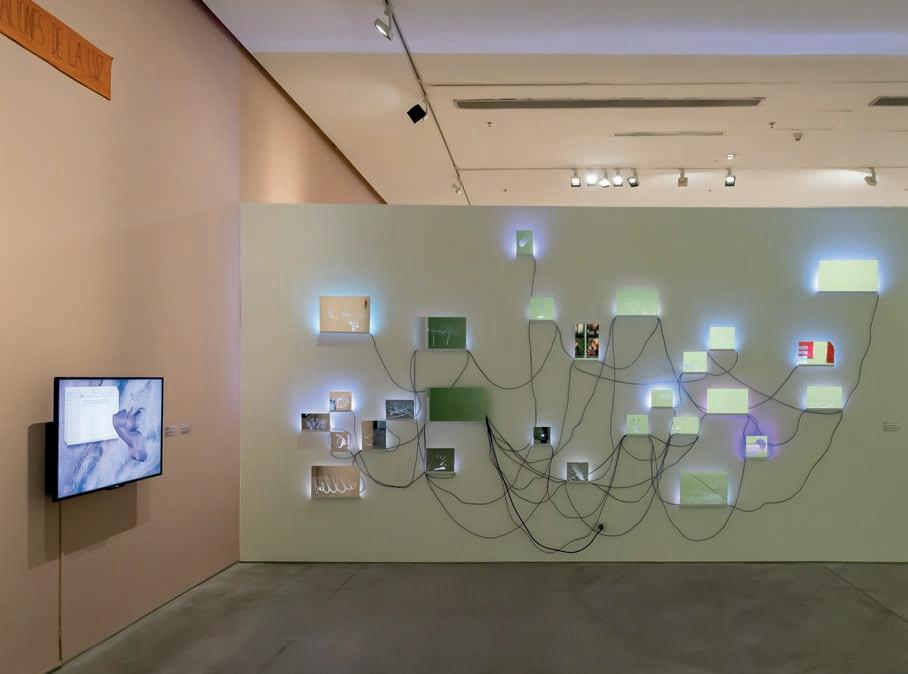
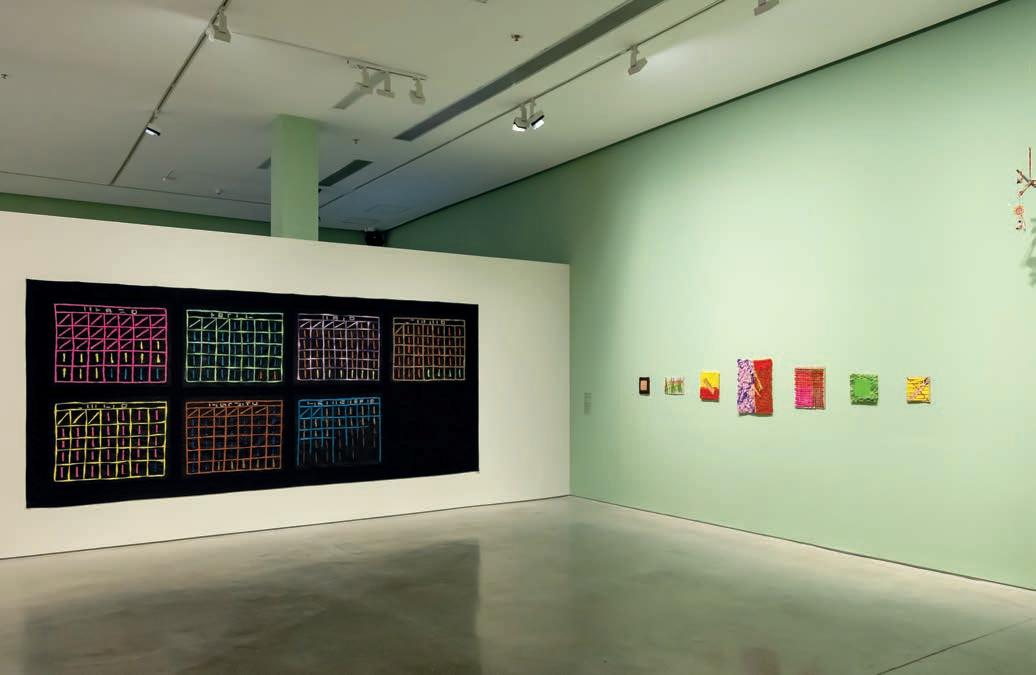
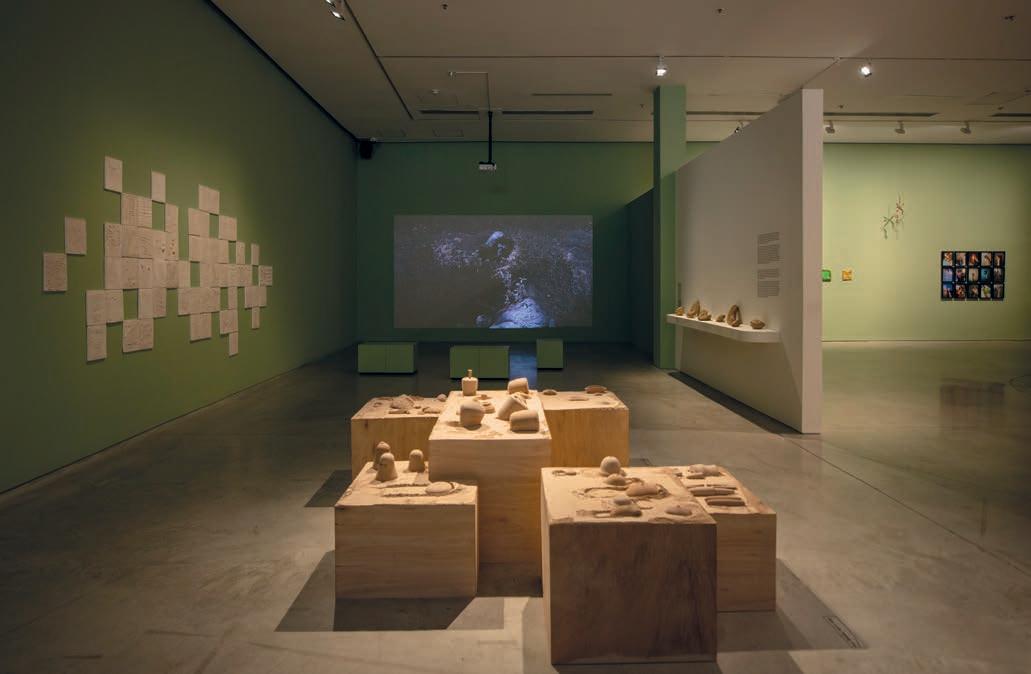

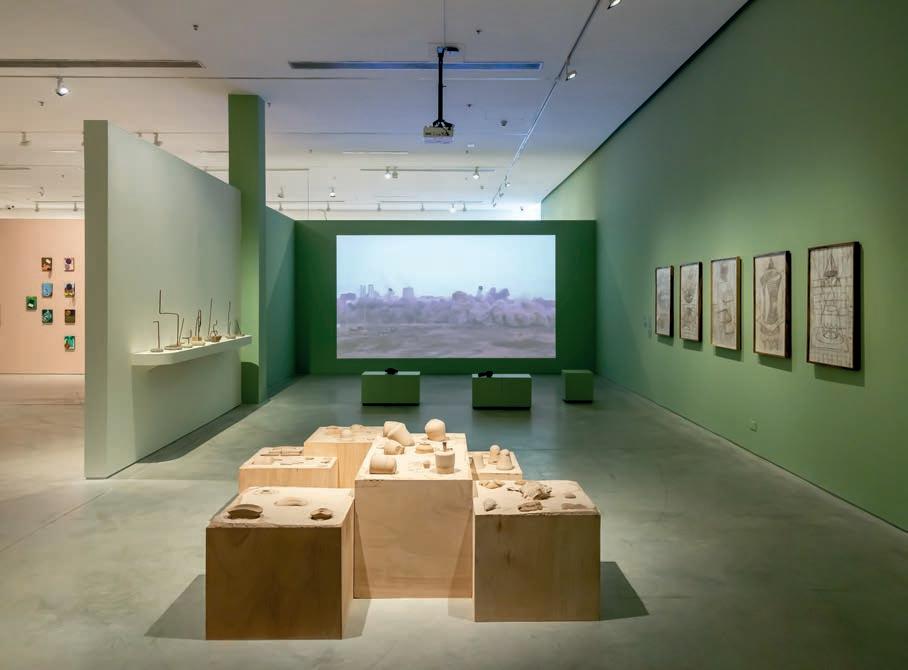

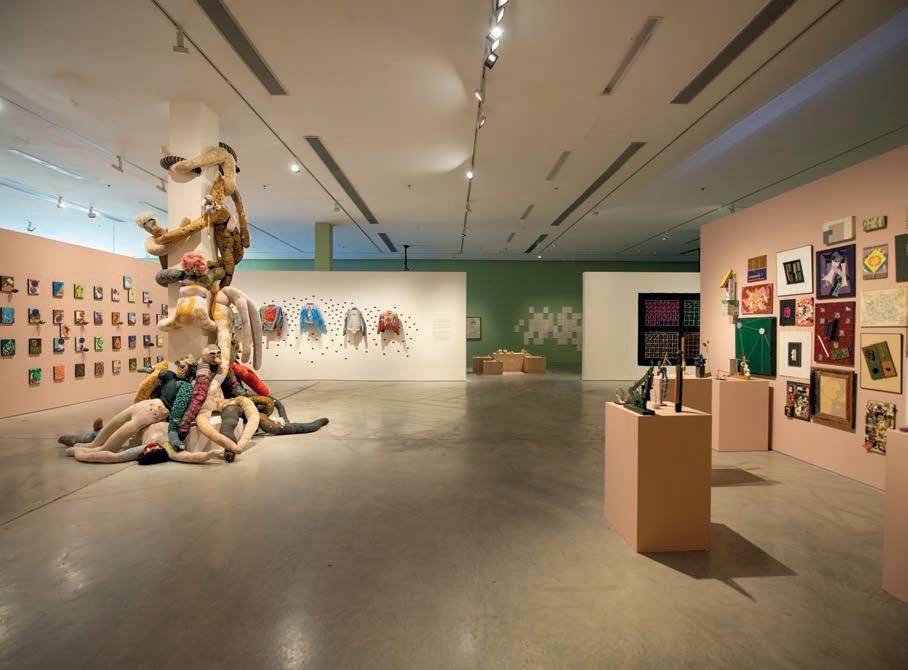

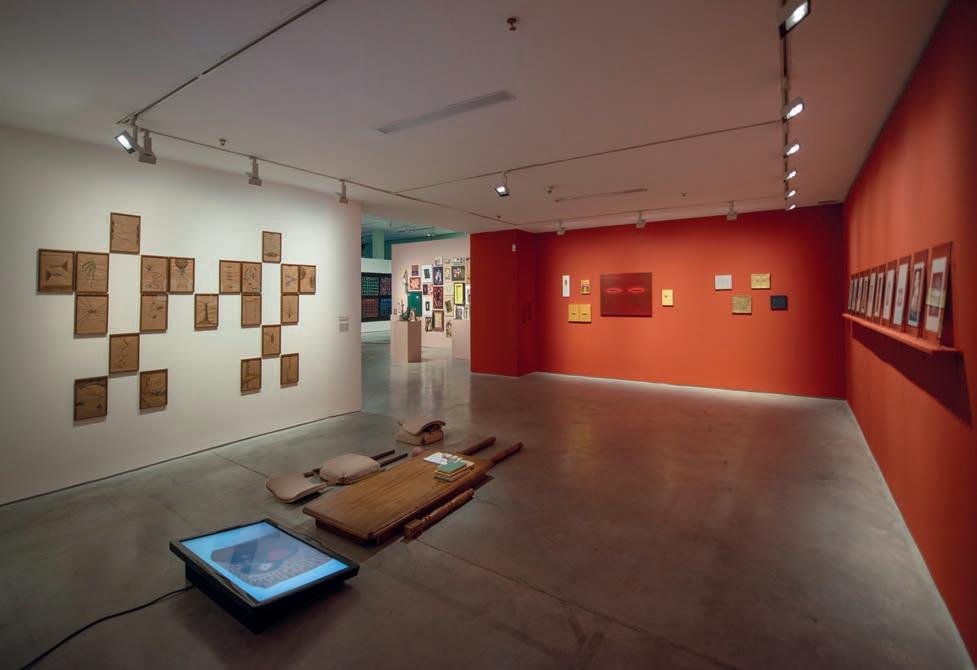
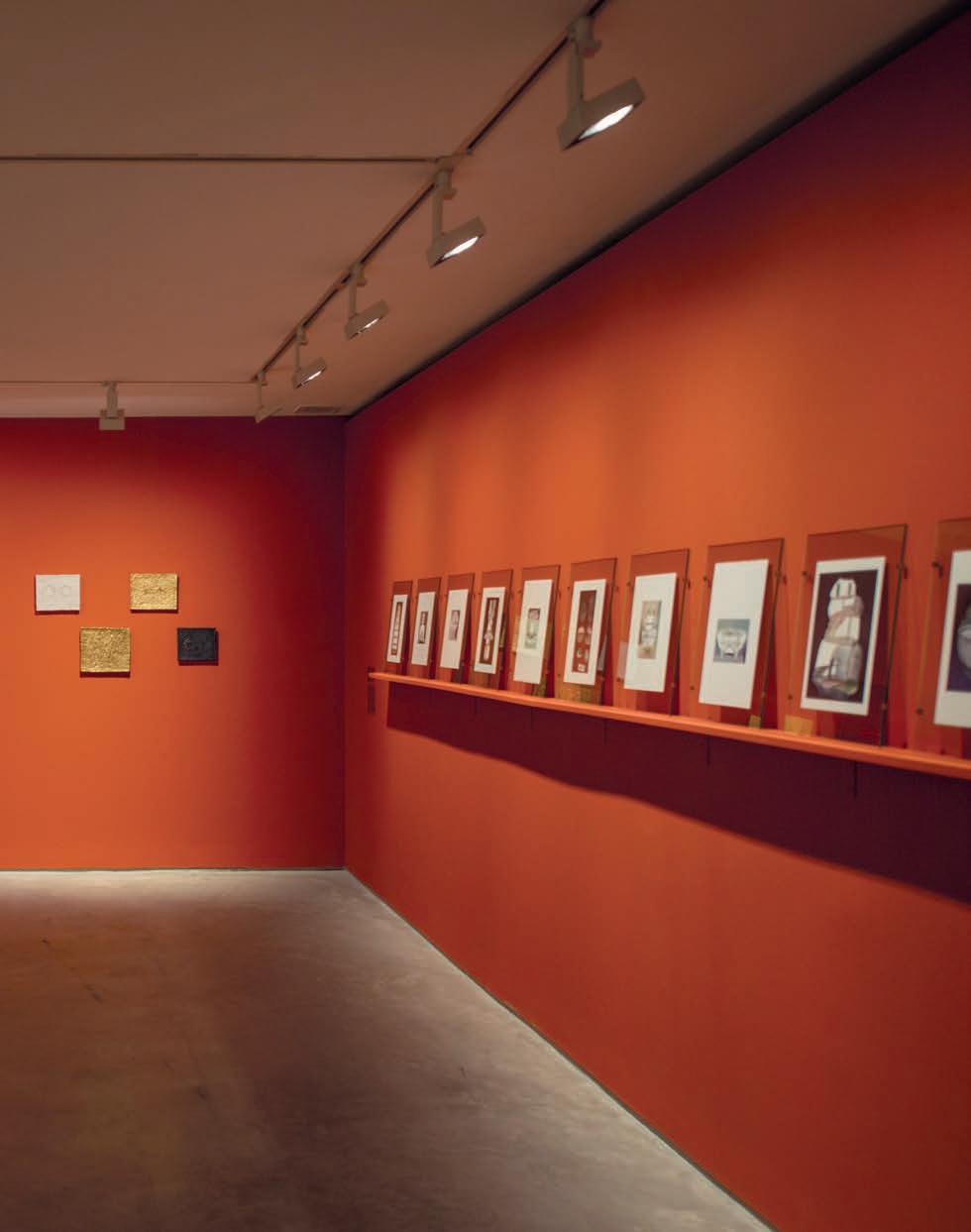

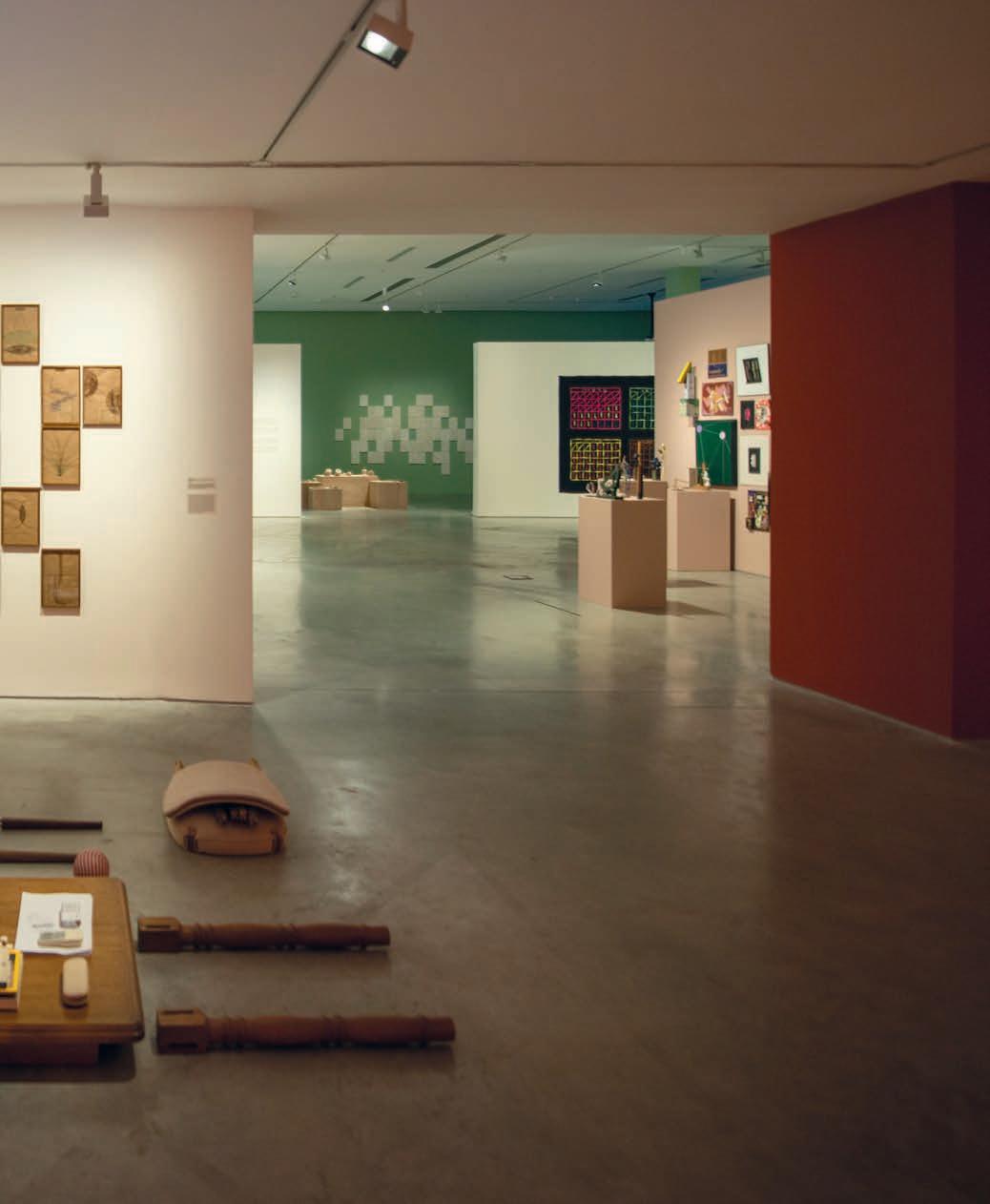
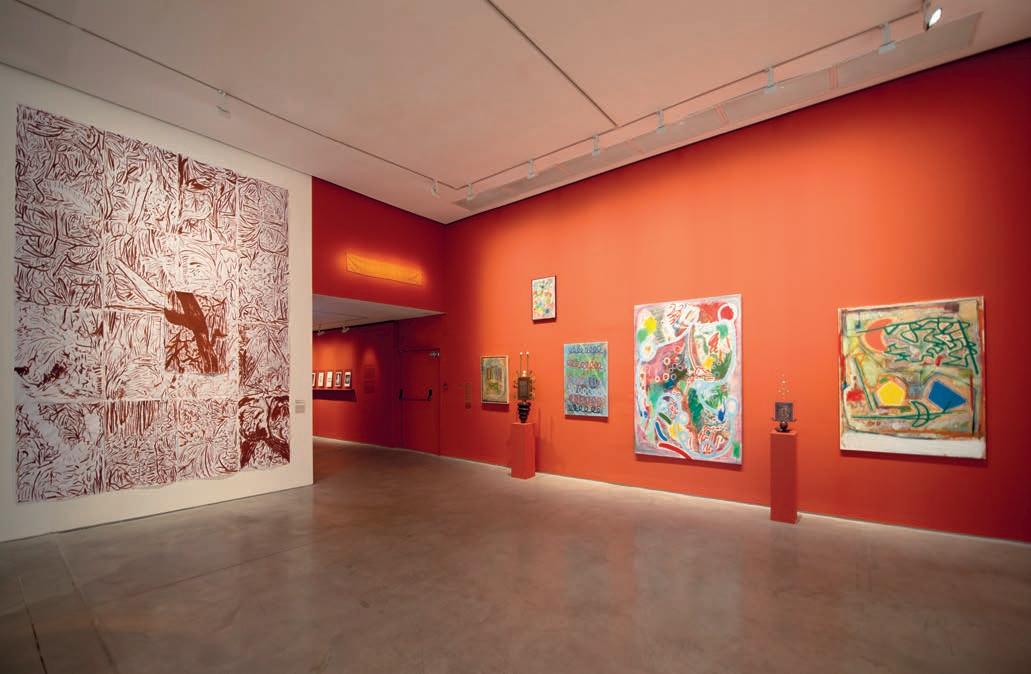

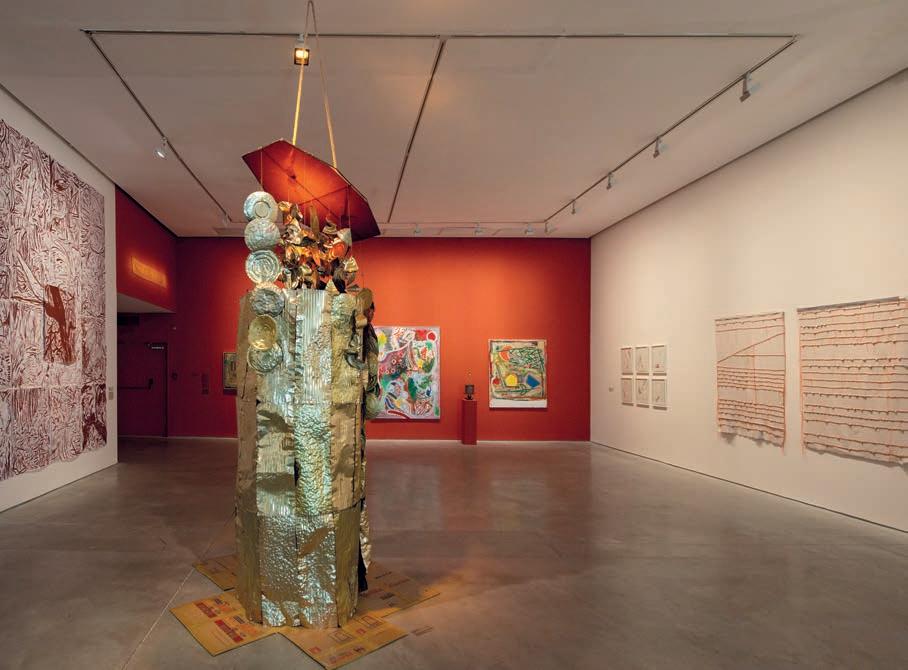


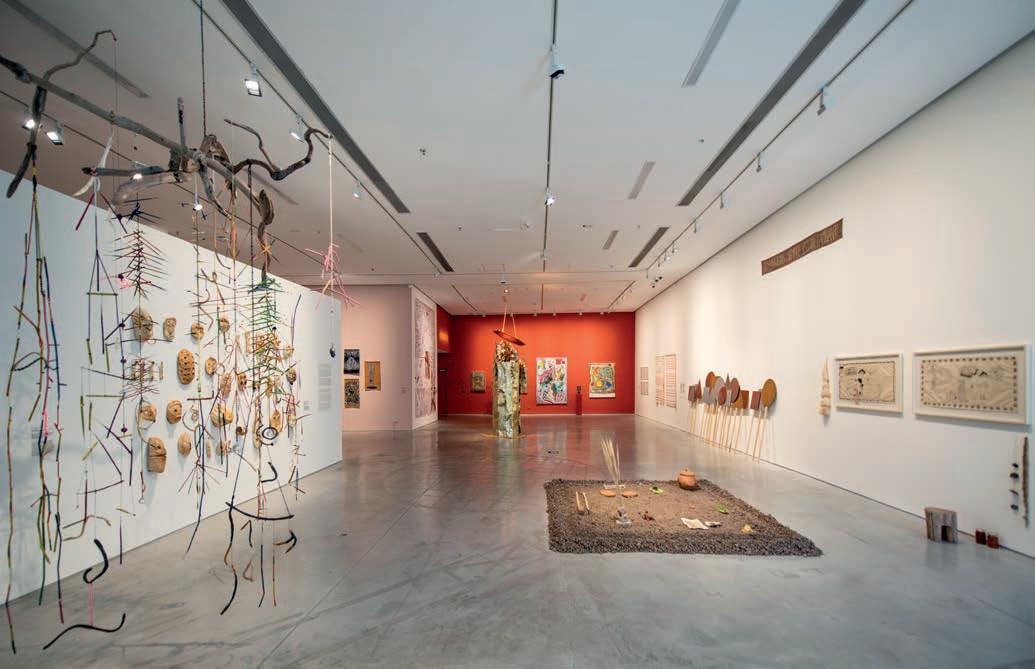
Arroyo Seco, Santa Fe, 1981 – vive en Rosario [lives in Rosario], Santa Fe
Templar la cuerda universal [Tuning the Universal String], 2021 Instalación compuesta de las siguientes obras [Installation consisting of the following works]:
Morandi, 2016-2021 Pintura y madera [Paint and wood] 58 × 9 × 5,5 cm
Nuevas anarquías [New Anarchies], 2018
Acrílico, metal, madera y cartón sobre madera [Acrylic, metal, wood and cardboard on wood]
45 × 40 cm
Sin título [Untitled], 2018 Telgopor, arena y pintura industrial [Polystyrene, sand and industrial paint]
18 × 14 × 11,5 cm
Sin título [Untitled], 2018 Pintura industrial sobre lata [Industrial paint on tin] 18,5 × 10 cm
Sin título [Untitled], 2018 Mármol y madera [Marble and wood] 22 × 11 × 5 cm
Sin título [Untitled], 2018 Madera, chapa y pintura industrial [Wood, sheet metal and industrial painting] 22,5 × 16 × 14,5 cm
Sin título [Untitled], 2018 Acrílico sobre madera [Acrylic on wood] 30 × 21 cm
Sin título [Untitled], 2018 Acrílico, semillas, metal, cinta de raso sobre madera [Acrylic, seeds, metal, satin ribbon on wood] 45 × 24 cm
Sin título [Untitled], 2018 Chapa y cemento blanco [Sheet metal and white cement] 45 × 30 × 7,5 cm
Sin título [Untitled], 2018 Pintura industrial sobre cartón [Industrial paint on cardboard] 56 × 45 cm
Babosa trepando una estrella [Slug Climbing a Star], 2019 Masilla, chapa de zinc, madera y granito [Putty, zinc sheet, wood and granite] 24,5 × 17 × 5 cm
Bandera universal [Universal Flag], 2019 Acrílico, cartón y semillas sobre telgopor [Acrylic, cardboard and seeds on polystyrene] 51 × 35 cm
Cohete [Rocket], 2019 Madera, mármol y esfera de vidrio [Wood, marble and glass sphere] 30,5 × 12,5 × 4 cm
El culebrón de la Bauhaus [The Bauhaus Soap Opera], 2019 Granito y varilla metálica [Granite and metal rod] 20 × 16 × 7,5 cm
Hoco Huoc, 2019 Cartón, tela y papel sobre cartón [Cardboard, canvas and paper on cardboard] 42,5 × 17,5 cm
La rama rebelde [The Rebel Branch], 2019
Madera, cartón e hidroesmalte sobre telgopor enduido [Wood, cardboard and hydroenamel on rendered polystyrene] 60 × 50 cm
Plaza de los pintores [Painters’ Square], 2019
Madera, cartón, plástico, espejo, pinceles, alambre, vidrio líquido sobre telgopor [Wood, cardboard, plastic, mirror, paintbrushes, wire, liquid glass on polystyrene] 51 × 40 cm
Rasta emo [Emo Rasta], 2019 Acrílico y madera sobre telgopor [Acrylic and wood on polystyrene] 50 × 46,5 cm
Sin título [Untitled], 2019 Tres piezas en fundición de hierro [Three pieces in cast-iron] Medidas variables [Dimensions variable]
Sin título [Untitled], 2019 Yeso [Plaster] 25,5 × 10 × 10 cm
Sin título [Untitled], 2019 Acrílico y látex sobre fenólico [Acrylic and latex on phenolic] 30 × 21 cm
Sin título [Untitled], 2019 Telgopor y acrílico [Polystyrene and acrylic]
42,5 × 30 cm
Sin título [Untitled], 2019 Madera, plástico, chapa y alambre
[Wood, plastic, sheet metal and wire] 46 × 29,5 × 2 cm
Sin título [Untitled], 2019 Acrílico, telgopor y madera [Acrylic, polystyrene and wood] 53 × 45 cm
Veleritos [Little Sailing Boats], 2019 Cartón, masilla epoxi, esmalte sintético, tachas metálicas y cuerina sobre madera [Cardboard, epoxy putty, synthetic enamel, metal studs and leather on wood] 30 × 21 cm
Diseño para peine [Design for Comb], 2020 Madera, bronce y mármol [Wood, bronze and marble] 36,5 × 5 × 5 cm
Feria de artesanos [Craft Fair], 2020 Acrílico, papel y varilla de madera sobre madera [Acrylic, paper and wooden rod on wood] 30 × 21 cm
Instrumento roto [Broken Instrument], 2020 Madera, cuerda y papel sobre MDF [Wood, string and paper on MDF] 30 × 30 cm
La balsa [The Raft], 2020 Madera, hilo y pintura industrial [Wood, thread and industrial paint] 18,5 × 16 × 12 cm
La sopa [The Soup], 2020 Acrílico, semillas, vellón siliconado y telgopor sobre madera [Acrylic, seeds, siliconised fleece and
polystyrene on wood] 30 × 21 cm
Sin título [Untitled], 2020 Madera y alambre [Wood and wire] 16 × 15,5 × 15 cm
Sin título [Untitled], 2020 Acrílico, papel y malla plástica sobre arpillera [Acrylic, paper and plastic mesh on burlap] 28 × 18,5 cm
Sin título [Untitled], 2020 Acrílico, cinta falletina y cartón sobre madera [Acrylic, acetate satin ribbon and cardboard on wood] 30 × 21 cm
Sin título [Untitled], 2020 Madera, alambre y yeso [Wood, wire and plaster] 30 × 24 × 6 cm
Sin título [Untitled], 2020 Acrílico y papel sobre MDF [Acrylic and paper on MDF] 30 × 30 cm
Volver al futuro [Back to the Future], 2020 Acrílico y cinta de falletina sobre madera [Acrylic and acetate satin tape on wood] 32 × 22,5 cm
Dejalo ser [Let It Be], 2021 Acrílico, cartón y enduido sobre MDF [Acrylic, cardboard and grout on MDF] 50 × 40 cm
El espejo de la belleza [The Mirror of Beauty], 2021
Papel, acrílico y cuerda sobre tela [Paper, acrylic and string on canvas]
50 × 40 cm
Escultura color 1 [Colour Sculpture 1], 2021
Acrílico y papel sobre telgopor [Acrylic and paper on polystyrene] 53 × 26 × 25 cm
Escultura color 2 [Colour Sculpture 2], 2021
Acrílico y papel sobre telgopor [Acrylic and paper on polystyrene] 61 × 21 × 11,5 cm
Faro [Lighthouse], 2021
Acrílico, papel, yeso y masilla [Acrylic, paper, plaster and putty] 59 × 36 cm
Jacarandá [Jacaranda], 2021
Acrílico, cartón y cinta de falletina sobre madera [Acrylic, cardboard and acetate satin ribbon on wood] 70 × 60 cm
Jazmín del Paraguay [Jasmine of Paraguay], 2021
Acrílico, cartón, masilla y cuerda sobre madera [Acrylic, cardboard, putty and string on wood] 70 × 60 cm
Luján, 2021
Acrílico, cinta falletina, telgopor y yeso sobre madera [Acrylic, acetate satin ribbon, polystyrene and plaster on wood]
70 × 60 cm
Naufragio [Shipwreck], 2021
Acrílico, telgopor, fósforos y cuerda sobre lienzo [Acrylic,
polystyrene, matchsticks and string on canvas]
35 × 27 cm
Nuevas fantasías [New Fantasies], 2021
Acrílico dimensional, piedras, esmalte sintético sobre MDF [Dimensional acrylic, stones, synthetic enamel on MDF] 50 × 40 cm
Pescamagic [Fishingmagic], 2021
Madera, espejo, cuerdas de algodón, masilla epoxi, papel y acrílico sobre lienzo [Wood, mirror, cotton strings, epoxy putty, paper and acrylic on canvas] 60 × 40 cm
Pienso en ti [Thinking about You], 2021
Acrílico, pintura sintética, cartón y telgopor sobre MDF [Acrylic, synthetic paint, cardboard and polystyrene on MDF] 40 × 30 cm
Sin título [Untitled], 2021 Hierro, madera y pintura [Iron, wood and paint] 28,5 × 11 × 5,5 cm
Sin título [Untitled], 2021 Acrílico sobre cartón [Acrylic on cardboard]
32 × 21 cm
Sin título [Untitled], 2021 Acrílico sobre cartón [Acrylic on cardboard]
32 × 24 cm
Sin título [Untitled], 2021 Acrílico sobre madera [Acrylic on wood]
34,5 × 29,5 × 23 cm
Sin título [Untitled], 2021 Acrílico sobre madera [Acrylic on wood] 41 × 32,5 × 8,5 cm
Sin título [Untitled], 2021 Acrílico y papel sobre telgopor [Acrylic and paper on polystyrene] 41 × 33 cm
Soñando locuras [Dreaming Crazy Dreams], 2021
Acrílico sobre telgopor [Acrylic on polystyrene]
50 × 35,5 cm
Colección del artista [Artist’s collection]
BLAS APARECIDO
Sauce, Corrientes, 1976 – donde vive [where he lives]
Gilda, de la serie “Altares portables” [Gilda, from the ‘Portable Altars’ series], 2016 Hilo, mostacillas, lana y perlas de fantasía sobre tela de jean [Yarn, beads, wool and costume pearls on denim]
75 × 60 × 10 cm
Colección The White Lodge [The White Lodge collection]
Pido un amor verdadero, de la serie “Altares portables” [I Ask For True Love, from the ‘Portable Altars’ series], 2016 Hilo, mostacillas, perlas de fantasía
y cerdas de polipropileno sobre tela de jean [Yarn, beads, costume pearls and polypropylene bristles on denim]
90 × 70 × 15 cm
Colección Ricar Mosca [Ricar Mosca collection]
Siempre conmigo, de la serie “Altares portables” [Always with Me, from the ‘Portable Altars’ series], 2016 Hilo, mostacillas y lentejuelas sobre tela de jean [Yarn, beads and sequins on denim]
75 × 60 × 10 cm
Colección Alejandro Londero [Alejandro Londero collection]
Baile del 16 de julio, de la serie “Altares portables” [16th of July Dance, from the ‘Portable Altars’ series], 2019 Hilo, mostacillas y piedras de cuarzo blanco sobre tela de jean [Yarn, beads and white quartz stones on denim]
75 × 60 × 10 cm
Colección The White Lodge [The White Lodge collection]
Budagaucho, de la serie “Altares portables” [Buddhagaucho, from the ‘Portable Altars’ series], 2019 Hilo, mostacillas, lentejuelas y lana sobre tela de jean [Yarn, beads, sequins and wool on denim]
75 × 60 × 10 cm
Colección The White Lodge [The White Lodge collection]
ERIK ARAZI
Ciudad de Buenos Aires, 1990 –donde vive [where he lives]
Sistema nervioso central [Central Nervous System], 2020
Lápiz, marcador y café sobre papel [Pencil, felt-tip and coffee on paper] Medidas variables [Dimensions variable]
Colección del artista [Artist’s collection]
GONZALO BECCAR VARELA Tigre, Buenos Aires, 1983 – donde vive [where he lives]
Las personas no somos símbolos. Una pintura alianza [We People Aren’t Symbols: An Engagement Painting], 2020
Acrílico sobre tela [Acrylic on canvas] 24 × 18 cm
Colección privada [Private collection]
Mirar directo al sol con los ojos cerrados [Looking Straight at the Sun with Eyes Closed], 2020
Acrílico sobre tela [Acrylic on canvas] 70 × 100 cm
Colección privada [Private collection]
Una pinturasanta (para toda plegaria) [A Holypainting (for Every Prayer)], 2020
Acrílico sobre tela [Acrylic on canvas]
30 × 48 cm
Colección privada [Private collection]
Una quescucha para escuchar [A Listeningear to Listen], 2020 Acrílico sobre tela [Acrylic on canvas]
38 × 15 cm
Colección María Casado [María Casado collection]
Pintura para ojos cerrados [A Painting for Closed Eyes], 2021 Acrílico sobre tela [Acrylic on canvas] 24 × 18 × 15 cm
Colección del artista [Artist’s collection]
GALA BERGER
Villa Gesell, Buenos Aires, 1983 –vive en Lima [lives in Lima] (Perú)
Ministrx de Agricultura y Ganadería, de la serie “No tengo fuerzas para rendirme” [Minister for Agriculture and Livestock, from the ‘I Don’t Have the Strength to Surrender’ series], 2017
Sublimación digital sobre tela [Digital sublimation on fabric] 120 × 78 cm
Colección de la artista [Artist’s collection]
Ministrx de Ambiente y Energía, de la serie “No tengo fuerzas para rendirme” [Minister for the Environment and Energy, from the ‘I Don’t Have the Strength to Surrender’ series], 2017-2018
Sublimación digital sobre tela [Digital sublimation on fabric] 120 × 80 cm
Colección de la artista [Artist’s collection]
Ministrx de Comercio Exterior, de la serie “No tengo fuerzas para rendirme” [Minister for Foreign Trade, from the ‘I Don’t Have the Strength to Surrender’ series], 2017-2018
Sublimación digital sobre tela [Digital sublimation on fabric] 100 × 80 cm
Colección de la artista [Artist’s collection]
Ministrx de Gobernación, Policía y de Seguridad Pública, de la serie “No tengo fuerzas para rendirme” [Minister for Governance, Police and Public Security, from the ‘I Don’t Have the Strength to Surrender’ series], 2017-2018
Sublimación digital sobre tela [Digital sublimation on fabric] 100 × 70 cm
Colección de la artista [Artist’s collection]
Ministrx de Hacienda, de la serie “No tengo fuerzas para rendirme” [Minister for Finance, from the ‘I Don’t Have the Strength to Surrender’ series], 2017-2018 Sublimación digital sobre tela [Digital sublimation on fabric] 80 × 65 cm
Colección de la artista [Artist’s collection]
Ministrx de la Condición de la Mujer, de la serie “No tengo fuerzas para rendirme” [Minister for the Status of Women, from the ‘I Don’t Have the Strength to Surrender’ series], 2018 Sublimación digital sobre tela [Digital sublimation on fabric] 100 × 80 cm
Colección de la artista [Artist’s collection]
FLORENCIA CAIAZZA
Olivos, Buenos Aires, 1982 – donde vive [where she lives]
Sin título [Untitled], 2021 Yeso [Plaster]
Medidas variables [Dimensions variable]
Colección de la artista [Artist’s collection]
EUGENIA CALVO
Rosario, Santa Fe, 1976 – donde vive [where she lives]
Hecha para siempre [Made For Ever], 2021
Mesa, sillas, libros y video color monocanal (6 min, 35 s) [Table, chairs, books and single-channel colour video]
Medidas variables [Dimensions variable]
Colección de la artista [Artist’s collection]
NACHA CANVAS
Ushuaia, Tierra del Fuego, 1990 –vive en la Ciudad de Buenos Aires [lives in the City of Buenos Aires]
Congénere [Congener], 2021 Arcilla [Clay] Medidas variables [Dimensions variable]
Colección de la artista [Artist’s collection]
JIMENA CROCERI
Cutral-Có, Neuquén, 1981 – vive en la Ciudad de Buenos Aires [lives in the City of Buenos Aires]
Trapo sonajero (escuchá, escuchá) [Rattle Rag (Listen, Listen)], 2021 Hilo y cascabeles sobre tela [Yarn and jingle bells on fabric] 164 × 114 cm
Colección de la artista [Artist’s collection]
Trapo sonajero (caudal lento) [Rattle Rag (Slow Flow)], 2021 Hilo y cascabeles sobre tela [Yarn and jingle bells on fabric] 155 × 110 cm Colección de la artista [Artist’s collection]
SOLEDAD DAHBAR Salta, Salta, 1976 – donde vive [where she lives]
Manifestación [Demonstration], 2019 Barniz poliuretano y purpurina sobre MDF [Polyurethane varnish and glitter on MDF] Medidas variables [Dimensions variable]
Colección del Museo de Arte Moderno de Buenos Aires. Adquirida por el Comité de Adquisiciones 2020-2021 [Museo de Arte Moderno de Buenos Aires Collection. Acquired by the 20202021 Acquisitions Committee]
San Miguel de Tucumán, Tucumán, 1990 – vive en la Ciudad de Buenos Aires [lives in the City of Buenos Aires]
Conjuros hiperboloides [Hyperboloid Spells], 2020 Parafina y tierra sobre fenólico pintado [Paraffin and soil on painted phenolic] 90 × 62 cm
Colección del artista [Artist’s collection]
El brujo hiperboloide [The Hyperboloid Sorcerer], 2020 Parafina y tierra sobre fenólico
pintado [Paraffin and soil on painted phenolic]
90 × 62 cm
Colección del artista [Artist’s collection]
El colapso del brujo [The Sorcerer’s Collapse], 2020
Parafina y tierra sobre fenólico pintado [Paraffin and soil on painted phenolic]
90 × 62 cm
Colección Nahuel Ortiz Vidal [Nahuel Ortiz Vidal collection]
Hipergeometría primera [First Hypergeometry], 2020
Parafina y tierra sobre fenólico pintado [Paraffin and soil on painted phenolic]
90 × 62 cm
Colección del artista [Artist’s collection]
La métrica protectora [Protective Metrics], 2020
Parafina y tierra sobre fenólico pintado [Paraffin and soil on painted phenolic] 90 × 62 cm
Colección Mercedes Pardo [Mercedes Pardo collection]
DANA FERRARI
Ciudad de Buenos Aires, 1988 –donde vive [where she lives]
Serie “Los mareados” [‘The Dizzy’ series], 2020-2021
Gomaespuma, cartón, telas y medias de nylon [Foam rubber, cardboard, fabric and nylon stockings] Medidas variables [Dimensions variable]
Colección de la artista [Artist’s collection]
CAROLINA FUSILIER
Ciudad de Buenos Aires, 1985 –vive en Oaxaca [lives in Oaxaca] (México)
Sin título, de la serie “Ucronías de habitaciones totémicas” [Untitled, from the ‘Uchronias of Totemic Rooms’ series], 2019
Impresión y acuarela sobre papel [Print and watercolour on paper] 32 × 24 cm
Colección de la artista [Artist’s collection]
Sin título, de la serie “Ucronías de habitaciones totémicas” [Untitled, from the ‘Uchronias of Totemic Rooms’ series], 2019 Impresión y acuarela sobre papel [Print and watercolour on paper] 32 × 24 cm
Colección de la artista [Artist’s collection]
Sin título, de la serie “Ucronías de habitaciones totémicas” [Untitled, from the ‘Uchronias of Totemic Rooms’ series], 2019 Impresión y acuarela sobre papel [Print and watercolour on paper] 32 × 24 cm
Colección de la artista [Artist’s collection]
Sin título, de la serie “Ucronías de habitaciones totémicas” [Untitled, from the ‘Uchronias of Totemic Rooms’ series], 2019
Impresión y acuarela sobre papel [Print and watercolour on paper]
32 × 24 cm
Colección de la artista [Artist’s collection]
Sin título, de la serie “Ucronías de habitaciones totémicas” [Untitled, from the ‘Uchronias of Totemic Rooms’ series], 2019
Impresión y acuarela sobre papel [Print and watercolour on paper] 32 × 24 cm
Colección de la artista [Artist’s collection]
Sin título, de la serie “Ucronías de habitaciones totémicas” [Untitled, from the ‘Uchronias of Totemic Rooms’ series], 2019 Impresión y acuarela sobre papel [Print and watercolour on paper] 32 × 24 cm
Colección de la artista [Artist’s collection]
Sin título, de la serie “Ucronías de habitaciones totémicas” [Untitled, from the ‘Uchronias of Totemic Rooms’ series], 2019 Impresión y acuarela sobre papel [Print and watercolour on paper] 32 × 24 cm
Colección de la artista [Artist’s collection]
Sin título, de la serie “Ucronías de habitaciones totémicas” [Untitled, from the ‘Uchronias of Totemic Rooms’ series], 2019
Impresión y acuarela sobre papel [Print and watercolour on paper] 32 × 24 cm
Colección de la artista [Artist’s collection]
Sin título, de la serie “Ucronías de habitaciones totémicas” [Untitled, from the ‘Uchronias of Totemic Rooms’ series], 2019
Impresión y acuarela sobre papel [Print and watercolour on paper] 32 × 24 cm
Colección de la artista [Artist’s collection]
Sin título, de la serie “Ucronías de habitaciones totémicas” [Untitled, from the ‘Uchronias of Totemic Rooms’ series], 2019
Impresión y acuarela sobre papel [Print and watercolour on paper] 32 × 24 cm
Colección de la artista [Artist’s collection]
Sin título, de la serie “Ucronías de habitaciones totémicas” [Untitled, from the ‘Uchronias of Totemic Rooms’ series], 2019 Impresión y acuarela sobre papel [Print and watercolour on paper] 32 × 24 cm
Colección de la artista [Artist’s collection]
Ciudad de Buenos Aires, 1989 –donde vive [where she lives]
El beneno de la belleza [The Benom of Beauty], 2019
Hierro, chapa, hilo de cobre y cartón [Iron, sheet metal, copper wire and cardboard] 350 × 110 × 110 cm
Colección de la artista [Artist’s collection]
Ciudad de Buenos Aires, 1973 –donde vive [where she lives]
Ladrillo africano [African Brick], 2019
Gouache sobre papel [Gouache on paper]
34 × 24 cm
Colección de la artista [Artist’s collection]
Ladrillo en punta [Pointed Brick], 2019 Gouache sobre papel [Gouache on paper] 32 × 24 cm
Colección de la artista [Artist’s collection]
Sin título [Untitled], 2019 Gouache sobre papel [Gouache on paper]
25 × 27 cm
Colección de la artista [Artist’s collection]
Sin título [Untitled], 2019. Gouache sobre papel [Gouache on paper]
25 × 27 cm
Colección de la artista [Artist’s collection]
Sin título [Untitled], 2019
Gouache sobre papel [Gouache on paper]
33 × 26,5 cm
Colección de la artista [Artist’s collection]
Sin título [Untitled], 2019 Gouache sobre papel [Gouache on paper]
60 × 72 cm
Colección de la artista [Artist’s collection]
Ladrillos camino [Road Bricks], 2020 Gouache sobre papel [Gouache on paper]
100 × 70 cm
Colección de la artista [Artist’s collection]
Sin título, de la serie “Ladrillos danzarines” [Untitled, from the ‘Dancing Bricks’ series], 2020 Gouache sobre papel [Gouache on paper]
37 × 47 cm
Colección de la artista [Artist’s collection]
Sin título, de la serie “Ladrillos danzarines” [Untitled, from the ‘Dancing Bricks’ series], 2020 Gouache sobre papel [Gouache on paper]
37 × 47 cm
Colección de la artista [Artist’s collection]
Sin título, de la serie “Ladrillos danzarines” [Untitled, from the ‘Dancing Bricks’ series], 2020 Gouache sobre papel [Gouache on paper]
37 × 47 cm
Colección de la artista [Artist’s collection]
Sin título, de la serie “Ladrillos danzarines” [Untitled, from the ‘Dancing Bricks’ series], 2020 Gouache sobre papel [Gouache on paper]
37 × 47 cm
Colección de la artista [Artist’s collection]
Sin título, de la serie “Ladrillos danzarines” [Untitled, from the ‘Dancing Bricks’ series], 2020 Gouache sobre papel [Gouache on paper]
37 × 47 cm
Colección de la artista [Artist’s collection]
Sin título, de la serie “Ladrillos danzarines” [Untitled, from the ‘Dancing Bricks’ series], 2020 Gouache sobre papel [Gouache on paper]
37 × 47 cm
Colección de la artista [Artist’s collection]
Deán Funes, Córdoba, 1986 – vive entre París (Francia) [lives in Paris (France)] y Córdoba [and Córdoba]
2020-2021, 2021 Videos digitales color monocanal, sonido estéreo (reproducción aleatoria) [Single-channel digital colour videos, stereo sound (random play)]
Colección del artista [Artist’s collection]
Ciudad de Buenos Aires, 1993 –donde vive [where she lives]
Pulmón de manzana [Light Well], 2020
Espejo, cable, luz led y arduino [Mirror, cable, LED light and arduino]
Diseño lumínico [Lighting Design]: Giselle Hauscarriaga Programación de arduino [Arduino programming]: Eric Sauerhering Diseño de montaje [Exhibition design]: Daniel Leber Medidas variables [Dimensions variable]
Colección de la artista [Artist’s collection]
Sin título, de la serie “Selfins” [Untitled, from the ‘Selfins’ series], 2019-2020
Fotografías color [Colour photographs]
22 × 33 cm
Colección de la artista [Artist’s collection]
Sin título, de la serie “Selfins” [Untitled, from the ‘Selfins’ series], 2019-2020
Fotografías color [Colour photographs]
22 × 33 cm
Colección de la artista [Artist’s collection]
Sin título, de la serie “Selfins” [Untitled, from the ‘Selfins’ series], 2019-2020
Fotografías color [Colour photographs]
22 × 33 cm
Colección de la artista [Artist’s collection]
Sin título, de la serie “Selfins” [Untitled, from the ‘Selfins’ series], 2019-2020
Fotografías color [Colour photographs]
22 × 33 cm
Colección de la artista [Artist’s collection]
Sin título, de la serie “Selfins” [Untitled, from the ‘Selfins’ series], 2019-2020
Fotografías color [Colour photographs]
22 × 33 cm
Colección de la artista [Artist’s collection]
Sin título, de la serie “Selfins” [Untitled, from the ‘Selfins’ series], 2019-2020
Fotografías color [Colour photographs]
22 × 33 cm
Colección de la artista [Artist’s collection]
Sin título, de la serie “Selfins” [Untitled, from the ‘Selfins’ series], 2019-2020 Fotografías color [Colour photographs] 22 × 33 cm
Colección de la artista [Artist’s collection]
Sin título, de la serie “Selfins” [Untitled, from the ‘Selfins’ series], 2019-2020
Fotografías color [Colour photographs]
22 × 33 cm
Colección de la artista [Artist’s collection]
Sin título, de la serie “Selfins” [Untitled, from the ‘Selfins’ series], 2019-2020
Fotografías color [Colour
photographs]
22 × 33 cm
Colección de la artista [Artist’s collection]
Sin título, de la serie “Selfins” [Untitled, from the ‘Selfins’ series], 2019-2020
Fotografías color [Colour photographs]
22 × 33 cm
Colección de la artista [Artist’s collection]
Sin título, de la serie “Selfins” [Untitled, from the ‘Selfins’ series], 2019-2020
Fotografías color [Colour photographs]
22 × 33 cm
Colección de la artista [Artist’s collection]
Sin título, de la serie “Selfins” [Untitled, from the ‘Selfins’ series], 2019-2020
Fotografías color [Colour photographs]
22 × 33 cm
Colección de la artista [Artist’s collection]
Sin título, de la serie “Selfins” [Untitled, from the ‘Selfins’ series], 2019-2020
Fotografías color [Colour photographs]
22 × 33 cm
Colección de la artista [Artist’s collection]
Sin título, de la serie “Selfins” [Untitled, from the ‘Selfins’ series], 2019-2020
Fotografías color [Colour photographs]
22 × 33 cm
Colección de la artista [Artist’s collection]
Sin título, de la serie “Selfins” [Untitled, from the ‘Selfins’ series], 2019-2020
Fotografías color [Colour photographs]
22 × 33 cm
Colección de la artista [Artist’s collection]
Sin título, de la serie “Selfins” [Untitled, from the ‘Selfins’ series], 2019-2020
Fotografías color [Colour photographs]
22 × 33 cm
Colección de la artista [Artist’s collection]
LUCRECIA LIONTI
San Miguel de Tucumán, Tucumán, 1985 – vive en la Ciudad de Buenos Aires [lives in the City of Buenos Aires]
Calendario abstracto [Abstract Calendar], 2020
Lana de oveja, lana acrílica, óleo pastel y tela [Sheep’s wool, acrylic wool, oil pastel and fabric] 200 × 460 cm
Colección de la artista [Artist’s collection]
Amarillo [Yellow], 2021
Lana de oveja, fibras sintéticas, lápiz de color y cartón [Sheep’s wool, synthetic fibres, coloured pencil and cardboard]
20 × 19 cm
Colección de la artista [Artist’s collection]
Amarillo, rojo y dorado [Yellow, Red and Gold], 2021 Lana de oveja, lana acrílica, hilo, corcho y metal [Sheep’s wool, acrylic wool, yarn, cork and metal] 28 × 25 cm
Colección de la artista [Artist’s collection]
Cuadrado verde [Green Square], 2021 Lana sintética, hilo y cartón [Synthetic wool, yarn and cardboard] 24 × 24,5 cm
Colección de la artista [Artist’s collection]
Fucsia, dorado y marrón [Fuchsia, Gold and Brown], 2021
Lana de oveja, tela, lápiz y cartón [Sheep’s wool, canvas, pencil and cardboard] 38 × 33 cm
Colección de la artista [Artist’s collection]
Multicolor [Multicolour], 2021 Lana de oveja, corcho y cordón [Sheep’s wool, cork and cord] 19 × 17 cm
Colección de la artista [Artist’s collection]
Taglis por adición [Tagli by Addition], 2021
Lana de oveja, madera, corcho y metal [Sheep’s wool, wood, cork and metal] 53 × 41 cm
Colección de la artista [Artist’s collection]
Verde y rojo [Green and Red], 2021
Lana de oveja, fibras sintéticas, lápiz de color, pintura acrílica y cartón [Sheep’s wool, synthetic fibres, coloured pencil, acrylic paint and cardboard]
20 × 30 cm
Colección de la artista [Artist’s collection]
San Miguel de Tucumán, Tucumán, 1981 – donde vive [where she lives]
Fantasía aplicada [Applied Fantasy], 2021
Tintura de palta e hilo sobre tela, hierro [Avocado dye and yarn on canvas, iron]
Medidas variables [Dimensions variable]
Bastidores de hierro [Iron stretchers]: Luis Pereyra
Colección de la artista [Artist’s collection]
Sunchales, Santa Fe, 1994 – vive en Santa Fe [lives in Santa Fe], Santa Fe
Triste y melancólica, de la serie “La lengua de las piedras” [Sad and Melancholic, from the series ‘The Language of Stones’], 2020 Piedra [Stone]
14 × 14,5 × 8,5 cm
Colección de la artista [Artist’s collection]
Calaveras, de la serie “La lengua de las piedras” [Skulls, from the series ‘The Language of Stones’], 2021 Piedra [Stone]
18 × 11 × 4,5 cm
Colección de la artista [Artist’s collection]
Invocación, de la serie “La lengua de las piedras” [Invocation, from the series ‘The Language of Stones’], 2021 Piedra [Stone] 22 × 16,5 × 6 cm
Colección de la artista [Artist’s collection]
Pobres corazones, de la serie “La lengua de las piedras” [Poor Hearts, from the series ‘The Language of Stones’], 2021 Piedra [Stone] 12 × 11 × 10 cm
Colección de la artista [Artist’s collection]
Precarizada, de la serie “La lengua de las piedras” [Precarised, from the series ‘The Language of Stones’], 2021 Piedra [Stone] 17 × 22 × 6,5 cm.
Colección de la artista [Artist’s collection]
Selfies, de la serie “La lengua de las piedras” [Selfies, from the series ‘The Language of Stones’], 2021 Piedra [Stone] 13 × 12 × 7 cm
Colección de la artista [Artist’s collection]
Sin título, de la serie “La lengua de las piedras” [Untitled, from the series ‘The Language of Stones’], 2021 Piedra [Stone] 22,5 × 22 × 6 cm
Colección de la artista [Artist’s collection]
Triángulo de las Bermudas, de la serie “La lengua de las piedras” [Bermuda Triangle, from the series ‘The Language of Stones’], 2021 Piedra [Stone] 22,5 × 22 × 6 cm
Colección de la artista [Artist’s collection]
Virus, de la serie “La lengua de las piedras” [Virus, from the series ‘The Language of Stones’], 2021 Piedra [Stone] 11,5 × 9,5 × 5,5 cm
Colección de la artista [Artist’s collection]
Zzz, de la serie “La lengua de las piedras” [Zzz, from the series ‘The Language of Stones’] 2021 Piedra [Stone] 16 × 15 × 8 cm
Colección de la artista [Artist’s collection]
Mendoza, Mendoza, 1989 – vive en la Ciudad de Buenos Aires [lives in the City of Buenos Aires]
Sin título [Untitled], 2021 Pan y alambre [Bread and wire] Medidas variables [Dimensions variable]
Colección del artista [Artist’s collection]
Ciudad de Buenos Aires, 1994 –donde vive [where she lives]
Cochabamba (Bolivia), 1978 – vive en la Ciudad de Buenos Aires [lives in the City of Buenos Aires]
Chilkeadas las lenguas que vuelven del humo [ Chilked the Tongues that Return from the Smoke ], 2021
Ritual performático con sahúmo y chilka [Performative ritual with censer and chilka]
Salliqueló, Buenos Aires, 1980 –vive en la Ciudad de Buenos Aires [lives in the City of Buenos Aires]
Artefacto de escucha Nº 6 [Listening Device No. 6], 2021
Lana e hilo sobre tela [Wool and yarn on canvas]
30 × 150 cm
Colección de la artista [Artist’s collection]
Artefacto de escucha Nº 7 [Listening Device No. 7], 2021
Lana e hilo sobre tela [Wool and yarn on canvas]
30 × 150 cm
Colección de la artista [Artist’s collection]
Artefacto de escucha Nº 8 [Listening Device No. 8], 2021
Lana e hilo sobre tela [Wool and yarn on canvas]
30 × 150 cm
Colección de la artista [Artist’s collection]
Artefacto de escucha Nº 9 [Listening Device No. 9], 2021
Lana e hilo sobre tela [Wool and yarn on canvas]
30 × 150 cm
Colección de la artista [Artist’s collection]
Artefacto de escucha Nº 10 [Listening Device No. 10], 2021 Lana e hilo sobre tela [Wool and yarn on canvas]
30 × 150 cm
Colección de la artista [Artist’s collection]
Paraná, Entre Ríos, 1993 – vive en la Ciudad de Buenos Aires [lives in the City of Buenos Aires]
Sin título [Untitled], 2019 Polvo de oro, pigmentos naturales y aceite de lino sobre papel maché con estructura de zinc [Gold dust, natural pigments and linseed oil on papier-mâché with zinc structure]
20 × 27 cm
Colección Feldman-Riveros [Feldman-Riveros collection]
Asleep, 2020
Esmalte y pigmento iridiscente sobre papel maché con estructura de zinc [Enamel and iridescent pigment on papier-mâché with zinc structure]
19 × 22 cm
Colección del artista [Artist’s collection]
Casio, 2020 Polvo de oro y aceite de lino sobre papel maché con estructura de zinc [Gold dust and linseed oil on papier-mâché with zinc structure]
25 × 28 cm
Colección del artista [Artist’s collection]
Virtuoso, 2020 Pigmento iridiscente, aceite de lino y cristales de cuarzo sobre papel maché con estructura de zinc [Iridescent pigment, linseed oil and quartz crystals on papier-mâché with zinc structure] 20 × 25 cm
Colección del artista [Artist’s collection]
Salta, Salta, 1991 – vive en Cafayate [lives in Cafayate], Salta
Quema en Corralito [Burning in Corralito], 2020-2021 Tinta sobre papel xuan [Ink on Xuan paper] 67 × 117 cm
Colección de la artista [Artist’s collection]
Sin título [Untitled], 2020-2021 Tinta sobre papel xuan, semillas, chala y mazorca [Ink on Xuan paper, seeds, maise husks and corn cobs] 67 × 117 cm
Colección Alejandro Londero [Alejandro Londero collection]
Llegué. La tierra era tan firme que seguía apisonada [I Arrived. The Earth Was So Firm It Was Still Packed Down], 2021 Instalación de cerámicas, vegetales, conservas, semillas, óleos sobre tela y tierra [Installation with ceramics, vegetables, preserves,
seeds, oils on canvas and soil]
Medidas variables [Dimensions variable]
Olla realizada por la maestra ceramista [pot fashioned by master ceramicist] Mabel López Colección Alejandro Londero [Alejandro Londero collection]
San Miguel de Tucumán, Tucumán, 1990 – donde vive [where he lives]
Sin título [Untitled], 2021 Ferrite y cola sobre papel [Ferrite and glue on paper] 364 × 284 cm
Colección del artista [Artist’s collection]
Córdoba, Córdoba, 1983 – vive entre Anisacate, Córdoba y Buenos Aires [lives in Anisacate, Córdoba and Buenos Aires]
Sin título, de la serie “Todo lugar es el centro del mundo” [Untitled, from the series ‘Every Place is the Centre of the World’], 2021 Video color monocanal [Singlechannel colour video] 20 min, loop
Colección de la artista [Artist’s collection]
Sin título, de la serie “Todo lugar es el centro del mundo” [Untitled, from the series ‘Every Place is the Centre of the World’], 2021 Diez impresiones color sobre papel [Ten colour prints on paper] Medidas variables [Dimensions variable]
Colección de la artista [Artist’s collection]
Sin título, de la serie “Todo lugar es el centro del mundo” [Untitled, from the series ‘Every Place is the Centre of the World’], 2021 Fotografías, papel impreso, cerámica, mica y cuarzo [Photographs, printed paper, ceramics, mica and quartz] Medidas variables [Dimensions variable]
Colección de la artista [Artist’s collection]
Bahía Blanca, Buenos Aires, 1993 –vive en la Ciudad de Buenos Aires [lives in the City of Buenos Aires]
Mis documentos [My Documents], 2018 Video color monocanal, sonido [Single-channel colour video, sound] 2 min, 45 s, loop
Colección de la artista [Artist’s collection]
FRANCISCO VÁZQUEZ MURILLO
Rosario, Santa Fe, 1980 – vive en la Ciudad de Buenos Aires [lives in the City of Buenos Aires]
Erosión [Erosion], 2020 Hierros y escombros [Iron and rubble] Medidas variables [Dimensions variable]
Colección del artista [Artist’s collection]
Esquel, Chubut, 1989 – vive en la Ciudad de Buenos Aires [lives in the City of Buenos Aires]
Fiesta de la luna [Feast of the Moon], 2021
Sahumerios, cuentas de madera, plumas, hilo encerado, vidrio facetado, turmalina, cuarzo y ramas [Incense burners, wooden beads, feathers, waxed yarn, faceted glass, tourmaline, quartz and branches] 200 × 220 (Ø) cm
Colección del artista [Artist’s collection]
Azul, Buenos Aires, 1990 – vive en la Ciudad de Buenos Aires [lives in the City of Buenos Aires]
Sin título, de la serie “Mesas revueltas y collages” [Untitled, from the ‘Messy Tables and Collages’ series], 2020
Incienso, pincel, metal y pintura acrílica sobre tela [Incense, printed paper, metal and acrylic paint on canvas]
24 × 18 cm
Colección del artista [Artist’s collection]
Sin título, de la serie “Mesas revueltas y collages” [Untitled, from the ‘Messy Tables and Collages’ series], 2020
Incienso y pintura acrílica sobre tela [Incense and acrylic paint on canvas] 24 × 18 cm
Colección del artista [Artist’s collection]
Sin título, de la serie “Mesas revueltas y collages” [Untitled, from the ‘Messy Tables and Collages’ series], 2020
Incienso, blister, rama y pintura acrílica sobre tela [Incense, blister packs, branch and acrylic paint on canvas]
24 × 18 cm
Colección del artista [Artist’s collection]
Sin título, de la serie “Mesas revueltas y collages” [Untitled, from the ‘Messy Tables and Collages’ series], 2020
Incienso, papel impreso, metal y pintura acrílica sobre tela [Incense, printed paper, metal and acrylic paint on canvas]
24 × 18 cm
Colección Lin Fernanda Laguna [Fernanda Laguna Lin collection]
Sin título, de la serie “Mesas revueltas y collages” [Untitled, from the ‘Messy Tables and Collages’ series], 2020
Incienso, diapositiva y pintura acrílica sobre tela [Incense, slide photograph and acrylic paint on canvas]
24 × 18 cm
Colección Grasa [Grasa collection]
Sin título, de la serie “Mesas revueltas y collages” [Untitled, from the ‘Messy Tables and Collages’ series], 2020
Incienso, blister y pintura acrílica sobre tela [Incense, blister packs and acrylic paint on canvas]
24 × 18 cm
Colección Juan Laxagueborde [Juan Laxagueborde collection]
Sin título, de la serie “Mesas revueltas y collages” [Untitled, from
the ‘Messy Tables and Collages’ series], 2020
Incienso, papel impreso y pintura acrílica sobre tela [Incense, printed paper and acrylic paint on canvas]
24 × 18 cm
Colección del artista [Artist’s collection]
Sin título, de la serie “Mesas revueltas y collages” [Untitled, from the ‘Messy Tables and Collages’ series], 2020
Incienso, papel impreso y pintura acrílica sobre tela [Incense, printed paper and acrylic paint on canvas] 24 × 18 cm
Colección del artista [Artist’s collection]
Sin título, de la serie “Mesas revueltas y collages” [Untitled, from the ‘Messy Tables and Collages’ series], 2020
Incienso, papel impreso, pincel y pintura acrílica sobre tela [Incense, printed paper, brush and acrylic paint on canvas]
24 × 18 cm
Colección del artista [Artist’s collection]
Sin título, de la serie “Mesas revueltas y collages” [Untitled, from the ‘Messy Tables and Collages’ series], 2020
Incienso, papel impreso, pincel, metal y pintura acrílica sobre tela [Incense, printed paper, brush, metal and acrylic paint on canvas]
24 × 18 cm
Colección del artista [Artist’s collection]
Sin título, de la serie “Mesas revueltas y collages” [Untitled, from the ‘Messy Tables and Collages’ series], 2020
Incienso, papel impreso, pincel, metal y pintura acrílica sobre tela [Incense, printed paper, brush, metal and acrylic paint on canvas]
24 × 18 cm
Colección del artista [Artist’s collection]
Sin título, de la serie “Mesas revueltas y collages” [Untitled, from the ‘Messy Tables and Collages’ series], 2020
Incienso, papel impreso, metal y pintura acrílica sobre tela [Incense, printed paper, metal and acrylic paint on canvas]
24 × 18 cm
Colección del artista [Artist’s collection]
Sin título, de la serie “Mesas revueltas y collages” [Untitled, from the ‘Messy Tables and Collages’ series], 2020
Incienso, papel impreso y pintura acrílica sobre tela [Incense, printed paper and acrylic paint on canvas]
24 × 18 cm
Colección del artista [Artist’s collection]
Sin título, de la serie “Mesas revueltas y collages” [Untitled, from the ‘Messy Tables and Collages’ series], 2020
Incienso, blister y pintura acrílica sobre tela [Incense, blister packs and acrylic paint on canvas]
24 × 18 cm
Colección del artista [Artist’s collection]
Sin título, de la serie “Mesas revueltas y collages” [Untitled, from the ‘Messy Tables and Collages’ series], 2020
Incienso y pintura acrílica sobre tela [Incense and acrylic paint on canvas]
24 × 18 cm
Colección del artista [Artist’s collection]
Sin título, de la serie “Mesas revueltas y collages” [Untitled, from the ‘Messy Tables and Collages’ series], 2020
Incienso, papel impreso, blister y pintura acrílica sobre tela [Incense, printed paper, blister packs and acrylic paint on canvas]
24 × 18 cm
Colección del artista [Artist’s collection]
Sin título, de la serie “Mesas revueltas y collages” [Untitled, from the ‘Messy Tables and Collages’ series], 2020
Incienso, papel impreso y pintura acrílica sobre tela [Incense, printed paper and acrylic paint on canvas]
24 × 18 cm
Colección Eduardo y Cecilia Mallea [Eduardo and Cecilia Mallea collection]
Sin título, de la serie “Mesas revueltas y collages” [Untitled, from the ‘Messy Tables and Collages’ series], 2020
Incienso, diapositiva y pintura acrílica sobre tela [Incense, slide
photograph and acrylic paint on canvas]
24 × 18 cm
Colección del artista [Artist’s collection]
Sin título, de la serie “Mesas revueltas y collages” [Untitled, from the ‘Messy Tables and Collages’ series], 2020
Incienso y pintura acrílica sobre tela [Incense and acrylic paint on canvas]
24 × 18 cm
Colección del artista [Artist’s collection]
Sin título, de la serie “Mesas revueltas y collages” [Untitled, from the ‘Messy Tables and Collages’ series], 2020
Incienso, blister, corteza y pintura acrílica sobre tela [Incense, blister pack, tree bark and acrylic paint on canvas]
24 × 18 cm
Colección del artista [Artist’s collection]
Sin título, de la serie “Mesas revueltas y collages” [Untitled, from the ‘Messy Tables and Collages’ series], 2020
Incienso, papel impreso y pintura acrílica sobre tela [Incense, printed paper and acrylic paint on canvas]
24 × 18 cm
Colección del artista [Artist’s collection]
Sin título, de la serie “Mesas revueltas y collages” [Untitled, from the ‘Messy Tables and Collages’ series], 2020
Incienso y pintura acrílica sobre tela [Incense and acrylic paint on canvas]
24 × 18 cm
Colección del artista [Artist’s collection]
Sin título, de la serie “Mesas revueltas y collages” [Untitled, from the ‘Messy Tables and Collages’ series], 2020
Objeto plástico, metal y pintura acrílica sobre tela [plastic object, metal and acrylic paint on canvas] 24 × 18 cm
Colección del artista [Artist’s collection]
Sin título, de la serie “Mesas revueltas y collages” [Untitled, from the ‘Messy Tables and Collages’ series], 2020
Incienso y pintura acrílica sobre tela [Incense and acrylic paint on canvas] 24 × 18 cm
Colección del artista [Artist’s collection]
Sin título, de la serie “Mesas revueltas y collages” [Untitled, from the ‘Messy Tables and Collages’ series], 2020 Incienso, papel impreso y pintura acrílica sobre tela [Incense, printed paper and acrylic paint on canvas] 24 × 18 cm
Colección del artista [Artist’s collection]
Sin título, de la serie “Mesas revueltas y collages” [Untitled, from the ‘Messy Tables and Collages’ series], 2020
Incienso, papel impreso, blister,
metal y pintura acrílica sobre tela [Incense, printed paper, blister pack, metal and acrylic paint on canvas]
24 × 18 cm
Colección Magdalena Testoni [Magdalena Testoni collection]
Sin título, de la serie “Mesas revueltas y collages” [Untitled, from the ‘Messy Tables and Collages’ series], 2020
Incienso, papel impreso, blister y pintura acrílica sobre tela [Incense, printed paper, blister pack and acrylic paint on canvas]
24 × 18 cm
Colección del artista [Artist’s collection]
Sin título, de la serie “Mesas revueltas y collages” [Untitled, from the ‘Messy Tables and Collages’ series], 2020
Papel impreso, blister, rama, pincel, metal y pintura acrílica sobre tela [Printed paper, blister pack, branch, brush, metal and acrylic paint on canvas]
24 × 18 cm
Colección del artista [Artist’s collection]
Sin título, de la serie “Mesas revueltas y collages” [Untitled, from the ‘Messy Tables and Collages’ series], 2020
Incienso, papel impreso, blister, pincel, metal y pintura acrílica sobre tela [Incense, printed paper, blister pack, brush, metal and acrylic paint on canvas]
24 × 18 cm
Colección del artista [Artist’s collection]
Sin título, de la serie “Mesas revueltas y collages” [Untitled, from the ‘Messy Tables and Collages’ series], 2020
Incienso, papel impreso, piña, metal y pintura acrílica sobre tela [Incense, printed paper, pine cones and acrylic paint on canvas]
26 × 50 × 12 cm
Colección del artista [Artist’s collection]
Sin título, de la serie “Mesas revueltas y collages” [Untitled, from the ‘Messy Tables and Collages’ series], 2020
Incienso, papel impreso, mate, metal y pintura acrílica sobre tela [Incense, printed paper, maté gourds, metal, acrylic paint on canvas]
26 × 50 × 12 cm
Colección del artista [Artist’s collection]
Sin título, de la serie “Mesas revueltas y collages” [Untitled, from the ‘Messy Tables and Collages’ series], 2020
Incienso, papel impreso, blister, mate, metal y pintura acrílica sobre tela [Incense, printed paper, blister packs, maté gourd, metal and acrylic paint on canvas]
26 × 50 × 12 cm
Colección del artista [Artist’s collection]
Sin título, de la serie “Mesas revueltas y collages” [Untitled, from the ‘Messy Tables and Collages’ series], 2020
Incienso, papel impreso, mate y pintura acrílica sobre tela [Incense,
printed paper, maté gourd and acrylic paint on canvas]
26 × 50 × 12 cm
Colección del artista [Artist’s collection]
Sin título, de la serie “Mesas revueltas y collages” [Untitled, from the ‘Messy Tables and Collages’ series], 2020
Incienso, papel impreso, blister, mate y pintura acrílica sobre tela [Incense, printed paper, blister packs, maté gourd and acrylic paint on canvas]
26 × 50 × 12 cm
Colección del artista [Artist’s collection]
Sin título, de la serie “Mesas revueltas y collages” [Untitled, from the ‘Messy Tables and Collages’ series], 2020
Incienso, papel impreso, mate y pintura acrílica sobre tela [Incense, printed paper, maté gourd and acrylic paint on canvas]
26 × 50 × 12 cm
Colección del artista [Artist’s collection]
Sin título, de la serie “Mesas revueltas y collages” [Untitled, from the ‘Messy Tables and Collages’ series], 2020
Incienso, papel impreso, mates y pintura acrílica sobre tela [Incense, printed paper, maté gourd and acrylic paint on canvas]
26 × 50 × 12 cm
Colección del artista [Artist’s collection]
Sin título, de la serie “Mesas revueltas y collages” [Untitled, from
the ‘Messy Tables and Collages’ series], 2020
Incienso, papel impreso, mate y pintura acrílica sobre tela [Incense, printed paper, maté gourd and acrylic paint on canvas]
26 × 50 × 12 cm
Colección del artista [Artist’s collection]
Sin título, de la serie “Mesas revueltas y collages” [Untitled, from the ‘Messy Tables and Collages’ series], 2020
Incienso, blister, mate y pintura acrílica sobre tela [Incense, blister packs, maté gourd and acrylic paint on canvas]
26 × 50 × 12 cm
Colección del artista [Artist’s collection]
AGUSTINA WETZEL
Corrientes, Corrientes, 1988 – vive en la Ciudad de Buenos Aires [lives in the City of Buenos Aires]
Vida salvaje [Wild Life], 2019 Video monocanal, sonido [Singlechannel video, sound] 23 min, 56 s, loop
Colección de la artista [Artist’s collection]
ANA WON
San Miguel de Tucumán, Tucumán, 1989 – donde vive [where she lives]
Cuadrado [Square], 2019 Óleo, óleo pastel, carbonilla, lápiz y lapicera sobre tela [Oil, oil pastel, charcoal, pencil and pen on canvas]
150 × 130 cm
Colección privada Miguel Zoireff [Miguel Zoireff private collection]
El baile [The Dance], 2019 Óleo y óleo pastel sobre lienzo [Oil and oil pastel on canvas] 90 × 100 cm
Colección Gabriel Werthein [Gabriel Werthein collection]
El festejo [The Celebration], 2019 Óleo y óleo pastel sobre lienzo [Oil and oil pastel on canvas] 66 × 53 cm
Colección privada [Private collection], Buenos Aires
Sin título [Untitled], 2019 Óleo, carbonilla, óleo pastel, lápiz, lapicera y marcador sobre lienzo [Oil, charcoal, oil pastel, pencil, pen, pen and felt-tip on canvas] 200 × 150 cm
Colección Gabriela Yaceszen [Gabriela Yaceszen collection]
Sin título [Untitled], 2020 Óleo, óleo pastel y carbonilla sobre tela [Oil, oil pastel and charcoal on canvas] 80 × 103 cm
Colección de la artista [Artist’s collection]
Sin título [Untitled], 2021 Óleo y óleo pastel sobre lienzo, madera y metal [Oil and oil pastel on canvas, wood and metal] 60 × 24 × 7 cm Michele E. A. Codoni – Switzerland
Sin título [Untitled], 2021 Óleo y óleo pastel sobre lienzo, madera, metal y cerámica [Oil and
oil pastel on canvas, wood and ceramic] 123 × 55 × 19 cm
Colección de la artista [Artist’s collection]
The sudden closure of the Museo de Arte Moderno de Buenos Aires on 19 March 2020 due to the COVID-19 pandemic marked the advent of a new stage in its history. It began with a swift diagnosis: there was a need to get across to society that our institution had in the last seven years become so much more than a showroom for exhibitions. By March 2020, it was already a permanent space for research, a generator of excellence in the fields of art history, conservation, curatorship, production and reconstruction of works of art, and in book publishing. The Museo Moderno was also active in society, with a far-reaching network of links to educational institutions, health institutions, foundations and NGOs dedicated to people with disabilities and people on the autistic spectrum, on the one hand, and to the most diverse social organisations, public and private, on the other. This powerhouse of research and creation was already well-prepared to support the artistic and educational communities it interacts with daily to provide the general public with concrete responses through art, and to offer spiritual and symbolic refuge to a society in crisis. The groundwork was done, the professionals were in place; all we had to do was coordinate a convincing array of concrete, easy-to-access proposals. Faced with this challenge, we quickly recognised our shortcomings: the full scope of our institution was not reflected on its digital platforms. On top of this, we had to coordinate, motivate and protect a team of 130 professionals sensitive to isolation and working remotely. Nor did we forget our core beliefs: art is a tool for raising human awareness and transforming the world, and the artist is a powerful
agent of change, capable of conceiving the changes needed to bring about a better economic and social life.
We decided to put out some sensitive thinking amidst all the crisis and uncertainty, so we invited artists from the widest range of disciplines to draw up artistic responses about what we were living through in that unimaginable present. We also sought to activate concrete economic support strategies for the artistic, intellectual and educational communities so deeply affected by the crisis. #MuseoModernoEnCasa, the programme we launched on 6 April 2020, was conceived as an archive of the present, whose mission was to communicate and disseminate in real time content, ideas and works created by the artistic and educational communities in response to our invitation, reflecting on topics, ideas and situations we had identified as being urgent. Through this programme we called together – and paid for commissions with funds raised for that specific purpose – more than 400 artists, writers, actors, musicians and intellectuals, not just to share their thoughts and design workshops, courses, actions and debates, but to develop artistic content and create what we might conceptualise as a new kind of native content, generating more direct communication and greater participation and interaction across diverse audiences. We endeavoured to respond to the experiences of the new situation: confinement, screens, the disruption of time, environmental crisis, exacerbated racisms and discrimination, the need for silence, the links between art and health, and between art and the community, were some of the more than 25 digital content programmes we have since developed.
2020, then, was a year marked by trust: the trust of the Museo Moderno in Argentinian artists and the importance of communicating the ideas and propositions of the artistic community in the face of an experience of crisis, and the trust of every one of the 400 artists in our institution, whose professionals dedicated themselves to supporting, producing, financing and disseminating each idea and each project. The task was titanic, the result unimaginable, with more than eight million people actively involved in the Museo Moderno’s contents. It was an overwhelming joy to realise that, thanks to the digital universe, the physical walls of our Museum had become porous and permeable, and that we were gaining more and more ground across the country.
It was against this background of heroic efforts, trust and gratitude that the germ of the exhibition Adentro no hay más que una morada [Within There Is but One Abode] portrayed in this volume came into being between August
and September 2020. Our Directorate and Curatorial teams imagined an exhibition that would bring visibility to the vast production taking place behind closed doors in workshops across the length and breadth of Argentina. We set about devising an exhibition to say thank you and give the artists who had supported us when the museum faced closure a space to share their work with the public in our San Telmo galleries.
With matchless generosity and courage, the curator Alejandra Aguado took up the reins of the project and launched an exhaustive Zoom survey of hundreds of artists from all over the country. Ultimately, she selected thirtyfour Argentinian artists, with whom she followed up the works’ creative and constructive processes, and later worked with the museum’s Production team on their staging and installation.
Adentro no hay más que una morada is a collective exhibition that brings together the recent work of artists from Argentina’s different regions, whose works manifest the desire to channel and strengthen their personal links with the environment, whether these be material, intangible or even spiritual. These are all young artists, and their works, steeped in the experience of pandemic and isolation, mostly belong to the recent past. They form a varied and enriching group that opens the doors to each artist’s own world for us, but also gives us a glimpse of the context they come from, how they affect that environment and are affected by it. Inherited, learned or intuited knowledge and the use of technology are interwoven in new and highly personal plastic worlds; the particular features of this historical moment leave exposed the most simple and everyday, and work carried out in solitude proves to be part of a vast community fabric that touches us all.
So, I would like to offer my special thanks, first, to all thirty-four artists involved in this exhibition. It is the Museo Moderno’s wish to become a benchmark institution for modern and contemporary Argentinian art, but above all it is its strong desire to be the home of Argentinian artists. We would therefore like to say a huge thank you for letting your works dwell in our galleries and for sharing your gazes and your worlds with such immense generosity.
To successfully carry through a participatory collective project with artists from so many provinces of our country is always going to be a difficult task. More challenging still was to do this in the context of the pandemic, which for a long time prevented any physical movement, personal contact and, in many cases, even contact with the material presence of the works. For accomplishing this feat and leading it with
such enthusiasm and joy, I would especially like to thank the exhibition’s curator, Alejandra Aguado. Her warm and careful look at each work and her patience in countless visits and virtual conversations made it possible for all these sensibilities to come together to form a whole as varied as it is coherent. I am also grateful to the exhibition’s assistant curator, Clarisa Appendino, without whose help it would have been impossible to assemble this immense wealth of works and information, and to keep up such close dialogue with the artists. My special thanks also to the museum’s Temporary Exhibitions team, who took on the overall coordination of this exhibition from the furthest-flung corners of the country: thank you Micaela Bendersky, Paula Pellejero and Giuliana Migale Rocco.
Within the Museum’s team, I am also grateful to Iván Rösler, Almendra Vilela, Agustina Vizcarra, Gonzalo Silva, Rocío Englender and Manuel Maquirriain for their endless dedication to achieving a perfect installation design overall and for each selected work, and to Leo Ocello for coordinating the installation, along with his team: Fernando Súcari, Germán Sandoval and Andrés Martínez. And to Guillermo Carrasco, Soledad Manrique, Claudio Bajerski and Jorge López of the Technical team, without whose tireless work in overcoming the multiple challenges imposed by the pandemic, it would have been impossible to make this exhibition a reality.
It is for us crucial that this book be made available to the public. In it, we wanted not only to document the works that formed part of the exhibition, but to dialogue with them through a literary text. For this, I am enormously grateful to Federico Falco and his poetic prose, which also graces these pages. Also to the Museo Moderno’s entire editorial team for their committed work ensuring that this publication finds its shape and sees the light of day. Their sensitive and painstaking work was also fundamental to the development of the exhibition, allowing us to find, as on every occasion, the right words in which to communicate it to our public.
This and all the exhibitions the Museo Moderno presents to the public would not be possible without the support of the Government of the City of Buenos Aires. We are deeply grateful to the Head of Government, Horacio Rodríguez Larreta, and to the Minister of Culture, Enrique Avogadro, for their unconditional support over such a complex and critical period as we have been through over the last two years. My sincere thanks, above all for supporting the tremendous team of professionals at the Museum, securing jobs and so honouring the knowledge and experience of an institution that
has succeeded in positioning itself at a level of excellence on both the national and international stages.
I want to thank the Moderno’s magnificent team for their instrumental dedication, their boundless commitment to excellence and their amazing generosity: these are the traits that allow us to build together, day after day, a great cultural institution grounded in values and actions that affirm the relevance of museums as fundamental actors in the community, capable of imparting health and well-being, and, through art, of pointing the way to a better life in society.
I also extend my thanks to our Friends Association and its Board of Directors, who commit to the projects we propose daily in order to make the Moderno an inclusive, federal, accessible institution. Thank you for your steadfast commitment and enthusiasm during such challenging times.
I would like to express our deep appreciation to the Banco Supervielle, the Estudio Azcuy and the Fundación Medifé, our strategic allies, who collaborate with us generously and tirelessly in materialising our projects. I am also grateful for the support of the Fundación Banco Ciudad and Grupo Teka, and of our strategic partners Flow, Plavicon and Fundación Andreani.
For this project, we were also lucky enough to have the significant collaboration of the galleries Constitución, El Gran Vidrio, Nora Fisch, Fuga, Intemperie, Isla Flotante, Moria, Piedras, Selvanegra and Alberto Sendrós – who, as representatives of several of the artists, expedited countless arrangements and information – as well as of a large number of private collectors. To all of you, thank you so much.
Finally, my special thanks to the museum-going public who visit us in different ways and from different places. You are the driving force behind our day-to-day work. I invite you to browse these pages and our galleries on all their platforms. It is our wish that the Museo Moderno’s projects reach out to each and every one of you, for you to get involved with them and adopt them as your own.
Traslasierra. Behind the Sierra. The wall of mountains as a rampart and protection and prison, the people who come to stay it, we all leave something behind, we’re all running from something, all looking for something, orange sunsets and their subtle difference with golden ones, having to see a hundred and fifty-three sunsets to be able to describe just one, step by step, the difference between what those who live a nomadic life can see and what those who live their whole lives, always in the same place, the same village, the same house, can see. The difference between a broader, more general view and a highly specific, particular view.
To own every place you reach, unpack, arrange the clothes on the shelves, pick a few flowers and put them in a glass, pretend everything has a history and has been used before. To put a house together. When I lived in Brazil, when I lived in Thailand, I never used to know where I was going to sleep next day, next week, I used to live on the beach, this tall woman with a soft smile who’s just beginning to age tells me. She says, all I needed was a couple of rags here, a couple of rags there, some candles, a little music, and I could make any space my own. Now she lives on the outskirts of the village, a long, not very well-kept stone path leads to her house. It’s an adobe building, north-facing, and inside it’s spacious and very uncluttered, not much furniture, a few cushions for sitting on the floor, a rocket stove: she spends quite a while trying to explain to me how it works and what its advantages are, but while I am interested in the subject, I soon get lost and
distracted. I gaze at the walls. The house reminds me of some pictures I once saw of Georgia O’Keefe’s house in the New Mexico desert, dry twisted sticks motionless in the sun and the wind, which have leached the colour from them till they’re white and full of long cracks, as if for years and years they’d been carried to and fro by the tide and bleached by the saltwater of the sea. The woman’s still talking. Efficient combustion, saves wood, retains heat. On one of the house’s red adobe walls there’s a large tracery of white lines. The lines form an unfolded web, a mesh. Now the woman’s saying she’s fine on her own, she’d never go back to being a couple, she can’t even think about it, she likes it this way, she likes living in her house on her own, there’s no need for another man in her life, that’s all behind her now, there’s no need for it. By the skirting board, beneath the painted web, there’s a plastic bottle cut in half that holds a paintbrush and is full of white paint. When she realises I’m not listening to her, the woman approaches the wall and explains to me: the house had a problem, the plaster cracked, the mix of clay, prickly pear sap and horseshit wasn’t quite right, it happens sometimes. So on long winter nights she entertains herself by drawing lines on the chapped wall, to disguise the cracks. In some areas the paint follows the cracks to form a mesh that covers the craquelure; in others it’s just a pure line imitating the strain of the adobe as it cracks.
The most terrible thing about winter in the Sierras is getting home late one night to find there are no matches in the box and you’ve left your lighter somewhere and there’s kindling, paper, firewood, paraffin, cardboard, twigs and straw to light a fire in the wood stove but nothing to start it with.
I once met this lad who’d split up and spent nearly four years without a home: he took all his stuff to his parents’, slept at a friend’s place for a while, then at another friend’s, being an actor some days when rehearsals finished late he could sleep at the theatre, he went on the road, slept in hostels and weekend homes, in the winter he stayed in empty summer houses and in the summer he stayed in flats to water plants and feed cats he could never quite remember the name of. I told him I wouldn’t have been able to keep up that lifestyle for even a couple of weeks: it takes me three or four days to settle in, I need some kind of routine, I sleep badly the first nights, I’m alert, I need to wake up for several mornings in the same room, in front of the same window, and only then do I start feeling the house has become a refuge, a safe haven, a protection. How did you manage to stay sane, going from one place to another like that, for so long, four years, I asked him. The lad just shrugged his shoulders, said he was a Pisces with the ascendant in
Pisces and the moon in Aquarius, that it had just panned out like that. When he asked me what sign I was, I had to tell him I couldn’t remember the ascendant, but that I was a Virgo with the moon in Capricorn, and he said of course you’d never be able to, you’ve got too much earth in your chart.
For a while I led a pretty nomadic life, temporary houses, for six months, for a year, desks improvised with a wardrobe door and two trestles from the local DIY, as there were no drawers I had to keep my socks in a shoebox, wash the dishes in the bathroom sink, learn to live with room-mates, learn it’s your turn to clean on Wednesdays – the communal areas one week, the kitchen the next, the bathroom the next – know you should never empty the fridge of others’ leftovers, know you can borrow pasta and rice from the cupboard but they have to be returned or their owner informed, code of honour, never stolen. Now and again I’d move flat, country, city. It was all ‘for a while’, a couple of months, a couple of years. There was no point accumulating stuff. Life was portable. Life was reduced to the simplest essentials. Then I met someone and we made a home together, then we separated, then I didn’t know what I wanted for myself, or where, or how, but it didn’t matter anyway because you always have to live somewhere.
When I came to the valley, I started fantasising about staying. We all come here running from something, a girl told me one afternoon just a few days after I arrived. That’s what we cross the mountains for, that’s why we’re ‘on the other side’. The Sierras are a wall that divides and separates, waking up every day with that plummeting wall of stone there brings a feeling of shelter. Then she took a good toke on the joint and passed it on. Until you realise it’s full of runaways here, and that us runaways aren’t the easiest people in the world to relate to, said the girl. Because, where that wall of stone’s concerned, from protection to confinement there’s just a slight change of perspective.
Go with the flow, I was told by a man who’s been living here for years. Go with the flow and see where it gets you. Each to their own, you’re the one who has to make the decisions. Go with the flow and pay attention to how the valley acts on your body, how the air suits you, how you settle in to your breathing, your wheeze, your stride. And don’t try to impose anything. Let the valley do what it does. It’s like trying to stop water, better to let it come in and take what it has to take and bring what it has to bring. It’s a bootless task to try and stop water, it involves a lot of effort, a lot of energy, and you’re fighting a losing battle before you start.
I was surprised at his aquatic comparison, here of all places, where
everything’s so bone dry, where the watercourses are barely more than streams that don’t even qualify as rivers and more than half the year runs dry.
Ah, sighed a girl after dancing alone for a long time, twerking in the sunshine, among the stunted, thinning trees of the monte scrub in winter. We were at a birthday party one cold dry sunny Saturday with perfect blue skies. A little further on, laid out on a colourful aguayo mat on the grass, were a sponge cake and cookies and a raw vegan cake. Ah, sighed the girl and sat down next to me, closed her eyes and smiled almost nostalgically. What a lovely moment to be in, it’s lovely when you’ve just arrived. Nothing better than a good geographical cure, she said. Did you know ‘all forms of landscape are autobiographical’?
No, I didn’t.
The girl smiled: it’s a quote from a poet, she explained. Can’t remember his name now.
I rent this tiny little cabin, small but cosy, in the middle of the monte, with a grand view of the valley and the mountains watching my back, and on winter nights, after the sun sets over the valley, I fall to fantasising about wanting a house for keeps, to come and go, to travel, to spend time in other places, other cities, but a place of my own, somewhere to keep my stuff, somewhere to come back to and settle in. I tell this to Ana, who lives on her own further up the monte in a small house with a big carob tree out front, a fig tree and two carasucia apple trees with tiny little apples, an old local variety adapted to life in the valley. Ana tells me it’s normal after a certain age to want to have a place of one’s own, to want to have a house. So I buy a blank school exercise book at the newsagent’s and on the first page, centred and in large letters, I write: Cuaderno de la casa [House Notebook]. Then, sitting before the perfectly aligned lines on the page, I shut my eyes and, one by one, run through all the houses I’ve ever lived in, slept for a night in, spent my holidays in, spent a couple of weeks in. I jot down what I most liked about each house and assemble this imaginary Frankenstein of what I’d like my house to be. A wood-burning aga at the end of the worktop to make stews and soups in winter and cover with a floral oilcloth in summer; a white-tiled bathroom, the usual tiles, fifteen by fifteen with black grouting, like the bathroom at my grandparents’ in the country; a pantry with absolutely no windows, plenty of shelves, and dark and cool to store jars of jam and pickles and hang a string of garlic from the ceiling and stack an entire crop of pumpkins on the floor by the wall; a polished concrete floor in the kitchen, pine floorboards for the bedroom;
a wood stove in the middle of the living room; a comfy armchair for reading by the fire; an integrated kitchen, dining and living room, a single separate bedroom; a small house, well-heated in winter; double-glazed, north-facing, good exposure to sunlight, hermetically sealed openings, no draughts, better hot in summer than cold in winter; a broad verandah with columns perfectly spaced to sling a hammock, lots of cupboard space to store lots of things and forget where they are for ever; a full-wall bookcase with shelves exactly seventeen centimetres deep, because there are hardly any books with covers wider than seventeen centimetres, and I don’t want too much space over at the front: no more standing ornaments on the shelves, no more gaudy Mexican alebrijes, no more shells from the beach, no more translucent sealion souvenirs from Mar del Plata forever condemned to predicting whether it’s going to rain (pink) or if it’s going to be changeable (purple) or if it’s going to be a day of radiant sunshine (blue), no more photos leaning against the spines of the books, no more cards, no more postcards from other countries: it’s been years now, centuries, since anyone sent postcards. Now all I want is books, one next to the other, from floor to ceiling; and another bookcase, lower but deeper, for art books, or books in landscape format, or books whose covers are over seventeen centimetres wide.
Every house I set foot in, every house I’m invited to, every house I pass, I study its orientation with utmost care. As a general rule the house has to face north so that it’s cool in summer and warm in winter. Ideally the kitchen should face east so that it’s lit by the early-morning sunlight, which at breakfast-time shines on the hobs, and you can see the steam rising from the cups against the light. It’s better to have shady trees protecting the west side from the fierce suns of summer, and these trees should be deciduous so you can lie back and enjoy all the afternoon warmth in winter. The southern flank should never receive direct light, because they’re the walls that are prone to damp, and it’s the side worst hit by chill winds, so it’s better to have few openings to the south and all the rooms that don’t need heating: the laundry room, the pantry, the bathroom.
And yet everything’s the other way round in Oscar’s house. Oscar’s house is east-facing, the bathroom looks north, and there are no windows at all. The wall facing west has a small window, just enough to provide ventilation. The only larger window is south-facing. If you designed it, if you built it with your own fair hands, Oscar, why did you take such odd decisions? Because I don’t like the summer, there’s too much light, it’s too
hot here in summer. Oscar doesn’t like having all that light and sun inside and he built his house facing east: an east-facing house is always cooler and has less light.
I like being outside, I like being in the monte, to see the sun, I go out, says Oscar, but when I’m inside I need a house that soothes me, that brings me back to myself, contains me. That’s why I kept the windows small. I like the house in darkness, kind of dimly lit. Somewhere I can find myself, says Oscar, and I jot down in my notebook: ‘A house that soothes me, a house where I can find myself.’
A comfortable, shady house to invite friends, who come for the weekend and sleep on a pile of mattresses just thrown on the floor. A house shaded in summer to spend siesta time in and go outside to watch the sunset late in the evening. Loungers and hammocks and plenty of space to stretch out. Nice crockery, all different and all a little chipped. No worries if someone drops a glass, no worries if someone breaks a plate. Lots of vases in all shapes and sizes: large, small, medium, clear glass, coloured glass, opaline, ceramic, earthenware, porcelain, brass, tin, sheet metal, plastic. Plenty of space to store them. A river or a creek nearby. Lemon and apple trees. A peach tree, two plum trees, three fig trees, four walnut trees. Mandarine and orange trees. A garden with autumn chrysanthemums and summer dahlias. A Japanese quince that flowers on bare branches in winter and fills the garden with pink. Irises, Guaraní sage, amistad, greggii and leucantha. A couple of bridalwreaths, a ton of rose bushes.
It’s drizzling as the sun comes up, I put the notebook aside, stoke the wood stove with firewood, put the news on the radio, wash the dishes, make the bed, tidy things up a bit on the worktop. Outside it sometimes clouds over completely, a leaden sky, at times the clouds shroud the cabin and I’m inside them and you can’t see past the stick fence, I can even see the clouds, patches of clouds, gossamer wisps floating across the patio, then it opens up again, the valley below appears again. A big slick of sunlight, far down the valley, where the sun manages to slip through the clouds and it’s bright and clear.
In Sobre cosas que me han pasado by the Chilean writer, Marcelo Matthey Correa, there’s a quote I’m very fond of, apparently from a book by Pío Baroja. ‘Do you see in the morning, when the light begins to shine, atop the mountain, a small house with a white frontage, standing amid four oak trees, with a white dog at the door and by it a little fountain?
There I live in peace.’ My copy was given to me by Diego Zúñiga, when I was in Chile once, and I guess Diego must have bought it in a preloved bookshop, because the book hasn’t a scratch on it, but that quote – the only one in all its hundred and thirty-eight pages – came underlined in thick, faintly trembling pencil with a little star drawn next to it. That unknown reader and I clearly share a desire to own the same dog, rest beneath the shade of the same trees, look down upon the same valley, live both of us in the same house. We might be ‘room-mates’, if we weren’t both so complicated to live with, so full of bad habits.
Ruth’s very young, she had her house built before her thirtieth birthday. Ruth’s house is small, with stone foundations, adobe walls, pine floorboards and a wooden roof that’s like an upside-down boat. The adobe bricks are very old, they were from an abandoned village that was being demolished in slow motion by weeds and vines, shoot by shoot, spring after spring, year after year. Ruth bought them from the owner of the land for a song and spent a whole week lovingly and carefully dismantling bricks and selecting and separating all the ones that weren’t broken and could be used for her new house. Then she hired a lorry and they went to load them up one afternoon.
Originally, Ruth tells me, this house was just four stakes driven into the ground. Four stakes joined with string outlining a perimeter, and me pacing from one side to the other thinking: this is where the door goes, this is where a window goes, this is where the bed will be, this is the way to the bathroom, and me walking around between the pegs rehearsing the movements, the most usual routes: from table to sink, from desk to bookcase, from bed to bathroom, me imagining what my rituals and routines would be, what I’d do in the morning, what I’d do in the afternoon.
She tells me how she imagined her house, and me meanwhile imagining Ruth walking carefully between stakes and strings, her arms open as if balancing, her fingers barely brushing the fantasised walls, repeating to herself over and again, still not quite believing it: this is where the door will be, this is where the bed will be, this’ll be my house, this’ll be my house.
My favourite poem of James Schuyler’s is called ‘June 30, 1974’. It’s a kind of letter or thank-you message to friends who invited him to spend a weekend with them at their house in the country. One Sunday morning in early summer, Schuyler wakes up early while his friends are still asleep or lying in bed. All is very still, and Schuyler makes himself some eggs for breakfast, ‘coffee, milk, no sugar’. He describes the house in a few very brief images: the view of a lake and dunes on the other side of the window, a cosy
house ‘alive with paintings, plants and quiet’. Whenever I read that line, I always imagine that as the kind of house I want: comfortable, full of light, with wooden floorboards that creak and plants and paintings and friends who wake up early and go down to breakfast and know which shelf in the cupboard things are on and make themselves a coffee on their own, make themselves a slice of toast, then leave the dirty mug in the sink and go out for a walk, down to the creek, down to town and back with pastries and a hot loaf of bread under their arms.
At one point the poem says: ‘Home! How lucky to / have one, how arduous / to make this scene / of beauty for / your family and / friends. Friends!’ The first time I read it, I underlined the word ‘arduous’. The second time I read it, I underlined ‘scene of beauty’ in a different colour.
The clay-rich earth has to be gathered on the banks of the creek, in a gully where there’s plenty, and everyone goes and takes it, and then they have to go out into the open country and reap the paja brava and harvest whole sheaves, which accumulate in bags and are later crushed with a shovel till the blades are no more than five centimetres long. The straw’s mixed with clay, sand, gravelly soil, and water’s carried from the stream in buckets and added, then trodden down until it’s all properly folded in to form a mud that sticks to the hands: they call this ‘pastón’ and it’s used to hold the adobe bricks together, which are laid one after the other upon the stone foundations, and so the courses start to rise, inchmeal, one atop the other, to knee height, to waist height, to the chest, shoulders, head, until the walls are done, and it’s time to start scrimping together the money for the sheet metal to be able to put the roof on and finish the house.
There’s a difference between being ‘transplanted’ to the valley and being ‘assimilated’ to the valley. Someone transplanted tries to make things work the same here as in the city; someone assimilated knows the valley has a different rhythm, a different timing, different ways of doing things.
You still need to spend time here, you do, Ana tells me. I nod and ask her if she never gets bored, if being there, on her own, in the middle of the monte doesn’t scare her.
Does it scare you? she counter-attacks.
Of course it scares me, sure, of course it does, what am I going to do here on my own all the time? I’m afraid of becoming a bitter loner, the hermit who never sees anyone, the crazy old man kids come to steal lemons from at siesta time and shout things at him as he walks down the street.
Ana shrugs. I’m never alone, she says. I’m here with myself, she tells
me. I’m my own best friend, my own best company. I have to be a little patient with myself sometimes, but no different from anyone else. Then I go for a walk in the monte and I tell the monte my things, I give them to the monte, and if you know how to listen, the monte answers you: you see a twig, a flower, something that catches your eye, something that distracts you. The monte gives back, it keeps you going, says Ana, and then she smiles and looks at me almost pityingly, as if I haven’t quite understood something that to her seems almost foolish, something too self-evident, too easy.
She says to me: you still need to spend time here, you do. You still need to assimilate.
Why did you come to the valley, were you running away from something too, I ask Ruth one cold winter afternoon. We’re drinking camomile and lavender tea she’s picked herself, and on the table are the crumbs of a coconut and dulce de leche cake I bought at the village bakery and brought her as a gift.
Ruth takes a while to answer me. Then she says: I like the monte, I like it here, I like the mountains. I chose to stay.
I nod and say nothing. Around us the dark draws in and the embers crackle in the wood stove. Ruth’s house is nice, it feels good to be there, the two of us sitting warm and cosy, the monte outside so close that, when the wind blows, the branches of the manzanillos and falsos talas brush against the tin roof and it sounds like the scratching of cat’s claws.
It’s nice being here, I say after we’ve both been quiet for a while. I like it for now, for now I feel it could really be here, but who knows. What if later on I stop liking it?
If later on you stop liking it, you’ll find out later on, says Ruth.
Let’s hope this time lasts a while. It’s nice being here, I say again softly. Ruth bursts out laughing.
Time changes all the time, amigo
It does, I say, that’s the problem.
Or that’s the whole point, says Ruth. Or that’s the whole point.
Far off, from heart to heart, beyond the peak of mist inhaling me from the depths of vertigo, I feel the rumble of the call to no-man’s land. (Who rises within me? Who stands at the site of their agony, their mat of thorns, and retraces my footsteps?)
Olga Orozco, “Desdoblamiento en máscara de todos” [Unfolding into Mask of All], 1962
One after the other, the artworks that make up the project Within There Is but One Abode offer proof that even during periods of extreme stress and disorientation we are capable of creating moments of genuine communion with our surroundings, looking for something that seems written ‘on the other side of the soul’ of each and every one of us, as Olga Orozco writes in a verse later on in her poem. It is a form of communion that has the ring of truth to it: the discovery of a kind of shared essence, an instinctive approach to the things of this world, whether that be the Earth, our objects or those close to us. Perhaps it is a communion that can undermine the automated ways in which the hegemonic social and economic orders decree we live.
During these moments, which sometimes don’t last very long, the world seems familiar. The forms of the world, their material nature and scale, do not seem strange to us even when we’re encountering them for the first time. Time doesn’t threaten to hurry us up or delay us, somehow its rhythm and ours feel in step. That sensation of continuity between what we are and what is around us is powerfully evoked by the artworks in Within There Is but One Abode, an exhibition featuring pieces by thirty-four artists from all over Argentina. Their artworks, all produced recently or made especially for the exhibition, focus our gaze back on the bond between ourselves and everything that is, or that we feel, close by. They remind us that we both are and inhabit at the same time, that we develop in accordance with that conjunction and in harmony with what we find around us – be it material or symbolic, outside or deep within us – and that our identity is indiscernible from the way in which we experience our days and leave our mark upon them, just as the outside world leaves its mark on us.
The experience of connection conveyed by the artworks is also an act of withdrawal – of concentration within one’s private world – and transcendence when the value of said act projects an individual experience outwards, even if this occurs unconsciously. In their methods and processes, which can be both mechanical and intuitive but are always the result of unconditional dedication to the work, contact with materials and research, these artists connect bodies, territories and time periods. Their artworks may arise out of the meeting between their process and a universal geometry, of the embracing of constructive methods in danger of being forgotten, of interaction with natural materials to expose our imprint and memory, of restoring meaning to objects and words that preserve evidence of their existence in the world, of creating forms to an almost ritual beat, of establishing a space in which the invisible is made tangible, or close examination and profound interaction with the territory they inhabit. Because their output is part of the living experience, the imaginative worlds they create and share with us reaffirm the value of art as a means of symbolic expression, and artistic output as a path into the unknown. They show that there is no difference between the corporeal and immaterial realms, the physical and emotional worlds; to the contrary, at a time when the culture of dichotomous concepts is being challenged, these artworks make clear that they are vessels of communication and discovery between the two extremes. As images that seek to bring us closer to something that is both very nearby and far beyond, these artworks champion the awareness
that the subject is able to project themselves outwards and that the beyond or exterior can be felt within them: the self encompasses the world.
Mostly made between 2019 and 2021, these exhibition pieces – and our perception of them – reflect the experience of isolation that the Covid-19 pandemic forced upon us, keeping us in one place for a prolonged period of time. These unavoidable circumstances, which kept us apart, locked up, made us stay still, but also allowed us to sink roots deep into the most intimate experiences of our everyday life. The artworks that make up
Within There Is but One Abode stand as a declaration of existence. They are ways of showing that we’re alive through the production of signs, symbols and actions related to things and the surrounding space. Within them the material environment becomes a field of meaning, a zone in which a subject can make statements, revealing their energy, their weight, their emotional nature, their will and their need to identify with and compose their environment, to recognize themselves within it and identify codes and common patterns, as well as dilemmas and preoccupations. Dedicated to the production of symbols rather than meaning, to the communication of existence rather than its narrative, the artists reveal in their works their willingness to evoke and summon a living power.
The title of the exhibition paraphrases a verse by the Argentine poet Olga Orozco, part of the poem quoted at the beginning of the text: ‘From inside of us all, there’s nothing but an abode.’ A sensitive, powerful statement, the verse states that it is impossible to distinguish between existence and habitation, a notion explored by the artworks in the exhibition, reaffirming the value given to that which makes up identity and a sense of belonging. Even in the geometric or otherwise abstract, apparently universal pieces, the suggestion of a specific location or private realm is maintained.
Bearers of experiences, energy, exercises, labour and messages, the artworks of Within There Is but One Abode express desire and the supportive power of our methods and the way in which we decide to stand firm in the world, a place where we can belong, that offers potential for discovery. The title refers to the reciprocal relationship between inside and out, a relationship that the artworks explore by revealing that the world, a broad exterior expanse, is also immensely private and even a kind of shared intimacy that can be encompassed and reflected by the artistic experience. Instead of representing an imposing world, the artworks give us the chance to think of ways to inhabit it on an intimate scale, ones that don’t force or hasten the arrival of the inhabited space. When the artworks present
an encounter with something deeper, more specific and detailed, they also address an open, expansive, infinite interior that can be accessed through an attentive gaze, touch, or ear or by searching for the images and experiences that impact on us as if they were a channel connecting energies and matters. The bridge that the artworks build between the interior and exterior expand our abode. It can be what is always inside or it can be what is outside because the process can convert anything into an abode. The artworks, messengers of that power, show that it is from an intimate place that we are able to transform our reality, inviting us to think of sinking roots as a means of resistance.
From the interior of inhabited spaces, making use of everything of which they consist, several artists have left inscriptions and symbols on their artworks that function as testimony to their existence and private world. Domestic tasks and everyday objects are repurposed to create emotional landscapes. This panorama of the elemental – made of basic routines and needs, ordinary objects and procedures learned as part of a community, natural acts of care for the things in the home – expose how our identity is defined as a means of being and being in, a negotiation between body and space that is partially one’s own and partially imposed by the material conditions of the environment. These artworks, made of cuttings, simple texts and sensitive documentation of things that usually attract no attention because of their volatility or minuscule size, show that every action, image or voice harbours potential to open a channel through which one can immerse oneself in another state or world.
From out of this specific combination between automated tasks, dedication of time and even the beautifying of the objects around us, grew Calendario abstracto [Abstract Calendar] by Lucrecia Lionti: a large black cloth on which a large number of stitches form a seven-column grid identifiable as a calendar. Inside them are other vertical and diagonal lines of wool that fail to cross off any discernible activity. As the marks accumulate, they interrupt the monotony of the geometric drawing with one or two bright threads and a range of colours that transforms the otherwise empty scene, using yellows, golds and fuchsias to embellish the rigorous minimalism. The straight lines and zig-zags of the threads and wool add a visual dimension
to the passing of time, measuring it and transforming it into a kind of ‘chronograph’, a soft diagram constructed from a ritual exercise in which the stitching, the clearest demonstration of the passing of time, is built up as a structure with a skeleton and form.
This stripping down of processes and languages, returning means of expression back to an elemental state, reappears in the enigmatic, suggestive messages of the artworks of Florencia Vallejos and Daniela Rodi whose bareness also includes the use of anonymous voices. Their ambiguity and abstraction allow these words to be filled with their own meanings and desires, introducing interpretation, or a conversation with the infinite. In Vallejos’s Mis documentos [My Documents], the messages open up in endless processions of computer folders while Rodi’s small format canvas banners – one of which suggests creating a mental image of the phrase ‘In the coincidence of the beautiful’ – they multiply, as do the appropriations that each reader makes of the text. Imbued with a poetic, emotional, even hypnotic tone, this projection of voices beyond the physical space they inhabit or the time when they were created reduces the distance that separates us from others, emphasizing the ability of words to keep us connected.
This inclination for contact is shared by the series Selfins, by Nina Kovensky, which grows continuously as it accumulates smartphone images – selfies – of faces of friends within the confines of small mirrors with whom she seems to be communicating from afar; the images are projected by both the mirrors and the phones. In her Pulmón de manzana [Light Well], another set of mirrors acts like interconnected screens recreating the view of city windows, openings into private worlds. Lights behind them define on the one hand the periods of consciousness and sleep – the time when everything wakes up, moments of activity and rest, glimpses of a circadian rhythm – and on the other reveal drawings etched into the surfaces that create an everyday world, now lit up and glowing.
Although in Vallejos and Kovensky’s work the use and representation of technology are not entirely divorced from the dystopian mindset that comes with their individual, solitary methods, or the threat of having our personal data intruded upon, both artists focus more on the emotional dimensions of their subjects. They use them as a means of giving form to poetic expression; technology as a producer of light, a space in which to keep the intimate and a channel to a possible encounter.
Created in many cases through the accumulation and repetition of the same form, object or situation, these artworks explore the social dimension of individual experiences. The use of formal modules that then vary slightly
echoes the shared rhythm and cycle in which each of these experiences takes place. The focus on the detail and tone of the artworks also brings to the fore the implicit sensitivity and delicacy of domesticity whose need for care and protection is uniquely explored in the work of Lucía Reissig and Bernardo Zabalaga, who were involved in the exhibition before it opened to the public, arranging a celebratory, ceremonial encounter with the artists. There, through multiple experiences in the cleansing of energy and spaces, each of those present – as well as the project we shared – was encouraged into a long-lasting state of wellbeing. The talisman in the exhibition hall is not just presented as memento of the ritual but also to empower the care of the artworks and the exhibition.
Much of the output emphasizes the need to recognize and protect identity and focus on that which defines our personal worlds even when it is fragile and unstable. These creations are not, however, produced by representations of that world but by the uses the artists make of what they gather – small objects but also words, stories, experiences, ideas and images – and their reorganization into different forms, which enhance the value of these elements and turn them into the essence of new imaginative worlds. They thus reinterpret the personal universe and project it out into time, allowing it to leave a ‘message to nothing and everything’,1 as the Rosario-born artist Carlos Aguirre puts it.
These methodologies were used, for example, in the incredible “Altares portables” [‘Portable Altars’] in which Blas Aparecido suggests we take refuge. He transports us to the territory of popular altars and carnival traditions with clothing transformed by his loving embroidery into magnificent and very personal votive offerings featuring fragments from prayers, promises and poems, appliqués of religious and devotional figures and very personal, emotionally significant objects.
The series of small paintings entitled ‘Messy Tables and Collages’ by the artist and researcher Santiago Villanueva, meanwhile, indiscriminately 1— Correspondence with the artist, 12 September, 2021.
combines incense, insect repellent spirals, a range of texts about artistic practice, club tickets, mate gourds, empty blisters of pills and strips of bark stuck onto surfaces painted with flat, organic shapes. The randomness with which the objects appear to have been scattered creates fantastical landscapes made of the trashes that one might find in drawers or boxes, combining episodes from his personal life with events from the history of local art. They thus create a new kind of visual archive that links aesthetic theory and emotions.
This recapture of the things we can’t get rid of but have yet to find a place for is also present in the paintings and sculptures of Carlos Aguirre. In his work, discarded things are removed of their status as waste or the ‘end’ to instead become the beginning of a conceptual adventure that draws on the formal spirit of modernism, lending meaning to the elements – be they a piece of polystyrene or his daughter’s hairpin – in addition to their personal value. In each of these practices the creative act takes on vital meaning: there is an emphasis on purpose, a yearning to bring together the ingredients of these personal worlds within the framework of constructions, images, landscapes, still lifes or abstractions in which the artistic gesture can house them in a natural way.
Meanwhile, the clan of soft companion figures created by Dana Ferrari is also based around the re-use of materials that she kept in her studio for film pieces that, in an act of reinvention become the floppy bodies of “Los mareados” [‘The Dizzy’]. They spend their time in her studio and the homes of friends or ‘guardians’ whom she has allowed to adopt them (an act of generosity and humour during the pandemic by which the artist was able to have a presence in the homes of her loved ones). With them, Ferrari is looking to stimulate emotional bonds ‘to conjure through imitation a turning away from verticality’2 and return to a focus on our everyday spaces, which they observe with their clownish faces, offering caricatures of horrified reactions to the present.
This kind of hybrid body, made of fragments, which is sometimes warm and sometimes raw, also appears in the work of Gala Berger. By combining fabrics to make clothing and domestic accessories with others printed with digital images, her textiles explore the creation of new organizational
2— Correspondence with the artist, 19 August 2021.
structures and models for humanity. Said models, far from presenting themselves as cold and machine-like, exude warmth thanks to a quilting technique common in the homes of Costa Rica, where the artist was living when she made the pieces. Berger is thus able to bring a new sensibility to the political institutions referred to by the titles of each fabric.
These artists value the emotional processes of collage and assemblage, returning to traditional artforms and occasionally what is almost craft output. Avoiding contradiction – quite the contrary in fact, reclaiming occasionally production methods that had been neglected for a long time – the material and technical roots of their works suggest that a large part of the authenticity and originality of the artwork and its transformative capacity arise from out of private, local experiences as well as the use of the resources, tools and methods to hand, which are both simple and within their economic means. Through these new associations, the elements brought together from their passage through the world reveal their potential for beauty in addition to their artistic, historic and social value.
Contact with materials allows for exploration of how they affect the power of the bodies that surround them or how the passage of time leaves its mark. Working with clay, plaster, paraffin, rubble or images of target places, or the observation of the material when still and in movement, some of these artists have explored primary forms of documentation and expression that channel the ability to understand and construct symbols while also opening up to the unknown.
Nacha Canvas explores evidence of continuity between time and organisms. In her clay forms – spread out over a surface of dust that takes them back to an ancient state of pure creative power – she demonstrates bodies’ infinite capacity for mutation and also rediscovers the sensuality of pure, organic figures without altering the essential characteristics of the material. Even though they haven’t witnessed the forms being produced, the viewer can reconstruct the tactile sensation evoked by the installation through which it is possible to reconnect with the modes of craft that were responsible for the rich surprises and formal elegance she achieves in each of her small pieces. The latent intelligence and energy of the inorganic world is also a feature of many of the other artworks: the material, stimulated
by the gaze or touch, presents itself as a living being capable of projecting memory of other entities or times, becoming residual or ghostly, monstrous or totemic.
Benjamín Felice’s artistic gesture involves engraving drawings onto a paraffin surface that can only be seen clearly when dust is sprinkled over them and settles into the lines. His graphics thus become like spells that combine both gesture and geometry, abstract codes and extremely personal symbols that link access to the psychological world with the production of knowledge. Enigmatic but suggestive, his images reflect episodes from his life such as scars and tattoos, representing a search for knowledge that is only possible in the coming together of the body and the material.
In her ‘The Language of Stones’ series, Florencia Palacios also explores ways of making ephemeral symbols permanent. She has carved emojis into stones she gathered on the shore of a lake in Santa Fe that represent moods or stories linked to her experience of the pandemic. As she does so, she imbues permanence and continuity to a mode of communication that developed through use of technological devices defined by their immaterial character. The artist seeks to eliminate the transient nature of the messages through use of a material that, as she points out ‘has always been here.’
The desire to make a mark on landscape and architecture, to make contact with stable, noble surfaces is also a part of the work of Florencia Caiazza. In it, traces of her fingers appear in dozens of plaster pieces stuck to the wall like ceramic tiles. The ornamental, repetitive motif characteristic of said cladding is replaced here by unrepeatable gestures that are preserved by the plaster. The exploratory nature of the act is revealed by the coming together of two forces – the artist’s hand and the matter into which the fingers are pressed – echoing the use of touch as a means of learning.
In his small sculptures – made by slotting together discarded iron bars found in piles of rubble from construction sites on the coasts of Buenos Aires –Francisco Vázquez Murillo presents sensitive reflections of the ways in which we write: the things we do to the landscape as we inhabit it, one that is firm and vertical, and another of symbols from which it seems we can’t escape. In the latter case, they are made by an almost intuitive form of interlocking pieces with a penchant for order. Lined up on a shelf to produce a horizon, the figures – small buildings – act as antennae that connect heaven and earth but also as an alphabet of forms moulded by humans, time and nature. These three spheres also converge in the work of Juan Gugger, whose compilation of videos 2020-2021 offers an opportunity to explore stillness and the absolute
present through observation of immense rocks which he even tried to make himself in order to understand from whence their unique expressiveness arises. These imposing shapes, representations of the immobility we experienced in the last couple of years, allow the artist to explore different forms of habitation far removed from the constant need for movement, information, production and consumption that dominate contemporary life. Although the inability to move can also be understood as an obstacle to our development, the sight of these rocky volumes, which impose themselves with totemic authority, makes it possible to enter a non-human time of transformation and take part in the ways presented by these forms through stillness and a full dialogue with one’s surroundings. Air, light, vegetation and water rise up and come alive before returning to their indivisible nature.
Although the sheer bareness with which most of the artists present their materials delivers a sensation of universality and permanence, it also gives them the air of ruins. This atmosphere reappears in a threatening manner in the video by Agustina Wetzel, who has compiled scenes of demolition from the internet which she then plays in reverse. What we see, then, is a monstrous show in which buildings that have lost their status as homes rise up monumentally from the dust, Wetzel is thus undermining our urge to build and destroy created by our thirst for perpetuity and offers a warning about the violence and clashes that can arise out of commercial and political policies of gentrification.
The stillness imposed by the pandemic brought with it renewed awareness of our body and our capacity for self-perception. Limited by the restrictions placed on circulation in public spaces, the body travelled within itself; either our senses were redirected infinitely inward or its functions and qualities were projected outwards.
In Gonzalo Beccar Varela’s paintings – almost entirely abstract planes with the exception of synthetic eye or ear shapes – the senses expand to offer both the artist and spectator the opportunity to be seen, touched or heard by another. Painting ceases to function as a window and becomes a surface that looks, challenges and reaches out to us. This is achieved by copies of the artist’s body or its proportions, placing him in the position of creator in its broadest sense.
Similarly, in the work of Eugenia Calvo, these pieces invite one to consider the importance of coming together with others, recognizing oneself in a like-minded figure, as a means of support to soothe anxiety or feelings of loneliness and bewilderment. Calvo’s installation, in which ordinary furniture and appliances are taken apart and rearranged on the floor to form the bodies of an adult and child at rest, also reveals an obsession with seeing faces everywhere, the need to see ourselves and our experience multiplied and also offers a caricature of the experience. In that regard, Calvo shares a sense of humour with the figures made by Dana Ferrari in terms of sweetness, absurdity and sharp insight. Her worn out, listless bodies’ only signs of life are the faces of bananas and apples, taps or children’s paraphernalia which she filmed as though casually coming across them at home.
Other artworks have sought to use images to represent the formless or immaterial aspects of the body: its energy, memory, unique rhythms, status as a living organism and its capacity to bring us together. The watercolours by Carolina Fusilier begin with her interest in archaeological figures and objects, which she reimagines in silhouettes of landscapes and architectures that function as windows into other worlds. In her work, archaeological pieces take on the status of a device: entities whose materiality can inspire unpredictable uses and imaginative worlds. This is also true of the small bricks painted obsessively by María Guerrieri: a simple element that gives her imagination free rein. She uses them to build an infinite number of free, organic forms that humanize a fundamental building block of a house, alleviating its weight and transforming it into a module capable of building mobile homes that change shape with ease, adapt to the outline of a leaf or come free from the walls to float in the air.
The desire to give shape to the course of thoughts and emotions is a common denominator of all these works, complemented by their painstaking formality, attention to detail and the use of warm, noble and often shiny materials that lend the pieces a sacred quality, once again emphasizing the need to treasure personal experiences. Hidden in the middle of Federico Roldán Vukonich’s solid, iridescent paintings are seemingly abstract symbols that represent his emotions: shapes that summarize an element or situation with which he identifies that appear to have been made in such solid material that one can always return to them without fear of the wear of time or memory. Like Palacios’ emoji rock carvings, the artist uses stable materials to ensure that his marks and symbols will last like time capsules.
The sending of a message that allows us to be recognized and activate new forms of communication is also a fundamental characteristic of the piece by Jimena Croceri. Her Trapo sonajero [Rattle Rag] was created by stitching tiny bells into ordinary dishcloths. Set out as musical notes in lines that represent an immense pentagram, the bells draw attention to generally overlooked work (domestic labour), which Croceri has adorned and made musical. Ennobling materials to offer a connection with the intangible is also a fundamental goal of the work of Denise Groesman. Her golden cabinet was made from empty tomato cans that she gathered from local restaurants, cleaned, hammered, fused and decorated until she had created a ‘rocket/tree/sound shower/crazy rattle/shack/oven/smoker’. Beneath its shiny surface, an interior lined with branches of bay leaves invites us to let our imagination soar and to get in touch with our senses.
A similar inner journey is also offered in the work by Erik Arazi. The collection of A4 geometric drawings that makes up his installation Sistema nervioso central [Central Nervous System] seeks to represent the energy one feels moving through the body, which only seems still from the outside. These drawings consist of diagrammatic representations of two bodies seen from the front like a pictogram with full layouts of their inner workings. The paintings by Ana Won are also cartographic in style. Although her conceptual language is more gestural, dense and intense, her forms and geometries arise out of the repeated lines with which her body seeks to channel and make visible its vital energy and other invisible dimensions.
The individual universe offers multiple ways of expressing the relationship it establishes with a given territory, the communities that live within it and the knowledge they develop and have inherited: unique forms of cultural and natural heritage that artists have used to generate personal and poetic means of expression that reveal the degree to which the material and symbolic environment has shaped them. This knowledge – the ways in which we work the earth, as in the work of Florencia Sadir, for example, or embroidery as in that of Alejandra Mizrahi – are fully adopted as means of finding new forms, materiality and images. And although it can be argued that their practices are reaffirmations of traditions and world visions pushed to one side by industrial production systems and ways of life, they aren’t
presented exclusively to encourage their study or warn over their possible disappearance: in these artists’ pieces, they are fully alive.
Resorting to these traditions represents a return to modes of production that involve direct connection with the earth, its cycles and the communities that live within it. Their incorporation as a technique answers the everyday needs of the artists, furthers their human development and expresses their concern for the environment. As the Salteña artist Soledad Dahbar puts it, she sees ‘a work of art as a residual effect of an experience’,3 with the distinction between artistic practice and one’s personal life growing ever finer. These tools operate as part of an ecosystem that links practices of learning, construction, supply, consumption, sharing and relation to create methods that channel creative expression and link the functional, domestic world to more universal, abstract visions. The use of craft techniques also produces unique, characterful pieces that remind us of the importance in conservationist terms of reducing automation and mass production in our everyday lives.
In the case of Lucrecia Lionti, whose work has already been described, the use of weaving and sewing shines a light on the potential of procedures neglected by the art academia to produce images. Her artworks bring a new sensibility to the practice of painting, undermining its foundations and infusing knowledge acquired in a familial environment with meaning. Similarly, Alejandra Mizrahi incorporates what she has learned from traditional weavers for non-functional purposes, making her work into a form of writing that opens windows in her textiles. The practice allows her to experiment with an act of creation that provides a space and a medium and to leave behind traces that become evidence of her everyday life and surroundings, especially the way she dyes her textiles with the locally produced fruits and vegetables she consumes. Meanwhile, the inks, foods and objects used by Florencia Sadir arise from out of a plane of earth that recreates her own lot in San Carlos, Salta, reflecting the work she has done in her own garden, whose products she consumes. The objects seem to be set out like an offering or gesture of thanks for what the earth provides and also those who know how to work it (the large ceramic bowl was made by her teacher).
3— Correspondence with the artist, 19 August 2021.
The large mobile sculpture made by Antonio Villa, mostly out of incense burners but combined with other knowledge he learned from his community of artisans, has the power to cleanse and protect the inhabited space, making the burning of incense part of the everyday routine. He has also brought to the museum gallery information about the landscape where he grew up by gathering dried branches found in the Esquel region, adding a dramatic dimension that evokes a vast, vigorous landscape and contrasts with the festive, almost psychedelic colours of the burners.
The private, domestic and personal world reappears powerfully in the work of La Chola, for whom the process of learning to make bread – which involves learning how to transform matter so as to produce food – functions as form of self-knowledge, renewal and reconnection with the symbolic artwork of indigenous peoples, a part of the artist’s heritage. In her bread masks and accessories, which are presented like archaeological pieces, the artist doubles out into his identity once and again, creating a transition between different genres and symbols that seek to link the past and present.
The work of Soledad Dahbar also features an exploration of inhabited territory and origin. Her geometric copper, silver and gold placards, when superimposed, form the profile of a mountain range on the museum’s walls, calling attention to the physical make-up of the territory and the fact that it is subject to ongoing productive and commercial exploitation. She offers an examination of the situation in the northwest of Argentina where there is a great imbalance between extractive industries and regional neglect, production and scarcity. The geometric summations seen in the banners – equilateral triangles, circles and squares – inspire us to focus on the essential and to recognize these basic proportions, which she presents as an authentic way of keeping her grounded.
Landscape is present more explicitly in the works of Agustina Triquell and Matías Tomás, which record the experience of entering into a territory. Triquell’s work is directly immersed in the consequences of habitation in its most basic sense: travelling around a space, identifying it, fencing it off, building, treading paths and occupation. His combination of images, texts, elements of nature and pinhole photography encourages reflection on the fundamental acts of appearance and transformation, creating a narrative about the problematic historical conflict that arises between the need for habitation and restricted access to land, a right riven with complexities, obstacles and unequal distribution of power. Triquell’s images explore the experience of harbouring and expelling, creating an arc from the utopia
of the ideal community to the dystopias established by the restrictive impositions of capital and the law.
Meanwhile, the mural by Matías Tomás reflects his journey through the landscape: a jungle in which he immerses himself for hours before subsequently drawing it in wild, gestural strokes that depict a space that is not just a territory to be looked at but rather one that he allows to wrap around him, sensitizing him and helping him to expand his vitality. His work is thus an extremely clear expression of communion with a territory, a goal to which many artists aspire.
**
The need to find meaning in one’s intimate, immediate surroundings, to imaginatively rediscover the familiar, to make use of craft and gestural output to experience the creative act or to bring technology into the poetic realms of one’s personal universe all feature in the practices of the artists who have taken part in Within There Is but One Abode. The fact that they have achieved their goals so successfully and that their processes build universes of meaning that surprise us with their empathy and intimacy, or that answer questions we never even thought to ask helps to open a broad, generous door to many paths of creation – or the different ways of travelling through and inhabiting a space – attentive to the specifics on a local and individual level but also, precisely because the focus is so strongly inward, to the shared and universal. It presents a world of possibilities to discover and develop whose methods are dictated by the time and space of which we all form a part, which our action can transform without any danger of deformation. Therein lies a great part of the power of these artworks: a reminder that even when faced with major challenges we have answers nearby that can release us from impositions, automation and immobility.
pp. 62-63
‘Often, my two-dimensional images are openings into the physical space I inhabit. I think of them as an extension of the architecture itself. Windows, doors, columns, distant horizons, microscopic landscapes are recurrent features in the construction of my paintings and installations. The cutting of the paper or fabric is a peephole through which to spy on a spatio-temporal otherness. These expanded possibilities for painting and drawing are places of containment, longing and projection.’
CAROLINA FUSILIERpp.82-83
‘When I moved to Santa Fe, I fell in love with the banks of the Setúbal Lagoon, a place in the city you can easily reach on foot or by bike. I go there whenever I can. Its biggest draw is that I discover something different every time. Last year, with the ebb, I started finding stones I liked for their shapes and colours. They’d always been there, but with
the waters receding so far, they were more visible. I instantly imagined emojis carved on them. I thought that, if we should suddenly disappear, those stones would be left behind, and whoever found them in the future would decipher a kind of message.’
‘The main motivation behind these works was the desire and pleasure that building brings me, an act that leads me to bring order and meaning to the materials, a sense of beginning without end, continuity, movement, an exercise in resistance to inclement conditions, a trench for often difficult days. Leaving a message to the nothing and to the everything, to one and to all. A sense of temperance in my personal universe. Skill and heroism. I often think my motivation is an inheritance, a sense of belonging to a lineage of artists and craftsmen who came before me. So practising art moves me and fills me with joy; it’s the sense of fulfilling a universal design.’
pp. 106-107
‘Walking, collecting, moving, superimposing, assembling, contemplating, venerating are all important actions in my practice: they establish a relationship with the earth’s surface, and with the elements and changes of the landscape. I’m interested in the histories of certain actions, like driving in a stone, moving an object, superimposing it, making a tool, looking at the sun, trying to understand what it is that moves. I’m interested in the forms we create in order to approach the gigantic.’
pp. 122-123
‘Practising art is a way of interrupting life, a very real way. Cutting that rhythm and sacralising a moment. It allows us to aim towards uselessness, absurd processes of pure faith. It connects us to a personal pulse and empowers us as we materialise something purring in our heads. For me, it’s a way of holding ourselves in the imagination and of
making that a way of life, without taking it somewhere idealised or romantic: it’s still a trade like being a plumber or a carpenter. The advantage is nobody expects what we do, nobody needs it, and it has that force of materialising out of nowhere.’
pp. 138-139
‘For all I try and don’t succeed, I’m more interested in inventing sensitive practices that function as experimentation and are aimed at dismantling my own conventions than in ‘making work’ per se; in thinking from the perspective of the territory with my body about relations with what exists and with others. I see the work of art as the residual effect of an experience. At the same time, I do everything as an artist, in solution, in flight.’
SOLEDAD DAHBARpp. 154-155
‘The function of producing work is the way I’ve found to be able to interact with the concrete, palpable, perceptible world. To tone down my thoughts – verbal language – for a time while something immaterial in me communicates with the tangible. It’s a relationship that allows me to connect the tangible with the intangible.’
MARÍA GUERRIERI‘To inhabit is, among other things, to grasp the language of architecture. To incorporate its taxonomy. To assimilate the protocols of a space and behave in accordance with its precepts. It’s a negotiation between the body and the predesigned space. A dialogue between the organism and conventions. Between the present body and history. Much of my work in recent years has been to do with ‘counter-inhabiting’. Reading the protocols of infrastructures, which are the foundations of the performance of living, and using them as materials.’
JUAN GUGGERSan Miguel de Tucumán, Tucumán, 1985 –lives in the City of Buenos Aires
A graduate in Fine Arts from the Universidad Nacional de Tucumán, Lucrecia Lionti went on to study on the Artists’ Programme with the YPF Scholarship (2010) and at the Film Laboratory of the Universidad Torcuato Di Tella (2012). She was awarded the cheLA Residency (2019), the Argentinian government’s BEC.AR Residency at the Espacio de Arte Contemporáneo, Uruguay (2019), the Nacional de las Artes Creation scholarship (2018), the El Ranchito/Matadero Residency, Madrid (2017), the scholarship granted by the Centro Cultural de la Memoria Haroldo Conti, Argentina (2016), and the Alec Oxenford scholarship, Paris (2014). She was awarded the May Salon Stimulus Prize by the Museo Rosa Galisteo (Santa Fe, 2019) and the MUNT First Prize (Tucumán, 2018). She has exhibited in several cities around Argentina, as well as in Montevideo, São Paulo, Paris, Madrid and international venues. Her work features in such public and private collections as the
Museo Nacional Centro de Arte Reina Sofía, in Madrid, and Le 19 CRAC Centre Régional d’Art Contemporain de Montbéliard, in France.
Calendario abstracto [Abstract Calendar], 2020 pp. 42-43
In her artwork Calendario abstracto, Lucrecia Lionti explores the lengthening of time that occurred during the pandemic through a system of personal symbols. Discarding the conventional references of empty months and days, the calendar grid is filled with scores of vertical and diagonal lines lovingly sewn by the artist. With a nod to minimalist and conceptual traditions, order and repetition of information and pure, modular forms take on a phenomenological, existential dimension. Lionti injects feeling into the piece through the use of sewing, a constructive language learned in a feminine family environment that requires strength and patient bodily effort. It thus establishes the rhythms of life as a natural means of establishing the dimensions of the artwork.
Employing the same strategy, she has built another series of works that adopt familiar forms from the history of modern abstract art. These are homages to artists such as Joseph Albers and Lucio Fontana, which combine Lionti’s love of the pictorial tradition with her need for the construction process to be governed by the fabrication methods and the tecniques to produce images learned outside of artistic institutions, but which she has made her own.
City of Buenos Aires (Argentina), 1993 – where she lives
Nina Kovensky studied on a Proyectarte scholarship directed by Eva Grinstein (2011) as part of the Artists’ Programme óf the Universidad Torcuato Di Tella (2017), and at the crits given by Aníbal Buede (2016). She presented her first solo show, Mi primer trabajo, mi primera muestra [My First Work, My First Show], at the Isla Flotante gallery, Buenos Aires (2011), where she also held the exhibition Klapaucius:;::;:; (2014), curated by 141 people. In 2016, she staged the exhibition Equilibrio inestable [Unstable Equilibrium] with the artist Martín Kovensky, her father; in 2018, Realidad disminuida [Diminished Reality] and, in 2020, Ojo de cabra [Goat’s Eye], both at the El Gran Vidrio gallery, Córdoba. In 2017, she was awarded a grant from the Fondo Nacional de las Artes, Argentina, to film the documentary Que aparezca Maresca [Let Maresca Appear], with the aid of Mic Ritacco.
Pulmón de manzana [Light Well], 2020 pp. 46 — 49
In the work of Nina Kovensky, technology operates as a magical device capable of projecting our humanity and emotions and establishing a connection free of the filters and falsities of others. She achieves this through the creation of new functions for communication devices. The abstract appearance of Pulmón de manzana, which consists of a collection of rectangular mirrors, reproduces a typical night-time view from a city building. Intimate spaces both nearby and remote are linked together as a map of symbols through ‘coordinated lighting’, which the artist says ‘evoke a shared synchronicity between every window/screen of the present.’ Each mirror, like an intimate capsule, contains a series of tiny etched synthetic images ranging from a cellular organism to fruit or a constellation. These images create an imaginative world of parallel private realities with multiple times and spaces. Along with these images, the photographs grouped together under the title ‘Selfins’ form part of a continuously growing series of portraits of the artist’s friends and family. The faces are projected and transformed like a light signal when they are reflected in small round mirrors held by each person, as though they were trying to protect their identity.
Bahía Blanca, Buenos Aires, 1993 – lives in the City of Buenos Aires
A graduate in Audio-Visual Arts from the Universidad Nacional de las Artes, Florencia Vallejos is co-founder of the CORAL collective and La Baranda gallery. In 2018, she was selected on the artist programme of the Centro de Investigaciones Artísticas (CIA), run by Roberto Jacoby. She has exhibited her video pieces at different festivals in Argentina, Spain, Mexico, Uruguay, the United States and Canada. In 2019, she received First Prize at the Patio de Salvataje Festival, at the Centro Cultural Recoleta, and in 2021, a second honourable mention at Bunge y Born’s call for entries entitled Nuevas Normalidades [New Normalities]. In her group projects, she received the award for Best Short Documentary at Fiver Dance, Spain, and Second Prize at the LAB International Videodance Festival for her short film Territorios [Territories].
Mis documentos [My Documents], 2018 pp. 50 — 51
In the work of Florencia Vallejos, personal technology – which has become a kind of private archive – takes on a life of its own and reveals its emotional side. Mis documentos presents a computer desktop in which files open automatically, subtly revealing the presence of subjectivity. Made by the artist at night as a means of calming her daytime anxiety, the video creates a written dialogue about the overhead image of a desert backdrop. These elements are accompanied by the hypnotic movement of an organic shape that is both soft and
mechanical, and a soothing melody. The artwork thus exposes the tension between a landscape that offers the opportunity to take a break from the heady stimuli of the screens and the automatic appearance of a sequence of symbols and forms that introduce an unsettling uncertainty over whether the images and digital files are being controlled by a human or a machine.
City of Buenos Aires, 1994 – where she lives
BERNARDO ZABALAGA
Cochabamba (Bolivia), 1978 – lives in the City of Buenos Aires
The collaboration between the artists Lucía Reissig and Bernardo Zabalaga began in 2018, when they developed an integral service combining household cleaning with energy cleansing, based on their experience in other fields (Lucía cleaned houses and Bernardo scented them with incense), methods they have developed throughout their careers as artists, and their research into the traditional ceremonial practices of different cultures.
Lucía Reissig studied Art at the University of the Arts and, in 2017, was part of the Artists’ Programme of the Torcuato Di Tella University. In 2018, she won the Young Scholarship Prize of the Kenneth Kemble Visual Arts Award. Her solo exhibitions include Fight or Fly, at the Ray Gallery, Brooklyn (2016), and El trabajo invisible [Invisible Work], at the Selvanegra
gallery, Buenos Aires (2018). She has also taken part in such collective exhibitions as Extraña posesión, lugar a dudas [Strange Possession, Room for Doubt], Colombia (2018), Negra [Black], at Munar Arte (2019) and Bombastik, at the Nora Fisch gallery (2021). Bernardo Zabalaga is a Social Communication graduate from the UCB, Bolivia, and holds an Acting degree from the Lisbon Theatre and Film School. He has earned a Master’s degree in Advanced Theatre Practice from the Central School of Speech and Drama, London. In 2017, he was part of the Artists’ Programme of the UTDT. In 2014, he participated in the URRA residency in Buenos Aires, and in Kiosko, in Santa Cruz, Bolivia. His first solo exhibition was held at the Manzana Uno gallery, Santa Cruz de la Sierra, Bolivia, in 2016.
Chilkeadas las lenguas que vuelven del humo [Chilked the Tongues that Return from the Smoke], 2021 pp. 52 — 53
Interested in learning how to protect the invisible – the things that generate specific emotional terrain and shape the ways in which we inhabit a space – Lucía Reissig and Bernardo Zabalaga made an intervention to enhance the wellbeing of the artworks in communion with the exhibition space and the artists. They put into practice an artwork that consists of a series of rituals carried out before the exhibition opening that, Reissig and Zabalaga say, ‘examine the collective body and connect us with the territory of the gallery that we inhabit with our work.’ One of the witness-elements for
this work was a talisman that remained inside the gallery to protect it.
Sauce, Corrientes, 1976 – where he lives
A graduate in Advertising and Strategic Communications, a Graphic and Advertising Designer, Blas Aparecido began making artistic interventions in unconventional settings in both public and private spaces in 2013. These have addressed spirituality, religiosity, the diversity of faith, the ritual action of religious syncretism and its manifestations in artistic practice. Among other activities, he has worked as an assistant to Santiago Bengolea on the Gallery Web project and has participated regionally and nationally in solo and collective exhibitions. He currently works in cultural management as coordinator of the El Quiosquito space, in Resistencia, Chaco Province.
Serie “Altares portables” [‘Portable Altars’ series], 2016 pp. 54 — 57
Blas Aparecido’s “Altares portables” are items of clothing embroidered with devotional images that arise from out of what the artist calls a ‘frenzy of faiths’. Sacred and pagan figures that evoke the presence of the Virgin of Itati, Gauchito Gil and Gilda cohabit with numerous other symbols and ornaments to create a kind
of shield with which to protect oneself from misery and express faith. Sequins, embroidery, fake pearls, beads and discs combine with personal and found objects and are exhibited with fragments from prayers, poems and thoughts. This vast range of materials and references is sewn together by hand by Aparecido, for whom the embroidery process is also a period of devotion. The coming together of these elements creates desires and promises that transform the clothing and accessories we wear into ‘towers of cosmic energy’ built from out of genuine, personal belief.
She is currently a member of the La Baranda group and has, since 2014, been developing the RICAS Studio, a commercial project and art collective, with Clara Campagnola, which is dedicated to artistic ambiances and scenographic productions.
Serie “Los mareados” [‘The Dizzy’ series], 2020-2021 pp. 58 — 61
City of Buenos Aires, 1988 – where she lives
She studied Stage Design at the Universidad Nacional de las Artes and Characterisation at the Colón Theatre Advanced Institute of Art, while attending stage design workshops. Since 2012, she has taken part in crits and received scholarships from the Fondo Nacional de las Artes/Centro Cultural de la Memoria Haroldo Conti, the Film Laboratory and the Artists’ Programme of the Universidad Torcuato Di Tella. Since 2016, she has been attending the workshop of the artist Diana Aisenberg. Her main exhibitions were: Diana, at the Isla Flotante gallery (2013), El divismo y lo divino [Divaism and the Divine] (Naranja Verde, 2014; Munar Arte, 2018), both performance/installations, and the show La época de los perros flacos [The Age of the Scrawny Dogs], at the Quimera gallery (2018).
The characters that make up the group of “Los mareados” are disconnected bodies filled with a variety of mostly soft waste materials that can be used as cushions to lean on. Although the despairing faces and worn-out bodies appear to be a grotesque mirror of the fear and uncertainty of contemporary life, their function is to stimulate a caring bond. That was how they were used during a large portion of 2020, during which Ferrari offered them up for adoption by different guardians. As companion objects, the artist says that their shapes encourage ‘rest from verticality and stillness’. Additionally, the adoption dynamic in which these artworks circulate and the construction of a catalogue of personal experiences that the guardians construct during their relationship together keeps them separate from the logic of the commerce in artistic objects.
Azul, Buenos Aires, 1990 – lives in the City of Buenos Aires
An artist and curator, Santiago Villanueva was in charge of the extended area of influence of the Nuevo Museo Energía de Arte Contemporáneo in Buenos Aires from 2011 until 2018 and was curator of the Bellos Jueves [Beautiful Tuesdays] cycle at the Museo Nacional de Bellas Artes in Buenos Aires from 2014 until 2015. From 2016 to 2017, he was pedagogical curator at the Museo de Arte Moderno de Buenos Aires. During 2012, he was curator of Public Programmes and Education at the Museo de Arte Latinoamericano de Buenos Aires (MALBA). With Fernanda Laguna and Rosario Zorraquín, he coordinated the ‘2019 Spazio de arte’. His publications include: El surrealismo rosa de hoy [Today’s Pink Surrealism] (Iván Rosado), Las relaciones mentales. Eduardo Costa [Mental Relations: Eduardo Costa] (Museo Tamayo), Juan Del Prete. Pintura Montada Primicia [Novelty Mounted Painting] (Roldan Moderno) and Mariette Lydis (Iván Rosado). He was co-curator of the exhibition Traidores los días que huyeron [Traitors the Days That Fled], by the artist Roberto Jacoby, at the Museo de Arte Contemporáneo de Rosario. He formed part of the editorial group of the Mancilla journal and is currently editor of the Segunda época magazine. He teaches Curatorial Studies at the Universidad Nacional de las Artes.
Serie “Mesas revueltas y collages” [‘Messy Tables and Collages’ series], 2020 pp. 64 — 67
The artworks from the “Mesas revueltas y collages” series by Santiago Villanueva, were made between the months of May and August 2020 using the contents of ‘a series of boxes containing objects and papers that I didn’t know where to put, a kind of archive limbo’. Scattering these objects across small paintings of organic shapes that in some cases resemble landscapes, Villanueva builds collages that celebrate the crossovers between his personal history and the history of art, whose fabrication methods are made clear by the links defined by curiosity, sensibility, time shared with others and emotion. The elements spread over the canvas include fliers, collated texts and blisters of pills, locks, mate gourds and incense that lend a more ceremonial element to a collection of mementos that have been transformed into relics. Set out so that they appear to have been thrown across the surface, they present a delicate snapshot of the coincidences that mould the day to day emotional, intellectual and professional development of an artist.
Arroyo Seco, Santa Fe, 1981 – lives in Rosario, Santa Fe
A graphic designer from the Rosario Advanced School of Design, Carlos Aguirre studied Fine Arts at the Universidad Nacional de Rosario. He trained with artists like Claudia del Río, Marcia Schvartz, Carlos Herrera and others. He has received several grants from the Fondo Nacional de las Artes and the Ministry of
Culture for training and project development, and has been selected for various salons and competitions in Argentina and abroad. In 2017, he completed an art residency in Treviso, Italy. He has exhibited works in spaces and galleries in Rosario, Buenos Aires, Santa Fe and several Italian cities.
Templar la cuerda universal [Tuning the Universal String], 2021 pp. 68 — 71
The work of Carlos Aguirre is composed of a material universe of varied origin. The paper, boxes, metal, branches and wire that appear in his paintings and sculpture together with other more traditional artistic elements are the result a distinctive form of collecting inspired by the beauty of simplicity. This ongoing practice involves discovery, cherishment and reorganization, activity that brings an end to one life cycle of the materials and moves them on to another that lends a modern, compositional quality to his pieces. Infused with a creative, playful energy, materials from the artist’s world of everyday utility cast off their initial function and are reconstituted as colours and shapes in a conceptual order that places emphasis on the uniqueness of each object and their story, revealing an atemporal beauty.
A graduate in Visual Arts from the Universidad Nacional de las Artes, in 2011, Gala Berger received a scholarship from the Centro de Investigaciones Artísticas. She was awarded scholarships by the Artists’ Programme of the Universidad Torcuato Di Tella and the Laboratory for Research in Contemporary Artistic Practices (LiPac-UBA). In 2020, she was selected as for a residency at the Viborg Kunsthal, Denmark, and took part in the Para Site 2020 Workshops in Hong Kong. In 2019, she was an integral part of RAW Academy #6, mentored by Koyo Kouoh in Dakar, Senegal, and was co-founder of the Nuevo Museo Energía de Arte Contemporáneo (2010–2020), and of the spaces Inmigrante (2012–2014) and Urgente (2014). Her work has been exhibited individually and collectively in the Dominican Republic, Guatemala, Costa Rica, Argentina, Sweden, Peru, Mexico, Canada, Brazil, Colombia, South Korea, Germany, Chile, Ecuador, United States, Puerto Rico, United Arab Emirates and elsewhere. She has curated and co-curated exhibitions in Argentina, Sweden, Mexico, South Korea and Costa Rica.
Serie “No tengo fuerzas para rendirme” [‘I Don’t Have the Strength to Surrender’ series], 2017 pp. 72 — 75
Villa Gesell, Buenos Aires, 1983 – lives in Lima (Peru)
Made during the artist’s long stay in Costa Rica and inspired by the technique of quilting, the works in the series “No tengo fuerzas para rendirme” explore new organizational structures through images
that represent fetishes, desires and a new model for humanity forged by the manipulation of digital animation and 3D rendering as well as hybrids with animals and micro-organisms. Given the titles of different governmental departments, each artwork brings a new set of associations and sensibilities to the political imagination: from the warmth and decorative nature of popular traditional sewing techniques to what the artist describes as ‘cyborg, spectral, transcorporeal, transmaterial and, above all fragmentary’ qualities. Through them, she seeks to criticize the heteropatriarchal order and stimulate processes that reimagine our culture and institutions.
the exhibitions: Paisaje sintético [Synthetic Landscape], with the collaboration of Renata Zas, at the Garra gallery, in Resistencia, Chaco Province, (2019); Futuro fortuito [Accidental Future], curated by Julio César Estravis, at the Centro Cultural Matienzo, Buenos Aires (2019) and Lo último que se pierde es la conexión [The Last Thing You Lose Is the Connection], at the Museo de Arte Contemporáneo of the National University of the Littoral, Santa Fe (2018). She has featured in group exhibitions in the Argentinian cities of Rafaela, Santa Fe, Buenos Aires, as well as Madrid, Spain, and Kristiansand, Norway.
Serie “La lengua de las piedras” [‘The Language of Stones’ series], 2020 pp. 76 — 77
Sunchales, Santa Fe, 1994 – lives in Santa Fe, Santa Fe
A graduate in Audio-Visual Arts from the Fernando Birri Advanced Film and Audiovisual Arts Institute, Santa Fe, Florencia Palacios continued her training in crits and workshops such as the ‘Workshop on the Analysis, Production and Accompaniment of Art Projects’, coordinated by Cintia Clara Romero and Maximiliano Peralta, or ‘PALA’, an artists’ training programme at LAVA gallery, coordinated by Nancy Rojas. In 2016, she participated in the El Pasaje contemporary art residency, in Tafí del Valle, Tucumán, and in the ‘2016 Biennial of the Moving Image’ residency, at the Centro Cultural Recoleta. She has staged
A set of stones gathered from the shore of the Setúbal Lagoon in the City of Santa Fe provide the medium for a series of images carved by the artist with painstaking craft. Using a bare minimum of tools, the archaic method contrasts with the images themselves, which are easily recognizable: icons inspired by digital emojis used on social networks in lieu of or as a complement to words. Using one of the oldest mediums known to humanity, the artist imprints contemporary ephemeral images that reflect technological change. In these carvings the emojis appear on their own or in groups to convey simple messages, moods and moments in the day that reflect the isolation during the pandemic that occurred in 2020. These
stones, grouped in different patterns, tell stories from a personal and collective experience that will potentially resonate with a vague past or a remote future.
Ushuaia, Tierra del Fuego, 1990 – lives in the City of Buenos Aires
Nacha Canvas studied Graphic Design at the Universidad de Buenos Aires, where she taught Morphology. At the same time, she trained in the disciplines of Ceramics, Drawing and Photography. Twice winner of the Bienal de Arte Joven de Buenos Aires in the Visual Arts category, she obtained a training scholarship at the Casa Tres Patios residency in Medellín, Colombia (2013) and a grant to develop the Friso project, curated by Lara Marmor, Marcela Sinclair and Patricio Larrambebere (2017). In 2016, she received an honourable mention in the Itaú Visual Arts Prize and was selected to participate in the Braque Prize, Muntref, in 2019. Her work has been exhibited in several cities around Argentina, as well as Miami, New York, Toronto, Lima, Brussels and Punta del Este.
Congénere [Congener], 2021 pp. 78 — 81
The artworks of Nacha Canvas arise out of her experimentation with clay: a material that is constantly shifting states between dust, damp, soft paste and dry, rigid objects.
As a raw material, clay represents different temporal dimensions: it is an element that is thousands of years old but also projects infinitely into the future and always has the quality of potentially becoming or producing unexpected shapes. The artist explores this cycle of transformations and states in her models, a process in which faults or slight deformations arise out of minor mutations that perpetuate the production line of new forms. This process gave rise to the installation she called Congénere, a term that refers to the fact that in spite of their differences they are all different forms with a shared nature. The subtle, gradual transformation undergone by the pieces raises questions about time and the context of their birth and re-identifies them as objects that straddle the boundary between culture and natural organisms.
Deán Funes, Córdoba, 1986 – lives in Paris (France) and Córdoba
Juan Gugger studied at the Universidad Nacional de Córdoba, the Centro de Investigaciones Artísticas and the Universidad Torcuato Di Tella. His work has been exhibited in such institutions and spaces as the Espace Voltaire (Paris, 2021), Plateforme (Paris, 2021), the Koganecho Art Center (Yokohama, 2020), the Fiminco Foundation (Romainville, 2020), the Cité Internationale des Arts (Paris, 2019), the Monet Museum Gardens (Giverny, 2019), the
Museo de Arte Contemporáneo de Buenos Aires (MACBA) (Buenos Aires, 2019), the Centro Cultural Kirchner (Buenos Aires, 2019), the NN gallery (La Plata, 2018), Sala de Proyectos (La Candelaria, 2017), Museo de Arte Contemporáneo de Rosario (Rosario, 2016), Bienal de Arte Joven de Buenos Aires (2015) and the Rio Grande do Sul Museum of Contemporary Art (2014). His recent awards and distinctions include the Terra Foundation Fellowship (Chicago, 2019), the 69th edition of Jeune Création (Paris, 2019), the Láureat Cité Internationale des Arts (Paris, 2019), the Kenneth Kemble Award (Buenos Aires, 2017), Roberts grant (Bogotá, 2017), a Creation grant from the Fondo Nacional de las Artes (2016), Project to Develop Award from the 4th Bienal de Arte Joven de Buenos Aires (2015) and an Oxenford scholarship (Buenos Aires, 2014).
2020-2021, 2021 pp. 84 — 85
With the purpose of questioning what he calls the ‘performance of living’, in the set of videos entitled 2020-2021, Juan Gugger juxtaposes images that document an almost absolute stoppage with natural sounds and ambient noise. Many of them refer to the demands of technology and the expectation of movement, information and production in contemporary life. Obsessed with the passivity of stones and the study of trovants – the only rocks that grow and reproduce discovered in Costesti, Romania, which are considered ‘forms of inorganic life’ – he presents the contemplation of these moments as a means of penetrating
stillness. Distorting the primary characteristic of videos – the moving image – the shots appear to be still and to have been tampered with apparent faults or editing errors. These strategies allow the work to invoke the totemic power of natural forms – even where some aren’t – as the first monuments: memorials, sculptures or even architecture.
FLORENCIA CAIAZZA Olivos, Buenos Aires, 1982 – where she lives Florencia Caiazza studied at the Regina Pacis Advanced School of Arts in San Isidro, and at the Artists’ Programme of the Universidad Torcuato Di Tella (2015). She has won the Kenneth Kemble Youth Scholarship Award (2017), First Prize in CALL XVIII, from the Luis Adelantado gallery in Valencia (2016), Second Prize in the Williams Foundation Competition (2015) and a Mention in the Rosario National Salon (2014). She was selected for the Federal Laboratory of the Museo Sívori (2021) and has participated in the Creative Ireland Program (2019), Espositivo (Madrid, 2018), the Museo de Arte Contemporáneo de La Coruña (Galicia, 2016), Achterhaus Ateliers (Hamburgo 2016) and the Argentinian-German project ‘Villa Panadería Dorada’ [Golden Bakery Shantytown], (Düsseldorf, 2016). She has held the solo exhibitions Mismatch, at the Pallas Projects Gallery, Dublin (2021), Color municipal [Municipal Colour], at the Hilo gallery, Buenos Aires (2019), ¿Cómo se conocieron? [How Did You Meet?], at the Luis Adelantado
gallery (2017), and El circuito de las formas [The Circuit of Forms], at the Big Sur gallery, Buenos Aires (2016). In addition, her works have been displayed in group exhibitions in Buenos Aires, Rosario, Córdoba, A Coruña, Dresden, Rio de Janeiro and other cities.
Sin título [Untitled], 2021 pp. 86 — 89
Florencia Caiazza’s installation is composed of a set of plaster casts made during research into the production of ornamental motifs in ceramics. Contact with the clay, used in this case as a mould, led little by little to the artist discarding the construction of forms that generate motifs through reproduction and repetition in favour of making a surface that, although it may continue to use a fragment as a construction module, is the result of the exploration of touch as a unique and unrepeatable gesture. Without using any tools, the artist works solely with the pressure of her fingers – and occasionally those of her daughter – in an exercise of discovery and exploration of materials that highlights her movement, strength, rhythm and composition.
Programme of the Universidad Torcuato Di Tella (2012). She received the Bicentennial Creation scholarship from the Fondo Nacional de las Artes (FNA) (2016). Since 2000, she has staged several solo and group exhibitions in spaces run by artists, galleries and institutions in Argentina and abroad. These include the Museo de Arte Contemporáneo de Rosario, Museo de Arte Latinoamericano de Buenos Aires (MALBA), the Centro Cultural Recoleta, the Telefónica Foundation, the FNA, Diverse Works, the Espacio Duplus, Belleza y Felicidad, Appetite, Braga Menéndez, Ruby, Mite, the SlyZmud gallery, the River Paraná Editorial Club, El Bucle and Selvanegra. In 2016, she released Fuente de chocolate [Chocolate Fountain], a book of poems, stories and drawings published by Iván Rosado. She has contributed to publications on art in magazines like Segunda época and El suelo.
Serie “Ladrillos danzarines” [‘Dancing Bricks’ series], 2020 p. 90
Ladrillos camino [Road Bricks], 2020 p. 91
City of Buenos Aires, 1973 – where she lives María Guerrieri studied painting and print-making at the Escuela Nacional de Bellas Artes Prilidiano Pueyrredón. She was selected to participate in the Artists’
In the artworks of María Guerrieri, multiple rectangles – made from simple but precise strokes of brick-coloured gouache –become basic units of construction very different from traditional rigid, stable, architectural forms that come together to construct shapes dominated by a liberating, fantastical force on the paper plane. In their numerous configurations, the rectangles
form upright walking bodies or organisms that contract and expand depending on how the dimensions and shape of the surface on which they are painted inspires them. Made with no prior plan but rather built brick by brick like a kind of mantra, for Guerrieri, these drawings are a means of ‘removing the weight of the eternal and predictable that comes with all familiar things.’ While her images blur the boundary between representations of people and things, as well as people and houses, they also allow for the conception of living bodies full of creativity and impetus that offer a refuge where the imagination can roam free.
Award (2019), the UADE Visual Arts Award (2019 and 2020), the Rafaela Biennial (2019), the National Salon of Visual Arts (2018), the Project A Award (2013 and 2017), the Tucumán National Salon of Visual Arts (2017) and others.
Sistema nervioso central [Central Nervous System], 2020 pp. 92 — 95
City of Buenos Aires, 1990 – where he lives
Erik Arazi studied with the artist Eduardo Navarro. In 2015, he took part in the Cuaderno de apuntes [Notebook] workshop, given by Andrés Di Tella at the Universidad Torcuato Di Tella; in 2016, in the artists’ programme of Proyecto PAC; and in 2018, he was part of the Artistas x Artistas [Artists for Artists] Programme, at the El Mirador Foundation, where he attended a crit with Tomás Espina and Florencia Rodríguez Giles. In 2019, he was the winner of the Bienal de Arte Joven de Buenos Aires for a solo exhibition at the Centro Cultural Recoleta, mentored by Alejandra Aguado, Pablo Siquier and Juliana Iriart. His works have been exhibited at the Fondo Nacional de las Artes Award (2020), the 23rd Klemm
The drawings of Erik Arazi arise out of an impulse to channel his energy, thoughts and states of consciousness, i.e.: a desire to depict movements that exist beyond physical stillness and are thus invisible to other people. Inside, the artist feels as though ‘he moves like an athlete’ and these drawings, made with pencils, marker pens and coffee grounds, reconstruct the imprecise geometry of the circuits along which energy flows. On this occasion, the drawings are silhouettes of two human bodies that can take on multiple internal configurations: a diagram of a meditative order, a representation of the means by which the artist perceives his inner flow and a document of the link between consciousness and absolute forms.
Rosario, Santa Fe, 1980 – lives in the City of Buenos Aires
Francisco Vázquez Murillo studied Philosophy at the National University
of Rosario. He received the Creation scholarship in 2019 for the exhibition Los movimientos alrededor del sol [Movements
Around the Sun]. In 2016, he was part of the Artists’ Programme of the Universidad Torcuato Di Tella and, in 2015, received the Fondo nacional de las Artes (FNA) - Centro Cultural de la Memoria Haroldo Conti scholarship. He has attended workshops and crits with Diana Aisenberg, Silvia Gurfein, Mónica Giron, Santiago Villanueva, Graciela Speranza, Leticia Obeid, Diego Bianchi, Santiago García Navarro and others. He has undertaken projects and research in the following residencies: Kaus Australis (Rotterdam, Netherlands), RSDNART –Kankabal (Yucatán, Mexico), Nido Errante (El Chaltén, Argentina), Marble House Project (Vermont, United States), Swatch Art Peace Hotel Artist Residency (Shanghai, China) and Monson Arts (Maine, United States). He has staged solo exhibitions in Argentina, Mexico, the Netherlands, China and the United States.
Erosión [Erosion], 2020 pp. 96 — 97
Working like an archaeologist, Francisco Vázquez Murillo has gathered a series of eroded iron bars and rubble on the Costanera Sur in the City of Buenos Aires. An offshoot from his 2020 project Cruzar el río [Crossing the River] — an installation composed of similar pieces but on a larger scale that when laid out in a coastal setting look similar to Menhirs – the pieces in Erosión reflect on what the artist calls ‘a
minimal archetypal, constructive gesture... verticality as a space one inhabits and where culture is created as well as our ongoing intention to construct meaning through their similarity with the letters of the alphabet. As an expression of the weight and fixedness of the act of habitation but inspired by the artist’s wanderings though his local environment in search of subtle forms, his works invite us to think about the consequences of our ways of life, focusing on the dialectics and coming together of stillness and exploration, between a sedentary and nomadic way of life.
San Miguel de Tucumán, Tucumán, 1990 –lives in the City of Buenos Aires
A technician in Photography Direction, Benjamín Felice holds a degree in Cinematography from the Universidad Nacional de Tucumán (UNT). He also studied programming for artists at the Telefónica Foundation. He participated in the project ‘Artistic Practices and Digital Cultures, Convergent Technologies and Divergent Content in the Electronic Arts’, at the UNT’s Research Centre, and in ‘Boca de fuego’ [‘Mouth of Fire’], at Munar Arte, coordinated by Carlos Herrera. As a music producer and independent musician, he participates in the labels ABYSS (Buenos Aires) and Memory Number 36 (California). In 2016, he received the Bicentennial scholarship from Argentina’s Fondo Nacional de las Artes and,
in 2017, was part of the Artists’ Programme of the Universidad Torcuato Di Tella. He has taken part in crits with Verónica Gómez, Eduardo Stupía, Eduardo Basualdo, Lux Linder and Rafael Cippolini. He has had solo and group exhibitions at the Miranda Bosch gallery, the Virla cultural centre, the Piedras gallery, Panal, El Rancho Relámpago, the Casa del Bicentenario, Bienal de Arte Joven de Buenos Aires and the Espacio La Sala. He was part of the ‘La ira de Dios’ [‘The Wrath of God’] residency. He has collaborated with the group ‘La Onion’ and with ‘Proyecto Tetra’ for Plataforma Futuro. He currently directs the Ohno gallery.
Conjuros hiperboloides [Hyperboloid Spells], 2020 and others pp. 98 — 101
The images featured in the works of Benjamín Felice are inspired by diagrams from scientific publications of hypergeometry and terrestrial magnetic fields, which he then alters, tidies, deforms and combines with personal symbols and gestures to lend the pieces a hermetic quality. Hyperboloids, cones, and perspectives of geometric bodies appear from out of an artistic exercise in which they are carved with intensity from a paraffin surface: a process that combines the psychological gesture with modes of mathematical representation charged with the experimental and esoteric energy of physical phenomena. Reminiscent of ancient manuscripts, Felice’s artworks explore the
magical nature of images that in this case appear slowly following the initial act of engraving and only become clear when dust and earth are thrown over the surface and fall into the grooves made by the artist in the almost transparent material.
Corrientes, Corrientes, 1988 – lives in the City of Buenos Aires
Agustina Wetzel is a CONICET doctoral fellow in Gender Studies and Latin American Contemporary Art at the Centre for the Study and Documentation of the Image, Geohistorical Research Institute, Universidad Nacional de Córdoba, where she researches intersections between art and monstrosity. Based on her researches, she has given seminars at Asociación de Estudios Latinoamericanos (LASA)/Barcelona, the Université Toulouse-Jean Jaurès, Universitat de Vic –Universitat de Catalunya (UVic–UCC) and others. In 2019, she participated in the Artists’ Programme of the Universidad Torcuato Di Tella (UTDT) and, in 2020, in its Film Programme. Her videos have been selected for different national awards and festivals: Fuera del área de cobertura/ Outside the Coverage Area, at Visions du Réel (Switzerland, 2021); Estados del deseo [States of Desire], at the Federal Laboratory of the Dirección General de Patrimonio, Museos y Casco Histórico (Argentina, 2021); Mundos propios [Own Worlds], at the Exhibition Hall of the UTDT (2021); Amiga BBS [BBS Girlfriend],
at the 24th Klemm Award (Argentina, 2020); Satellite Heritage, at Panorama together with the Garra gallery (2020); Ruina vertical [Vertical Ruin], at the Félix Amador Salon (Argentina, 2019); and El idioma de los modos [The Language of the Modes], at the National Award for the Visual Arts by Universidad Nacional del Noreste (Argentina, 2019) and the Little Biennial at the Ruth Benzacar gallery (2019).
Vida salvaje [Wild Life], 2019 pp. 102 — 105
Vida salvaje is part of a series of videos in which Agustina Wetzel seeks to raise awareness about the effects of gentrification. In this case, a compilation of recordings of demolitions played in reverse depicts a succession of large buildings rising from out of a cloud of dust one by one. Through the use of digital and VHS archive footage – relics from the history of the moving image – her work highlights how casually our society creates its own ruins. Ferocious and nostalgic, Vida salvaje also leaves open the question of how these processes of gentrification affect the fabric of communities, which are invisible at the scale of these buildings.
Pico and Art at the Provincial Institute for Fine Arts in Santa Rosa, both located in La Pampa Province. She has received scholarships and awards from the Fondo Nacional de las Artes and the Williams Foundation for crits, residencies and training programmes with such artists as Jorge González Perrín, Claudia del Río, Gabriel Valansi, Lucas Di Pascuale and Soledad Sánchez Goldar. She has received grants from institutions such as the Instituto Nacional del Teatro and the TyPA Foundation to study dramaturgy of space and museum management. She founded and co-directed the contemporary art gallery Vermú (2015-2017) in Santa Rosa, La Pampa Province. She held positions in the areas of museology and education at the Casa Museo Olga Orozco (2004-2015), which she directed between 2016 and 2020, and where she developed projects such as ‘The Travelling House Programme’, awarded a prize by Ibermuseos in 2018.
In 2020, she founded and co-directed the publishing house La Ballesta Magnífica. She has been working independently on cultural management projects since 2009.
Serie “Artefacto de escucha” [‘Listening Device’ series], 2021 pp. 108 — 109
Salliqueló, Buenos Aires, 1980 – lives in the City of Buenos Aires Daniela Rodi studied Museology at the Municipal School of Fine Arts in General
The set of soft signage made by Daniela Rodi feature phrases that she rewrites and squeezes until they break open. She thus gives language the opportunity to go on forever, to generously expand their capacity of speech and interpretation. The artworks arise, in the
artist’s words, ‘out of a process that begins with listening.’ Messages uttered out loud, other people’s words in writing, recorded or underlined in found or shared texts, are recycled and introduced to new mediums and contexts in which the goal is to emphasize alternative meanings so they end up speaking in different ways again and again. From humble banners, the phrases conjure images that seek to transcend themselves to build an ecosystem of new ideas that, Rodi says, ‘don’t come from me but are attracted by these hanging, flapping phrases.’
Rosario, Santa Fe, 1976 – where she lives
Eugenia Calvo is a graduate in Fine Arts from the Universidad Nacional de Rosario. In 2018, after her solo show El inicio del movimiento [The Beginning of Movement], at the Diego Obligado gallery in Rosario, she received the Pollock-Krasner Foundation scholarship. In parallel to numerous national and international solo and group exhibitions, she coordinated the Education Area of the Museo de Arte Contemporáneo de Rosario and is currently a teacher of the project ‘Borrowed School’, at the Manuel Musto Municipal School of Plastic Arts, in Rosario. Among other awards, she received the Gasworks scholarship (2005), the arteBA-Petrobras First Prize (2006), the Cisneros Fontanals Art Foundation Grants and Commission Program (2010) and Special Mention at the Bienal Internacional de Cuenca (2011).
Hecha para siempre [Made For Ever], 2021 pp. 110 — 113
The work of Eugenia Calvo is renowned for the way in which she uses unusual combinations, uses or organizations of domestic objects to expose the strength and fragility of domestic spaces that are always on the edge of revolt or collapse. Although most of her installations are full of tension – for example groups of furniture that appear in ambiguous states, suspended or subject to pressure – the artwork Hecha para siempre is in a state of absolute repose. The parts of a table and chair sit neatly, entirely disassembled, converting them into resting bodies. Camouflaged by the apparently natural way in which they have been set out, as though ready to be stored away or reassembled, the only sign of life appears in a television placed at their head. Its screen plays a series of faces made up of objects from a family environment that imprint their personality and sensibility on the scene.
City of Buenos Aires, 1985 – lives in Oaxaca (México)
Graduated from the Universidad del Cine in Buenos Aires in 2011, Carolina Fusilier completed the Artists’ Programme of the Universidad Torcuato Di Tella’s between 2016 and 2017. She participated in Soma in Mexico City and the Kunstakademie
Düsseldorf in 2018 and 2019. She received the Pollock-Krasner Foundation Scholarship (2019–2020) and the support grant from Jumex Foundation in Mexico City to carry out her project Kitchen with a View (2019). She was also awarded the Raúl Urtasun - Frances Harley scholarship for emerging artists from Argentina (Banff Center, Canada, 2015). She completed the Open Sessions programme at The Drawing Center, New York, in 2018-2019. Her solo exhibitions include: Kitchen with a View, at Locust Projects, Miami (2019); Angel Engines, at the Natalia Hug Gallery, Cologne (2018); and Fenómeno [Phenomenon], at La Fábrica, Buenos Aires (2014). Her work was recently included in group exhibitions at: Sculpture Center and The Drawing Center (New York), the Kamias Triennial (Philippines, 2020), Doc! (Paris, 2019), the Chalton Gallery (London), Soma (Mexico) and The Banff Center (Alberta), among others.
Serie “Ucronías de habitaciones totémicas” [‘Uchronias of Totemic Rooms’ series], 2019 pp. 114 — 117
In the artworks from the series “Ucronías de habitaciones totémicas”, silhouettes of small archaeological figures contain landscapes and architectures. Solid figures are thus opened up for reimagination as containers of other universes and constructions: they become transparent so as to reveal new places and thus become bigger than themselves even as they remain within their outlines. The artworks are made from a combination of images cut out of pages from archaeology journals – we are
left with only the main motif, its silhouette and its shadow – and watercolours that complete and adapt to these ghostly bodies, which have faded entirely. Interested in the symbolic and formal potential of the constructive fragment, with this series the artist continues her exploration of cultures that conceive of their homes as bodies or extensions of themselves and especially ‘talking architectures’; a kind of utopian architecture developed during the neoclassical French period in which the form of each construction would intentionally reveal its function.
GONZALO BECCAR VARELA Tigre, Buenos Aires, 1983 – where he lives
Between 2001 and 2009, Gonzalo Beccar Varela studied Architecture at the Faculty of Architecture, Design and Urbanism within the Universidad de Buenos Aires and Fine Arts at the Universidad Nacional de las Artes. In 2007, he participated in workshops at The Art Student League, New York, and was a student at the Guillermo Roux Foundation between 2003 and 2006. In 2014, he attended the workshops led by Karina Peisajovich and Matías Duville, at the Universidad Torcuato Di Tella. Also in 2014, he attended the crits ‘Cazadores de arte’ [‘Art Hunters’], run by Alejandra Roux, Fabiana Barreda and Sergio Bazán, and between 2015 and 2016, ‘Cosmos’, a workshop run by Daniel Joglar and Bruno Gruppalli. In 2017, he won a scholarship for the Yungas Project, Tigre edition, directed by Raúl Flores and, in 2020,
he participated in the workshop ‘El texto de la obra’ [‘The Text of the Work’], directed by Silvia Gurfein. In 2018, he had his first solo show, Es otra cosa [It’s Something Else], at the Acéfala Gallery in Buenos Aires. He has been general coordinator of the María Casado Home Gallery since 2015.
Una quescucha para escuchar [A Listeningear to Listen], 2020 and others pp. 118 — 119
The set of paintings made by Gonzalo Beccar Varela redevelops the historical relationship that painting has always maintained with the gaze as an experience of distance. Countering this tradition, each of the pieces aims more to reach out to the viewer’s body than to simply be a surface to be viewed, although it retains that dimension. It also presents a relationship with the senses very different from the conventional experience offered by painting. By including sound and touch as dimensions that establish new rituals around the artwork, the paintings offer the opportunity to glimpse the artist’s body as the real and symbolic territory where the works were made. A prayer, ring, whisper or the squinted gaze make it possible to see the paintings as an object more for devotion than contemplation.
A graduate in Visual Arts from the Universidad Nacional de las Artes, during 2018, Federico Roldán Vukonich participated in the Artistas x Artistas [Artists by Artists] Programme, organised by the El Mirador Foundation, where he attended crits with Florencia Rodríguez Giles, Tomás Espina and Pablo Siquier. In 2019, he won the Second Sculpture Prize at the Entre Ríos Provincial Salon. He has participated in several awards, including: Entre Ríos Provincial Salon (20182012), Bienal de Arte Joven de Buenos Aires (2017), the Project A Prize (2017), the Salón Nacional de Artes Visuales Palais de Glace (2016), the Bienal de Arte Joven de Santa Fe (2014-2016). During 2018, he attended the residency at the Museo Ernesto de la Cárcova in Buenos Aires and, in 2019, in Comunitaria, an international residency for contemporary art and social processes in Lincoln, Buenos Aires. His solo projects include: Pobre duende [Poor Elf], at the Quimera gallery (2019); Teorías de la comunicación [Theories of Communication], at the Museo de la Cárcova (2018); ¿Qué es el arte? [What is Art?], at the El Mirador Foundation (2018); and De mis lágrimas brotará un río [From My Tears Shall Spring a River], at the Usina del Arte (2017).
Virtuoso, 2020 and others pp. 120 — 121
Paraná, Entre Ríos, 1993 – lives in City of Buenos Aires
This set of artworks made in 2020 focuses on a specific moment when lockdown limited the availability of materials and thus encouraged the use of simple supplies and small formats. In an attempt to conjure the power of eternal symbols, the artist
conceives these pieces as a means of transferring abstract ideas about love to symbols made from pasta stuck to paper, which turns out to be a surface as resilient and noble as stone. The spirals, letters and marks, traced in symmetrical order, establish a code for an encounter within the private, emotional and territorial space from which the artist produces.
She has also taken part in group exhibitions, including: Mannequin, at Tucumán Foundation for Contemporary Art (FACT); Tucumán (2019); Faltas personales [Personal Failings], at the Exhibition Hall of the Universidad Torcuato di Tella (2019); Cover, at the Tres Pinos Foundation (2018) and Tucumán Abstract Art, at the Espacio Cripta (2017). She is a co-founder of the FACT.
San Miguel de Tucumán, Tucumán, 1989 –where she lives
Ana Won studied Artistic and Technical Photography at the National University of Tucumán. In 2018, she attended the Artists’ Programme of the Universidad Torcuato Di Tella. She participated in workshops at Yungas Contemporary Art and the Rusia gallery. She has taken crits with Carlos Huffman, Diego Bianchi, Mónica Giron, Verónica Gómez, Eduardo Stupía, Eduardo Basualdo, Raúl Flores, Sandro Pereira and others. She was awarded a grant by the Proyecto Impulsar Cultura in 2020 and by the URRA residency scholarship in 2019. She received distinctions in the UNNE Award for Visual Arts and in the XLIV Salón Nacional de Tucumán. She has held solo exhibitions like Cantos y alaridos [Songs and Howls], at the Constitución gallery, Buenos Aires (2021); Episodios de la pintura [Painting Episodes], at Lateral, Tucumán (2017) and G3NER∆C1ON 1000ЁNNI4Г, at the Espacio Tucumán, Buenos Aires (2017).
Sin título [Untitled], 2019 and others pp. 124 — 127
Ana Won’s paintings accumulate layer upon layer of different methods and materials whose combination – through compatibility or otherwise – takes the images to unexpected places. Considered by the artist as a ritual act by which ‘human action can connect with the other,’ her painting generates canvases strewn with anxious writing that, permanent and alive, spreads across the surface like a magnetic field. The brushstrokes and lines, which hurry the appearance of basic forms and outlines – from crossings out and blotches to polygons – are, the artist says, ‘a record of the passage of a force through the canvas via the materials.’ This is expressed in her rhythmic use of colour and the way in which the shapes take their form on the surface and find ways to relate with one another, configuring diagrams riven through with intense graphic energy.
San Miguel de Tucumán, Tucumán, 1990 –where he lives
Matías Tomás graduated from the Maestro Atilio Terragni School of Fine, Decorative and Industrial Arts of the Universidad Nacional de Tucumán. From the outset, he specialised in engraving and graphic arts. He assisted María Rossini in her private workshop and has given courses in printed art and cyanotype. He was part of the ‘El Rancho’ art gallery, which featured in arteBA 2013. He has exhibited in group shows, including: La cueva en la roca [The Cave in the Rock] (2015), thanks to a scolarship granted by the Fondo Nacional de las Artes and, in 2017, staged a solo show at the Big Sur gallery. In 2016, he received a scholarship from the Programme for Artists of the Centro de Investigaciones Artísticas (CIA).
Sin título [Untitled], 2019 and others pp. 129 — 131
The work of Matías Tomás is born out of an irrepressible graphic drive. Loose and impulsive, his ferrite strokes explore the expressive potential of the line and he uses them to construct an almost monochrome artistic universe. This space includes extraordinarily vital abstract figures as well as images of bodies that range from caricature to existential melancholy. The large format work included in this exhibition was made during a period of intense communion with the artist’s natural surroundings in Tafí Viejo, Tucumán, where he lives, with said landscape
taking on a more important role in his work. Made at speed and in fragments, the artwork is composed of lines that were put down on paper after long walks through the Tucumán rainforest. It is thus infused with both exterior and interior life, reflecting the connection between the body and its environment.
Esquel, Chubut, 1989 – lives in the City of Buenos Aires
Antonio Villa is a graduate in Dramaturgy from the Metropolitan School of Dramatic Art, was part of the Artists’ Programme of the Centro de Investigaciones Artísticas (2017) and a Scholarship Holder in Criticism and Curatorship on the Artists’ Programme of the Universidad Torcuato Di Tella (2018). As an artist and cultural manager, his work crosses contemporary art, writing and theatre. He has premiered theatre plays in Argentina and Mexico as both director and playwright. He curates the Gallinero collection of contemporary drama for the Rara Avis publishing house. As an author, he has published Teatra, in Desde un tacho ediciones, and Paz [Peace], in Libros Drama. He is the director and curator of the Constitución gallery, with Martín Fernández.
Fiesta de la luna [Feast of the Moon], 2021 p. 133
Fiesta de la luna by Antonio Villa is a mobile made from wood gathered in the city of Esquel
– where the artist grew up – and industrial and craft incense burners made using the macramé technique. This piece seeks to eliminate the historic tension between art and craft: techniques and materials that have their own symbolic, spiritual and private value have their power enhanced by a sculptural form in which objects on a domestic scale present a new collection of floating symbols that can be interpreted as house, landscape and body simultaneously. The usual purpose of the materials used is to be burned as incense during a mystical ritual, expressing power with their aromas, which lend them an invisible, evocative dimension.
London (2019), the Cabaret Voltaire, Zurich (2019), the Museo de Arte Moderno de Buenos Aires (2014 and 2019) and for the Braque Prize, Muntref, Buenos Aires (2015).
Trapo sonajero (escuchá, escuchá) [Rattle Rag (Listen, Listen)], 2021 p. 134
Trapo sonajero (caudal lento) [Rattle Rag (Slow Flow)], 2021 p. 135
Cutral-Có, Neuquén, 1981 – lives in the City of Buenos Aires
Jimena Croceri graduated from the Universidad Nacional de las Artes and continued her training on the Artists’ Programme of the Universidad Torcuato Di Tella (2013) and at the Centro de Investigaciones Artísticas (2014). Among other recognitions, she received the Oxenford Travel Scholarship for field research in the Brazilian Amazon rainforest (2016), was selected to participate as artist-in-residence on the FLORA ars+natura programme in Colombia (2018), participated in the Pro Helvetia exchange programme ‘Coincidencia’ in Switzerland (2019) and received the Pernod Ricard research scholarship from Villa Vassilieff in France (2020). Her work has featured in exhibitions at the Raven Row Exhibition Centre,
The artwork Trapo sonajero by Jimena Croceri adds a new dimension to a set of used domestic rags: the artist has sewn bells to them so as to produce sound. Her work is aimed at making audible the objects and actions of our everyday life to highlight their essential role in maintaining our environment as well as in creating modes of communication of which we are not aware. When animated, these objects are capable of giving rise to new experiences for the viewer and revealing a network of emotional, vital and sound-based connections between them, our bodies, the air and the water. Their activation also reveals the unique character of each and every encounter: in the case of the elements in Trapo sonajero, the sound that arises from their movement is determined by the specific rhythm of the orange lines one often sees in cleaning cloths – the gleaming line of bells which appear as though set out in a musical score – the dimension and quality of the cloth, the spaces between the stitching and, most of all, the force with which one shakes them, or the wind.
City of Buenos Aires, 1989 – where she lives
Denise Groesman studied the Visual Arts degree at the Universidad Nacional de las Artes. She trained at Gabriel Baggio’s drawing, painting and crits workshop. In 2013, she received a grant to attend the Artists’ Programme of the Centro Cultural de la Memoria Haroldo Conti and, in 2016, she participated in the Artists’ Programme of the Universidad Torcuato Di Tella (UTDT). In 2015, she attended the Cuaderno de apuntes [Notebook] workshop, given by Andrés Di Tella at the UTDT, and in 2016, collaborated with Agustina Muñoz at Das Arts – Amsterdam for the work Las piedras [Stones]. In 2018, she participated in the URRA residency in Tigre, Buenos Aires. In 2019, she was a fellow of the Action Lab at the Teatro San Martín, Buenos Aires. As resident artist, she took part in the Belluard Bollwerk international theatre festival (Fribourg, Switzerland) and in Providenza Lab (art and permaculture) on the island of Corsica (France). She has participated in several group exhibitions and art fairs in Argentina, Chile and the United States, including: Una historia de la imaginación en la Argentina [A History of the Imagination in Argentina], at the Museo de Arte Moderno de Buenos Aires (2019) and Mostro, at La Fábrica (2017).
El beneno de la belleza [The Benom of Beauty], 2019 p. 137
El beneno de la belleza is a sculpture that is a ‘rocket / tree / sound shower / crazy rattle
/ shed / oven / incense burner... a spatial cabinet, a place in which to stay and make wishes, somewhere to burn bay leaves,’ that can be both threatening and playful. This is Denise Groesman’s description of a tin structure made from discarded tomato cans that, modified by the artist – who cleans, solders, hammers, softens and polishes them – create a malleable, reusable structure for a gleaming, musical, habitable space. The title – taken from a poem by the Brazilian poet Douglas Diegues who is recognized for his use of an exuberant language arising out of a mixture of Portuguese, Spanish and Guaraní – expresses the idea of fusion in the artwork whose shape makes it a multiple symbol, both dystopian and uplifting.
SOLEDAD DAHBAR Salta, Salta, 1976 – where she lives
Soledad Dahbar is studying for a Master’s in Contemporary Latin American Aesthetics at the Universidad Nacional de Avellaneda. Since 2015, she has directed the La Arte visual arts project. In 2021, she was selected for the National Salon of Visual Arts, the 8M Prize and the Amalia Fortabat Prize. She received distinctions at the Andreani Foundation Award (2013) and the 31st Salta Provincial Salon (2012), among others. In 2021, she was awarded the Metropolitan Fund and Patronage and, in 2019, the “Creation” scholarship by the Fondo Nacional de las Artes and the Future Platform scholarship by Argentina’s Ministry of Culture. The
collaborative projects she has coordinated include the following: Tierra suelta [Loose Earth] (Cachi, Salta, 2017), with Andrea Fernández; Residencia Puente Campamento Vespucio [Residence Bridge Campsite Vespuccio] (General Mosconi, Salta, 2016), with Santiago Gasquet; Residencia telúrica II [Telluric Residence II] (San Carlos, Salta, 2013) and 5 intenciones y 1 defecto [5 Intentions and 1 Defect] (2012). He coordinated the project La Guarda (Salta, 2006-2009) with the artists Ana Benedetti and Roxana Ramos.
[Demonstration], 2019 pp. 140 — 141
A set of geometric shapes rises up in silent proclamation. The artwork Manifestación by Soledad Dahbar is composed of the repetition and grouping of circles, squares and triangles attached to wooden poles to form a group of resting signs that combine artistic and political activism. The proportion of the colours copper, silver and gold reflects the percentages of these minerals in the soil and mountains of northwest Argentina, which are being exploited by massive mining concerns. The way the signs are laid out to form a horizon and silhouette of polychrome mountains symbolizes the return of the metals extracted from the landscape to their original state in the ground. This dimension of the artwork is accompanied by an aesthetic dimension in which simple shapes combine with the bright colours – in resonance with the landscape – and
a political one in which the signs act as guardians of a collective treasure.
FLORENCIA SADIR
Salta, Salta, 1991 – lives in Cafayate, Salta
Florencia Sadir studied for the Plastic Arts degree at the Faculty of Arts, Universidad Nacional de Tucumán. In 2015, she cofounded and co-directed the exhibition project ‘Lateral’, in Tucumán. In 2020, she participated in the Artists’ Programme of the Universidad Torcuato Di Tella. She was awarded a Roberts Scholarship to study at the FLORA School, in Bogotá (Colombia), during 2019, and a 2019 Creation scholarship from the Fondo Nacional de las Artes. She has been an Azcuy Award finalist (2020), a winner of the Centro Cultural Recoleta’s RADAR Visuals Award (2017) and winner of the Ópera Prima Award (2016). She has taken part in the URRA Tigre residencies (2017), and the Curator residency, in Santa Fe (2016).
Llegué. La tierra era tan firme que seguía apisonada [I Arrived. The Earth Was So Firm It Was Still Packed Down], 2021 and others pp. 142 — 145
The work of Florencia Sadir occurs in intense dialogue with the knowledge accumulated in the community where she lives regarding the cultivation of the land and production of objects and crafts. Her
sculptures and installations reduce these objects to their basic forms, adopting formal minimalist strategies to distract from their functionality and create apparently classical and formal compositions that expose their original structure and richness. Sadir’s works in this exhibition, however, combine pure forms with representations of what arises from their link with the earth: the food she grows, the ceramics she makes, the objects of domestic and symbolic value that represent the materials she has access to in her local environment: from wood to guano and wicker. Set out over the earth she works with every day in her garden, these elements compose an essential order she presents as a gesture of gratitude and offering.
17 Galería, 2017), Ejercicios para cargar ausencias [Exercises for Carrying Absences] (A la Cal, Santa Fe, 2018), Muerte de barro [Death of Mud] (Imagen Galería, arteBA 2018), Todos sabemos lo fácil que es hacer llorar a alguien [Everybody Knows How Easy It is to Make Someone Cry] (El Cultural San Martín, 2018); Slave ( Museo Carlos Alonso, Mendoza, 2019), El órgano masculino de la Chola [The Chola’s Male Organ] (A la Cal, MAC, Córdoba 2019) and Tenedor de hereje [Heretic’s Fork] (Pasto, Buenos Aires, 2021). He participated in the Artists’ Programme of the Universidad Torcuato Di Tella (2018) and in the Artists’ Programme of MARCO Arte Foco, artist-in-residence workshops and the training and experimentation platform lab for transdisciplinary artists, at the Complejo Teatral de Buenos Aires (2019). He is part of the collective of dissident activists ‘Comparsa Drag’.
Mendoza, Mendoza, 1989 – lives in the City of Buenos Aires
Poblete studied for the BA degree and teacher training degree in Visual Arts at the Universidad de Cuyo. She participated in solo and collective exhibitions with artworks that include: Il martirio di Chola (Espacio Cultural Julio Le Parc, 2014), Esercizi del pianto (Primera Bienal de Performance, Museo Provincial de Bellas Artes Franklin Rawson, 2015), Rumore (Museo Municipal de Arte Moderno de Mendoza, 2016), American Beauty (Imagen Galería, arteBA 2017); Pierrot (Plataforma Futuro, Centro Cultural Conte Grand, 2017); Pierrot II (Pasaje
Sin título [Untitled], 2021 pp. 146 — 149
The work of Poblete explores the interrupted transformation of bodies and identities as embodied by mingling, mixture and exchange. Employing performative, sculptural and pictorial languages, the artist develops a system of symbols identified with bodily accessories such as clothing, jewellery, masks and objects. Through a repertory of bodily and ornamental forms seen in a set of bread masks laid out like archaeological pieces, she enacts an ongoing mutation of figures in a search for a forever shifting identity and to renew the symbolic power of ancestral
cultures. The process of experimentation and learning undergone by the artist for each of his pieces revolves around bread as a living material; a perishable, primordial element that is moulded to represent a state of change.
San Miguel de Tucumán, Tucumán, 1981 –where she lives
A Doctor in Philosophy from the Universidad Autónoma de Barcelona, specialising in Art and Design in the area of Aesthetics and Philosophy of Art, Alejandra Mizrahi holds a Master’s degree in Contemporary Philosophy (2009) and in Aesthetics and Theory of Art (2008) from the same university. She currently lectures at the National University of Tucumán, for the University Technical Degree in Clothing and Textile Design. She has been coordinating workshops on art practices and textile experimentation since 2012. During 2018, she was a scholarship holder on the Argentinian National Ministry of Culture’s Investiga Cultura Programme, at the Museo Nacional de Historia del Traje (National Museum of Costume History). In 2017 and 2018, she participated in Katsuhiko Hibino’s Turn Project, in Buenos Aires and Tokyo. She is part of the Intercampos II Programme (2006), at the Telefónica Foundation. She has participated in art residencies at the Curator residency, in Santa Fe (2014) and the Savvy Contemporary International Residency, in Berlin (2016).
Fantasía aplicada [Applied Fantasy], 2021 pp. 150 — 153
The work of Alejandra Mizrahi is inspired by craft methods of textile production in her region. She uses them to produce a range of fragments – cloths, weaves and lace – that make visible the infinite possibilities of these construction methods as well as the imprint of the individual and the place where they were produced: they contain information about the tension and regularities with which the body works, her trains of thought and imaginative outbursts and the resources she uses to colour the fabrics, which generally come from the fruits and vegetables she eats. The title, Fantasía aplicada evokes the decorative imaginative world we associate with embroidery but also seeks to reach a universe that might be a fantasy in itself, separate from the traditions that shape this kind of production. The artwork combines a geometry composed of a collection of frames made by Luis Pereyra – a supplier of frames for the community of weavers with whom Mizrahi is associated – that maintain some of the classic forms while also adding more whimsical designs, on which interiors of incredible intimacy and delicacy are embroidered. The fabric, dyed with avocado stones, is sewn, the artist says ‘to the cold, rigid outline of the shape,’ on which ‘flowers, bird silhouettes, lines that go nowhere and nets that catch the emptiness weave the fantasy together.’
Córdoba, Córdoba, 1983 – lives in Anisacate, Córdoba and the City of Buenos Aires
Agustina Triquell is an artist, teacher, publisher and social researcher. Her work revolves around the relationships between history, memory, politics and their pedagogies, and articulates poetic investigation and contemporary photographic, publishing and audiovisual production. Since 2020, she has coordinated the Centre for Contemporary Artistic Research/Procedures at the School of Art and Heritage, Universidad Nacional de San Martín, in Buenos Aires, and runs the Asunción Casa Editora publishing house, devoted to publishing research on contemporary photographic practices. Since 2011, she has been part of the Citizenship and Human Rights Programme of the Institute for Economic and Social Development, CLACSO.
Serie “Todo lugar es el centro del mundo” [‘Every Place is the Centre of the World’ series], 2021 pp. 156 — 159
“Todo lugar es el centro del mundo” presents a poetic, reflective imaginative world inspired by how communities inhabit a territory. The different elements that make up the artwork – images, objects, documents and videos – were gathered together over a long period when the artist, who was herself settling in an isolated region of the Sierras of Córdoba, formed ties with neighbouring
communities to whom she offered photography workshops. The results of her exploration of the alchemical photographic process ended up providing a metaphor for the transformations and imprints of collective bodies. Combined with other material and photographic matter connected to the exercise of habitation, documents, and literary and philosophical texts about access to property, these elements present a reflection on the distance between need, reality, legality and utopia.
Sin título, de la serie “Selfins” [Untitled, from the ‘Selfins’ series], 2019-20

Exposición / Curaduría: Alejandra Aguado / Asistencia curatorial: Clarisa Appendino / Jefa de exposiciones temporarias: Micaela Bendersky / Coordinación de exposiciones temporarias: Giuliana Migale Rocco / Registro de obra: Paula Pellejero / Diseño de Exposición: Ivan Rösler / Coordinación: Almendra Vilela / Productora: Agustina Vizcarra / Asistencia de producción: Gonzalo Silva, Rocio Englender, Manuel Maquirriain / Montaje: Leo Ocello, Fernando Sucari, Germán Sandoval, Andrés Martínez / Iluminación y sonido: Claudio Bajerski, Guillermo Carrasco, Soledad Manrique, Jorge López
Publicación / Edición general: Gabriela Comte / Edición gráfica: Eduardo Rey / Textos: Alejandra Aguado, Clarisa Appendino, Federico Falco / Edición: Martín Lojo, Alejandro Palermo / Coordinación editorial: Soledad Sobrino / Diseño: Pablo Alarcón / Corrección de textos: Julia Benseñor / Traducción: Ian Barnett, Kit Maude / Retoque de imágenes: Guilermo Miguens / Producción gráfica: Daniel Maldonado
Dirección / Directora: Victoria Noorthoorn Gerente de operaciones y desarrollo institucional: Marina von der Heyde / Planificación estratégica: Flavia García Melgarejo / Comunicación y proyectos especiales: Álvaro Rufiner
Curaduría / Curador senior: Javier Villa / Curador asociado: Francisco Lemus / Curador del programa federal: Raúl Flores / Curador de programas públicos: Fernando García / Coordinadora del equipo curatorial: Clarisa Appendino /Curador asistente: Marcos Krämer / Asistente curatorial: Violeta González Santos / Curadores del ciclo El cine es otra cosa: Andrés Denegri, Gabriela Golder / Curadores del ciclo Escuchar: sonidos visuales: Leandro Frías, Jorge Haro / Patrimonio / Jefa de patrimonio: Alejandra Aguado / Asesor de patrimonio: Marcelo E. Pacheco / Coordinadora del archivo audiovisual y de los ciclos de música y cine: Valeria Orsi / Administración del patrimonio: Adrián Flores, Celestino Pacheco / Registro e investigación: Cristina Godoy, Victoria Olivari / Asistente curatorial: Rodrigo Barcos / Fotografía: Viviana Gil / Montajistas: Rodrigo Alcon Quintanilha, Juan Sottocorno / Estrategia digital: Matías Butelman, Ezequiel Gentile Montes, Juan Pablo Suárez / Conservación / Jefe de conservación: Pino Monkes / Conservadoras: Silvia Borja, Diamela Canosa, Lucila Murcia / Asistente de conservación: María Luz Boy Arditi Rocha / Exposiciones temporarias / Jefa de exposiciones: Micaela Bendersky / Coordinadora de exposiciones: Giuliana Migale Rocco / Registro de obra: Paula Pellejero / Diseño y producción de exposiciones / Jefe de diseño y producción de exposiciones: Iván Rösler / Coordinadora general de producción: Almendra Vilela / Productores: Javier González King, Edgar Lacombe, Julieta Potenze, María Bárbara Venancio / Asistentes de producción: Rocío Englender, Manuel Maquirriain / Coordinador de montaje: Germán Sandoval / Montajistas: Santiago Antonio Contin, Francisco Agustín Donnerstag, Andrés Martínez, Aurea Chiarle Meissinger, Andrés Raymond Martínez Rodríguez / Coordinador de iluminación, sonido y tecnologías: Guillermo Carrasco / Iluminación, sonido y tecnologías: Claudio Bajerski, Jorge López, Soledad Manrique Goldsack, César Tula / Asesor artístico: Jorge Ponzone / Comunicación / Coordinadora general: Johanna Santalucía / Diseñadora gráfica senior: Paula Galli / Diseñador gráfico: Juan Peters Desteract / Producción: Laura López / Prensa: Victoria Onassis / Imagen y video: Sol Navedo / Fotografía: Guido Limardo / Redes sociales: Gabriela Giles, Andrea Kain / Web: Matías Jorge / Editorial / Editora general: Gabriela Comte / Editor gráfico: Eduardo Rey / Editores: Martín Lojo, Alejandro Palermo / Coordinadora editorial: Soledad Sobrino / Correctoras: Julia Benseñor, Inés Gugliotella / Traductores: Ian Barnett, Leslie Robertson / Diseñador gráfico: Pablo Alarcón / Retocador fotográfico: Guillermo Miguens / Productor gráfico: Daniel Maldonado / Educación /
Jefa de educación: Laila Calantzopoulos / Asesora pedagógica: Patricia Rigueira / Coordinadora del departamento educativo: Silvina Amighini / Coordinadora de instituciones educativas y universidades: Gabriela Gugliottella / Productoras de instituciones educativas y universidades: Solana Ceccotti, Sofía Sagle / Coordinador de comunidades: Alfredo Aracil / Coordinadora de accesibilidad: Mariana Capurro / Productora de accesibilidad: Giuliana Perticari / Productora de cursos y talleres: Sol Santich / Productora de recursos pedagógicos: Victoria Boulay / Educadores: María Clara Imán, Alejandra Knoll, Ignacio Cerbino, Johanna Herrera, Luciana Sáez, Maite Galdós / Desarrollo de fondos / Jefa de desarrollo de fondos y relaciones institucionales: Mora Juárez / Responsable de eventos: Pía León Masson / Responsable de desarrollo de fondos- RSE y alianzas corporativas: Graciela Antognazza / Responsable de desarrollo de fondos – Programa Mecenas: Silvia Braun / Coordinador de canjes y mecenazgo: Gabriel Kirchuk / Técnico de eventos: Franco Pellegrino / Biblioteca / Bibliotecarios: Alejandro Atias, Silvia Carabajal, Mónica Lerner, Luciana Belén Olveira / Administración / Jefe de planta permanente, estadística e inventarios: Vicente Sposaro / Coordinadora de funciones patrimoniales y mesa de entradas: Liliana Gómez / Asistente de administración: Carla Sposaro / Contabilidad y Finanzas / Jefa de contabilidad y finanzas: Verónica A. Velázquez / Coordinadora de contabilidad: Natalia Minini / Administración: Fabiana Beatriz González / Recursos Humanos / Jefa de recursos humanos: María Belén Cugliare / Asesor de recursos humanos: Maximiliano Sánchez / Analistas de recursos humanos: Vanesa Bérgamo, Romina Ortoleva / Servicios generales / Jefe de servicios generales, mantenimiento y seguridad: Rolando Gabriel Ramos / Asesor de mantenimiento: Gustavo Shokida / Coordinador de mantenimiento: Hugo Arrúa / Mantenimiento: Rodolfo Amaya / Sistemas de la información: Matías Altieri / Coordinadores de seguridad: Susana Arroyo, Fabián Oscar Bracca, Gladis de la Cruz, Soledad Rodríguez Penino / Guardias de sala: Julieta Aguiar, Mirta Graciela Castel, Lino Espínola, Catalina Fleitas, Camila Kovec, Ramiro López Núñez, Gabriele Marafioti, Florencia Maury Daglio, Alejandro Meng, Ana Clara Montini, Agustina Nattero, Laura Núñez, Javier Francisco Pacheco, Andrea Peirano, Celia Rochi, Lola María Vázquez Aparici, Midya Zingman / Recepción: Lorenzo Domaica, Camila Paz Kotek, María Laura Moyano, Victoria Renzo / Equipo de higiene y desinfección: Maximiliano Alonso, Gabriel Amarú Córdoba, Johana Cardozo, Patricia Ceci, Alejandra Domínguez, Esther González, Pablo Agustín Lembo, Rosana Ojeda, Patricia Peletti, Laura Andrea Pretti, Katherine Vega
El Museo Moderno agradece el apoyo filantrópico y entusiasta de quienes participan de los siguientes programas e instituciones
Mecenas extraordinarios: Amalia Amoedo, Enrique Luján Benítez, Sergio Quattrini, Erica Roberts Gran mecenas: María Rosa Andreani
Mecenas: Maita Barrenechea, Andrés Eduardo Brun, Martín Caputto, Cecilia Duhau, Nunzia Locatelli de Bulgheroni, Alec Oxenford, Gabriela Yaceszen
Padrinos: Sofía Aldao de Areco, Dominique Biquard de Parenti, Gabriel Guilligan, Sergio Molina, Nahuel Ortiz Vidal, Diego Ranea, Alex Sarian, Paula Santillán y Juan de la Vega, Florencia Valls de Ortiz, María Eugenia Villegas y aquellos que desean permanecer anónimos
Círculo internacional de mecenas
mecenas extraordinarios: Maritza y Simón Chehebar, Eloisa Haudenschild, Clarice Oliveira Tavares mecenas: Vivian Pfeiffer
Padrinos: Ana Gilligan, Carmen y Martín Marrón
Círculo de niños entusiastas
Donación a nombre de Zela y Ada Haudenschild Meier, Vigo Haudenschild Nelson
Fundadores: Maita Barrenechea, Andrés Eduardo Brun, Sergio Quattrini, Erica Roberts
Miembros: Amalia Amoedo, Enrique Luján Benítez, Simón y Maritza Chehebar, Eloisa Haudenschild, José Luis Lorenzo, Clarice Oliveira Tavares, Gabriel Werthein
Asociación amigos del museo moderno
Comisión directiva
Presidente: Inés Etchebarne
Vicepresidente primero: Edouard de Royere
Vicepresidente segundo: Andrea Arditi Schwartz
Secretaria: Violeta Quesada
Prosecretaria: Marisa Koifman
Tesorero: Diego Mohadeb
Protesorero: Douglas Albrecht
Vocales titulares: Maita Barrenechea, Florencia
Binder, Sergio Cantarovici, Chantal de Erdozain, Martín
Zanotti, Andrés Zenarruza, Tomás Eurnekian, Carolina
Bachman Del Corral, Gabriela Yaceszen, Philippe-Charles Deroy Dewit
Revisor de cuentas titular: Antonio Arias
Revisor de cuentas suplente: José Gabriel Castagnino
Con el apoyo de Vela Bullrich Abogados
Equipo
Coordinadora: Laura Liberchuk
Eventos y comunicación con socios: Sol de Prat Gay
Responsable de la tienda: Fernando Ballester


